Choose Trek
Customise Trek
Suggest me a trek
Rent a gear
Volunteer Program
Blogs & Articles
Discounts & Offers


Everest Base Camp Trek
Max Altitude
Trekking KM.
67,000 /Person
- +5% GST (Goods and Services Tax)
- Kathmandu to Kathmandu | lukla flight, food & stay included
- USD 1500 +5% GST for non Indians
Help & Support
- +91 7302321133
- 10:00 hrs to 18:00 hrs Monday - Saturday GMT +5:30 Sunday Closed
- [email protected]
- Cost & Cancellation Terms
- Risk & Respond
How To Reach
Trek essential, important links, fixed departure.
- Trail Type One way. The trek starts and ends at Lukla
- Rail Head Kathmandu is not connected to any Railways
- Airport Kathmandu (Tribhuvan International Airport)
- Base Camp Kathmandu
- Summer Treks (Mid Apr - Jun)
- Autumn Treks (Sep - Mid Nov)
- Snow October to november
- Services from Kathmandu to Kathmandu | Lukla flight, Food & stay included
- Meals Meals while on trek & at Hotel/Guesthouse (Veg & Eggs)
- Stay Hotel and teahouse
- Region - Kathmandu
- Duration - 13 Days
- Grade - Difficult
- Max Altitude - 18200 Ft.
- Approx Trekking Km - 108 Kms.
Why Everest Base Camp Is A Must-Do Trek
When it comes to trekking in the Himalayas, Mt. Everest is the most celebrated peak and not just in our country but all across the globe. For avid trekkers and mountaineers, getting up close to the highest mountain peak in the world is a once-in-a-lifetime experience. This classic trek takes place in the Bagmati Zone of Nepal and allows you to experience the immense beauty of the surroundings. Along your trek, you will get to witness 4 of the 6 highest mountain peaks in the world — Cho Oyu (8,201 m), Mt. Makalu (8,470 m), Mt. Lhotse (8,516 m), and Mt. Everest (8,848 m).
Everest Base Camp is a teahouse trek, which means you will stay at some of the highest villages in the world and get a close look at their cultures and traditions, and life in the remote corners of the Himalayas. Staying at the Sherpa villages you will get to learn a lot about the mountain lifestyle and how inextricably the people are connected to the mountains. There are many notable junctures throughout the trek and Kala Patthar is one such point. Standing at an altitude of 5,500 m it offers an astonishing view of Mt. Everest . EBC trek presents a wonderful opportunity to experience the grandeur of the Himalayas, the imposing challenge and thrill of the climb, and the charming culture of Nepal.
Trekking in Nepal is all about trekking amidst the biggest mountain ranges and on this trek, you will see mountains surrounding you. All along the way, you can feel the sense of legacy left behind by the greatest mountaineers. Crossing the route beyond Namche Bazaar, you will come across, Tenzing Norgay Stupa, a tribute to the great mountaineer, who was the first to scale Mt. Everest along with fellow mountaineer Edmund Hillary. Also, just near Dughla on Everest highway, there are memorials for distinguished mountaineers who dedicated their lives on the slopes.
Reaching Everest Base Camp means trekking through the traditional Sherpa villages, with warm and friendly villagers, hidden Gompas, picturesque mountain views, and exceptional natural beauty. Those who take part in such a trek will never forget the amazing experience.
About The Trek
Your journey will start at Kathmandu from where you will take a short flight to Lukla. The iconic trek starts at Lukla in the southern part and the trail weaves towards Namche Bazaar in the north. We will stay a day here, acclimatizing to the higher altitudes. It then diverges in the northeast direction towards Pheriche and Dingboche. Once we reach Dingboche, we will spend a day at Dingboche as a rest day. From Dingboche, the route continues to Lobuche. Everest Base Camp is a little further east from here and the Kala Patthar viewpoint can be seen towards the west.
There are other variations to the trek route as well, where the trek bifurcates towards Gyoko Ri early on at Namche Bazaar. The route then follows the left side to arrive at the Base Camp. Sometimes people also prefer trekking from Jiri village instead of Lukla, Jiri is a short bus ride away from Kathmandu. However, trekking from Jiri adds a couple of days to the trek as Jiri is considerably further away from Lukla. The EBC trek follows a gradual ascent up to the base camp, following which there is a steep descent. The entire journey lasts for 13 days and in between, we also have acclimatization days as well.
What Can You Expect At The Trek
It is a difficult grade trek. Trekking to the Everest Base Camp requires exceptionally high physical fitness and while the trek is not dangerous, you need to prepare well for it. A variety of factors add to the difficulty of the trek like the terrain, the duration of the trek, the distance covered every day, and the number of days spent at high altitude and a difficult exit in case of emergencies. While all trek is not especially tricky but it is surely an endurance test.
It is a high altitude trek and as such chances of AMS are quite high but with adequate hydration, proper rest, and a well-planned itinerary taking into consideration the acclimatization criteria will help counter such issues. Our trek leaders are mountaineering-certified individuals with a keen understanding of AMS and other high-altitude issues. They can detect the signs of AMS early on and adopt necessary measures for the prevention of the same. Our Trek Leaders are also all Wilderness First Aid Responders, who are diligent in handling emergencies.
The trek from Lukla to Everest Base Camp is 50 km and it takes 13 days to complete the trek starting from Kathmandu. To mitigate the risks of being at a higher altitude for such a long time, we have incorporated acclimatization and rest days in the itinerary. Mt. Everest can be spotted multiple times on the trek even in the initial part of the trial.
In cold conditions, batteries drain pretty quickly be it phones, cameras, or Kindles. Make sure to bring spare batteries with you. Some teahouses allow you to charge your phone and other electronics but they will charge you for it.
Be prepared for extreme weather conditions as the weather at high altitudes is unpredictable. Layer properly to regulate your body temperature and stay comfortable while trekking. When its sunny, the weather can get quite warm and you may even have to discard a couple of layers in the first few days of trekking, however, the temperature at night drops pretty quickly. Make sure to drink a lot of water to stay hydrated and avoid altitude sickness. Also, remember that sunburn happens much quicker at higher altitudes so always wear sunscreen and keep your sunglasses ready.
Accommodations at Everest Base Camp will be in teahouses in Sherpa villages or mountain lodges. Also, keep enough cash with you as there are no ATMs in Lukla. Also, if you want to do some last-minute shopping for trekking gear and equipment, Kathmandu is a good place to do so.
Who can participate
- Age; 15 years.
- Experience of any high altitude trek, at least 1 treks of 4,000m/13,100ft.
- The climber must be fit and have sufficient stamina to cover 5 km of distance in 30 minutes without a stress.
- The climber should be able to carry a 12-16 kg backpack.
Health Awareness
- Pulse rate at rest must be in between (60 to 90 beats per minute)
- Blood Pressure Reading must be in between (DIASTOLIC 75 – 85, SYSTOLIC 100 - 130 mm Hg)
- Respiratory rate at rest must be in between (12 to 20 breaths per minute)
- Should not have Liver and kidney issues
- Should not have Diabetes Mellitus, Bronchial Asthma, Epilepsy, Heart problems, Hypertension etc
- No pacemaker implant
- People with the Sinus issues please contact to trek coordinator before booking the trek
- If your BMI is not normal, Please contact our Trek coordinator before Trek booking.
- Junior trekkers (below 15 years) should have a company of parent/guardian.
- Trekkers between 15 to 18 years can come solo with the disclaimer form signed by parent/guardian.
- Medical & Disclaimer Form (Mandatory Documents) Click here
- Altitude: 1,400 m/ 4.600 ft
- Spend the day exploring Kathmandu
- A short briefing session in the evening
- Stay: in hotel (included in cost)
Welcome to trekkers’ paradise, Nepal. Nepal is characterized by beautiful Himalayan summits, rich natural biodiversity, and beautiful culture and history. Once you arrive at Kathmandu airport, you can take a taxi to the booked hotel in Kathmandu. There are loads of taxis available at the airport and you can easily find one to drop you off at the hotel. Once you check-in to the hotel, you can freshen up, and in the evening, you will receive a briefing session where you will learn about the trek and your schedule for the upcoming days. If you have any questions about the trek, then you can clear them at the time of the briefing session. Post the briefing session, you can explore Kathmandu and do some last-minute gear and equipment shopping if you want.
Note that, from April 2019 most flights have been diverted to Ramechhap airport due to construction and crowding at Kathmandu Airport. Ramechhap is a small airport in Manali and 4 hrs drive away from Kathmandu. In this case, your flight will be booked for the next day. So take an early night flight to Kathmandu and get ready to leave Kathmandu City by 1 o’clock so that you can take an early morning flight from Ramechhap airport.
- Altitude: Lukla - 2,850 m/ 9,350 ft; Phakding - 2,600 m/ 8,500 ft.
- Altitude Gain: 1200 m/ 3,900 ft.
- Early morning flight to Lukla (30 minutes).
- Trek to Phakding: 9 km | Duration: 4 to 5 hrs.
- Easy and gradual descent.
- Cheplung village lies en route from where you can see Mt. Khumbila.
- You can buy or refill your water bottles from teahouses on the way.
Note: Flights to Lukla are prone to delay due to weather, keep one or two buffer days in your plan.
Get ready for a beautiful flight from Kathmandu to Lukla. Its a short flight of about 35 minutes that will take you over a panoramic landscape. On these flights, the planes are quite small but the journey is quite scenic. Our representatives will meet you at Lukla airport and this is where your trek towards Everest Base Camp starts.
After arriving at Lukla, we will start our trek towards Phakding after some refreshments. The trail is 9 km long and passes through Nepali mountain villages, green mountains, suspension bridges, and forests to Phakding. It takes about 4 to 5 hrs to complete the trek. From Lukla, the trek begins with a gradual ascent, with a few ups and downs along the way. Along the route, you will witness amazing views of Kusum-Kanguru as you cross a suspension bridge on your way. After a short climb, you will arrive at Ghat Village and after another one and a half hours of gradual walking, you will arrive at Phkading. En route, you will also spot boulders that are carved with Buddhist Prayers. We will stay overnight in Phakding.
- Altitude: 3,450 m/ 11,300 ft
- Trek: 10 km | Duration: 7 hrs
- Altitude Gain: 850 m/ 2,800 ft
- Moderate level of climb and steep climb before Namche Bazaar.
- Namche Bazaar is the capital of the Khumbu region
- You will get the first views of Mt. Everest today
- You will spot Kongderei and Thamserku peak
- Monjo village is the mid-point of the trek.
- A swiss suspension bridge on Dudhkosi River. It is one of the major attractions.
- Dudhkosi River is considered as the lifeline of the Khumbu Region
- Today you will enter into the Sagarmatha National Park (a UNESCO World Heritage Site)
Post breakfast, we will start our trek towards Namche Bazaar. The route today is surrounded by green mountains and will take you through suspension bridges over the Dudh Koshi and Bhote Koshi rivers. Before entering the Sagarmatha National Park, you will have to obtain permits and then the trail follows a steep ascent before arriving at Namche Bazaar. Namche Bazaar is an important trading hub of the Khumbu region.
We will start our trek early in the morning from Phakding and soon you will cross a suspension bridge over the Dudh Koshi River, the walk from here is easy and pleasant with short uphill and downhill climbs. You will cross another suspension bridge over the Bhote-Koshi River. It is a busy area and you may notice a multitude of trekkers and porters here. After a 20 minute climb from this area, you will arrive at Monjo. Monjo is a pit stop for many trekkers and many people also camp here. At Monjo, you will see interesting watermills that are used to grind barley, a staple diet of the Sherpas. Monjo is situated right below the majestic Thermasarkhu peak (6,608 m) and quite close to this village is the entrance to the Sagarmatha National Park.
Treading along the Dudh Koshi River, you will arrive at the Sagarmatha National Park. At this point, your trekking permit will be checked and the officials will keep a record of all the trekkers going ahead. Sagarmatha is a UNESCO World Heritage Site that showcases stunning mountain views and rich biodiversity. Here, you may spot rare Himalayan species like snow leopard and the lesser panda. The presence of Sherpa settlements with their unique culture makes the trek even more interesting. A gradual walk from Sagarmatha National Park will lead you to Namche Bazaar. From Namche Bazaar, you will catch the first glimpses of Mt. Everest. Namche Bazaar is a historic trading center of the Khumbu area and you can stock up on essentials from this point. At night we will stay here at a guesthouse.
- Today is acclimatization day
- You can hike up to Sherpa Cultural Museum to get a view of Everest and Ama Dablam
- It’s worth exploring the town, a good place to buy trekking gear
- ATMs, internet cafes, shops, and restaurants are available at extra cost
- Stay in the guesthouse
Wake up to the beautiful views of the highest Himalayan peaks and enjoy a delicious breakfast. Today we will stay in Namche Bazaar allowing our bodies to acclimatize to high altitudes. You can spend the day exploring the surroundings and enjoy the culture and hospitality of Nepal. Namche Bazaar is a commercial hub so you can do any last-minute trek shopping from here. The market has a vibrant atmosphere and there are a couple of restaurants and coffee shops as well.
You can do a short hike to Sagarmatha National Park headquarters. From here, you can get a good view of Ama Dablam, Mt. Everest, and other Khumbu peaks. Sherpa Cultural Museum is close by and lies just above Namche Bazaar. The museum gives you a fair amount of details about the history of the Himalayas, the geographic and cultural aspects, mountaineering history, and information about the various flora and fauna in the region. You will see many pictures of Tenzing Norgay and Edmund Hillary from their climb and maps detailing their trails as well. In the evening, take acclimatization walks around the market, preparing your body for higher altitudes. Soak in the Nepalese Buddhist culture, food, and traditions. Namche Bazaar gained popularity during the time when Tibetan salt was traded for grains from Nepal\\s lowlands. Nowadays, you can see a roaring trade of rugs, clothing, dried meat, and salt in the village center. There are many shops that also offer locally made handicraft items, you can buy them as souvenirs or gifts for your friends and families. You will stay the night at a guesthouse in Namche Bazaar.
- Altitude: 3,850 m/ 12,650 ft.
- Altitude Gain: 400 m/ 1,350 ft.
- Trek Distance: 8 km | Duration: 5 to 6 hrs.
- Mixed ascent till Phunki Tenga.
- Steep ascent after Phunki Tenga to Tengboche.
- Tengboche has the biggest monastery in the area.
- You can attend a prayer ceremony held by the monks to invoke protection on your expedition.
- Cross another high bridge at the village of Phunki Tenga.
Start your day with a delicious breakfast and get ready for your trek to Tengboche from Namche Bazaar. It’s an 8 km long trail and is a fairly easy trek accompanied by the views of the majestic Himalayas. You will also spot Himalayan Wildlife on the way as well.
Tengboche is a small alpine valley that is situated at an altitude of 3860 m and the trek starts with an easy walk. The trek from Namche Bazaar to Tengboche is extremely beautiful and along your trek, you will get a bird’s eye view of Dudh Koshi River down below and the epic mountain views as Thamserku (6,608 m), Kantega (6,782 m), Ama Dablam (6,812 m), Lhotse (8,516 m) and Everest (8,849 m) comes into view.
A 20-minute walk from Namche Bazaar will take you to the top of Namche Bazaar. From here the trek descends to Khumjung, a Sherpa village and then climbs up the sides of the mountains through some stairs and then diverges from the Everest Highway at Sanasa. You will be able to catch glimpses of Lhotse, Nuptse, and Mt. Everest from here. This is probably the best view of Mt. Everest you will get until you reach Gorakshep when climbing to Kala Patthar. Two hours of pleasant walking will bring you to Sanasa. Up to Sanasa, it is a walk-through forest covers of Oak and Rhododendrons. It is a great location for bird watching and you may spot the Danphe Pheasant, the national bird of Nepal. Musk-deer and Himalayan Tahr, a Himalayan goat that looks like an antelope are commonly spotted in these areas. You will also spot the Tengboche monastery from here which you will reach in the later part of your trek.
Next, following a gradual descent, you will reach the Imajtse River at Phungitenga at an altitude of 3,250 meters. Phunki Tenga is a small Himalayan settlement with teahouses and army posts. The climb down can be a little tougher as the terrain is rocky and uneven. You will reach a suspension bridge over the river and after you make the crossing, you will need to get permits at a checkpoint to proceed further in your trek. From here it\\\\\\\\s a strenuous climb of about an hour that will take you to a Buddhist monastery just before Tengboche and finally to Tengboche village. This is the last part of today’s trek and you can expect the trail to be rocky with a couple of switchbacks. Don’t push yourself too hard, take it slow and steady as you make your trek uphill.
Tengboche Monastery, locally known as Dawa Choling Gompa is the largest monastery in the Khumbu region. It overlooks the beautiful region and the mountain landscapes around. There are daily prayers that occur around 7:00 am and once around 3:30 pm. You can take part in the prayers if you truly want a cultural experience. It is one of the important cultural aspects of the EBC Trek. Enjoy the serenity at this revered place of worship and at night your stay will be in the guesthouses at Tengboche.
- Altitude: 4,350 m/ 14,250 ft
- Altitude Gain: 500 m/ 1,600 ft
- Trek Distance: 9 km | Duration: 6-7 hrs
- Gradual descend and little bit of ascent after Lobuche River to Dingboche
- The trail passes through lush forests of birch, conifer, and Rhododendron trees
- The route offers amazing views of Ama Dablam standing over you
- The trail crosses the Imja River to reach Pangboche
- Continue along the Imja Valley and Lobuche River before ascending to Dingboche
Today, we will begin our trek towards Dingboche. From Tengboche, cross bridges and rivers accompanied by beautiful mountain views all the way to Dingboche. Stone steps will lead you through forests of Rhododendrons, conifers, and birches, and at the bottom of the forest lies the Deboche village. From here, the trail rises up and enters into the alpine meadows and Dingboche. Dingboche is the only place in the entire Khumbu region where barley is grown. The views of the Himalayas are amazing from Dingboche. Start your trek from Tengboche and walk towards Pangboche Village, you will get to see some beautiful views of Mt. Ama Dablam and from Pangboche we will trek towards Pheriche and to Imja Valley. The beautiful Lobuche River passes through Imja Valley and from here a steep hike will take you to Dingboche. The trek takes about 6 to 7 hrs and for the most part, the difficulty is moderate.
At the beginning of the trail, you will first descend into a forest trail passing the small settlement of Deboche. As you trek from Tengboche to Dingboche, the scenery changes as you gain altitude, greenery slowly giving way to barren landscapes, and the trails gradually becoming more rugged and it will also start getting cold and windy. In the initial part of the trek, you will pass by a wall with stone inscriptions and a small stream will keep you company along the trail. You will have to cross the stream to the left-hand side of the valley. The majestic Ama Dablam dominates the skyline ahead of you. About two hours into the trek, you will arrive at Pangboche, a mountain village, where you get beautiful views of Mt. Everest. From Pangboche, you will hike upwards towards the valley and throughout the trek, you will slowly gain elevation. Although the trek is mostly uphill, the slope is relatively easy without extremely steep inclines. Ama Dablam continues to stay in view, however, you will only get to see a tiny silver of the top of Mt. Everest. Lhotse and Nuptse become quite prominent now.
Soon you will arrive at the village of Shomare, your last village before Dingboche. Ama Dablam still remains in view but now you will get to see a different angle of the mountain from what you have seen before. The trail continues winding to the valley side and you will cross another river before entering Dingboche village. Dingboche is a lovely Himalayan hamlet and you will see agricultural fields protected by stone walls. Once at the village, we will check into a guesthouse and we will stay the night in the guesthouse.
- Rest Day helps you acclimatize well to high altitudes
- A small hike today will show you the world’s six tallest peaks including Lhotse (8,516 m), Makalu (8,463 m), and Cho Oyu (8,188 m)
- From another location, you can see the Imja Khola Valley and Dingboche Valley
Today is a rest day at Dingboche, which will help us acclimatize to the high altitude. As we exert a good deal of energy on the trek, our body needs to get accustomed to less oxygen at higher elevations. So instead of taking a rest day, if continue to gain elevation it can result in altitude sicknesses like dizziness, nausea, and headache or potentially even more dangerous conditions like cerebral or pulmonary edema. To prevent these issues, we start our acclimatization process at the 11,500 ft mark. Since Namche Bazaar is quite near that elevation, we start our acclimatization process from Namche Bazaar itself.
For acclimatization, you can walk around the village. Dingboche village has many farms and crop fields sparse across the village, native crops include barley, potatoes, and buckwheat. You can also do a short hike around the village to Chukung. Its a 3 - 5 hrs trek that takes you to an altitude of 4,730 m. Chukung lies in the Imjatse Valley towards the east. Although the trek is gradual you can feel the effects of thinning air. Chukung has a couple of teahouses as well and you get a superb view of the surrounding areas from here. Some of the views are exceptionally beautiful as you continue to climb higher and higher. Explore the valley and the surrounding areas, return back to the guesthouse. This hike will prepare your body for the next few days at higher altitudes.
- Altitude: 4,950 m/ 16,200 ft
- Trek Distance: 7 km | Duration: 6 hrs
- Altitude Gain: 600 m/ 1,950 ft
- Tricky climb on moraine and rocky terrain
- You can visit the memorial shrine
- The top of the ridge is filled with prayer flags and stones which are memorial shrines for climbers who lost their lives on Mt. Everest
- As you cross Khumbu Glacier, you will see Mt. Nuptse (7,861 m)
Today’s walk will take you from Dingboche to Lobuche through alpine pastures and in the summertime, you can see Yaks grazing in these pastures. You will trek towards the end of the moraine of the Khumbu Glacier offering spectacular views of Mt. Nuptse. At the moraine, you will see stone monuments, these are dedicated to six Sherpas who died in an avalanche along with monuments dedicated to other mountaineers. From here, it’s a steep climb towards Lobuche where you will get a magnificent view of Mt. Nuptse and the sunset over this mountain peak is even more spectacular. From Dingboche, you will have to ascend a small ridge behind the village, towards the north you can see Lobuche Peak (6119 m) and the snowfields of Cho La. Later you will cross Khumbu Khola, the huge glacier moraines of the Khumbu Glacier flowing from Everest. Crossing the memorial cairns, and following the valley stream, you will arrive at Lobuche in the early afternoon. The 6 hrs trek covers 7 km and brings us much closer to the Everest Base Camp
Start the hike from Dingboche along the inclined path running alongside the mountain’s wall and go further into the valley. As you make your turn along the path and inside the valley, you arrive at the village of Pheriche, we will be staying here on our way back from the base camp. For the next 2 to 2.5 hrs, you will follow into the valley, while the incline is not very difficult but you are at a high altitude, so take it slow and steady and avoid using too much energy too quickly. A river lies in front of you and crossing the river, you will arrive at the village of Thukla. This is a great spot to rest for a couple of minutes, refuel yourself and continue on the trek.
The next part is going to be the toughest part of the trek today as you climb to Lobuche. The climb takes you along a zig-zag path all the way to the Thukla Pass and it becomes steeper and steeper as you climb until you reach the edge of the Khumbu Glacier and the Everest Memorial. The oxygen gets less and less from here and the temperature also starts to get lower. The remaining part of the trek follows the left side of the glacier as you reach the village of Lobuche and you will also gain a little elevation from the glacier as you arrive at Lobuche. In front of you, you get to see a beautiful view of Nuptse in front of you. Lobuche is a small Himalayan village with only a handful of teahouses. We will stay the night here before we head out to the last village on the trek tomorrow.
- Altitude: Gorakshep - 5,150 m/ 16,900 ft & highest point - 5,350 m/ 17,750 ft
- Altitude Gain: 200 m/ 700 ft
- Lobuche To Gorakshep: 6 km | Duration: 4 hrs
- Gorakshep To EBC: 3 km away each
- It’s Everest Base Camp Day Today
- Good steep climb to Gorakshep
- It takes about 3 to 4 hrs to reach Gorakshep
- Lunch is at Gorak Shep
- A steeper climb to Everest Base Camp
- The trek to Everest Base Camp is not very difficult
- Trekker\\\\\\\\s stop point is just below the actual base camp.
- Most tour groups are not allowed to enter or stay in EBC
- Make sure you carry your day pack since you will need water
- You can enjoy amazing views of Nuptse, Khumbutse, and Pumori mountains from the base camp
- Overnight stay in Gorakshep
Note: Drinking water in Gorakshep is chargeable. We don’t include drinking water on the trek which you can buy from a number of places between $1 to $3 a bottle (it gets more expensive towards the base camp). The better alternative is to buy water tablets in Kathmandu/Pokhra for around $2 and treat the water.
Today is the most exciting day of the trek as you make an excursion to the Everest Base Camp. An adventurous journey and a great trekking experience await you. Waking up early, have your breakfast, and gear yourself up. We will follow the trail from Lobuche through narrow gaps in the mountains and glacial moraines along the Khumbu glacier to Gorak Shep, the last village on the trek. Post lunch in Gorak Shep, we begin our trek to the Everest Base Camp, the ultimate adventure of this entire journey. We follow the lead of Sherpas as the trail changes every season as the glaciers move. It takes about 7 hrs of walking to reach Everest Base Camp. Spend some time at the base camp, celebrate your victory, capture some stills and descend back to Gorakshep. Overnight stay will be at Gorakshep.
The trek today can be broken down into two parts, the first part is the trek from Lobuche to Gorak Shep and the second part is an excursion to EBC and back to Gorak Shep. After breakfast at Lobuche campsite, we begin our trek towards Gorak Shep. It is a 6 km hike that takes about 4 hrs. Walking along the sandy and rocky parts, you will gradually gain elevation as you walk alongside the Khumbu Glacier. Mt. Nuptse looms on the horizon in front of you. Some sections of the trail are a little steeper than others. On the way, you will pass Sherpa flag monuments indicating that you are getting closer to the Everest Base Camp.
The last section of the trail directs into a glacier before you reach Gorak Shep. the terrain is rocky and uneven with inclines and declines. Be cautious and watch your step in this part and always pay heed to the trek leader\\\\\\\\s advice to complete the patch safely. You can see a sliver of the top of Mt. Everest from here, right behind Nuptse. Soon the village of Gorak Shep comes into view guarded by Kala Patthar and Pumori in the back. Make your way into the guest house have some lunch, reenergize yourself and get ready for the next part of the trek.
From Gorak Shep, you will walk right along the Khumbu Glacier, the Everest Range lies right behind it. It is a vast glacier and as you continue walking along the side of the glacier, you will constantly gain elevation until you reach the base camp. The incline is not very steep and is slightly moderate. A technical terrain lays ahead of you with a mixture of sand and rocks and it can get pretty slippery at some points as well. As long as you watch your steps, you will be good. Continue on and you will reach a point where the Khumbu icefall comes into better view as it winds down from the mountain to the valley. More Sherpa prayer flags mark the way to the base camp. In the final stretch of the trail, you will see numerous prayer flags flowing in the wind and the popular Everest Base Camp Rock. You have made it to the Base Camp, congratulations! While this is not the actual base camp, it is a trekker’s base camp. Most tour groups are not allowed to enter or stay in EBC. Once you have had enough time to enjoy the area around EBC, it is time to head back to Gorakshep. Follow the rocky trail back to Gorak Shep. We will stay the night in Gorak Shep.
- Altitude: Kalapatthar - 5,550 m/ 18,200 ft Pangboche - 4,300 m/ 14,100 ft
- Gorakshep To Kalapatthar: 2 km each way | Duration: 3 to 4 hrs
- Gorakshep To Pangboche: 25 km | Duration: 6 hrs
- Altitude Loss: 850 m/ 2,800 ft
- Steep climb to Kalapatthar (difficult)
- Gradual descent to Pangboche
- Start early in the morning to avoid early morning clouds
- Kala Patthar is the rocky hilltop below Pumori
- Views from the summit: Everest, South Col, Lhotse, Makalu, Khumbu Glacier & icefall, Pumori & Everest Base Camp
- Breakfast at Gorakshep after Kalapatthar hike
After your trek to EBC and back to Gorakshep, you are now ready to climb Kala Patthar. Gorakshep is also a good place to roam around, it has a couple of teahouses and it also used to be the base camp for climbing Mt. Everest in the 1950s. The trek starts with an easy walk from Gorakshep and you will be walking on sandy fields. After this, there is a steep climb of 45 minutes. After the strenuous climb, you will come to level fields and the walk is easy and gradual. You will have the comfort of walking for the next one hour, post which there is another steep climb to Kalapatthar for about half an hour. Mt. Everest from this point looks closer than you can imagine. From here, you will trek down to Pangboche.
Start your day early and leave your stuff at Gorakshep, only carry a daypack with the essentials as you will return to Gorakshep. As you cross the sandy trail and begin ascending, you will notice the Gorakshep village and Khumbu Glacier behind you including Ama Dablam. The top of Mt. Everest begins to peek out above the surrounding mountain ranges. The more you gain altitude the more Mt. Everest will come into view. The best part of today’s trek is that all along the trek you can enjoy the landscape of the surroundings and not just on the summit. The higher you get, the rockier and trickier the trail gets. Be mindful and watch your steps. The last patch is especially rocky.
The summit is a little difficult to navigate as well. You will know you are near the summit when the Sherpa prayer flags and weather reading device come into view. Take your time and dont rush to the summit to avoid any accidents. Once you reach the summit, you will get to see the breathtaking views of the entire Sagarmatha National Park but the main attraction is of course Mt. Everest itself. You will get the best view of Mt. Everest from here. Below Everest lies the Khumbu icefall that feeds into the Khumbu Glacier and to the right is the face of Mt. Nuptse. On the opposite side of the lake, you will see even more glaciers, lakes, and mountains, as far as your eyes can see. After spending some time at the top, descend the same path that you came in. When you are back in Gorakshep have a nice meal and refuel yourself as we will descend to Pangboche.
On the trek down, the first village will be Lobuche and throughout the trek, you will again be alongside the Khumbu Glacier. You have already completed this section while ascending up so you now have an idea of what to expect. The trek is a little tricky till Sagarmatha National Park sprawls out in front of you and the rest of the part is manageable. You can have some snacks at Lobuche before heading down to Pangboche.
As you descend, you will come to the intersection where one path diverges towards Dzonghla village, Cho la pass, and Gyoko Ri, and the one on the left heads towards Pangboche. Stay on the left side of the trail and you will come across another difficult patch of the trek. You will head down from the moraine wall of the Khumbu Glacier and descend to the Thukla Pass. Crossing the Everest Memorial, begin a tricky hike down to the river below and soon you will arrive at Pangboche.
Pheriche lies just below Dingboche so after crossing Thukla, you can take the lower path towards Pheriche instead of taking the higher path towards Dingboche. Once we arrive at Pangboche, you will check into a teahouse, have your dinner, and rest for the night before heading down to Namche Bazaar the next day.
- Trek Distance: 15 km | Duration: 6 to 7 hrs
- Altitude Loss: 850 m/ 2,800 ft
- Moderately, continuous descent and short ascent just before Namche Bazaar.
After your descent to Namche Bazaar, the cumbersome part of the trekking is almost over. From here on the descent will be easy after having the Everest Base Camp trek. But we recommend starting early as it is a long walk. Start the journey by heading down to the village, across the river, and again climbing back up the valley wall. You can rest here for some time, catch your breath before resuming your decline down the valley.
Once you have declined the path, you will cross a suspension bridge followed by a 2 km incline along the valley wall. As you zig-zag up towards the trail, it becomes forested and once you have completed the uphill ascent, it is a fairly smooth walk for the remaining 5 km to Namche Bazaar. The path to Namche Bazaar is etched on a valley wall and there’s the river below. Soon the path bends inwards and you are welcomed with views of Namche Bazaar. Descend down to the village below and check into a teahouse. Rest well. Tomorrow will be the last day of your trek.
- Altitude: Phakding - 2,600 m/ 8,500 ft, Lukla - 2,850 m/ 9,350 ft
- Altitude Loss: 600 m/ 1,950 ft
- Trek Distance: 19 km | Duration: 7 to 8 hrs
- Moderate, continuous descent till Phkading and gradual ascent to Lukla
- Start your trek early in the morning as it is a long day trek
- Stop at Phakding for lunch
- Stay in Lukla
Waking up to the lovely weather at Namche Bazaar, you can visit the place and roam around a little bit. You can explore the market and buy souvenirs from your trip to the Everest Base Camp and buy gifts for your friends and family. There are several local handicraft stores in Namche Bazaar as it is the biggest trade hub in the Khumbu region. You can also take a small walk-in around the Sagarmatha National Park and enjoy the local cuisine as well. Post which treks down to Phakding, it is an easy trek down to the village. The beauty of the distant mountains with several waterfalls adds to the beauty of your journey. This is the beauty of Nepal trekking, there will be a few uphill climbs but you will manage it very easily. The lush green beauty and forests will take your pain away. After this easy walk, you will reach Lukla. This will be your last day with the Sherpas and other crew members, so you would like to enjoy the day with a delicious dinner and a few drinks.
Right at the beginning of the trek, you will begin to lose elevation, after about 45 minutes of walking, you will arrive at a rest stop, the same that you came in on when ascending towards the basecamp. This is where you will get the last glimpses of Mt. Everest. After this point, there are no mountain views anymore only little peeks from behind the forest covers. You will cross a few suspension bridges and continue alongside the river as the initial steep decline eases into a more moderate decline. While most of the trek is downhill, there are a few uphill climbs as well. Pass by Sherpa stones into the village of Phakding. You are more than halfway to Lukla by now. We will stop at Phakding for lunch before descending further down the valley with river views, mountain ridges, and suspension bridges. You will also have several stair sections and an incline path all the way through. Passing by a few more villages, you will arrive at Lukla, your final stop for the day.
- Morning flight to Kathmandu
- Your trek to Everest Base Camp is over
- Spend the day in Kathmandu or fly back to your onwards destination
- Hotel accommodation in Kathmandu is included in the cost
Note: Weather conditions may cause flight cancellations. Delays are possible any time of the year but are more typical on summer departures. Keep one or two buffer days.
Today you will have to wake up early as flights to Kathmandu are generally scheduled in the morning. This is because during the daytime, the weather is generally windy and there might be a delay in the flight timings. However, you can expect a slight delay in your early morning flight as well if the weather is not suitable. As you make your way through the security checks and your flight takes off from Lukla airport, you will have a magnanimous view of the surroundings. Drive back to Kathmandu from Ramechhap Airport and overnight stay in a hotel. You can book your further journey from here. We wish you a great journey towards your home with lots of memories.
- Pick Up Place
First of all everyone has to reach Kathmandu
You have to come to our hotel, once you book the trek our trek coordinator will share with you the Kathmandu hotel name, location and contact person number
- The best way is to fly to Kathmandu Tribhuvan International Airport , which receives airlines mostly from South-east Asia and Europe. A number of direct flights fly from Delhi, Mumbai, Kolkata, Bangalore and Varanasi to Kathmandu. Popular airlines that operate regularly are Jet Airways, Air India, IndiGo and Nepal Airlines.
- Delhi to Kathmandu by train + bus :-
Day 1: Take a train from Delhi to Gorakhpur. The Vaishali Express leaves Delhi at around 19:45 and arrives at Gorakhpur Junction at 09:10 next morning, or there's another train from New Delhi at 17:20 arriving Gorakhpur at 06:35 next morning. The fare is around Rs. 2440 (£35 or $54) in AC1, Rs. 1240 (£18 or $27) in AC2, Rs. 785 (£12 or $18) in AC3 or Rs. 315 in Sleeper Class - check current times and fares at www.indianrail.gov.in or www.irctc.co.in.
Day 2: Take a bus or jeep from Gorakhpur to the Nepalese frontier at Sunauli (Indian side) and Bhairawa (Nepalese side, often also called Sunauli). Journey time about 3 hours, Rs. 55 (£1 or $2).
Walk across the frontier, it's then a few minutes’ walk to the Bhairawa bus station. Take a bus or jeep on to Kathmandu. Buses take 9 to 12 hours, cost about 120 Nepalese Rupees or 230 Indian Rupees (£1 or $2). There are many buses daily, either daytime buses leaving regularly until about 11:00 or overnight buses leaving regularly from about 16:00 until 19:00. Indian rupees may be accepted here in Bhairawa, but not further into Nepal.
It's also possible to travel via Varanasi An overnight train links Delhi & Varanasi. Buses link Varanasi with the Nepalese border.
By Air :- Most major air carriers like Indian Airlines (www.indian-airlines.nic.in) Indigo airways (https://www.goindigo.in/) operate daily flights to Kathmandu. Reaching Kathmandu by flight from New Delhi is the most convenient way.
Delhi to Kathmandu by train + bus :- Day 1: Take a train from Delhi to Gorakhpur. The Vaishali Express leaves Delhi at around 19:45 and arrives at Gorakhpur Junction at 09:10 next morning, or there's another train from New Delhi at 17:20 arriving Gorakhpur at 06:35 next morning. The fare is around Rs. 2440 (£35 or $54) in AC1, Rs. 1240 (£18 or $27) in AC2, Rs. 785 (£12 or $18) in AC3 or Rs. 315 in Sleeper Class - check current times and fares at www.indianrail.gov.in or www.irctc.co.in. Day 2: Take a bus or jeep from Gorakhpur to the Nepalese frontier at Sunauli (Indian side) and Bhairawa (Nepalese side, often also called Sunauli). Journey time about 3 hours, Rs. 55 (£1 or $2). Walk across the frontier, it's then a few minutes’ walk to the Bhairawa bus station. Take a bus or jeep on to Kathmandu. Buses take 9 to 12 hours, cost about 120 Nepalese Rupees or 230 Indian Rupees (£1 or $2). There are many buses daily, either daytime buses leaving regularly until about 11:00 or overnight buses leaving regularly from about 16:00 until 19:00. Indian rupees may be accepted here in Bhairawa, but not further into Nepal. It's also possible to travel via Varanasi An overnight train links Delhi & Varanasi. Buses link Varanasi with the Nepalese border.
To go back from the Kathmandu, you can take any option by road or flight. Our services are up to hotel only and hotel check out time is 11:00 am.
- Cancellation Policy
1. Accommodation : (Sharing basis) • Day 1 and Day 13 Hotel Accommodation in 3 Star Hotel in Kathmandu with Bed & Breakfast • Day 2 to Day 12 Accommodation in Teahouse. 2. Flights : (According to Itinerary) • Arrival Departure Airport Transfer as per itinerary. • Domestic airport transfers for Lukla. • Kathmandu to Lukla/Ramecchap and return (Round trip) 3. Team Support : • 1 English Speaking Guide. • Assistant Guide 4. All meals Lukla to Lukla from Day 2 Lunch to Day 13 Breakfast • Fresh fruit after dinner every day. 5. All necessary permits and entry fees. 6. TIMS card. 7. High-altitude sleeping bag. 8. Medical Safety : First aid medical kit
9. Store room facility in Kathmandu for extra luggage. 10. Insurance of Trekking Guide and porters. 11. Services from Kathmandu to Kathmandu. 12. EBC Map 13. Farewell Dinner in Kathmandu 14. Trek Completion Certificate 15. Complementary Trekking Kit Bag (Duffle bag if opted for Porter facility)
Exclusion 1. Extra Expenses. • Porters for the personal bag*. • Wifi, charging batteries and hot showers. • Customary gratuities for guides & porters. 2. Nepal entry visa (approximately $40 USD, Bring Two Passport Size photos) only for foreigners (Not for Indians). 3. Unforeseen costs due to flight cancellation, weather conditions etc. 4. Evacuation and medical expenses*. 5. Personal Expenses like shopping, laundry, bar bill, battery recharge, Mineral Water, Bottled Water & Boiled Water, Phone call, Hot Shower, Mule/Pony for riding or etc 6. High Altitude Trekking insurance is compulsory (we suggest getting high altitude trekking insurance from ASC360 /World Nomad) 7. All costs not outlined under "What's included". 8. Lunch and Dinner in Kathmandu ( This applies on early come back from the trek also then the fixed itinerary) 9. Extra night accommodation Kathmandu
Things can be provided on demand and availability (participant has to pay extra for these things)
1- Satellite phone/setphone - is a type of mobile phone that connects via radio links via satellites orbiting the Earth instead of terrestrial cell sites like cellphones. Therefore, they can operate in most geographic locations on the Earth's surface.
2- Gamow/PAC HAPO Bag (Portable Hyperbaric Bag) - is a unique, portable hyperbaric chamber for the treatment of acute mountain sickness (AMS), also known as altitude sickness.
3- AEDs (Automated External Defibrillators) - are portable life-saving devices designed to treat people experiencing sudden cardiac arrest, a medical condition in which the heart stops beating suddenly and unexpectedly
Insurance is mandatory and can be obtained through TTH or other providers. Non-Indian rates are slightly higher, trek coordinator will share the balance payment link after booking. If you choose not to book through us, we will refund your insurance fee; email us immediately after booking for the refund.
1- Offloading for the personal backpack: Normally TTH expect to carry your personal luggage on your own, if you wish to offload your backpack, you can hire a porter. Charges of offloading backpack:
- INR 5300/-including GST, please let us know 10 days in advance
- Backpack weight limit 10 kg per bag per person
2. Mandatory Documents & Instruction
- 3-4 Copies of Passport/Voter ID with Original
- 3-4 Passport Size Photographs
- Medical Form Signed by MBBS Doctor (Download from here)
- HightAltitude Trekking Insurance is compulsory which cover Helicopter evacuation ( Participants can buy it from ADVENTURE SPORTS COVER 360 or World Nomads )
Applicable for foreign national/OCI/NRI : Trek fee for Non-Indians are higher. However, They can book trek by paying fee applicable for indian national directly from website but balance fee need to be paid in cash on your arrival or pay online prior to the trip. Non Indian's balance fee will be calculated as per ongoing current exchange rate at the time of payment to avoid any kind of confusion. If you want to pay in advance then mail us at [email protected] for balance payment link.
The fee can be paid by online transfer/Check deposit/Cash deposit/Demand draft. Instruction for payment will be forwarded along with your confirmation email. When your transfer is done, please e-mail us a confirmation mail with your transfer details, so that we can follow up your reservation efficiently.
Cancellation terms:
For the cancellation of services due to any avoidable/unavoidable reasons, Trek The Himalayas must be notified of the same in writing at [email protected] At the time we receive your written cancellation, refunds based on the total fare are as follows.
Cancellations prior to 25 days from the start of the Trip
Refund options
- 5% deduction of trek fee
- 100% cash voucher for any trip till one year
Cancellation between 24 days and 15 days to the start of the Trip
- 30% deduction of trek fee
- 100% cash voucher for same trip till one year
- 85% cash voucher for any trip till one year
Cancellation between 14 days and 10 days to the start of the Trip
- Book the same trek, in the same season, with any other batch
- 50% deduction of trek fee
- 80% cash voucher for same trip till one year
- 70% cash voucher for any trip till one year
Cancellation less than 9 days to the start of the trek
- Transfer your trek (same trek, same batch) to your friend
- No cash refund
- 20% cash voucher for the same trip till one year
- 10% cash voucher for any trip till one year
In the unlikely event that TTH cancels a trek prior to the scheduled departure date:
While it is extremely rare for TTH to cancel a trek, we understand that unforeseen circumstances or natural disasters may occasionally require us to do so before the scheduled departure. These circumstances could include continuous rain or snow, thunderstorms, snowstorms, landslides, floods, earthquakes, or any other natural calamity that poses a risk to the safety of our trekkers. Additionally, unforeseeable events such as local riots, curfews, pandemics, lockdowns, government orders, or any similar situations that compromise the safety of the trekking experience may also necessitate a cancellation.
In the event of such a cancellation, TTH will provide you with a voucher equivalent to the amount you paid for the trek. This voucher can be redeemed for any of our treks within the next year, allowing you to still enjoy an adventure with us at a later date.
- The issuance of a voucher is not applicable in situations where you are required to descend from the trek for any reason. The trek leader may make the decision to send you down from the trek due to factors such as insufficient fitness level, symptoms of Acute Mountain Sickness (AMS), high blood pressure, exceeding the designated turn-around-time, health concerns, or if you are found smoking, drinking, or violating the rules set for the trek. In such cases, the provision of a voucher does not apply.
In the rare event that TTH shifts a trek:
We would like to emphasize that weather conditions in high-altitude areas are highly unpredictable and can undergo sudden changes at any time, irrespective of the day. Additionally, circumstances beyond our control, such as natural disasters, political unrest, pandemics, and lockdowns, may impact the feasibility of conducting a trek. In cases where we are unable to proceed with an event due to such circumstances that are beyond our direct control, we will make every effort to provide you with an alternative trek that is safer and more suitable.
In such situations, we will issue a voucher to offset the cost difference between the originally scheduled trek and the alternative trek. This voucher can be redeemed at any time within one year from the date of issue. Please note that a refund fee or reimbursement of the cost difference is not applicable in these cases.
- Change of trek batch is dependent on the availability of seats in the batch
- In case of transferring a trek to a friend, he/she should satisfy all the mandatory requirements put forward by TTH
- TTH holds the right to change/cancel the policies, without prior notice
- Cash refund is applicable only in case of bookings made without using any promotional offer code or vouchers
Cash Voucher Terms:
- This is a non-transferable voucher
- The voucher cannot be merged with any other offer of Trek The Himalayas
- The voucher is valid for Trek booked directly with Trek The Himalayas in India
- To avail the voucher please use your register phone number or e-mail id
- All the other Terms of booking a trek with Trek The Himalayas are applicable to the voucher
- Trek The Himalayas holds rights to add/remove any of the Terms and Conditions without prior notice
Itineraries are based on information available at the time of planning and are subject to change. "Trek The Himalayas" reserves the right to change expedition dates, people or itineraries as conditions warrant. If a trip must be delayed or the itinerary changed due to bad weather, road conditions, transportation delays, government intervention, airline schedules, sickness, or other contingency for which TTH or its agents cannot make provision, the cost of delays and/or other changes are the responsibility of the participant. TTH reserves the right to decline, or accept, any individual as a trip member for any reason whatsoever.
- Personal Utilities
- Health Awareness for Trekking in the Himalayas Read more
- Mandatory Documents to Bring on A Trek Read more
- To rent or not to rent Read more
- Trek Hacks: How to choose your trekking shoes Read more
- Medical & Disclaimer Form (Mandatory Documents) Read more
Fitness regime for:
Calculate Your BMI :
Your BMI value is
Congratulations, your body is in good conditions!
- If your BMI is normal, you can plan your fitness regime as mentioned.
- If your BMI is not normal, consult your trusted physician before you plan your fitness regime.
- If you're suffering from any chronic illnesses consult a medical practitioner.

Similar Treks
Chadar Trek Frozen River
Audens col expedition.
Uttarakhand
Bali Pass Trek
Deo tibba peak expedition.
Himachal Pradesh
Dzo Jongo Peak Trek Expedition
Friendship peak expedition, kanamo peak trek expedition, kang yatse ii peak trek expedition, manali to leh (khardungla) cycling expedition, pin parvati pass trek, rudragaira peak expedition, rupin pass trek, stok kangri peak trek expedition, yunam peak trek expedition, twin peak - kang yatse ii, dzo jongo, markha valley trek, frequently asked questions.
Everest Base Camp Trek (EBC) is a popular trekking destination located at the base of Mount Everest in the Khumbu region of Nepal. It serves as a starting point for many climbers who aim to summit Mount Everest and offers stunning views of the surrounding Himalayan mountain range.
Everest Base Camp is located in the Khumbu region of Nepal, at an altitude of approximately 18,200 ft above sea level.
The altitude of Everest Base Camp is approximately 18,200 ft above sea level.
To get to Everest Base Camp , you need to first fly to Lukla from Kathmandu and then trek for around 8-12 days through the Khumbu region of Nepal.
Yes, you need to obtain a Sagarmatha National Park Permit and a TIMS (Trekkers' Information Management System) card to trek to Everest Base Camp.
It takes 13 days to complete Everest Base Camp, depending on your fitness level and the route you take.
The best time to trek to Everest Base Camp is during the spring (March-May) and autumn (September-November) seasons when the weather is dry and stable.
The weather at Everest Base Camp can be unpredictable and harsh, with temperatures ranging from -20°C to 15°C (-4°F to 59°F) and strong winds.
There are teahouses and lodges available at Everest Base Camp that offer basic accommodations and food.
The food at Everest Base Camp mostly consists of Nepali and Tibetan cuisine, including dal bhat (rice and lentils), momos (dumplings), and noodle soup .
Trekking to Everest Base Camp can be challenging and there are risks associated with high-altitude trekking, but with proper preparation and guidance from experienced guides, it can be a safe and rewarding experience.
The risks associated with trekking to Everest Base Camp include altitude sickness, hypothermia, falls, and avalanches.
Yes, you need to bring proper trekking gear, including warm clothing, trekking boots, a sleeping bag, and a backpack.
Trekking to Everest Base Camp requires a moderate to high level of physical fitness, as you will be trekking 8 for several days at a high altitude.
Other popular trekking destinations near Everest Base Camp include Gokyo Lakes, Cho La Pass, and Island Peak.
Book Your 2024 & 2025 Adventures Risk free.

- Latest Stories
- Our Commitment
- Customer Reviews
- Everest Base Camp Trek 14 Days Details
Everest Base Camp Trek 14 Days

Evening View From Everest

Everest Base Camp

The Great Stupa Bodnath In Kathmandu
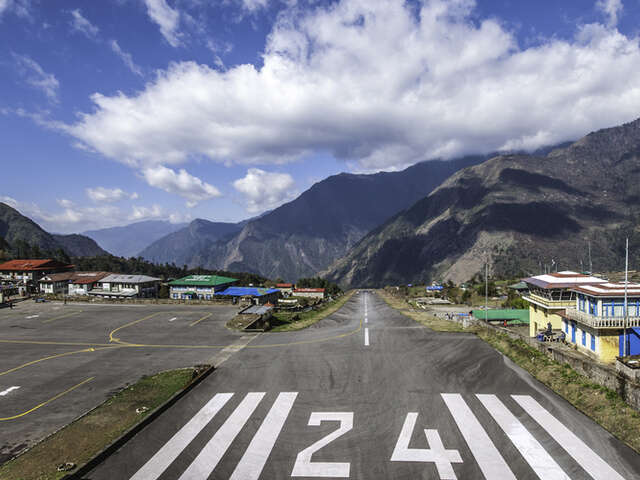
Tenzing - Hillary Airport In Lukla
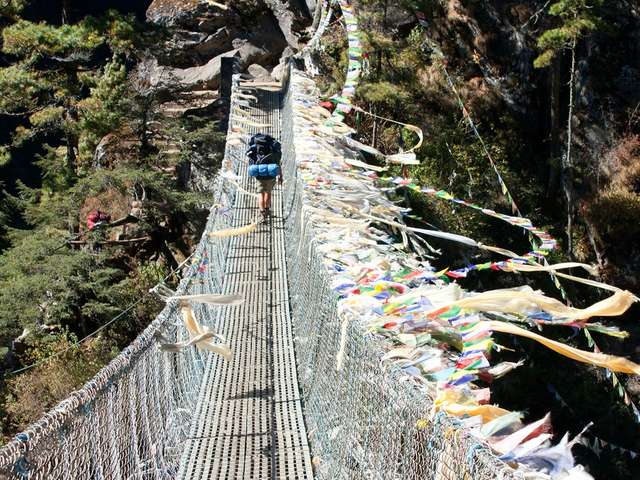
Hanging Footbridge Along The Trek
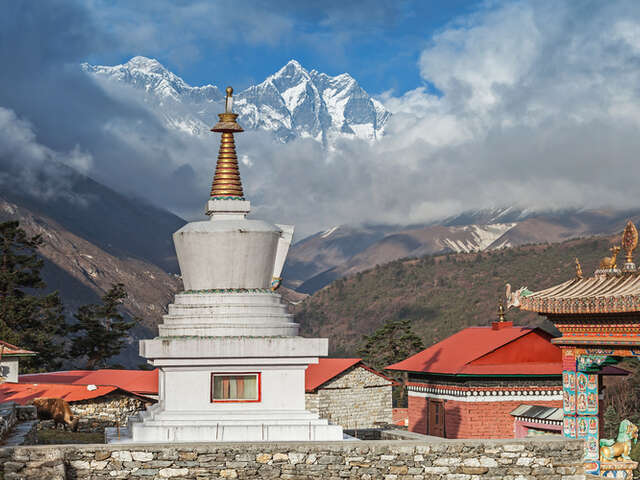
Trekking Around Namche Bazaar

Going Upwards Near Lobuche

Mount Everest (8848m) And Nuptse Mountain (7861m) Just Before Sunrise, Standing On The Kala Patthar Summit, Himalayas, Nepal
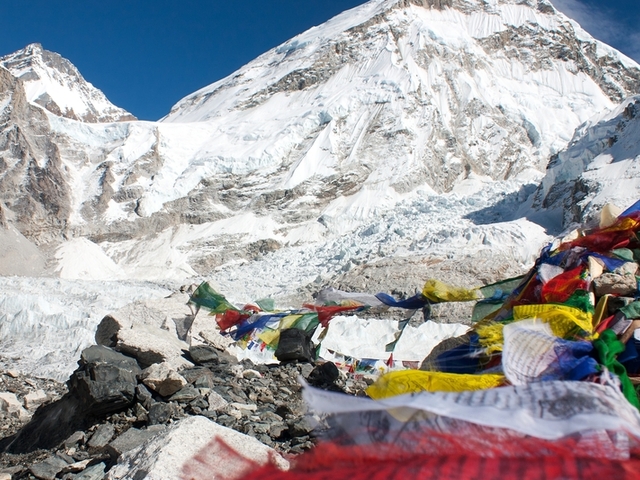
Everest Base Camp, Khumbu Glacier And Prayer Flags - Nepal

Join our Fixed Departure
- Full Itinerary
- Equipment List
What's Included?
- 14 day adventure, 11 of which include 3 meals a day
- 2 nights of accommodation in Kathmandu, breakfast included
- Round-trip airfare between Kathmandu/Ramecchap and Lukla *
- Accommodation while trekking
- Airport transfers
- Everest trekking permit and TIMS (traveler security) Card
- Fully-licensed, English-speaking guide
- Porter service
- Local and government taxes
- Farewell dinner
- 1 Himalayan wonders T-shirt

Day 1 - Kathmandu: Arrival Day
Day 2 - kathmandu to lukla flight and phakding, day 3 - phakding to namche bazaar, day 4 - namche bazaar: rest and acclimatization day, day 5 - namche bazaar to phortse, day 6 - phortse to dingboche, day 7 - dingboche: rest and acclimatization day, day 8 - dingboche to lobuche, day 9 - lobuche to gorakshep and everest base camp, ebc to gorakshep, day 10 - gorakshep to kalapathar and pheriche or panboche, day 11 - pheriche to namche, day 12 - namche to phakding and lukla, day 13 - lukla to kathmandu, day 14 - kathmandu: departure day.
- We'll give you a duffel bag when you arrive in Nepal to repack your gear into, and the porters will carry that.
- You should bring a small day pack that you will carry during the day with essentials like water, camera, sunscreen, extra layers, etc.
- You can store any extra luggage in the hotel.
- Total luggage allotment for the Lukla flight is 10Kg / 22lbs for luggage and additional 5Kg / 11lbs for carry on.
- We offer rental sleeping bags for $20 and down jackets for $15
- Remember to keep all your personal items like passports, medications and other valuables in your carry-on during the flight to Lukla.
We have an experienced team of guides on the mountain and great ground staff in Kathmandu to make sure you are well taken care from the moment you arrive. You can always contact us 24/7 on our international helpline and all of our support team rotates through Nepal on a seasonal basis so you can be sure you are getting knowledgeable first hand advice. All of our guides work for us full time and have on average 8+ year's experience trekking in the Himalayas. We are one of the few companies in Nepal to get a Wilderness First Aid Certification for all of our trekking guides. Our guides have also attended a special course dealing with acclimatization issues on the mountain (Meet the Team) .
The best times for trekking in Nepal are from March to Early May and from September to November. Trekking is possible from December to February and it's a good time to avoid the crowds but you will need to be prepared for colder temperatures. June to August is the rainy season and we don't generally recommend trekking. If June to August is the only time you can trek send us an email and we can provide some suggestions.
Yes! Most of our departures sell out during the peak seasons but during the off season we generally have smaller groups. We guarantee all departures so once you make the deposit you can be assured we will run the trek for you.
Our guides work for us full time and have completed many treks successfully earning our trust and that of our guests. Our clients time and again will remark on how great the trip was because their guide helped make it unforgettable.
All of our guides speak excellent English. They have many years' experience working with guests from all over the world and are very good at connecting with people.
Who can go?
There's no limit on our adventures, as long as participants are healthy and willing! We have had families with kids as young as 7 years do the Everest Base Camp Trek and our eldest trekkers have been in their late 70s. We generally suggest that families schedule a private trek and schedule a few extra days. Don't hesitate to ask us about arrangements.
We get a lot of first time trekkers in our groups so even if you don't have experience you will be in good company. Your fitness level should be such that your comfortable walking all day. Previous, hiking or trekking experience is always a plus.
We ensure the travel safety of all our trekking guests, both male and female. Nepal, on the whole, is both very safe and welcoming of foreign visitors. We have long standing, strong relationships with the lodges we frequent, and know them to be safe and reliable. In addition our guides are consistently mindful of all guests' whereabouts while trekking. We travel in small groups, all the better to easily maintain continual contact.
Payments & Extra Costs
We accept all major currencies. You can pay the balance in cash or with a credit card. Please note we charge a 13% fee for credit card payments so it's much better to pay your balance in cash.
Generally, most places in Nepal don't take credit cards so they are of limited use. There are ATMs in Kathmandu and you can get a good exchange rate withdrawing rupees. The ATMS in Kathmandu generally charge a $5 USD service fee in addition to any charges that you might incur from your bank. These ATMs also often have a limit of 25,000 rupees per day (about $215 USD).
Our trekking packages are pretty much all inclusive from the time you arrive in Nepal. We generally suggest you plan on about $300 or $400 for extra expenses including tips. Extra expenses include items such as: Your Nepal Visa, sleeping bag or down jacket rental, showers, Wifi, snacks and charging electrical devices at tea houses along the way. We also suggest you plan on having extra funds available in cash or on a credit card in case your flight to Lukla is canceled and you decide to charter a helicopter. (Terms of Service – Extra Expenses)
We can arrange extra hotel nights for you in Kathmandu before or after the trek at additional cost. Please let us know before you arrive in Nepal so we can make the arrangements as required. (Read our blog post: Booking Extra Hotel Nights )
Physical Fitness
Trekking in the Everest Region is challenging, but it is a challenge which most people can rise to with some training and determination. The trek consists of 5 to 8 hours of walking a day. In general, we start trekking around 8 am and reach the destination for the day around 4 pm.
We encourage everyone in the group to keep a slow pace at our pre-trek briefings. It's about enjoying the mountains and not a race to the next tea house. The head guide will normally stay at the back of the group with the slowest trekkers.
In terms of physical conditioning before the trek, it's best if you can do some cardio related workouts like running and distance walking. It's ideal if you can take the time to go on a few weekend hikes around your area too. We have an training guide for Everest Base Camp on our website that may have just the information you're looking for. Training for Everest Base Camp
Those with acute or chronic health conditions impacting their stamina, range of motion, coordination, or balance may have difficulty completing the trek. If you are in doubt about your own physical readiness, consult a physician well in advance of booking your trip.
Preparation & Packing
Once you have paid the deposit the next step is for you to send us a scan or photo of your passport along with arrival flight details. We can’t book your Lukla flight or get your trekking permit until we have the photo or scan of your passport so please send this to us as soon as possible .
Travel insurance is mandatory and obtaining it for the days you are trekking is your responsibility. Please email us your proof of insurance before arriving for the trek. You can check out more details on insurance requirements at our Terms of Service – Insurance .
We have a complete downladable packing list or if you want more details visit our blog post on packing for Everest Base Camp . It's worth noting that just about anything you need in the way of trekking clothing and/or equipment can be purchased or rented in Kathmandu when you first arrive.
We can provide a -20C sleeping bag for a $20 rental fee during the trek and down jackets are $15 USD. These will be available at the briefing the night before your flight to Lukla and you can just let the team know that you need one.
We will provide a duffel bag for you in Kathmandu. The duffel bag will be carried by the porters on the trek and will be your luggage item on the flight. Often the porters get ahead on the trail and your duffel will not be available until you reach the tea house in the evening so you will need to carry a day pack while hiking with the items you need during the day.
Generally, we recommend a day pack of about 40 L, or roughly the size of a school backpack to hold your extra layers as well as essentials for the day.
The main limitation on the weight is the luggage limit on the flight from Kathmandu to Lukla which is 10kg (22lbs) and another 5kg (11lbs) for a carry-on for a total of 15Kg or 33lbs.
Make sure to keep all of the items in your carry on during the flight. You don't want to be without important documents or medication if your luggage is delayed for some reason. You should carry these in your day pack on the trek as well.
Yes, you can leave any luggage at the hotel during the trek.
- Arrival & Visas
Yes, our airport representative will be there to greet you as you step out of the airport. Please look for our driver with a Himalayanwonders signboard. You can see more about arriving at the airport on this short video (click here to see on YouTube) .
Most guests are eligible to get a visa on arrival at the airport and it takes between 20 minutes to an hour depending on the rush. Guests are responsible to check and verify all visa requirements before arriving. Your passport needs to have at least 6 months validity on the date you are entering Nepal. Check this as soon as you book your trek. Please check visa fees and other details here: Terms of Service – Visas .
We use the Hotel Address and the Hotel Jampa both which are centrally located in Thamel and close to our office.
All of our trekking packages include 2 nights hotel in Kathmandu and we can arrange extra nights on request (see our blog - Booking Extra Hotel Nights ). Please let us know in advance if you need extra nights so they can be reserved. You can pay any extra nights when you arrive to the hotel directly. Sometimes you will find cheaper rates online for these hotels, but the advantage of having us make the arrangements is that if your Lukla flight is delayed we can shift or cancel the reservation at no extra cost.
Room and board
We use tea houses for lodging on all of our treks. This is probably the most popular style of trekking and simply involves going from teahouse to teahouse. Teahouses are essentially small hotels found in local villages that offer both a place to sleep as well as home cooked meals. Rooms are typically shared with 2 trekkers per/room. Bathrooms are shared as well and in the Everest region they usually have running cold water and western style toilets. (Read More – Tea House Trekking Blog ).
We can arrange a private room in Kathmandu. In some of the villages on the trek, it may be possible to have a private room (no extra cost) and we will do our best to arrange that. However, during busy times of the year there is a limited amount of lodging available in some of the villages so it's generally impossible to arrange private rooms. This is the case even if you're willing to pay extra since the tea house owners will not give out a private room if it means someone else goes without a room.
We provide all the meals on the trek, but don't provide water. The best option is to treat the local water either with chlorine/iodine tablets or to use a steri pen. The tea houses will give you good quality free water and you can also get along the trail but you will need to treat it. If you are using the tablets make sure they dissolve completely (about 30 mins). On most treks you can buy mineral water along the trail. A liter of mineral water at lower elevation tea houses costs around $1 USD but at higher elevations can cost up to $4 so the cost can add up.
We let trekkers choose a meal and hot drink from the menus at the tea houses. Typical meals include; omelets, toast, boiled eggs, noodle soup, fried rice, macaroni, momo, vegetarian curries, pizza or chow mein. The traditional Nepali Dal Bhat which consists of rice, lentils, and a vegetable is all you can eat and always a good choice. Meat on the mountain is not hygienic and we suggest trekkers stick with vegetarian options. (Menu and Food Items – Youtube Video ).
This is not a problem and in fact we recommend that everyone stick with a vegetarian diet on the trek as the local meat is not refrigerated properly. If you have special dietary requirements just let us know and we will make sure to assist with the proper menu.
They have electricity at the tea houses in the common areas. They do charge an extra fee of $1 to $4 an hour for charging.
A lot of the tea houses have the power strips with the American outlets. If not then either a C or D type outlet is good. You can check out all the details on the different outlets (click here) . If you have time in Kathmandu you can buy at least the common adapters for just a couple of dollars.
Some of the lower elevation tea houses offer wi-fi for an extra charge of $3 to $10. Another option is to get a Nepalese SIM card in Kathmandu for both internet and calls. Even if you have a SIM card data use is mainly limited to lower elevation tea houses. You can also use your guides phone for international calls as long as you reimburse him for the charges which tend to be fairly reasonable.
Most of the tea houses have western style flush toilets and cold running water. In almost all cases the bathrooms are shared and not attached to the individual rooms. Some of the higher elevation tea houses have the Asian style toilets which consists of a ceramic basin on the ground (Bathrooms on the Everest Trek – Youtube Video ).
Most of the time you can use the bathrooms in one of the tea houses or lodges, but if it's urgent you can go off the trail and find some privacy.
This is a good idea. However, you can also easily but a roll along the trail at one of the small shops. At the higher elevations like Gorak Shep a roll of tissue might run you $5.
The lower elevation tea houses have hot showers (generally gas) whereas the higher elevation tea houses generally provide a bucket of hot water. Tea Houses generally charge an extra $3 to $5 for a hot shower which can be well worth it after a long day on the trail.
There are laundry services available in some of the tea houses, and it may be possible to wash some clothes during your acclimation days in Namche Bazaar or Dingboche for a small fee. It is better to plan ahead and pack enough, then wash your clothes when you get back to Kathmandu at the end of the trip.
Health and safety
The best way to avoid problems with altitude is to ascend slowly and all of our Everest treks are designed to average about 300m or 1000ft a day in elevation gain which helps to minimize any elevation problems and is the rate recommend by high altitude doctors. For a complete list of symptoms please review our Welcome to Nepal Brochure. All of guides are well experienced at recognizing symptoms related to AMD and each carries a pulse oximeter and will monitor your blood oxygen level on a regular basis. (Read more on our blog).
It may seem counterintuitive, but your skin is in more danger of sun damage on the mountains than while at the beach! The sun's intensity increases dramatically as we rise in altitude, and fresh snow reflects exponentially more UV rays than does the sand. You will need to protect your skin with clothing and sunblock. A sunblock specifically for mountain conditions is recommended. If you wear prescription eyeglasses its recommend that you get your prescription fitted to sunglasses. Its best to wear a hat and cover up while trekking.
We take all possible precautions to proactively ensure the safety and wellness of our trekkers, but rest assured that our guides are trained and experienced in dealing with emergencies. If necessary, your guide will utilize your travel insurance information to call a rescue helicopter, and you will be flown to Kathmandu for medical attention.
Having minor symptoms of altitude sickness such as a headache are quite common and you can continue trekking. However, if you develop additional symptoms its critical that you don't continue trekking to a higher elevation. We can often arrange to have you walk down to a lower elevation and wait several days for the symptoms to resolve before continuing with the next group. Note that additional charges apply for extra days on the trek. Please see complete details in our "Terms of Service" .
If you are sick and need to rest for a day we can often place you in the next trekking group coming up the mountain. We would rather see trekkers take extra time on the trail then risk altitude sickness by pushing themselves too fast. Please talk to your guide about this and we will do our best to accommodate you. Note, that extra charges will apply for additional days on the trek. Please see complete details in our "Terms of Service" .
All of our guides are certified by the Red Cross and also have an international WAFA certification. Wilderness Advanced First Aid is comprehensive medical training designed for remote professionals or wilderness leaders who venture into remote and challenging environments. Our guides are all equipped with pulse oximeters and in addition to keeping a close watch of your condition they will take daily readings of your blood oxygen saturation levels. In addition our guides carry a basic first aid kit and have a mobile phone. In an emergency situation the guide will coordinate rescue efforts with the office in Kathmandu where our team is available 24/7.
Temperatures vary quite a bit in the Everest Region depending on the season. Temperatures in Lukla at the start of the trek are actually quite warm from March to May and from September to November and trekkers often wear t-shirts and shorts. Everest Base Camp is cold year round and even during the warmer months you can expect lows at night below freezing. During the winter months it can reach -25C or colder at night and its important to have warm clothes and a good sleeping bag. Our packing list for Everest Base Camp should have you well prepared for even the coldest months (packing for Everest Base Camp.)
Comfortable, sturdy trekking shoes or boots are a must. Look for shoes with ankle support, and ideally your footwear will have Gore-Tex or similar lining, along with thick soles. This will ensure that your feet stay warm and dry, and that you are comfortable walking on rocky paths. It’s always best to break your boots in before you arrive and make sure they are comfortable. If you start to get a blister it’s best to stop immediately and cover it with duct tape or moleskin.
All of the water in Nepal needs to be treated before drinking. If you want to avoid treating the water you can buy bottled water on the trek or in Kathmandu. Whether trekking or in Kathmandu its best to avoid uncooked vegetables. To be on the safe side make sure all your meals are cooked and avoid meat on the mountain.
We generally recommend the standard vaccinations as per the CDC (See link) . If you have any pre-existing medical conditions please let us know at the time of making the deposit.
Practical matters
The flights between Kathmandu and Lukla are generally reliable but if the weather is not good they can be canceled for the entire day. Our 14 day package includes one buffer day in case of delays but we suggest that you schedule a couple of extra additional days in case of delays at the end of your trek. If your flight is delayed in Kathmandu we will rebook your flight for the next day. We may also be able to provide an option for a privately chartered helicopter. If you choose to take the helicopter this can cost an additional $500 or more depending on availability and group size. Extra hotel nights ($40) and meals in Kathmandu are not included when flights are delayed although we will make arrangements for you. If your flight is delayed from Lukla your are responsible for extra accommodation and meals (approximately $30). (Flying to Lukla – What You Need to Know ) .
As of April 2019 almost all of the Lukla flights have been diverted to Ramecchap from Kathmandu due to construction and over crowding at Kathmandu Airport. Ramecchap is a small airport about 5 hours drive from Kathmandu. Please read our blog post for the current situation. (Ramecchap Flight Updates) .
While not mandatory, tipping is customary and always appreciated in Nepal and on our treks. Tipping is a great way to show your appreciation for the team's hard work and devoted attention to your happiness. We generally suggest a tip of roughly 10% of the cost of the trek divided between guide and porter.
Our treks are all-inclusive and cover accommodation, food, park fees, permits, and many other costs, as a means of making your adventure as stress-free and convenient as possible.. Travelers generally bring a small amount of pocket money to cover bottled water, snacks, or tea beyond your included meals, souvenirs, tips, or donations to monasteries along the route (if you are inclined to give one). Trekkers find that around $15 to $20 USD a day is reasonable for these extras although if your on a tight budget you can get by with less.
We don't have extra fees for solo travelers joining our group treks. If you have requested a private trek or a different trekking date as to what you see online our team will inform you of any extra fees before you make the deposit.
It’s sometimes the case that trekkers finish ahead of schedule or they end up stopping the trek early for health or personal reasons. If this is the case please understand that we do not offer any refunds for unused days on the trek. Please understand that our costs are the same as we have an obligation to pay our guides and porters for the time they have committed.
We understand that plans change and if you would like to change the dates of your trek we don't charge any fees as long as you give advance notice. Check out our terms of service for all the details or contact us for more information.
This is certainly possible if you have arranged a private trek with us. If you are doing a group trek please ask us in advance on how this might be arranged and we will do our best to find a good solution.
If your concerned about the number of people signed up for a group or have questions about the other trekkers in the group please ask us. We never share personal data but we can give you a general idea on nationalities, sex and approximate age ranges.
If you have extra days after the trek please ask our ground team in Kathmandu for assistance with arranging day tours around the city. We also organize short 3 day trips to Chitwan for safari.
- Have a big group? We can help.
- We can customize the trip as per your need.
- We can help you make it fit your budget.

- Best Price & Value for Money
- Experienced Guides & Porters
- Have a Big Group? We can Help.
- Top Notch Customer Service
- Local Knowledge Counts
- Every Departure Date is Guaranteed.
- Choosing a Trek
- Tea House Trekking
- Trekking Tips
- Flying to Lukla
- Packing List
- Fitness Training
- Travel Insurance
- Best Time to Go
- Staying Healthy
- Meet the Team

- Privacy Policy
- Terms & Conditions

Everest Base Camp Trek – Ultimate Guide For 2024
Written By: The Planet D
Adventure Travel , Nepal
Updated On: January 5, 2024
Trekking to Everest Base Camp is different than other treks around the world. Nowhere else on earth will you experience trekking as you do in Nepal and nowhere quite compares to the majesty of the Himalayas. Villages dot the landscape filled with restaurants, markets, bazaars, and tea houses (mini-hotels) where you can stop for lunch, buy supplies, and have a piece of apple pie while surrounded by the highest mountains in the world.
Every hundred meters or so there is a hotel, restaurant, or cluster of buildings making up a small village. The villages are stunning reminding us of something out of the Swiss Alps on steroids. Well-built lodges and brick homes line the trail with the magnificent setting of the Himalayas draped in the back.
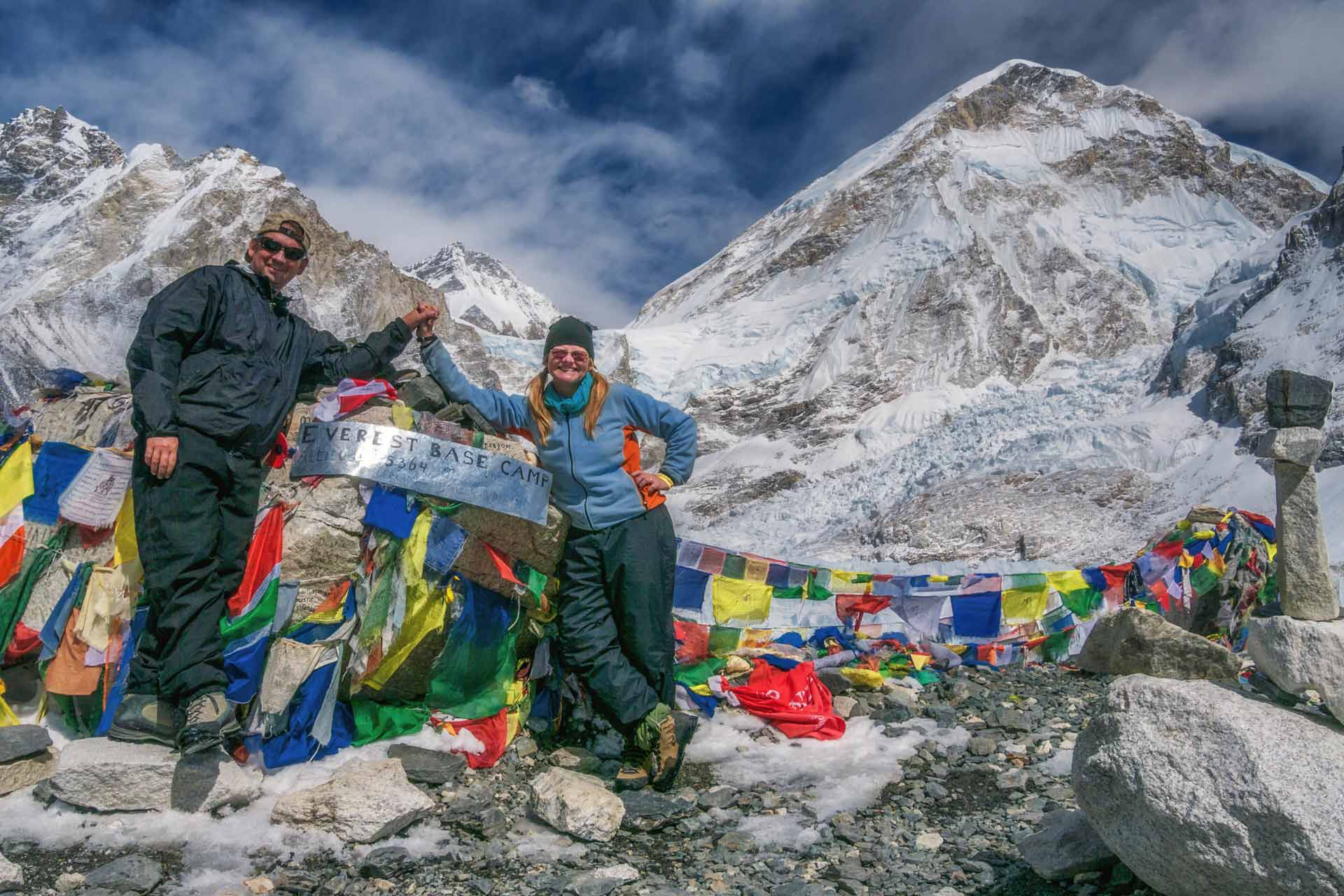
Table of Contents
Trekking to Everest Base Camp
What is it like trekking to Everest Base Camp in Nepal? The EBC Trek is life-changing, it’s exhilarating, and it is challenging. We share everything you need to know from planning your trek to Everest to packing for your trip. This guide to the Everest Base Camp Trek breaks down each day. So sit back and take a journey with us through Nepal’s legendary Sagarmatha National Park.
Everest Base Camp Trek Itinerary
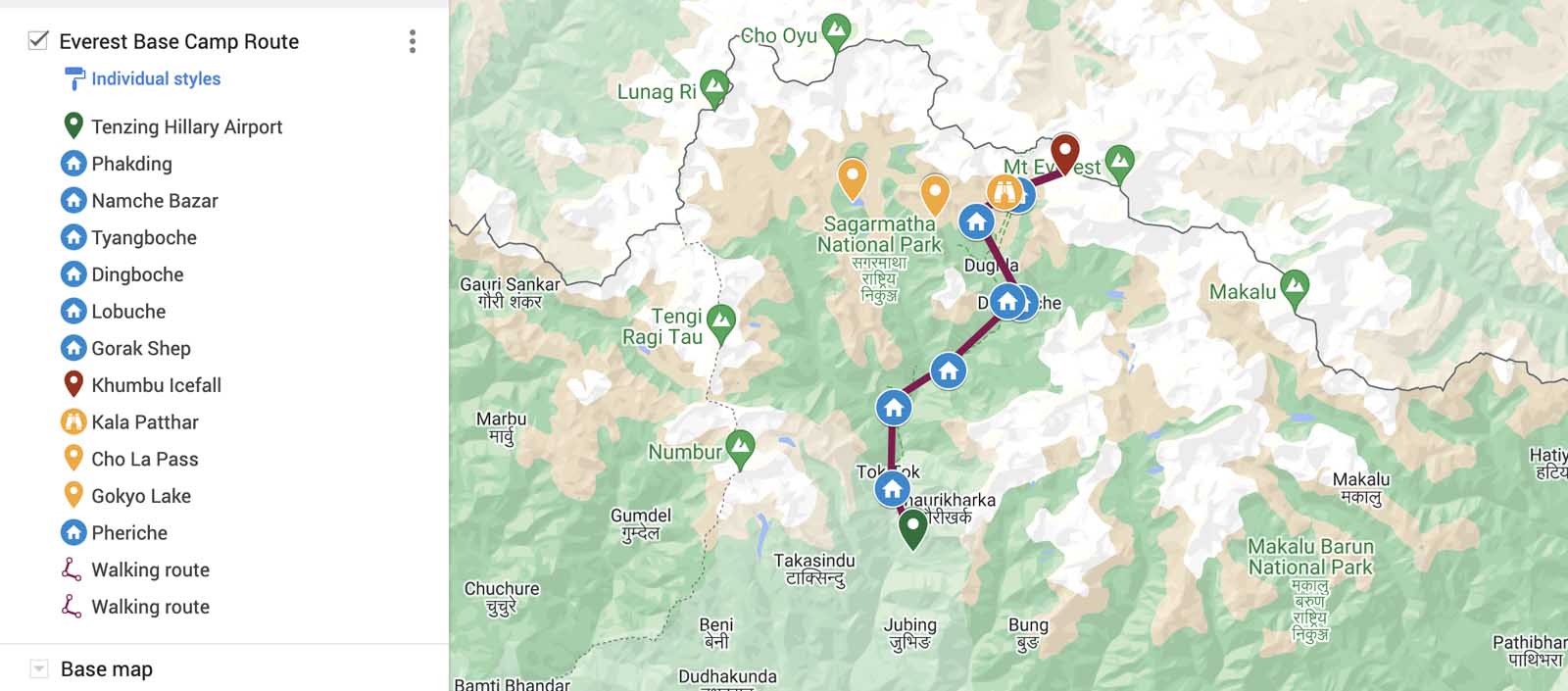
On the map, the Everest Base Camp trekking route distances look fairly easy to hike from village to village through the Khumbu Valley. Eight days may seem like it would be more than enough time to cover a mere 63 km (39 miles) one way, (128 km return) but with several sustained days in a row above 4000 meters (13,000 feet), the walk is slow and steady.
It is important not to push too fast to avoid altitude sickness which is a very real possibility. When trekking to Everest base camp, expect to hike anywhere from 7 – 17 km (4.5 – 10 miles) per day with the entire trek taking 12 – 14 days.
Hiring a Guide for the EBC Trek – Mandatory
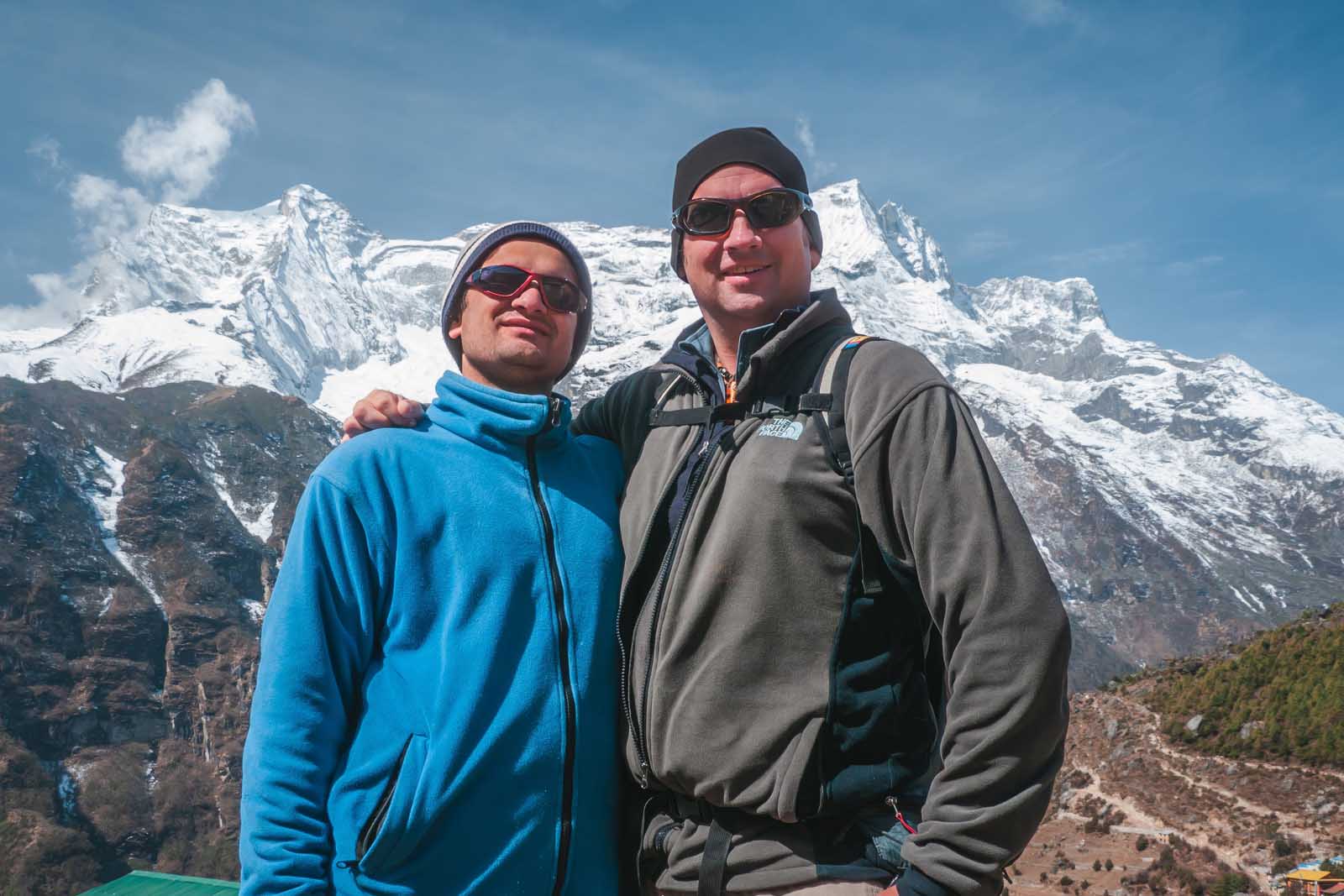
In April 1, 2023, Nepal has banned solo trekking. Foreigners must hire a guide for treks in high-altitude trekking regions of national parks. According to the Kathmandu Post in March “ solo or independent trekkers have to mandatorily hire a guide or a porter before setting off to Nepal’s mountains.” However, after an updated article in the Kathmandu Post, it seems that the Everest Region is an exception. Before booking, we would check with local companies and authorities as rules are constantly changing.
Book Locally
Many people book ahead of time with a tour company located outside of Nepal such as Intrepid Travel or GAdventures, but we hired locally and it saved a lot of money.
Plus, you know your money is going directly to the local economy and you have a more intimate experience by trekking with a local guide. We spent a couple of days in Kathmandu looking for a guide to Everest and found Simrik Real Nepa l owned by Kathmandu resident Dipendra Simkhada.
Dipendra planned the entire trip for us, and all we had to do was wait for him to pick us up at our guesthouse in Kathmandu to take us to the airport to board our Tara Air flight to Lukla Airport. Book your Trek to Everest Base Camp with Simrik Real Nepal – A Locally owned and operated tour company, Simrik is located in Kathmandu.
Kathmandu – The Hub of Nepal Treks
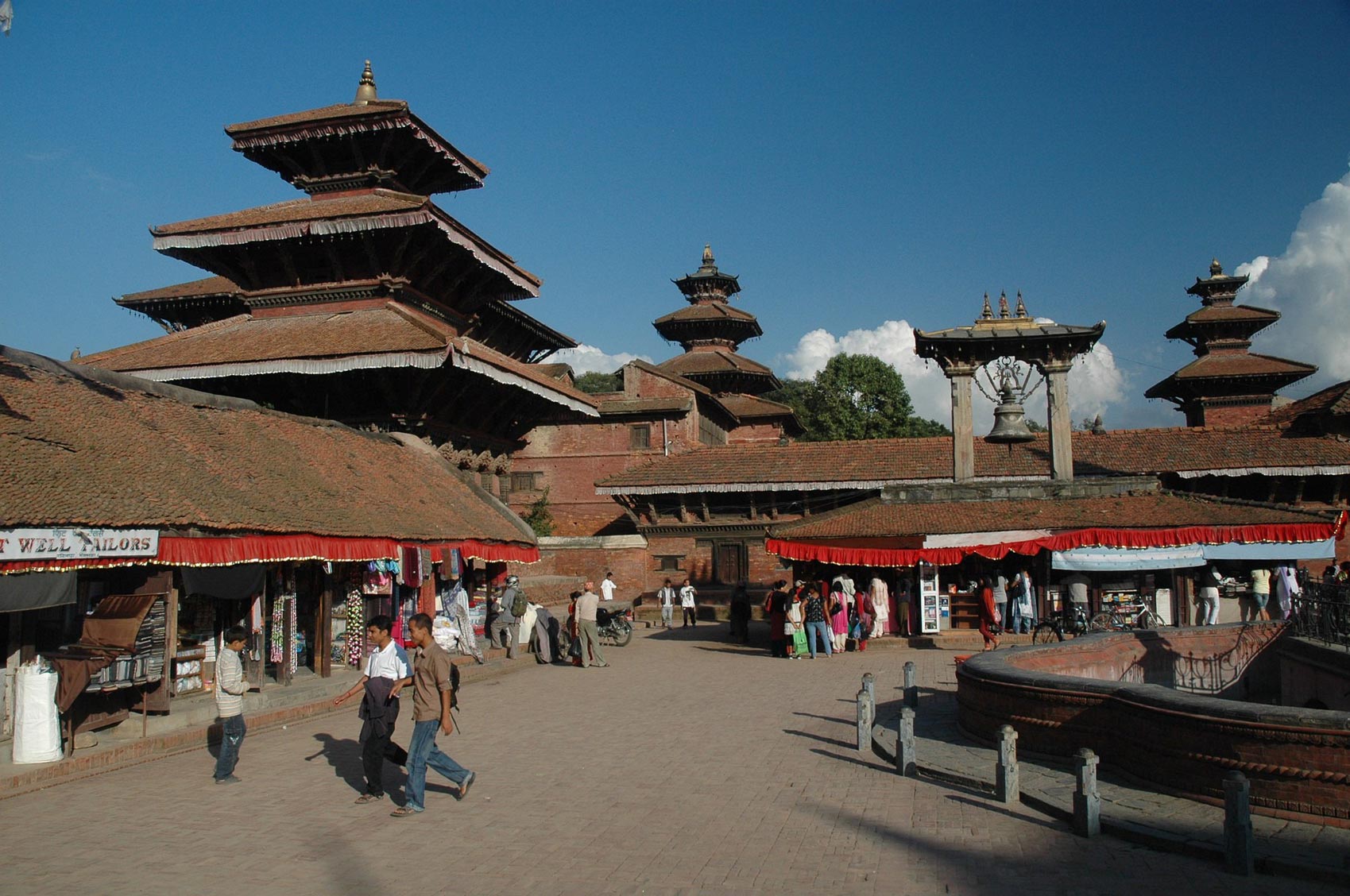
We spent a few days in Kathmandu picking up supplies and doing some sightseeing before trekking to Everest. We suggest not spending too long here as it can be very polluted in Kathmandu and by the time we were ready to trek, I was already quite congested.
Our recommendation is when you arrive in Kathmandu, only spend two to three days to get yourself organized and instead do your sightseeing at the end of your trek. Read more: Top Places to visit in Kathmandu, Nepal
Day 1: Fly from Lukla Trek to Pakhding
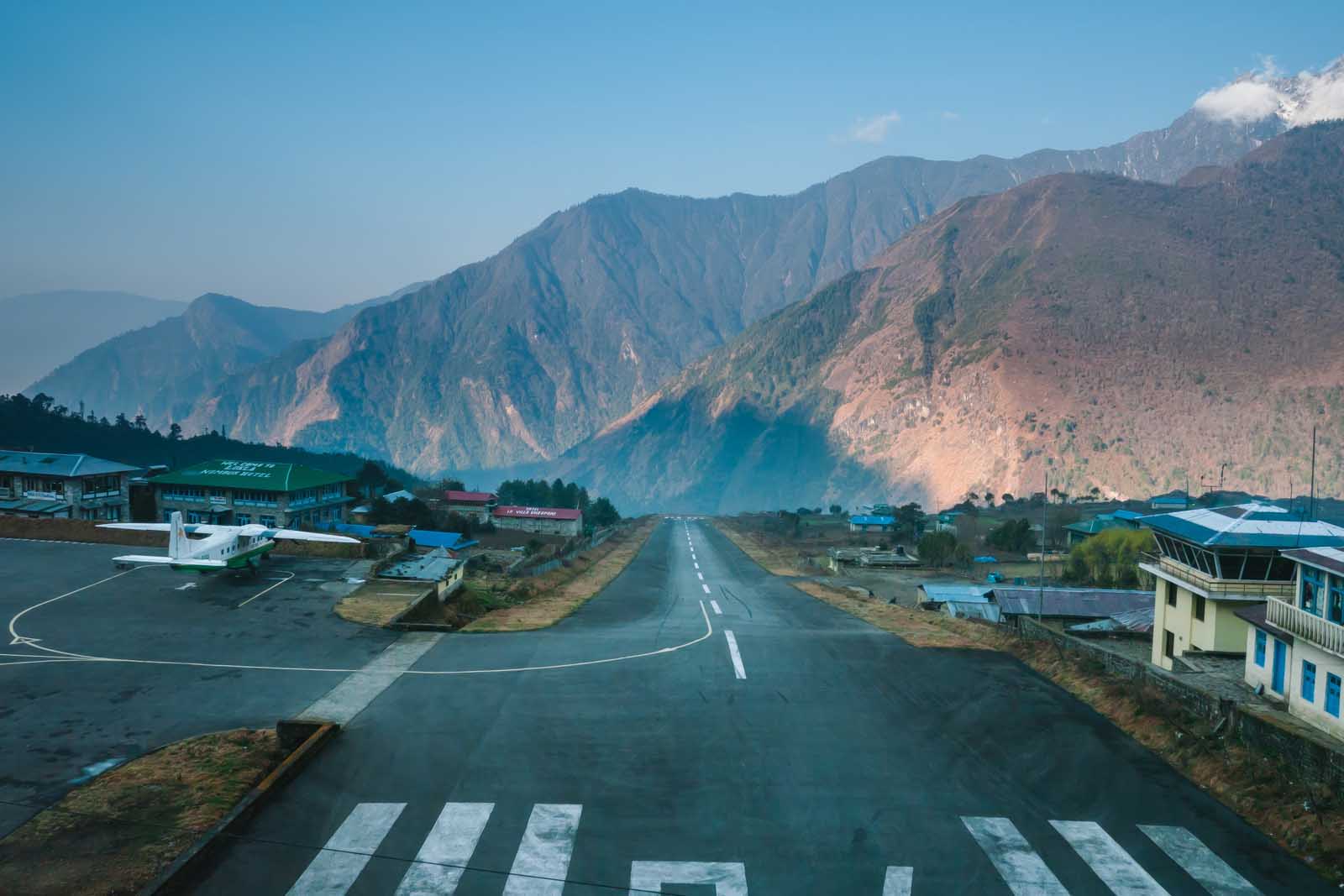
Flights to Lukla no longer leave from Tribhuvan International Airport (Kathmandu Airport) in Kathmandu due to congestion. Flights are now out of Ramechap airport which is a 4 1/2 hour drive from Kathmandu. You can book private helicopters from Tribhuvan International Airport.
The flight from Ramechap airport is much shorter than the flight from Tribhuvan International Airport. Flights to Lukla are only 12 minutes so more flights can get through when the weather is clear making flights less likely to be canceled or delayed for too long.
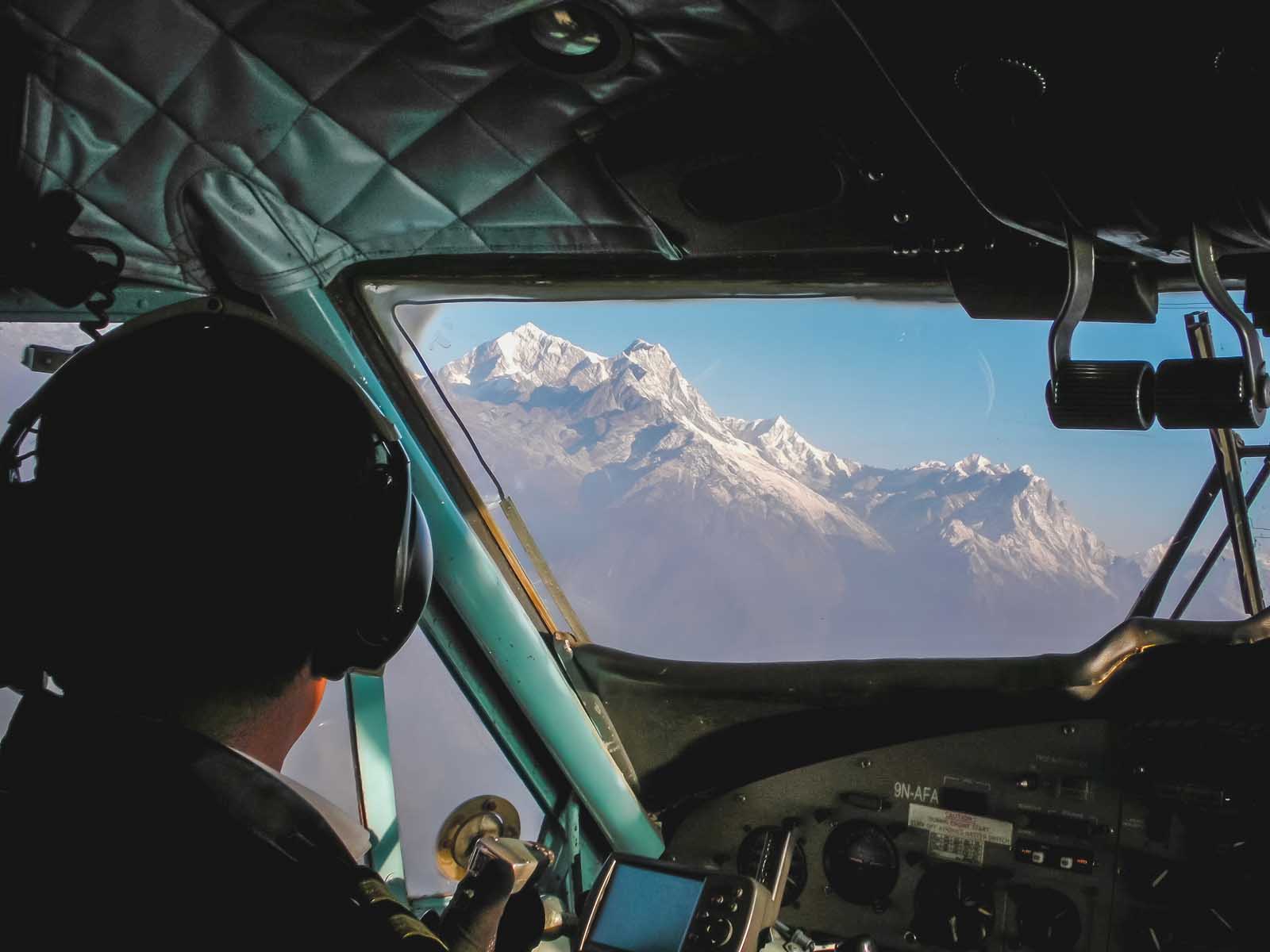
The flight to Lukla is a scary flight and is considered one of the most dangerous in the world. We flew from Kathmandu but flights now are much shorter from Ramechap. I think I would like it better as we sat at the front of the plane and saw the pilot’s instruments constantly flash “ obstacle ahead. ” It looked as if we were about to crash into a mountain at any time. Read all about our flight to Lukla and watch the video here
Watch Us Fly to Lukla Airport
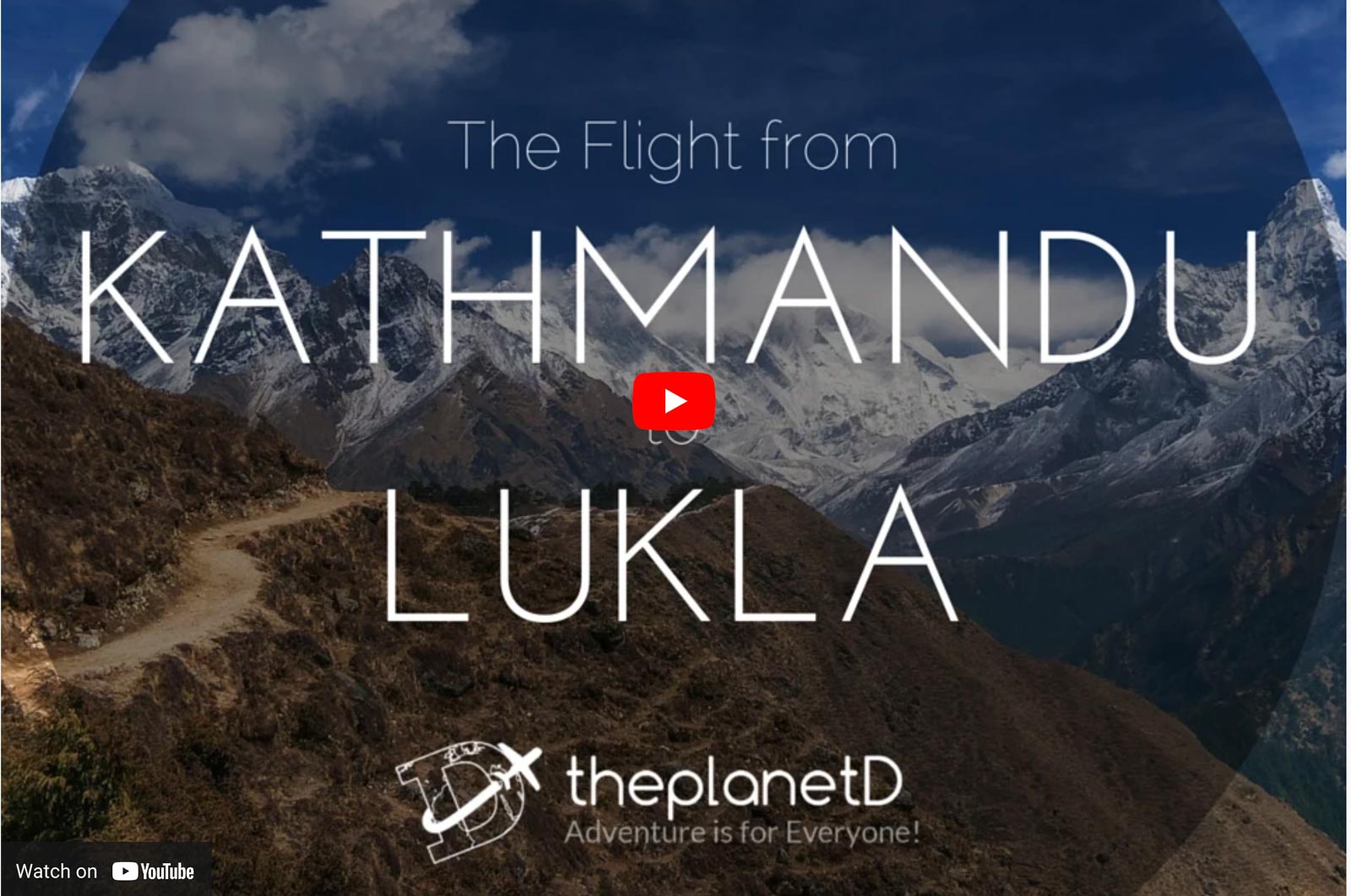
The Lukla airstrip at Lukla Airpot is a short landing strip at only 525 meters (1,729 feet long.) Built on the side of a mountain it is also a very steep grade that is needed to slow the planes down quickly. Needless to say, we held our breath during the landing.
We survived that flight, but it was the flight back to Kathmandu I was nervous about. Taking off on that short of a runway was a hair-raising experience. One false move and we’d drop thousands of feet into the valley below. Lukla Airport is actually called Tenzing Hillary Airport named after the first two men to summit Mount Everest.
Hiking from Lukla to Pakding
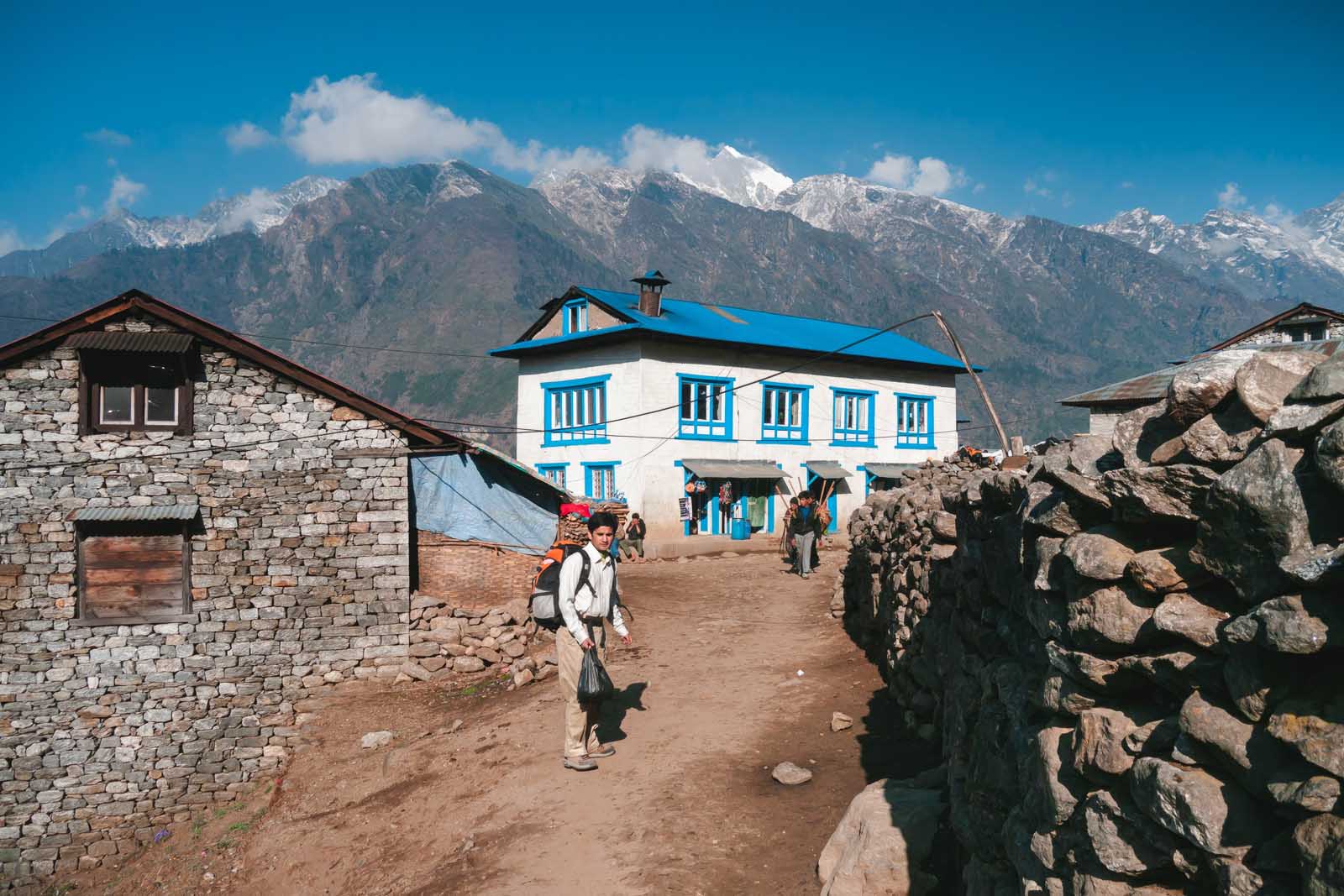
The trek begins officially in Lukla. Lukla is a busy town with plenty of accommodation, shops, and eateries. If you forgot anything for your EBC trek, you can pick up supplies in a pinch. But we suggest purchasing all your gear in Kathmandu. It is much cheaper.
From Lukla, we immediately started our Everest Base Camp hike. After a quick snack and a cup of tea in Lukla, we set off on an easy three-hour trek along trekking trails that were easy to follow weaving through villages, crossing rivers, and stumbling over stony paths.
Entering Sagarmatha National Park
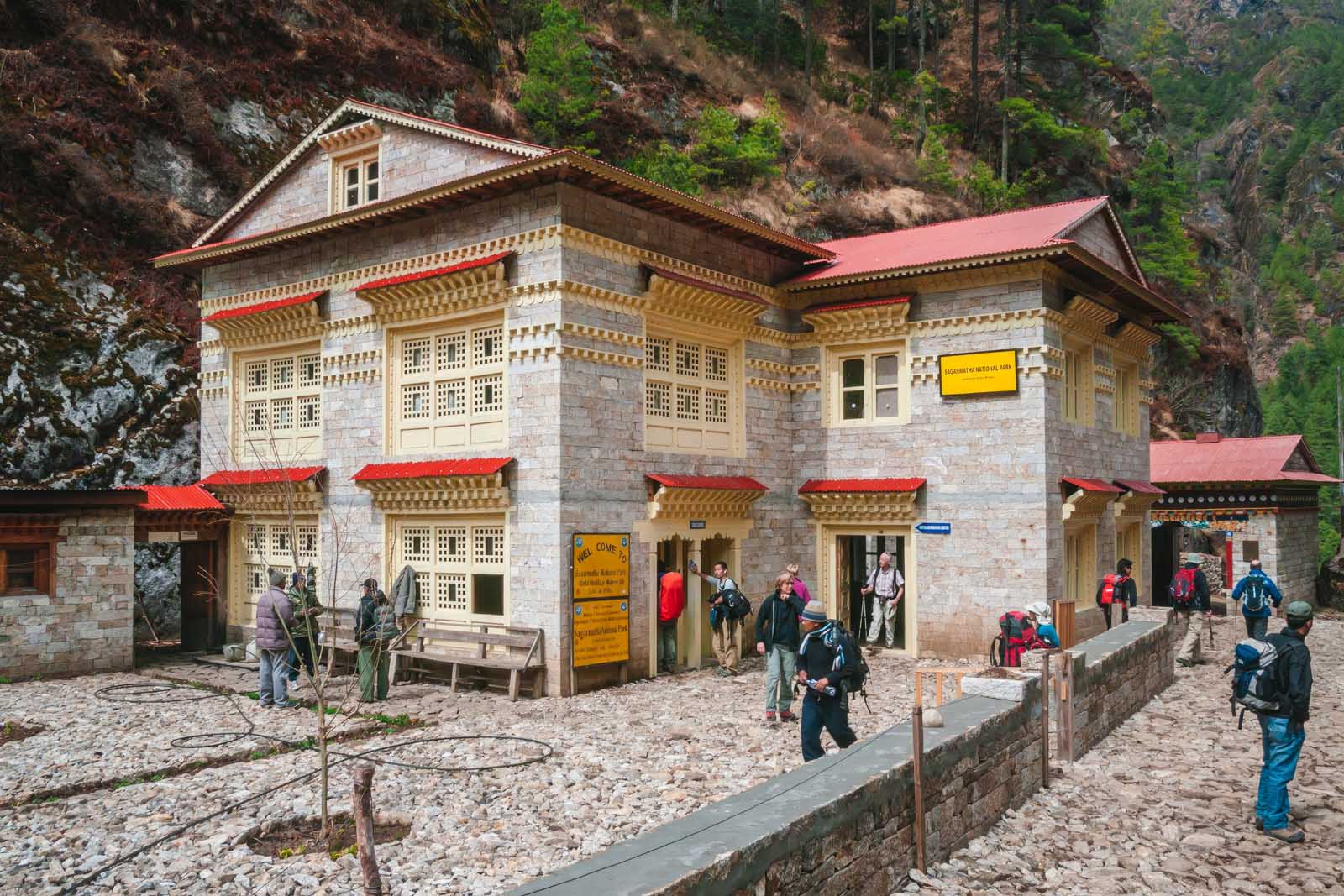
A permit is needed to hike to Everest Base Camp as it is located in Sagarmatha National Park. We checked in with the national park headquarters and Dipendra took care of everything. He had all our paperwork in order so all we had to do was start walking through the beautiful Khumbu Valley to make our way to Everest base camp.
Sagarmatha National Park has been a UNESCO World Heritage Site since 1976. At 1148 square km (443 square miles) in area, it is one of the most beautiful places we have ever visited.
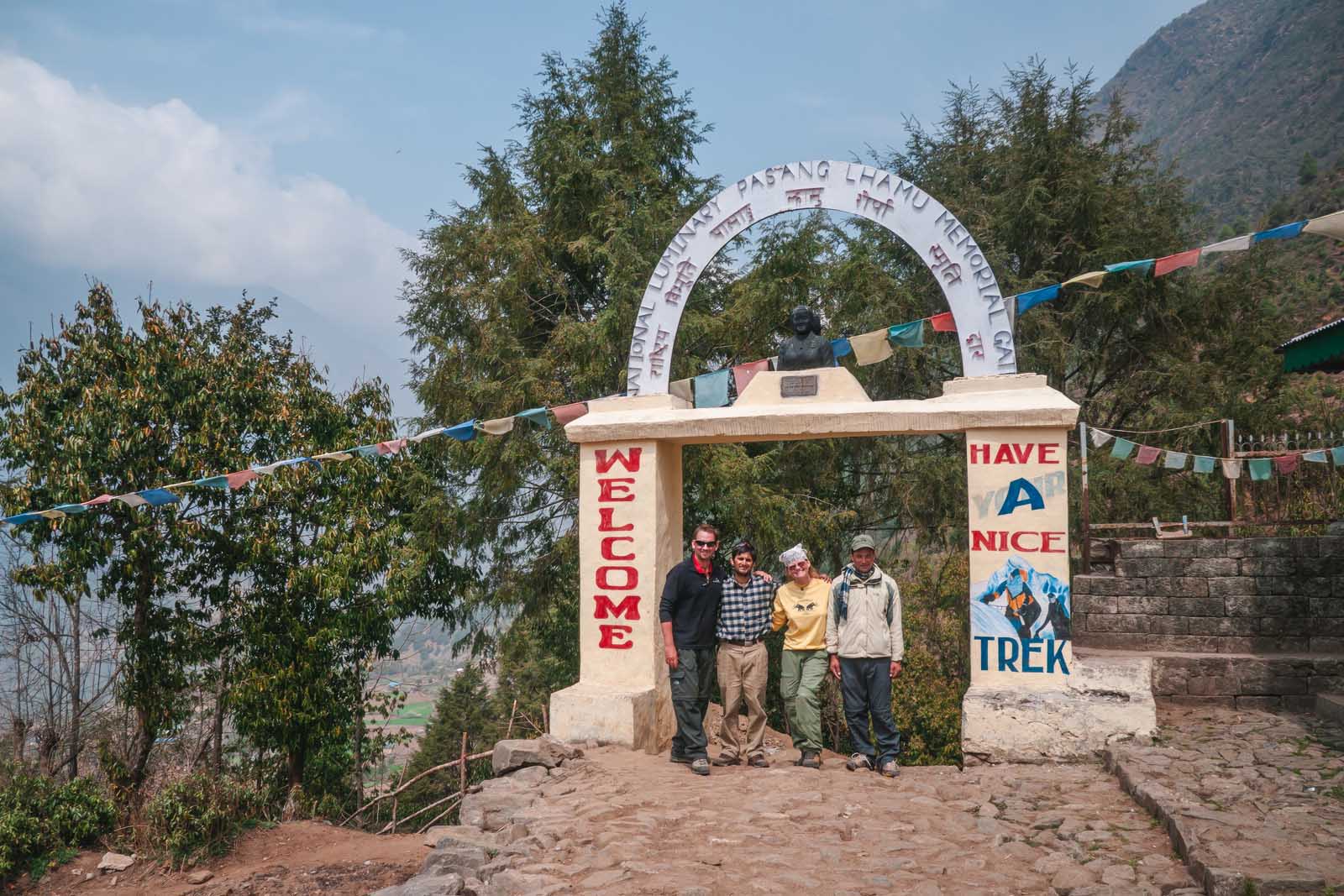
We felt giddy stepping through the welcome gates located just outside of Lukla. This was it, we were following in the footsteps of the great adventurers of our time. It was awe-inspiring to hike through the Khumbu region surrounded by the Himalayas.
As we hiked out of Lukla, Dipendra pointed out the surrounding jagged white peaks named Kwangde, Mumbu, and Kishumkongara. At 6000+ meters, (19,000+ feet) these are the “little guys” of the world’s highest mountain range. It wouldn’t be long until we were among the famous 8000-meter (26,000 feet) peaks.
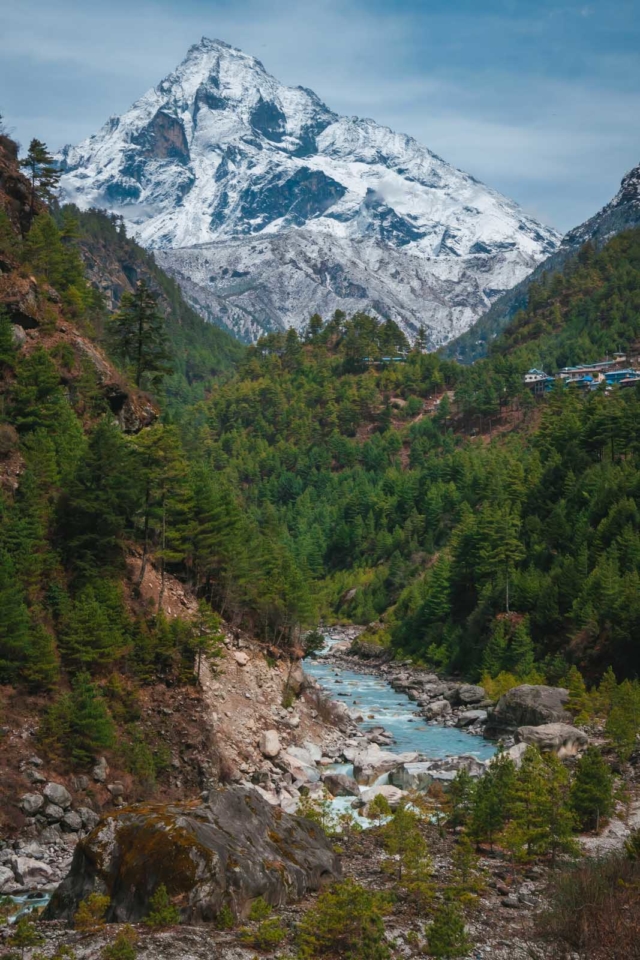
Our first day was filled with a relaxing walk while learning about the Khumbu region. It was quite early in the day, so we had plenty of time to take our time to learn about the customs of climbing and learn the names of the mountains found in this beautiful region of Nepal.
For the rest of the day, we followed the Dudh Koshi River Valley at a steady but leisurely pace to the village of Pakding. Temperatures were warm and the first day of trekking was comfortable. Lukla to Pakding actually has an elevation loss, so it is a good introduction to hiking through the region as we had a lot of downhill trekking.
After about 5 hours, we came to our first night on the trek where we spent the night in a comfortable teahouse in the village of Phakding.
Our First Night on the EBC Trek
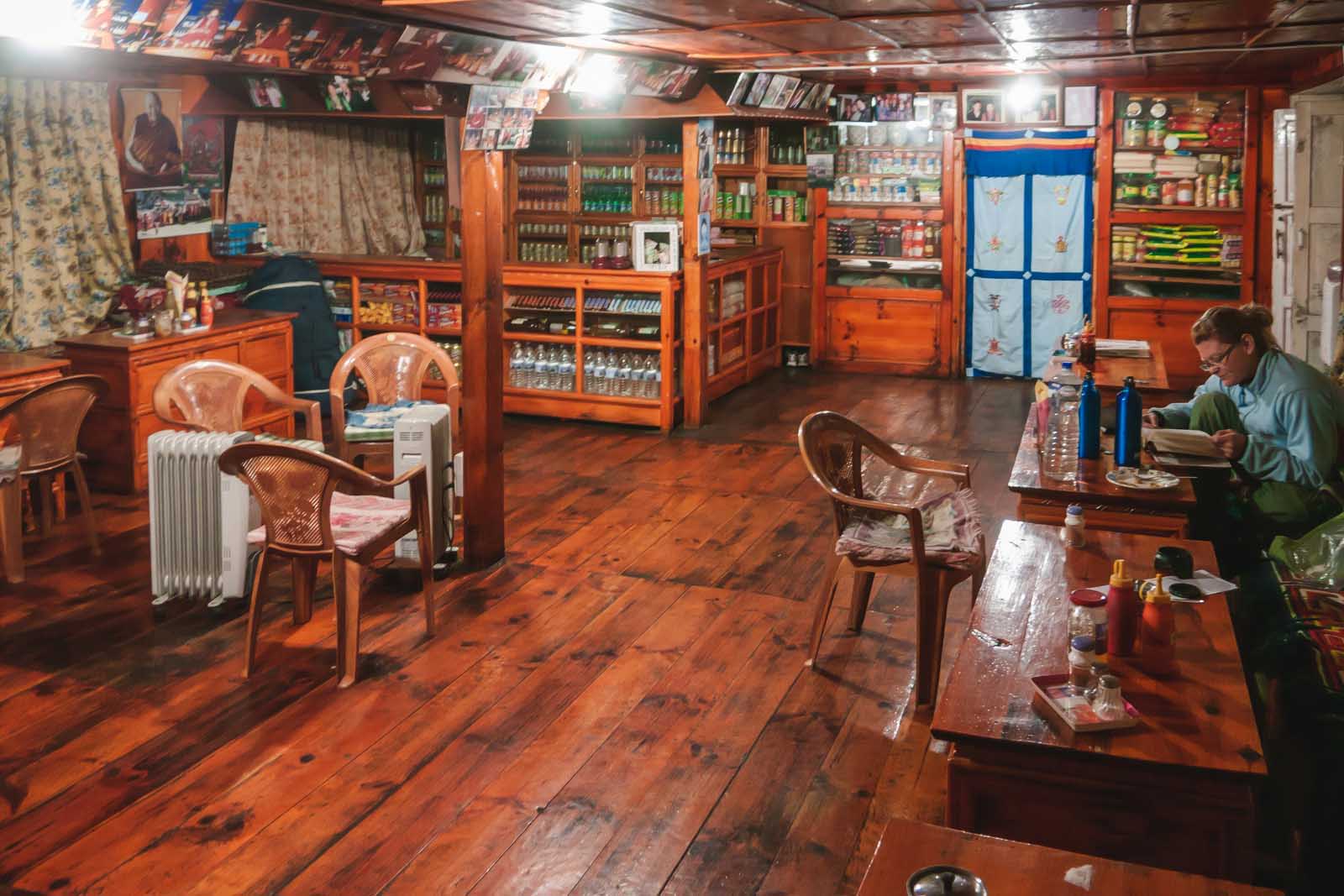
The accommodation in Pakding was a quaint little hotel/teahouse that looked like a cottage. The wood-burning stove smelled delicious as it warmed the restaurant while they prepared our meals.
Our porter “Sher” carried all our supplies including the sleeping bags that we borrowed from our trekking company. We each rented a sleeping bag that was included in the price of our EBC trek. The beds were comfortable and Dave and I had private rooms. Some tours use dorm rooms but we had private rooms. Toilets were shared, but everything was clean and comfortable. The rooms were clean and we slept like rocks snuggled up in our thick down sleeping bags.
Heated Lodges – Teahouses on the EBC Trek
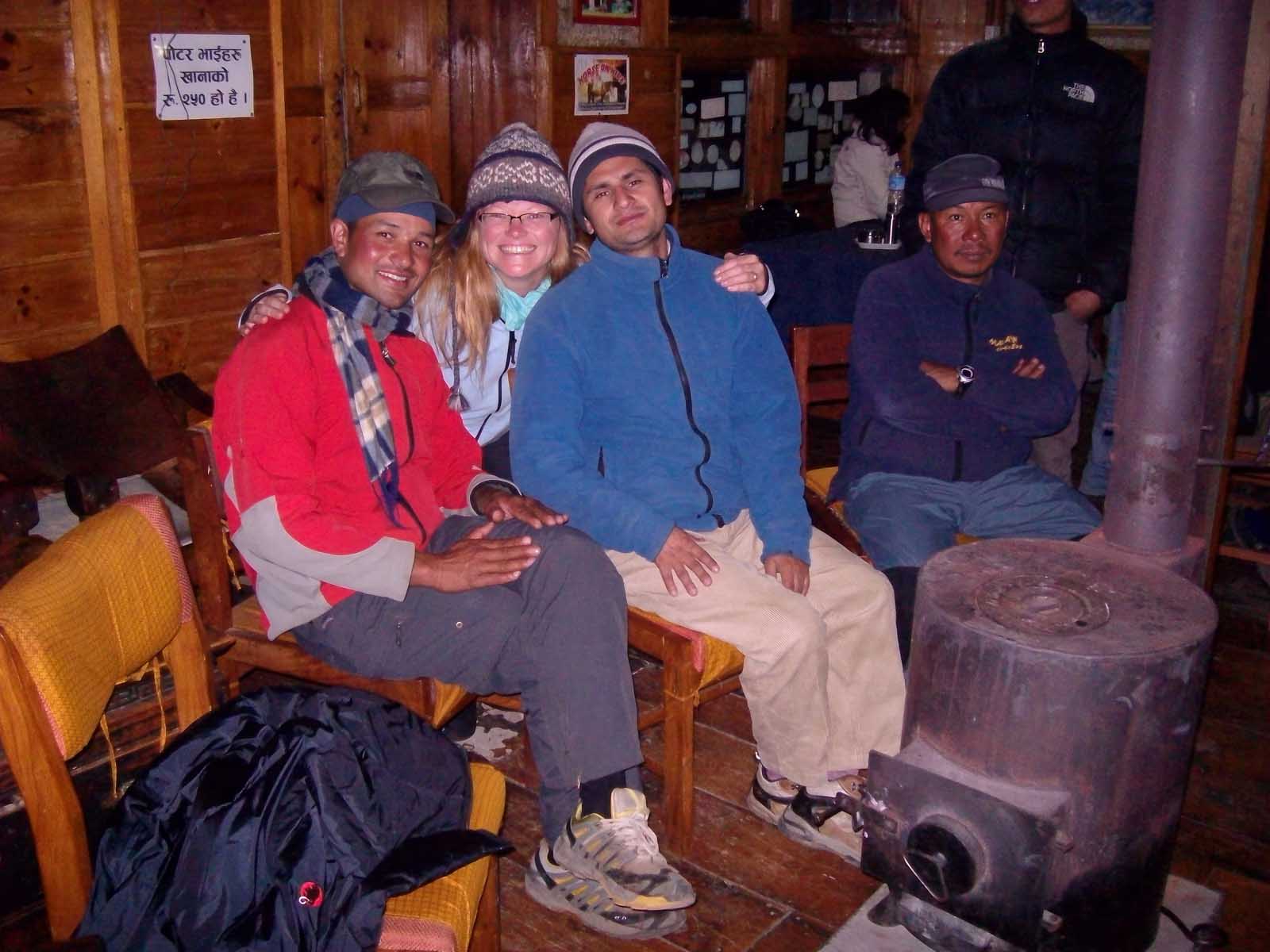
During the EBC Trek, you don’t stay in tents. You stay in charming teahouses with cozy beds, wood-burning stoves, and fully stocked restaurants that serve dinner.
The teahouses are a welcoming sight after a long day of trekking helping to make the trek to Everest one of the most memorable experiences of our lives. If you are planning to trek to Everest Base Camp in Nepal, read on for all the information you’ll need to help you prepare.
The main lodges of each teahouse we stayed in during the first half of our EBC trek were cozy and warm. At the lower elevations, woodstoves burned wood in the dining room and common areas and our rooms were a comfortable temperature with heating as we were wrapped up in our sleeping bags. We ate hearty meals of pasta and meat and enjoyed a relaxing night soaking in the amazing day we just had on the mountain.
- From Lukla – Elevation 2869 meters (9,350 feet)
- To Pakding – Elevation 2610 meters ( 8563 Feet)
- Length – 7.7 km (4.78 miles)
- Elevation loss – 79 meters (259 feet)
- Duration – 3 Hours
Day 2 – Pakding to Namche Bazaar
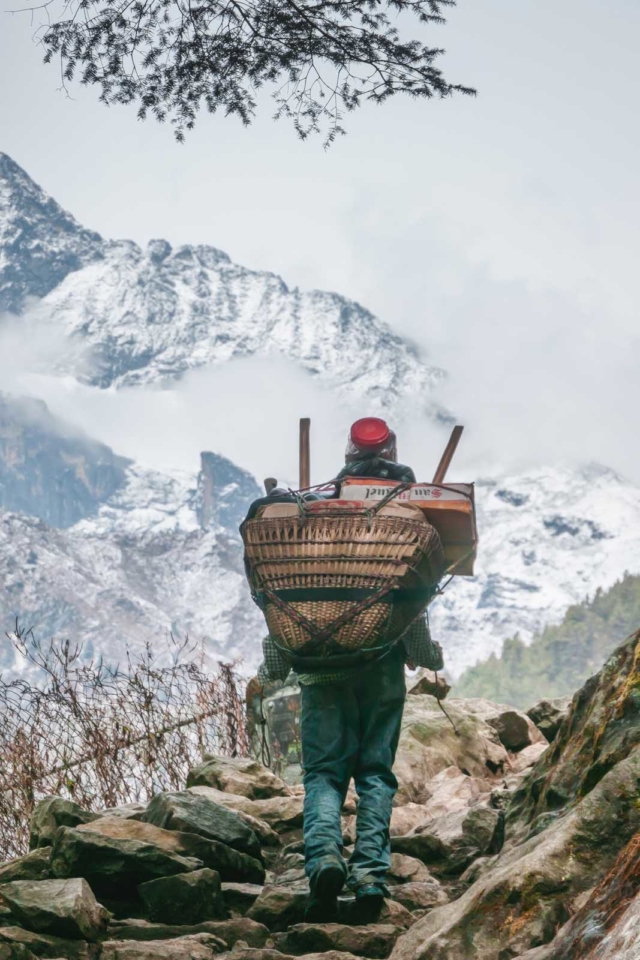
On day two, we checked in at another gate of the Mt. Everest park headquarters to show our documentation. We had to show our passports and give them extra passport photos to go into the log. (So make sure you have extra passport photos with you) Once we signed in, we were officially in the Khumbu region and officially on our way trekking to Everest Base Camp.
We covered a lot of terrain on day two making it the longest day of the Everest Base Camp trek. The trail up the mountains was steep and challenging but it was a memorable day.
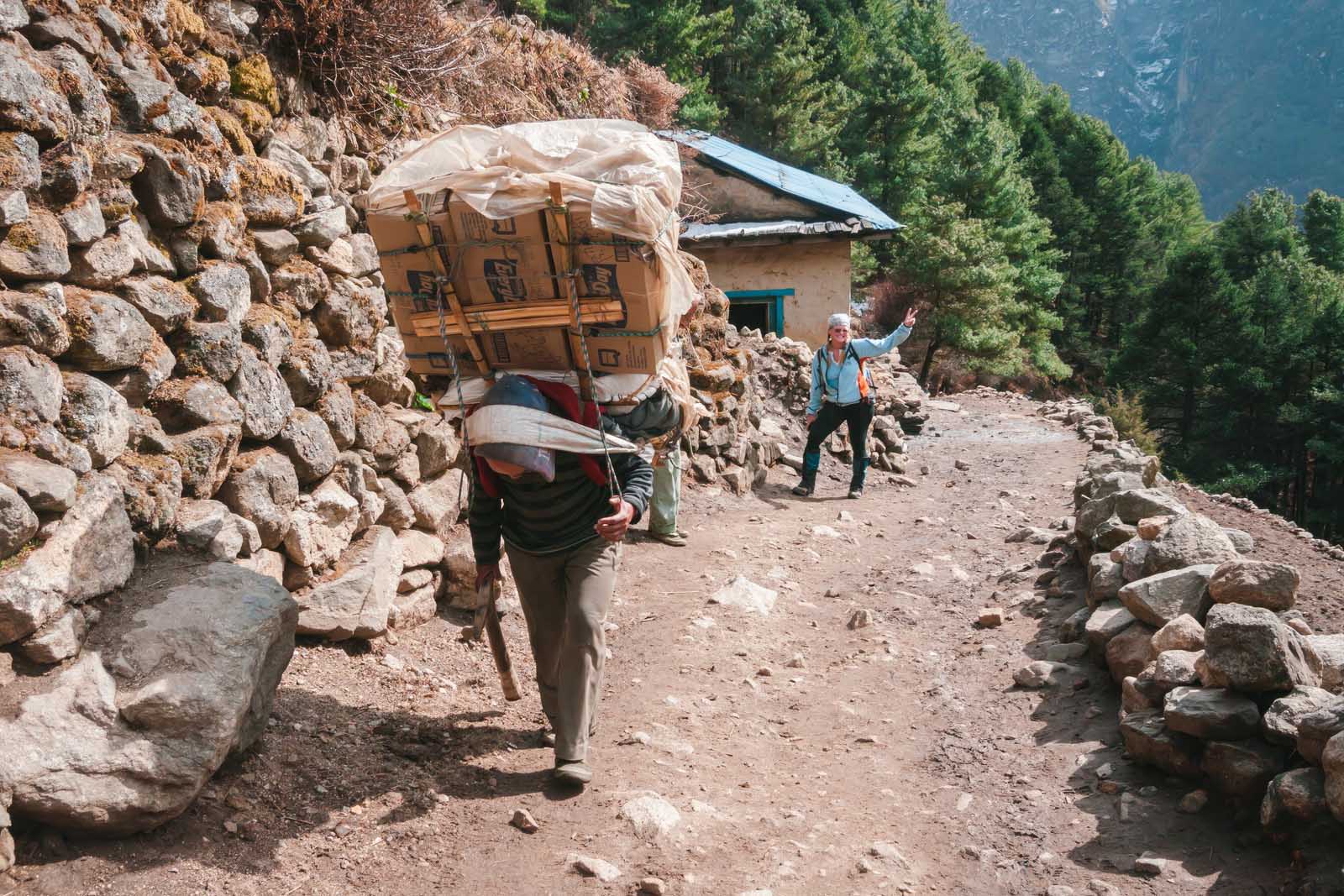
Day two of the EBC trek was a hike of almost 10km (6.2 miles) with an elevation gain of 800 meters (2624 feet). But throughout the hike, there was a lot of elevation loss mixed in so it felt like a lot more.
We would lose elevation as we descended into the valley only to have to climb back up again to a higher elevation. Today was a lot of fun though because we crossed several suspension bridges over Dudh Kosi River Valley.
Suspension Bridges on the way to Everest
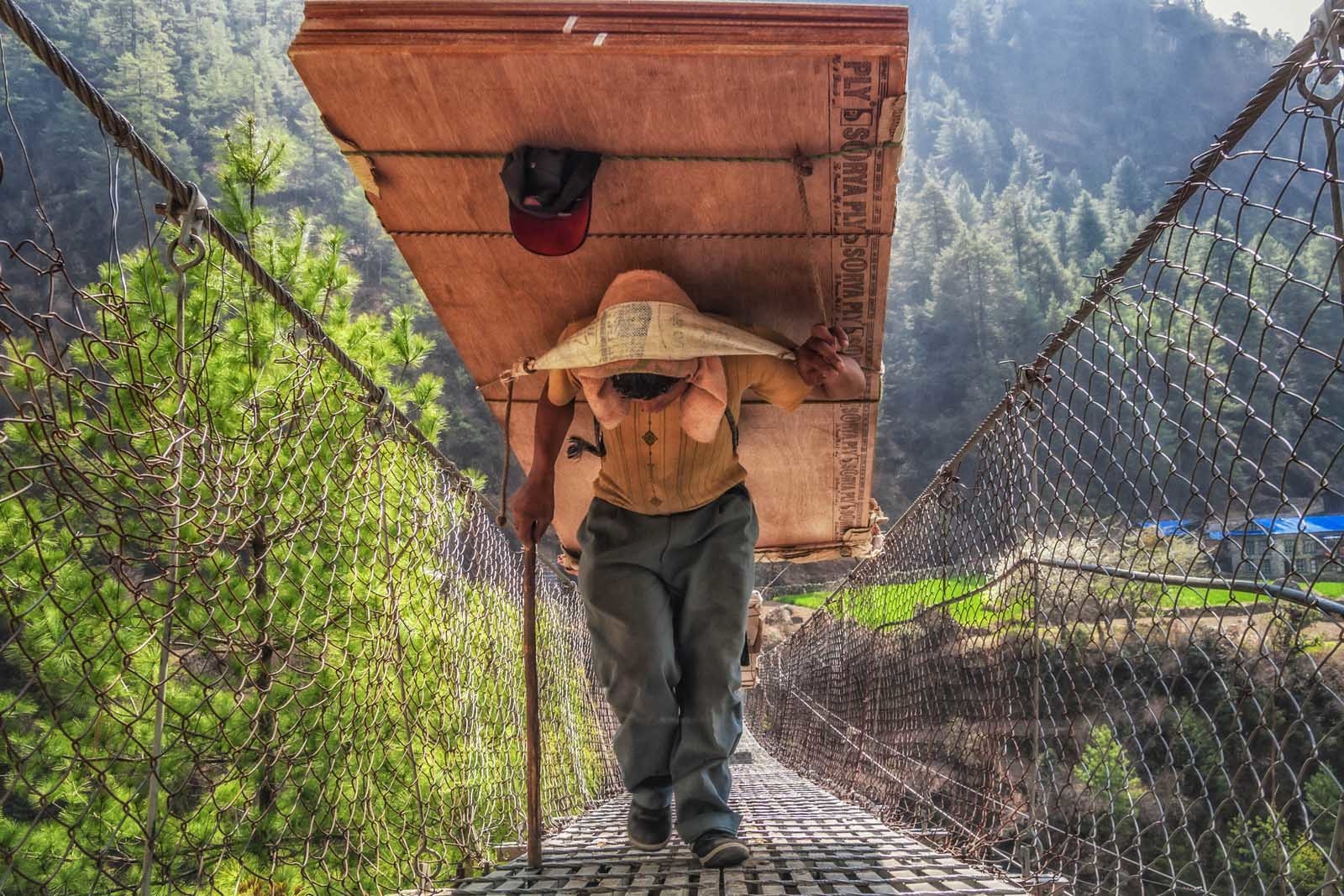
If you have a fear of heights, crossing suspension bridges may not be your favorite moment, but the suspension bridges while trekking to Everest Base Camp are well constructed, made of steel, and in excellent condition.
I was nervous about the suspension bridges. The Lonely Planet Guide said, “ Grit your teeth and climb onto a drooping suspension bridge floating at a dizzying height .” That sentence freaked me out.
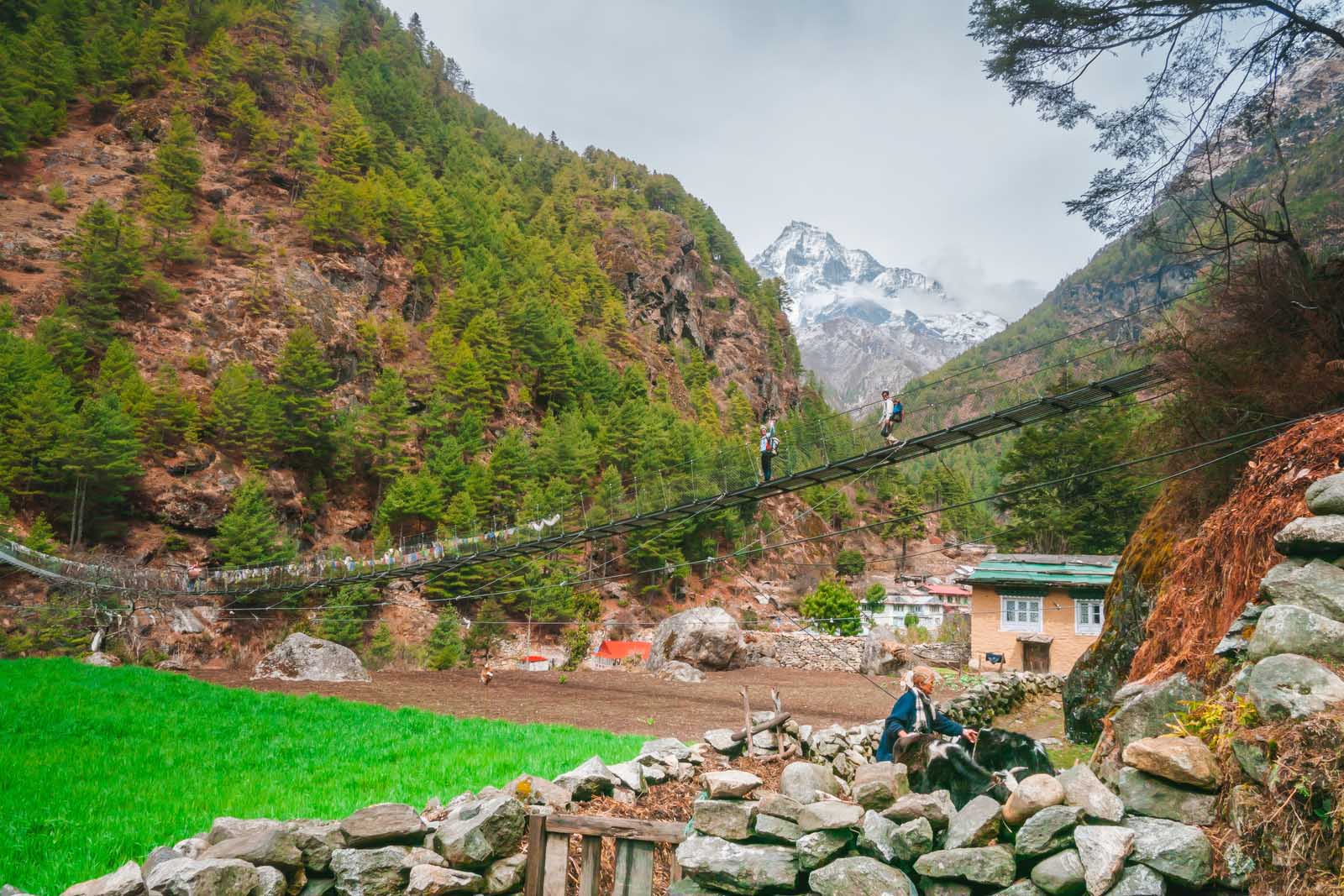
I had built the suspension bridges of the EBC trek in my head as something monstrous. But by the time we reached the first bridge, I wondered what all the fuss was about. Once I crossed my first bridge, my confidence was up and I was ready for anything the Everest trek was ready to throw at me.
Donkey Trains
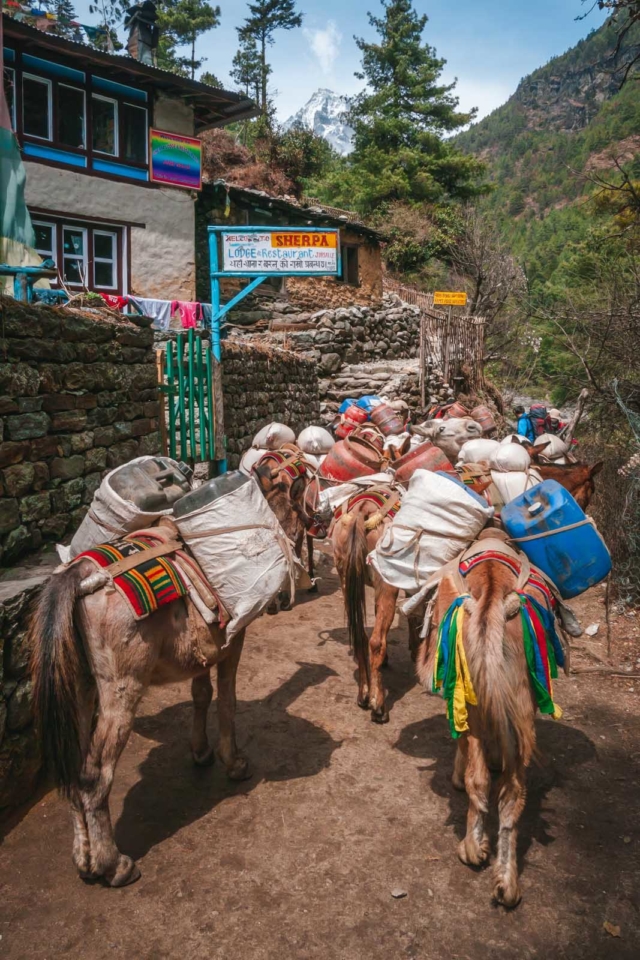
Today we also started to see a lot of donkeys, cows, and goats taking supplies to the villages. Traffic can get very heavy on the Everest Base Camp hike. When animal trains go by, make sure to get out of their way and stay to the side.
They are loaded down with heavy gear and they have a mission to keep on walking until they are done. They can easily nudge you right off the side of a cliff as no matter what is in their way, they just keep walking.
The trail is a highway, but instead of transport trucks or trains carrying cargo, people and farm animals carry everything from lumber and building supplies to food and kitchen appliances.
Safety Tips on the Everest Base Camp Trek for yaks and donkeys
- Important Tip: When a yak, donkey, or cow train passes you during the EBC trek, be sure to stand on the mountainside of the trail so they can’t push you over the edge !
- It is better to be squished into a mountainside than to go tumbling over the edge!
Final Stretch to Namche Bazaar
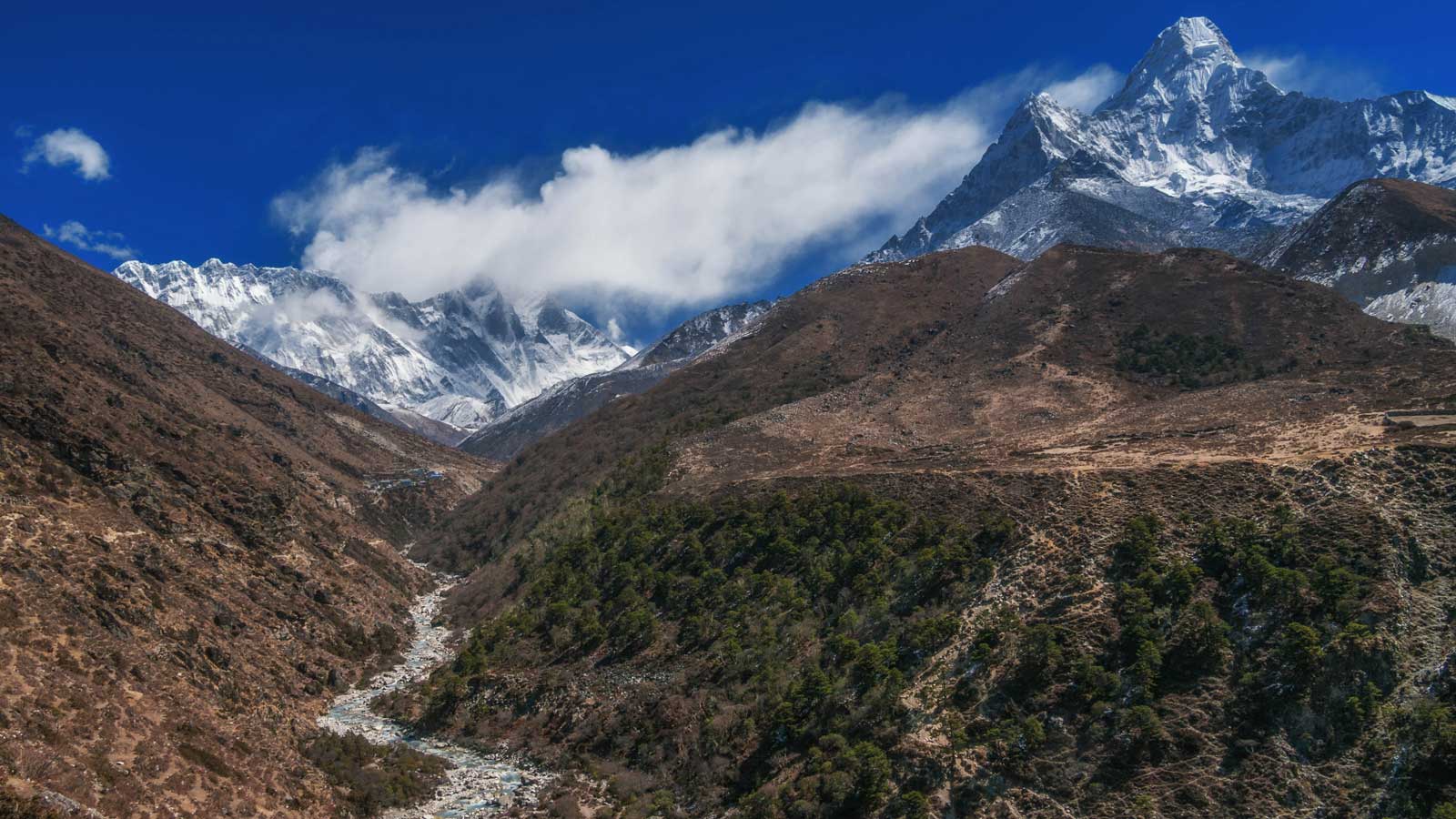
Right after crossing the last bridge, the hardest part of day two of trekking to Everest base camp started The last push of the day consisted of 2-hours straight uphill to Namche Bazar.
We were drenched with sweat but the air was cool. Whenever we stopped for a break, we would get a chill so we just kept on chugging away.
Large tour groups passed us quickly, only to be caught a few minutes later as they rested. We realize that we were the tortoise and they were the hare! Slow and steady is the way to climb at high altitudes and in the end, we made it to Namche Bazaar with plenty of time to spare in the day.
Arrival to Namche Bazaar
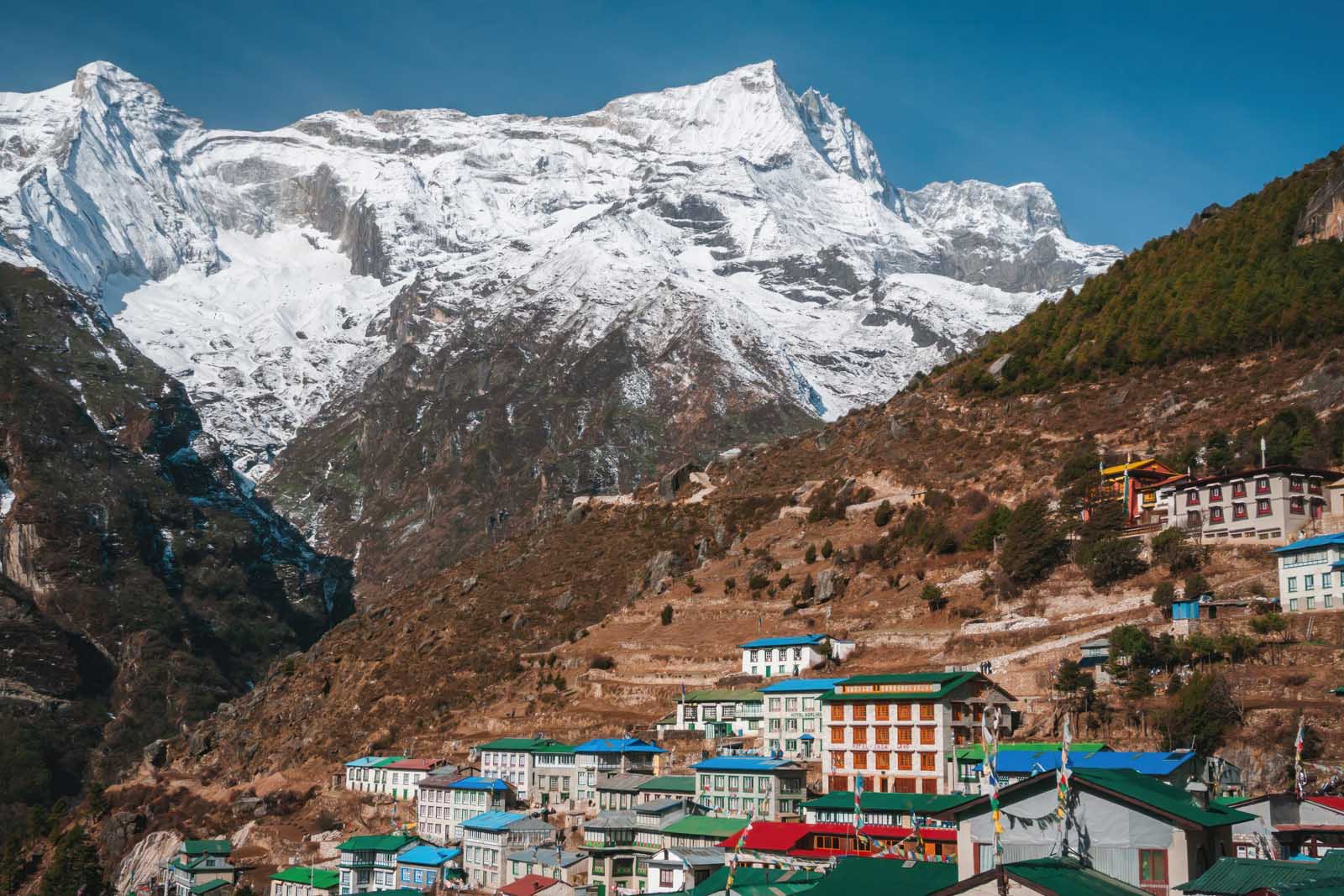
We checked into the security post and cringed when we found out that our lodge was an uphill walk for another 20 minutes. Rest had to wait a bit longer.
When we arrived at our accommodation, we were thrilled to see our porter Sher’s smiling face. He had already checked us in and put our bag in our room. We immediately went for a nap and then did a little walking around town in the evening to do some shopping and grab a bite to eat before turning in for an early night.
There are plenty of shops and restaurants at Namche Bazaar, this town is bustling and we spent two nights of our EBC Trek here which was awesome.
Pakding – Elevation 2610 meters ( 8563 Feet) Namche Bazaar – 3440 meters (11,286 feet) Elevation Gain – 830 meters (2723 feet) Distance – 10km (6.2 Miles) Duration – 6 hours
Day 3 – Acclimatization Day at Namche Bazaar
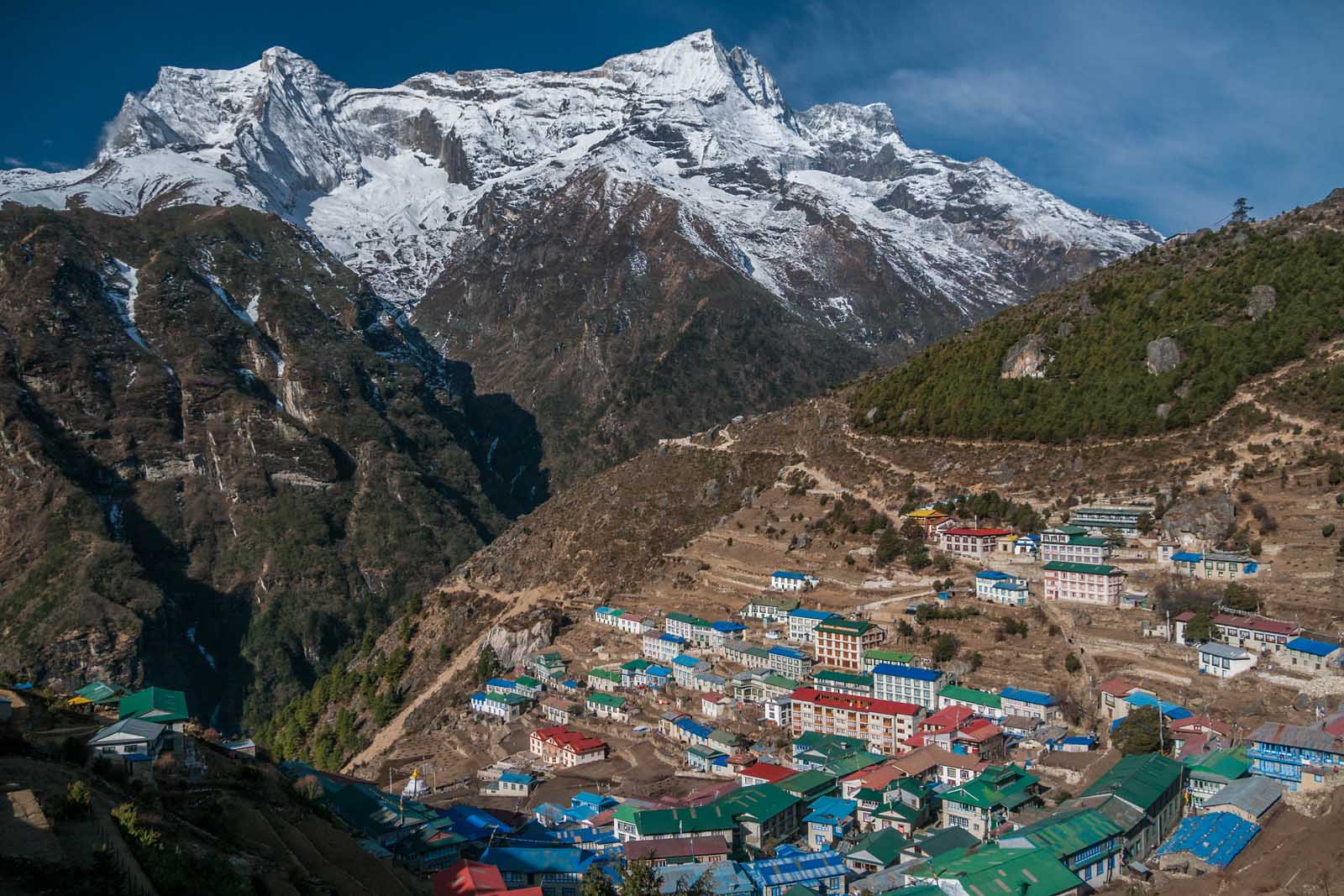
We had two glorious days at Namche Bazaar. Dipendra chose great accommodation for us throughout our EBC trek and we had a good rest in this splendid teahouse where we enjoyed delicious pasta, meats, and of course dhal baht. We spent the morning enjoying coffee and doing a bit of shopping.
What to do in Namche Bazaar
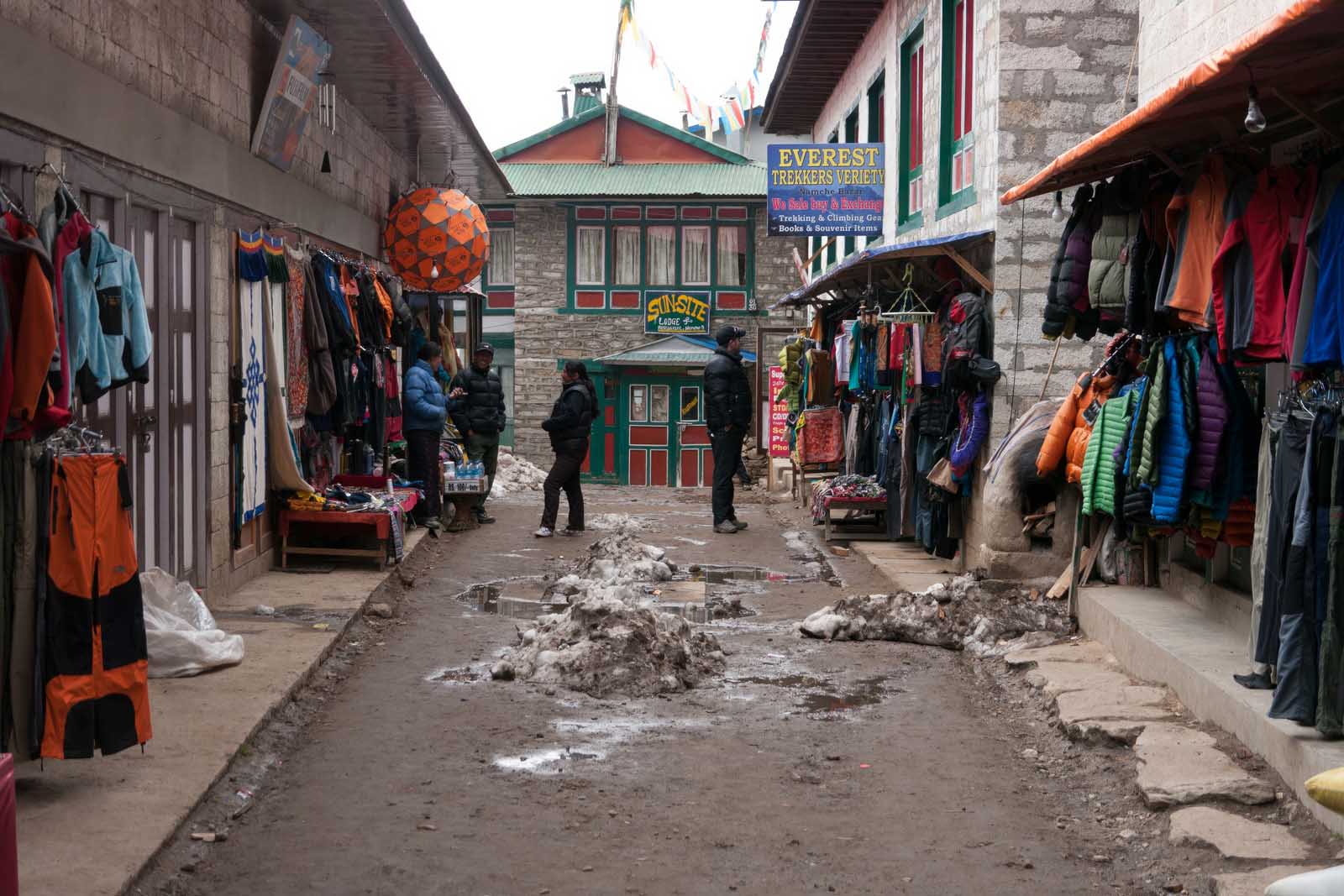
We explored Namche Bazaar and checked out its many shops. The streets are packed with shopping stalls and markets. We searched for gear that we missed getting in Kathmandu and got some great deals. We were surprised the prices weren’t inflated at Namche Bazaar.
We bought some down booties to keep our feet warm at night, a couple of sherpa hats, and a warmer set of gloves. The Everest Bakery was a highlight with delicious apple pie, fresh coffee, and WiFi. We had two pieces each!
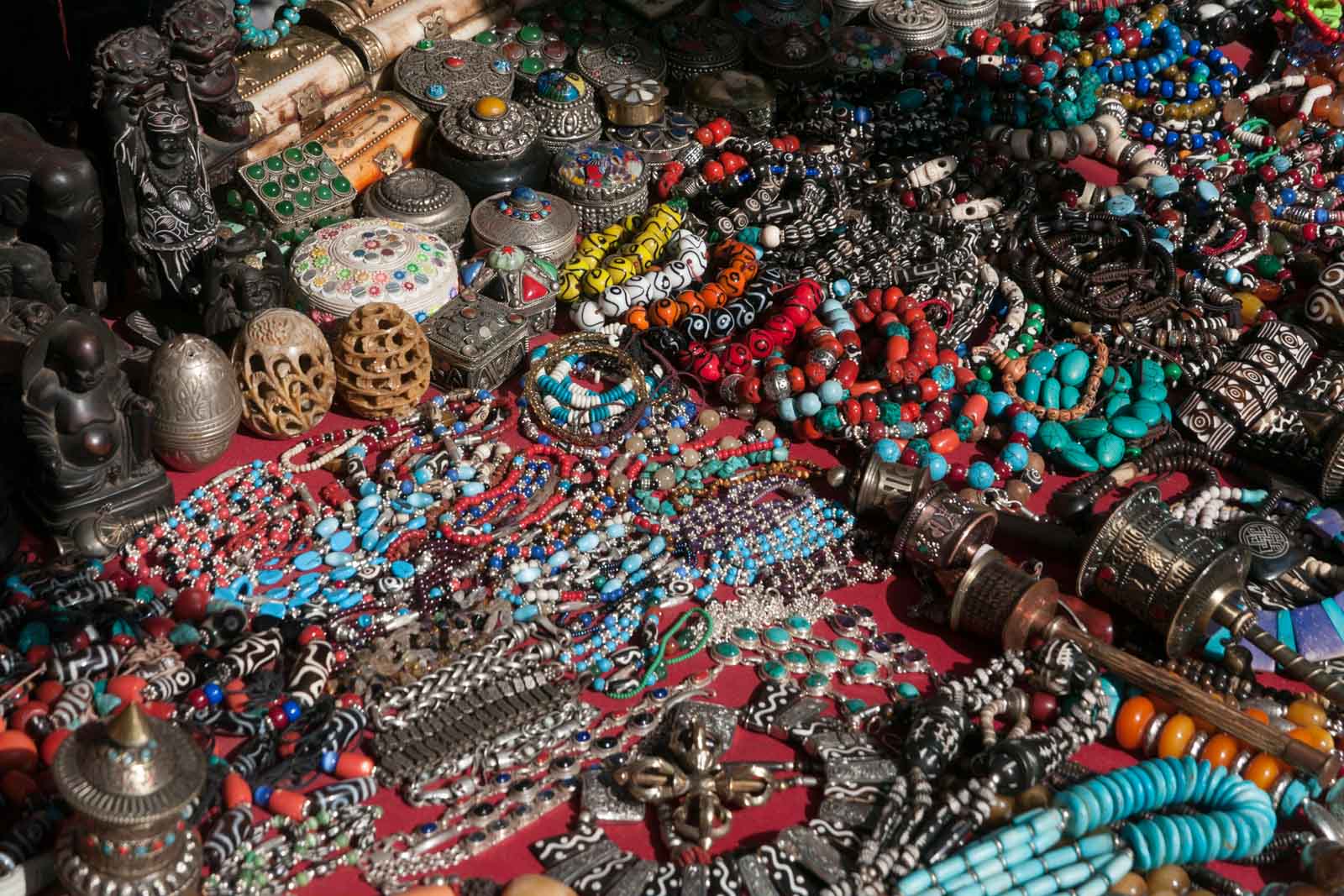
But we took it very easy, making sure to stay hydrated and to eat enough food to stave off altitude sickness. Namche Bazaar is located at a high altitude of 3440 meters (11,286 feet). We already saw a woman suffering from altitude sickness. She was having her blood pressure taken and heart rate monitored and when she got up, she was staggering as she leaned on her guide.
Her Everest base camp trek had already come to an abrupt end. It reminded us to relax because the days ahead were going to be tough. So we went back to our teahouse to relax and prepare for the rest of our journey
The Acclimatization Hike for EBC Trek
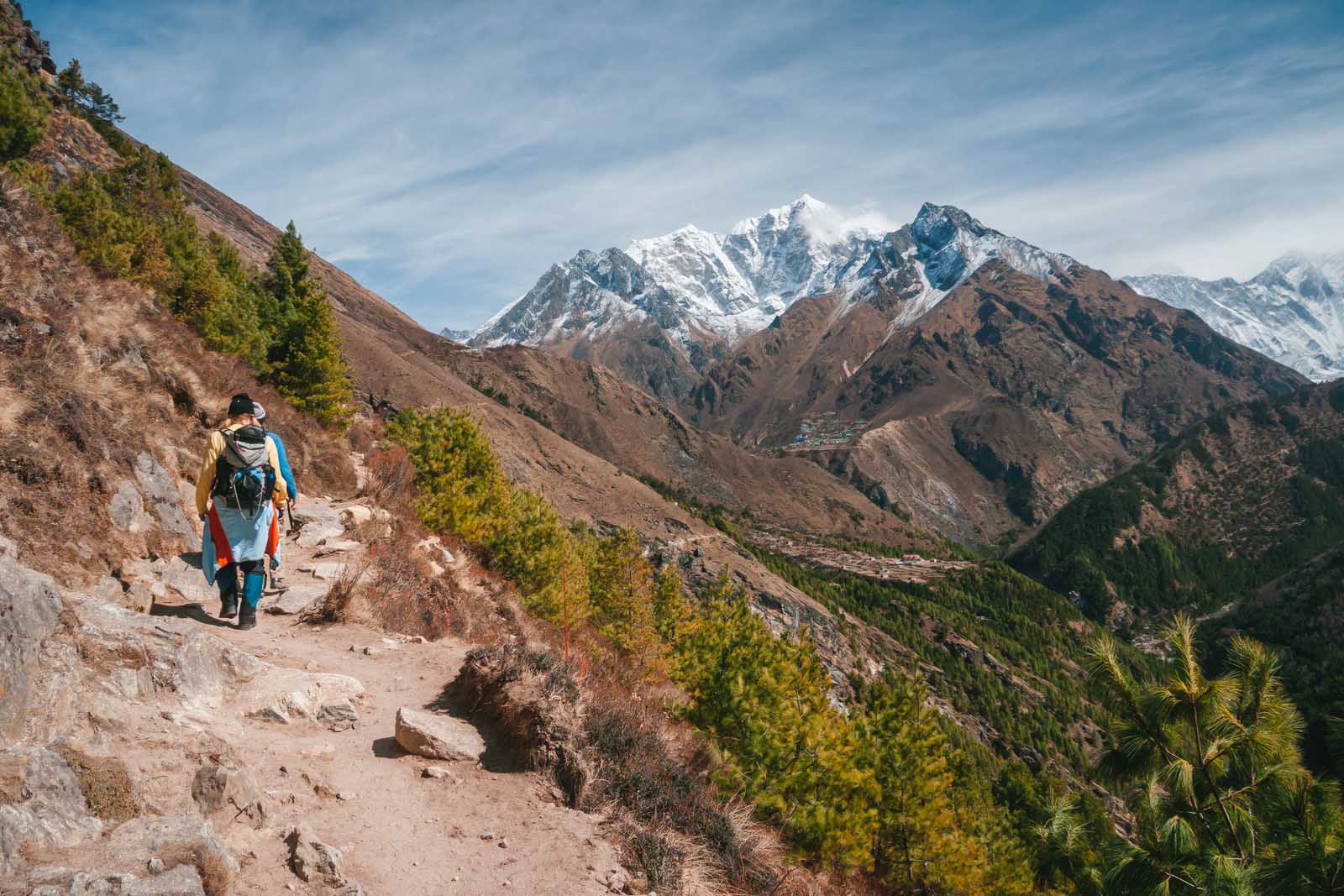
Most high-altitude treks have at least one acclimation day . The Everest Base Camp trek is no exception. An acclimatization day consists of hiking to a higher altitude and then coming back down to sleep at a lower elevation. It gives your body a chance to adjust to the altitude but you don’t stay for long.
As you will be constantly gaining altitude on the Everest Trek, it is good to have at least one day to climb higher and sleep lower to help prevent altitude sickness.
Our acclimation hike took us to the Everest View Hotel. With an elevation gain of only 400 meters, it wasn’t too much higher than our hotel in Namche Bazaar, but it is enough to help acclimate to the high altitudes. Everest View Hotel offers amazing views of Mount Everest (hence the name). Plus it holds the Guinness book of world records as the highest hotel in the world.
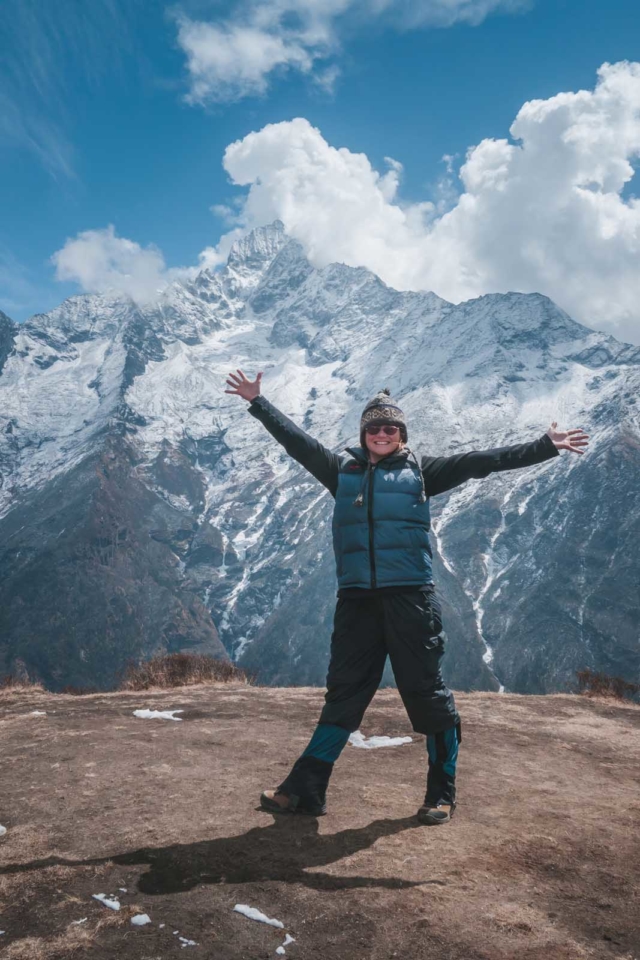
It is not an easy day off though. Just walking through town takes your breath away. As we made our way up the steps, I wondered if I should have just stayed in bed and skipped the viewpoint to relax. When we started the climb I was breathing heavily just walking up a few flights of steps. We hadn’t even left Namche Bazaar and I was pooped!
Once we got on the trail, things became easier. The steep grade gave way to a sloping trail and I started to feel better. After one and a half hours of climbing, we reached what has to be the world’s highest airstrip at 3700 meters (12,139 feet). We arrive just in time to see a small plane take off.
First Views of Mt. Everest
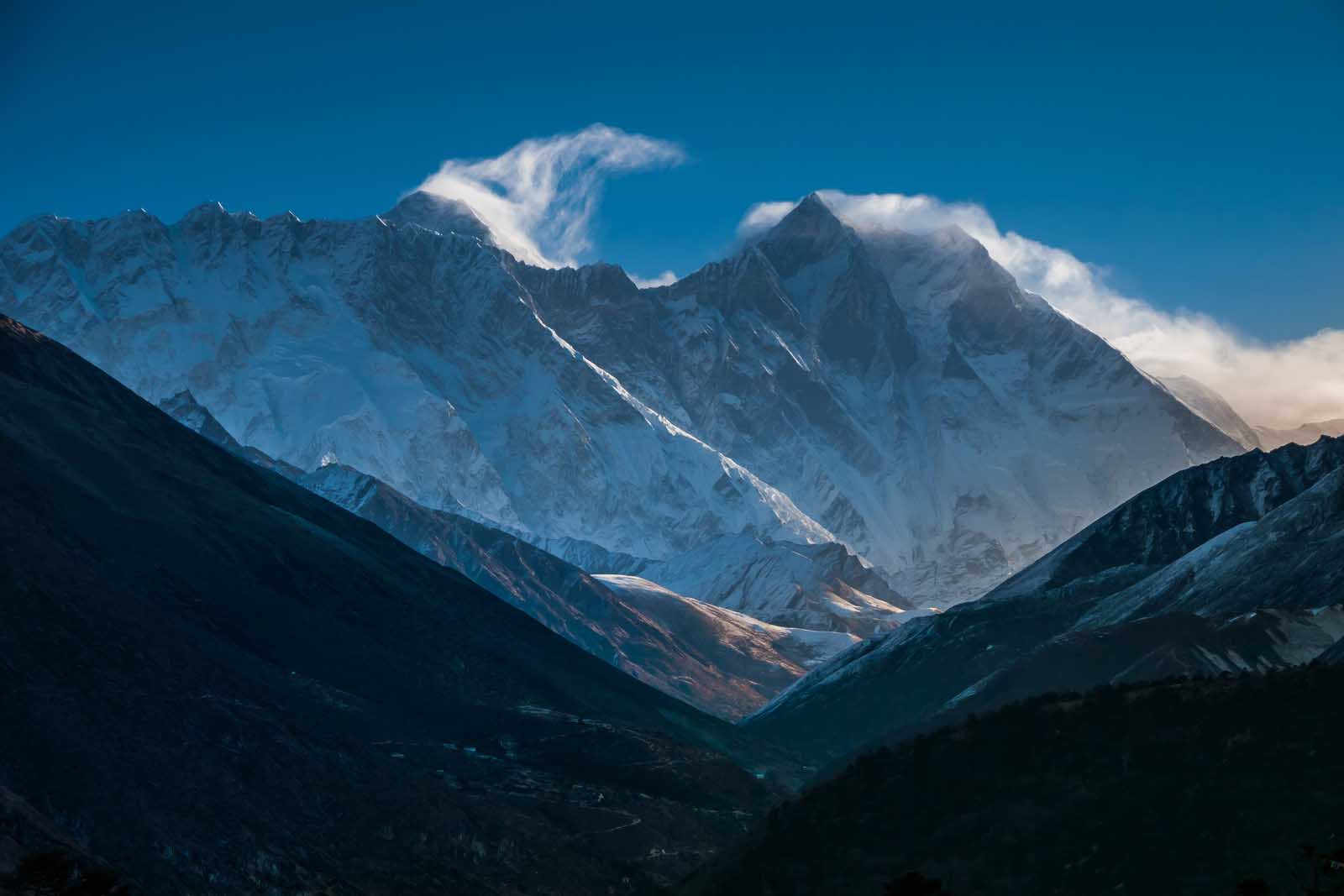
It was here that we got to see our first breathtaking views of Mt. Everest and the surrounding mountains. We hiked a bit farther and there it was, standing quietly behind the other highest peaks of the earth.
Lhotse, Changri, Ama Dablam, and Nuptse surround the mighty Mount Everest, the world’s highest peak. At 8414m (27,604 feet), 6027m (19,773 feet), and 7861m (25,790 feet) they are the little sisters of this sacred mountain. Mount Everest stands at 8848 meters (27,716 feet).
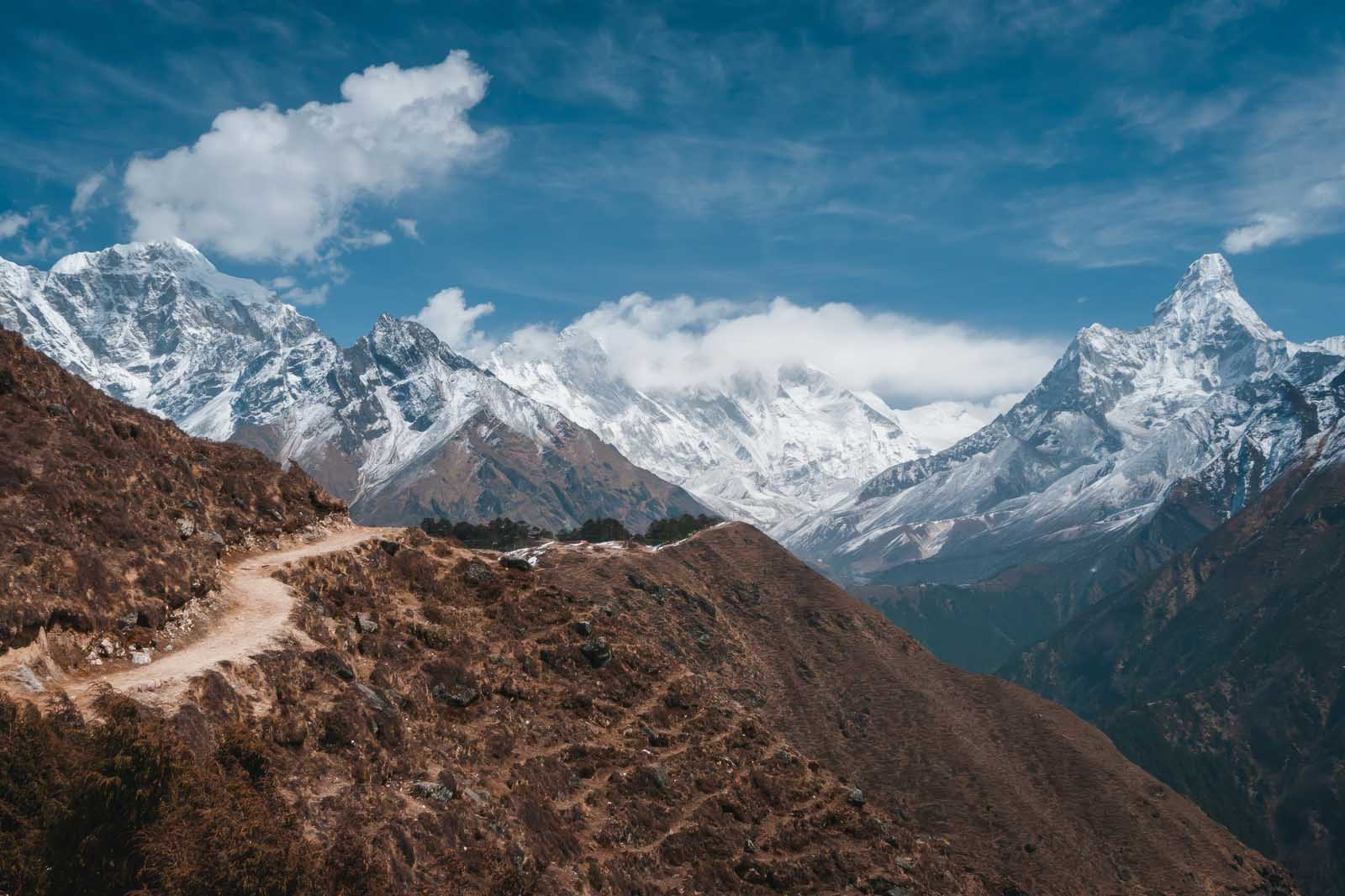
The deep Khumbu valley views were magnificent. The river wove far below, carving through the panorama of the white mountain tops. We walked a narrow trail snaking along the side of a steep mountain and suddenly realize “this trek has become real.” We were high in the Himalayas and one false move could mean catastrophe falling into the abyss below.
The sky was a deep blue and the white summits reached toward the billowing clouds. The view was so awe-inspiring it brought me to tears. Everything was so crisp and clear. During the EBC trek, you feel as if you could reach out and touch heaven.
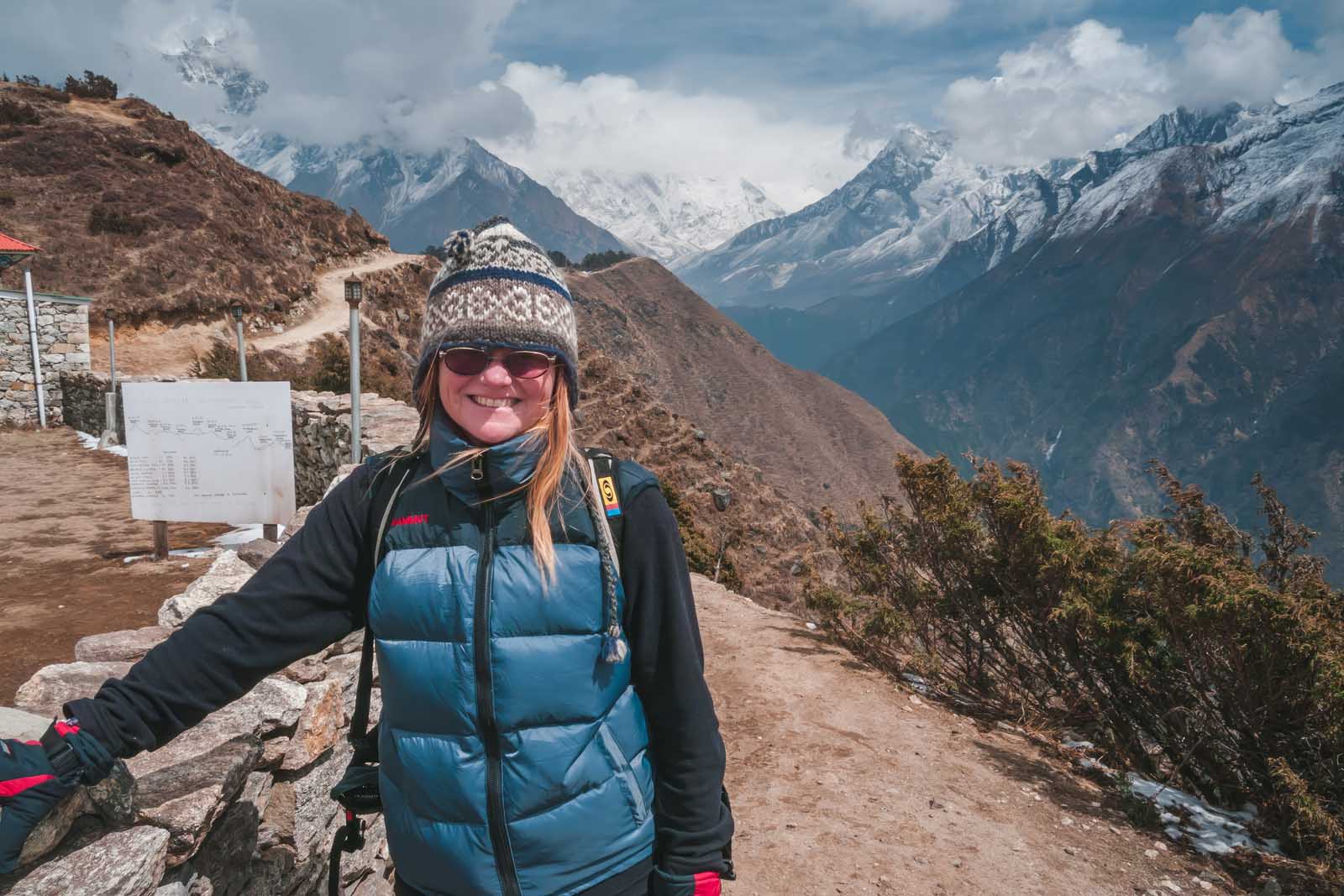
The clouds rolled in quickly so it was time to go. The weather conditions change quickly on the Everest base camp hike, so it is good to have the experience of a guide leading us through all terrain and conditions. We went back to Namche Bazaar to relax and gain strength for the rest of the trek.
Namche Bazaar – Elevation – 3440 meters. (11246 feet) Everest View Hotel – 3880 meters (12,730 ft.) Elevation – Bounce of 440 meters (1443 feet) Duration – 3 hours return Elevation Gain – 0 km
Day 4 – Namche Bazaar to Tengboche
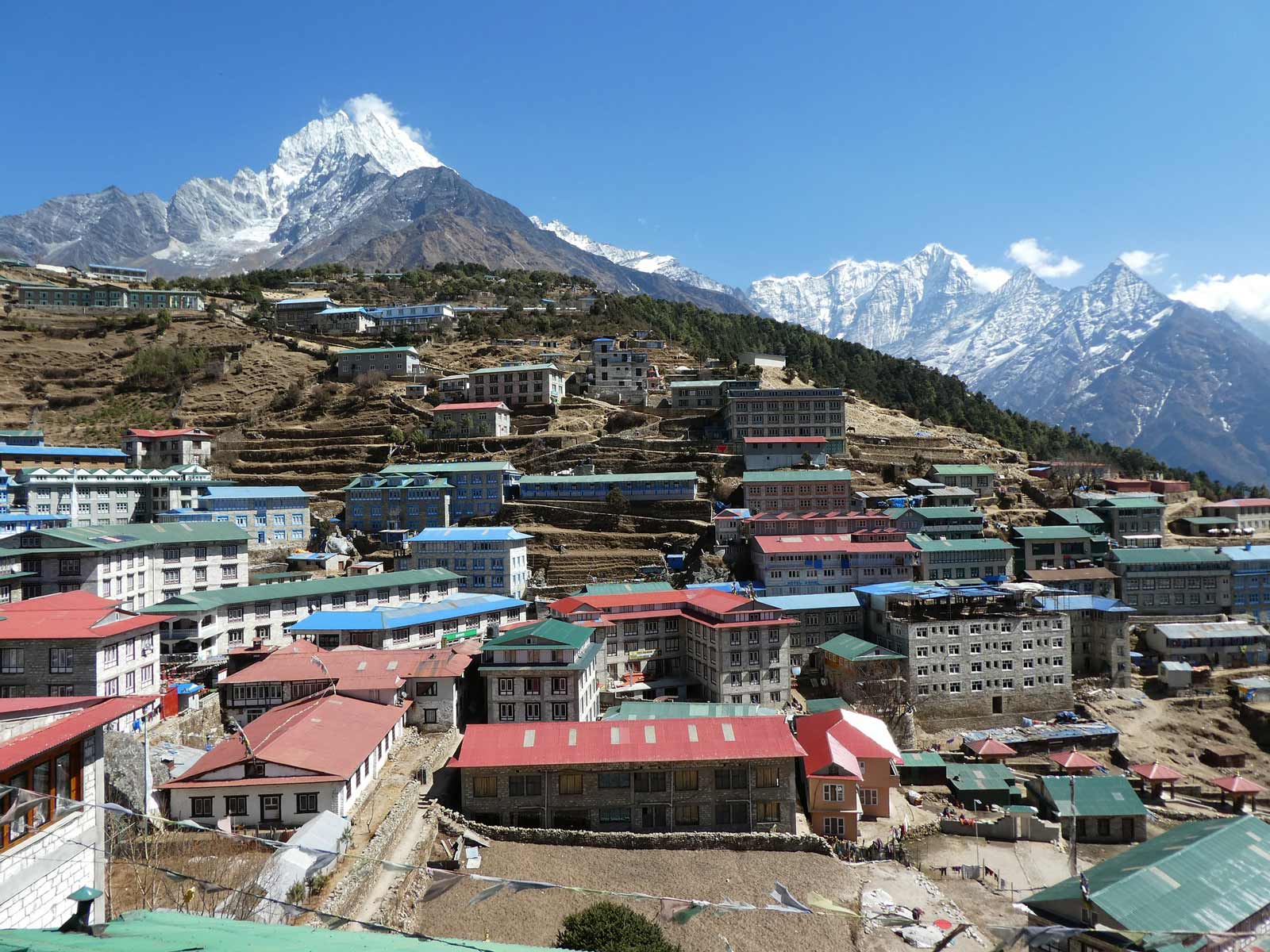
We awoke earlier than usual on Day 4. Two large group treks (Intrepid Travel and G Adventures) had checked into our lodge and we didn’t want to have to compete for service or breakfast. We also didn’t want to have to wait in line for the bathroom.
Lodges become more and more sparse as you go higher on the Everest Base Camp Trek and fewer toilets are shared between more people. Up until now, we hadn’t encountered crowds of people. It had been pretty quiet on the mountain and we liked it that way.
Luckily, we were a day ahead of the other tours. They had to stay in Namche Bazaar for another day to acclimate to the high altitudes, So we moved on to enjoy our EBC Trek free from crowds of people – for now.
Tenzing Norgay Memorial Stupa
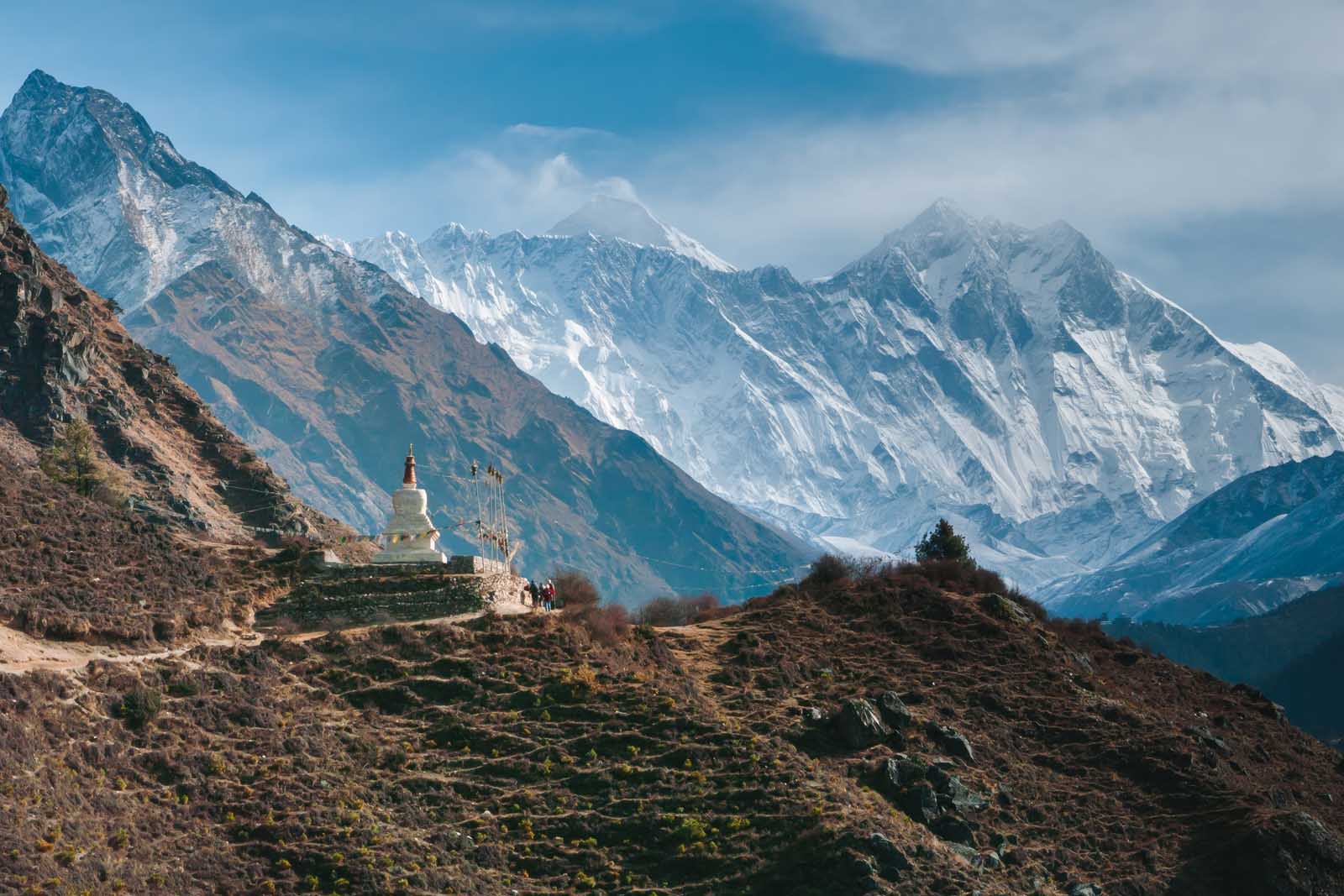
During day 4 of the EBC trek, we hiked along trails clinging to the side of the mountain. The narrow trekking trails along this route were a little scary. They wound along the edge of the cliff with nothing but a sheer drop to the abyss into the Khumbu Valley. But we kept our wits about us putting one foot ahead of the other until we reached the Sherpa Monument.
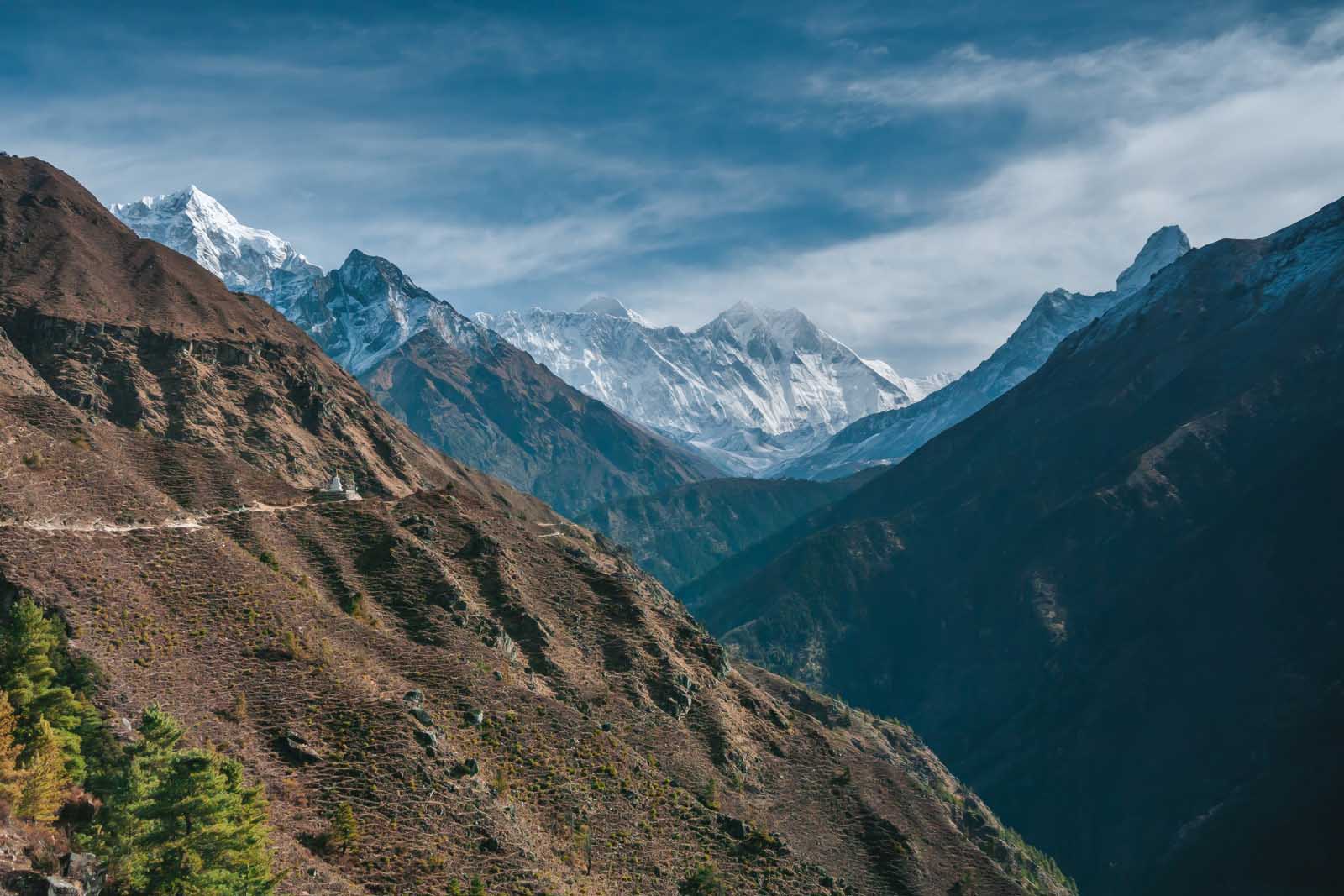
Tenzing Norgay Sherpa monument was erected by the Norgay family. It is a stupa honoring Tenzing Norgay Sherpa and all the Sherpas that risked their lives to help climbers reach the summit of Mt. Everest.
All treks pass this monument and it is an important stop on the journey to pay respect to the famous Sherpa of the Everest region. In case you don’t know, Tenzing Norgay Sherpa was the first man to summit Everest along with Sir Edmund Hillary.
What is a Sherpa?
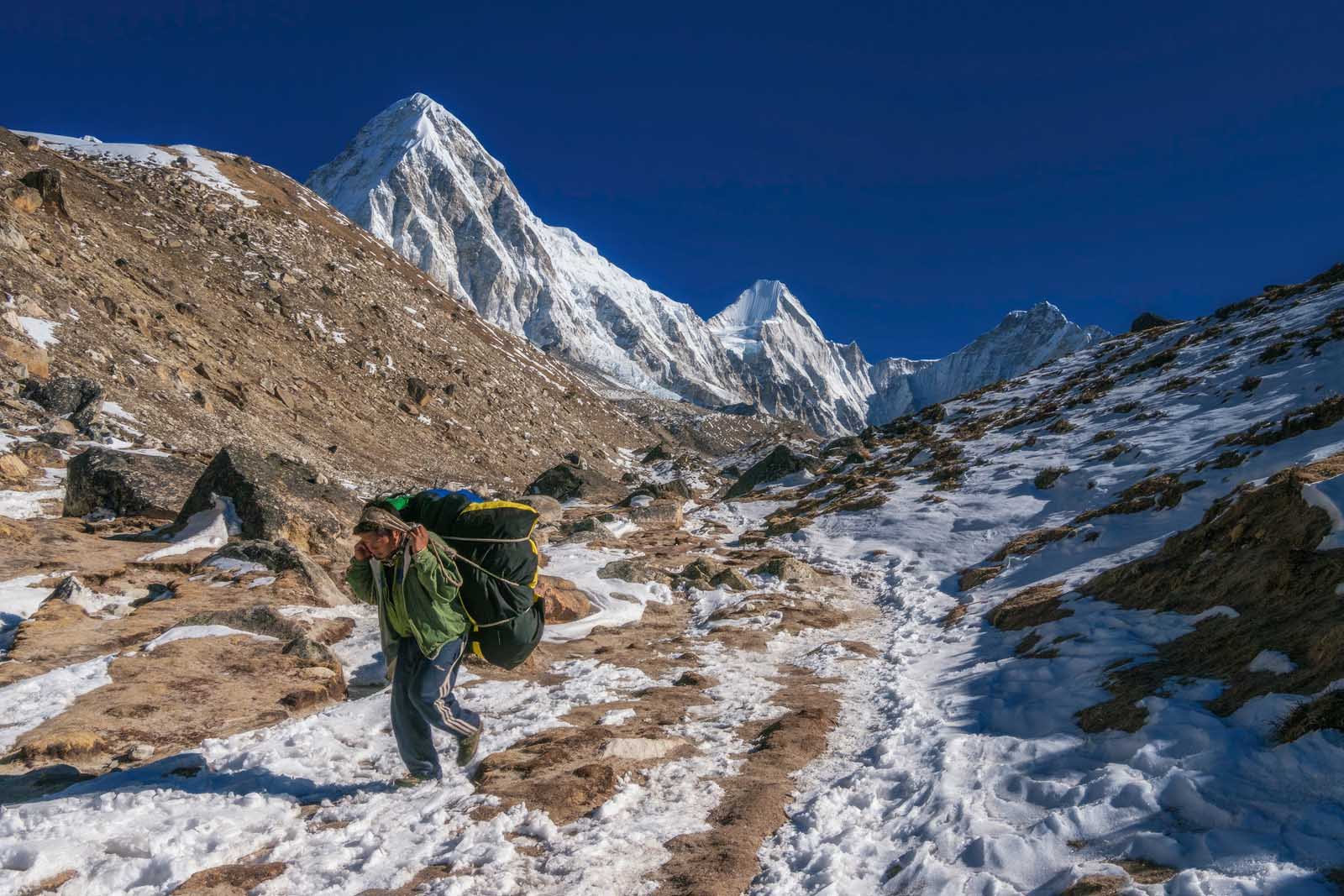
Sherpas are the unsung heroes of Mt. Everest. They do all of the hard work and technical work on the mountain. They carry the heavy loads, set the ladders and ropes to cross the Hillary Step and Khumbu Icefield for mountain climbers, and they take care of setting up camp while climbers and trekkers catch their breath and try to survive life on the world’s highest peak.
Difference Between a Sherpa and a Porter
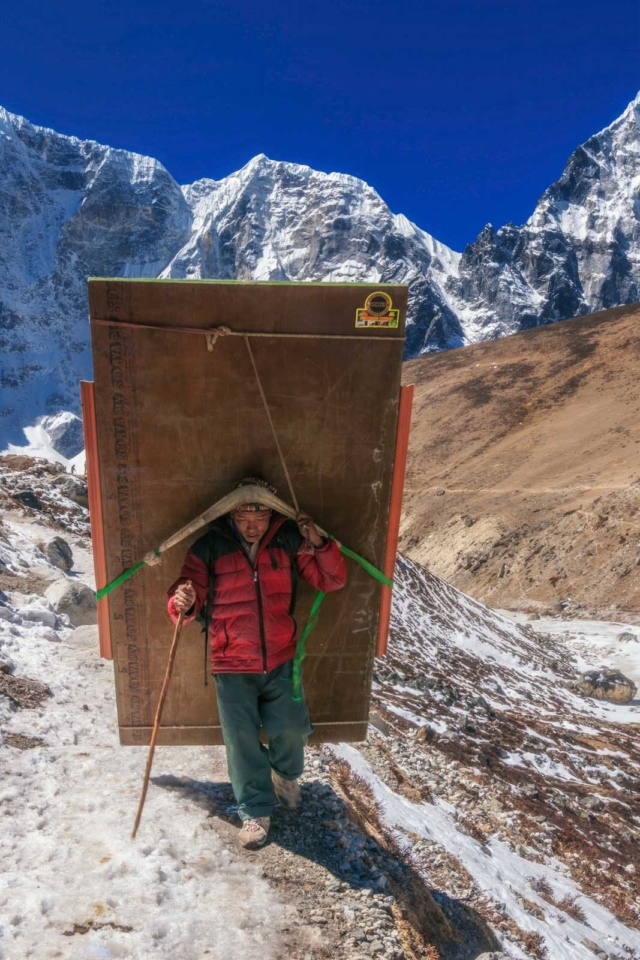
Sherpas and porters are very different from one another. We learned that a Sherpa is actually the name of an ethnic group from Tibet. The original mountaineers hired Sherpas as their guides in the Himalayas and the world has now adopted the name for porters in the Everest region. If you aren’t born into the Sherpa ethnic group, you cannot be called a Sherpa. Porters are porters and Sherpas are Sherpas.
We were told that some porters, especially commercial porters carry up to 60kg (150 pounds) of supplies and gear to businesses located along the EBC trek. That is a lot of weight and we were very surprised. When climbing Mount Kilimanjaro , porters had a mandatory weight limit of 35kg. (77 pounds).
Dipendra told us that they get paid per kilo so some people push it too far. The Nepalese are a strong bunch but this is a lot to carry at such a high altitude no matter what shape you are in.
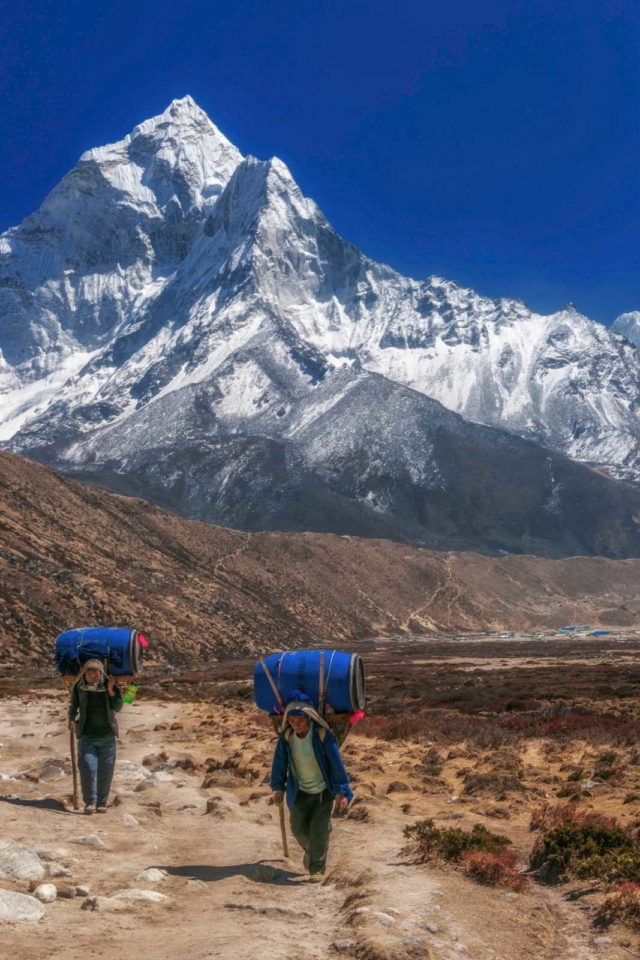
We kept our pack as light as possible at around 22kg (48 pounds) for Sher and we even felt bad about that! We have heard there is a 30kg (66lb) limit for Everest, but judging by what we saw other porters carrying on the Everest Base Camp hike, people were pushing it well beyond that.
We saw men carrying stacks of plywood with heavy white sacks loaded on top. We saw men carrying propane tanks, doors, and huge packs. What could people possibly need on the EBC Trek that they packed their packs so full? Read more: Packing List for Everest Base Camp Trek
Approaching Tengboche
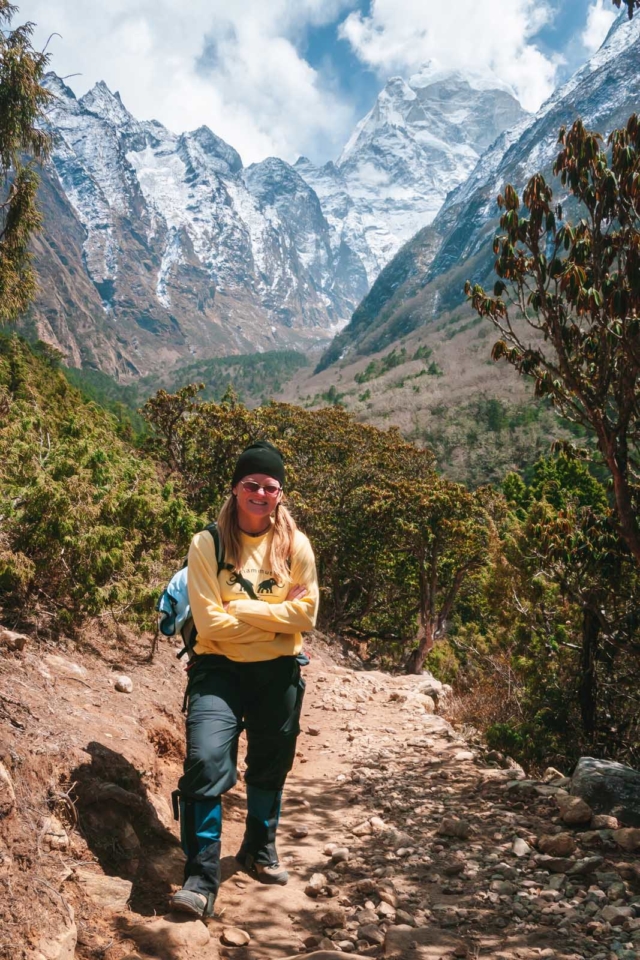
The final push of our EBC Trek day 4 was to Tengboche Monastery. It was a tough yet steady 2-hour steep climb. We are now gaining altitude climbing above the tree line. We put our heads down and huffed and puffed our way up. We didn’t stop for any photos or videos and were surprised to cut the climb down to just one and a half hours.
We reached the prayer wheels of Tengboche Monastery just in time for light snow to start falling. We made it into our camp at Tengboche by 1:30 pm and had the entire afternoon to ourselves at 3900 meters (12795 feet). This is an excellent place on the Everest Base Camp hike to have some extra time to relax as there are a few special things to see and do.
Tengboche Monastery
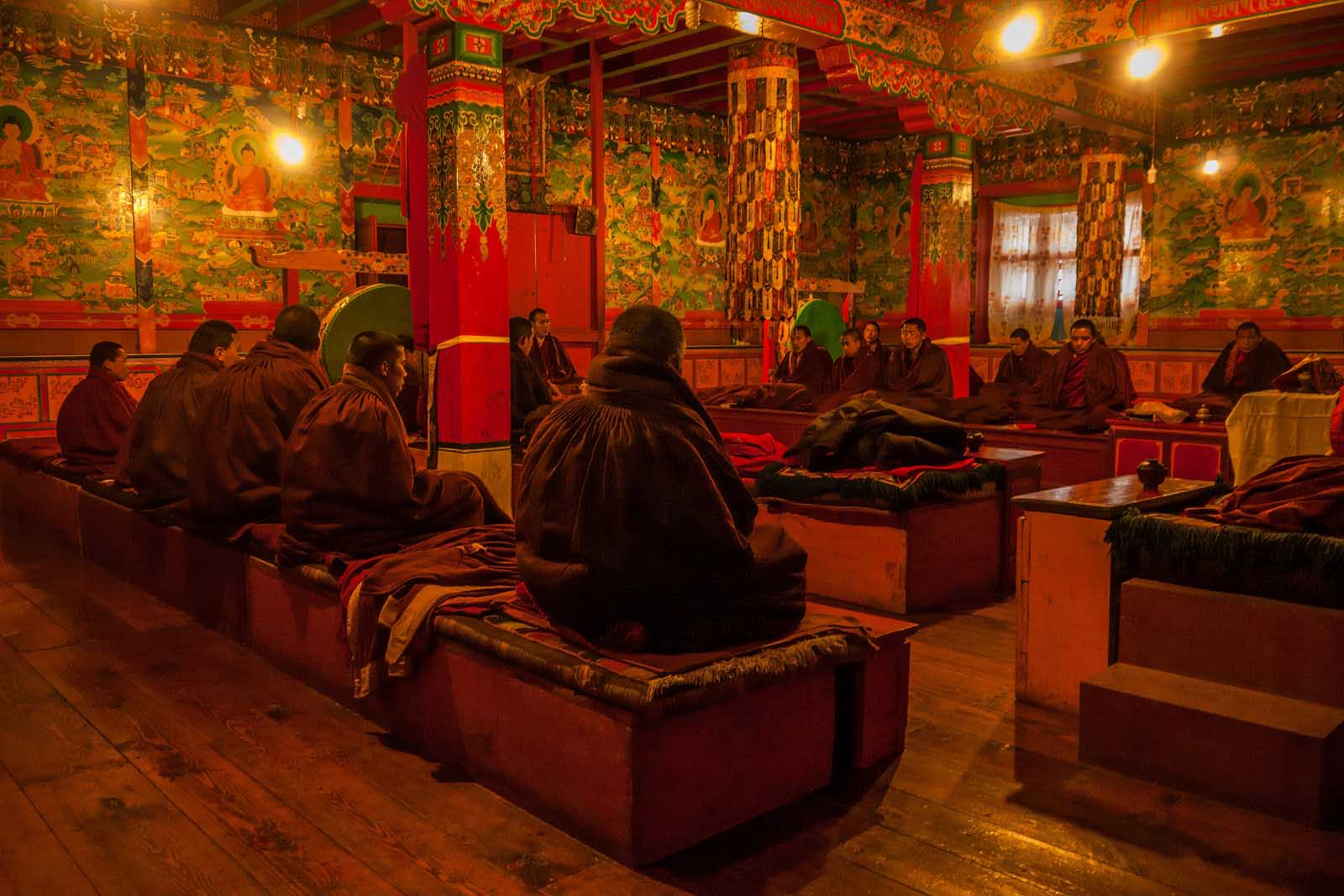
We warmed our feet with our new down booties that we bought at Namche Bazaar and changed into some dryer clothes before heading off to see the monks chant at Tengboche Monastery. Our guide Dipendra told us that this is the most important monastery in the region. All climbers summiting the mountains stop at this monastery to be blessed by the monks.
We were allowed to watch the ceremony and to take in the warmth and blessings from the monks. It is a sacred place and all climbers and trekkers stop here before continuing up the mountains.
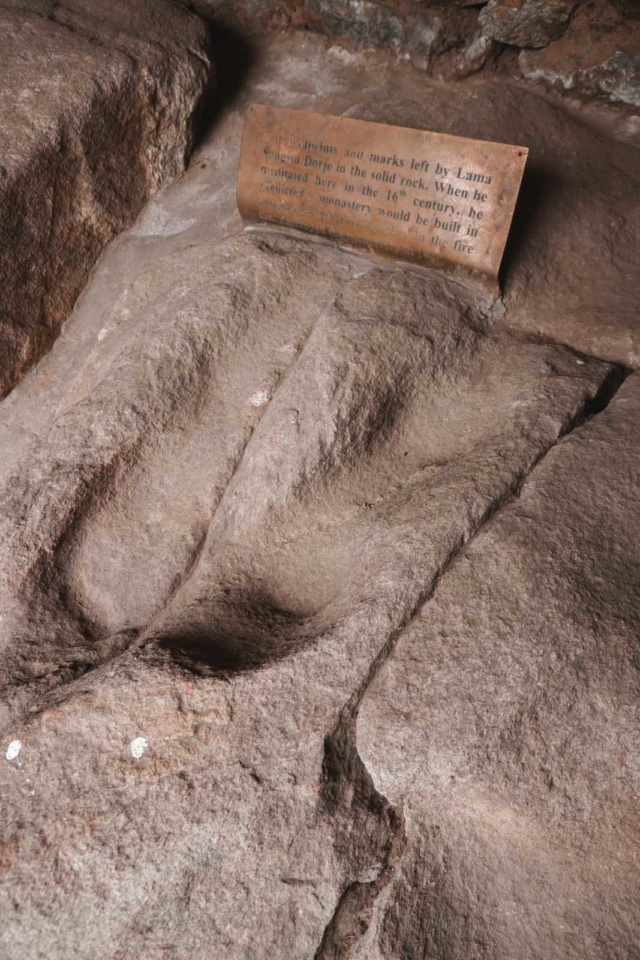
The footprints of Lama Pagna Dorje from the 16th century are embedded in solid stone in front of the monastery. A place where he mediated and raced through the Himalayas riding the wind with his mind.
Apparently, he sat on this stone for so long, his feet left their mark. He spent years traveling the world through the power of his mind and we believe the story. Especially after our yoga experience in Goa India. He predicted that a monastery would be built here and surprise surprise…here it is.
The View from Tengboche Monastery
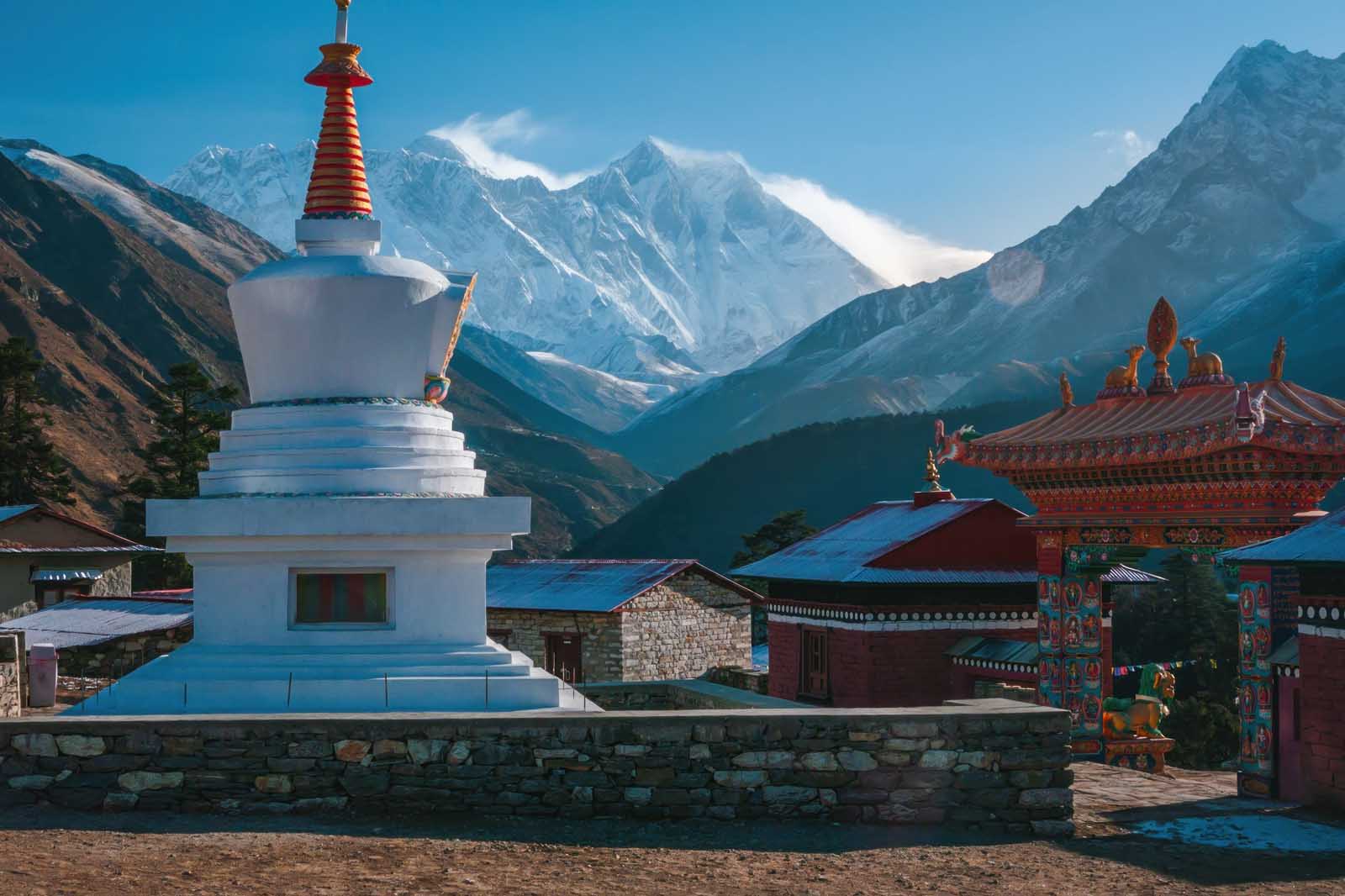
The view is magnificent from Tengboche Monastery. The valley is wide and opens up to massive rolling hills giving way to the highest peaks on earth. Plus it has a clear view of Mt. Everest and the surrounding mountains.
We were told that Sir Edmund Hillary came back to survey the peak of Mount Everest from this spot because the view is so clear of the mountain and we can understand why.
Accommodation – Basic Tea Houses at Higher Altitude
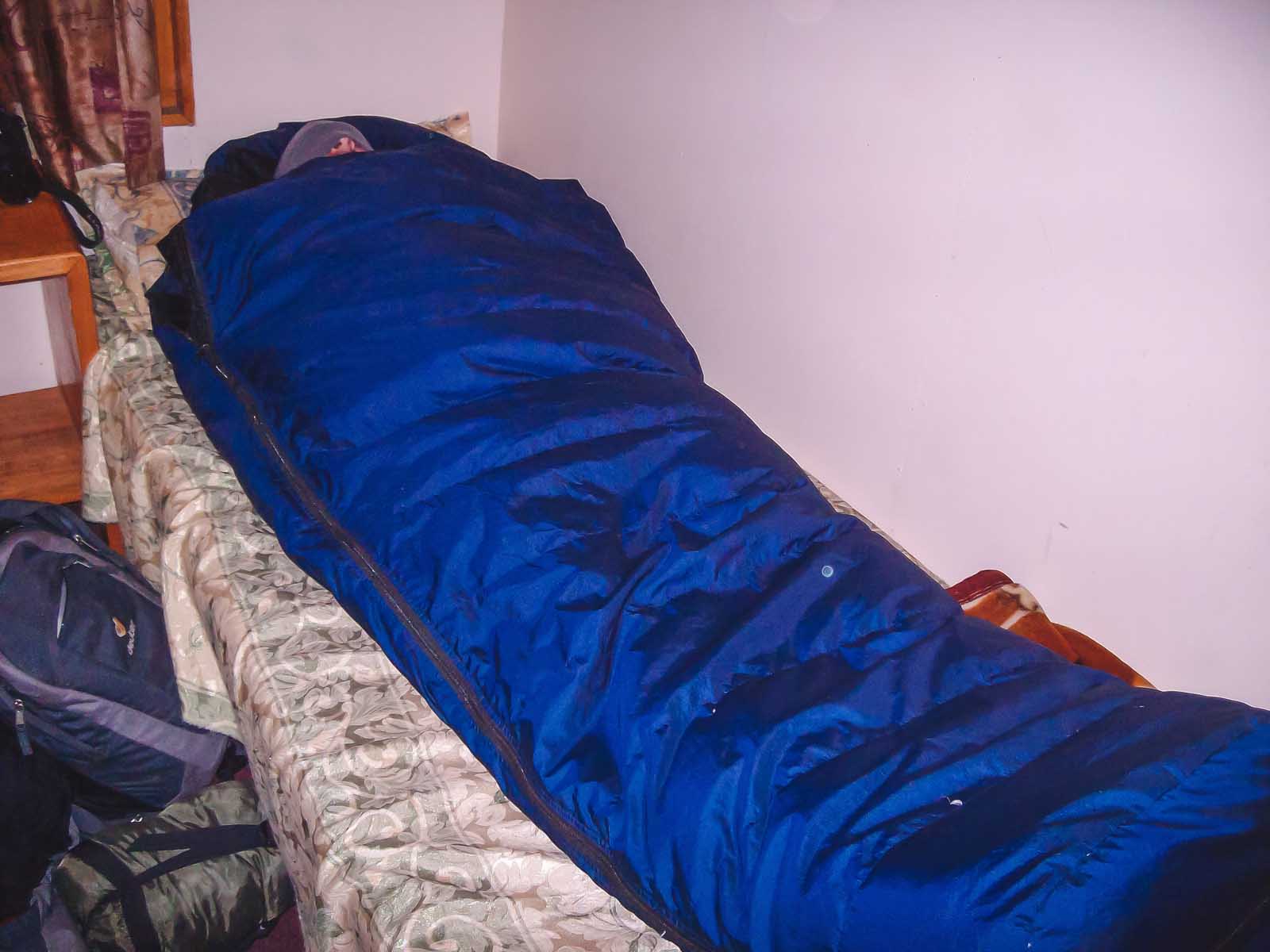
At this high elevation of the EBC trek, accommodation became very basic and rustic. We felt like true adventurers as we sat by the fire warming our feet and bonding with our fellow trekkers over our shared experience by candlelight.
There were 10 of us staying in this teahouse. All are sharing electricity to charge our camera batteries. Meals were now vegetarian and wood stoves were heated by yak dung. At this high altitude, meat cannot be transported fast enough to stay fresh and regular wood is scarce, so yak dung it is.
When we went to bed, our room was freezing. Rooms are not heated at higher elevations. We had our own room, but I sometimes wonder if sleeping in a dorm would have helped with more body heat. The temperature easily dipped down to -10 Celcius (14 degrees Fahrenheit) and our plywood walls didn’t offer a lot of comforts.
We tossed and turned all night long trying to keep our noses warm in our sleeping bags wearing our down jackets, thick socks, and thermal mid-layers.
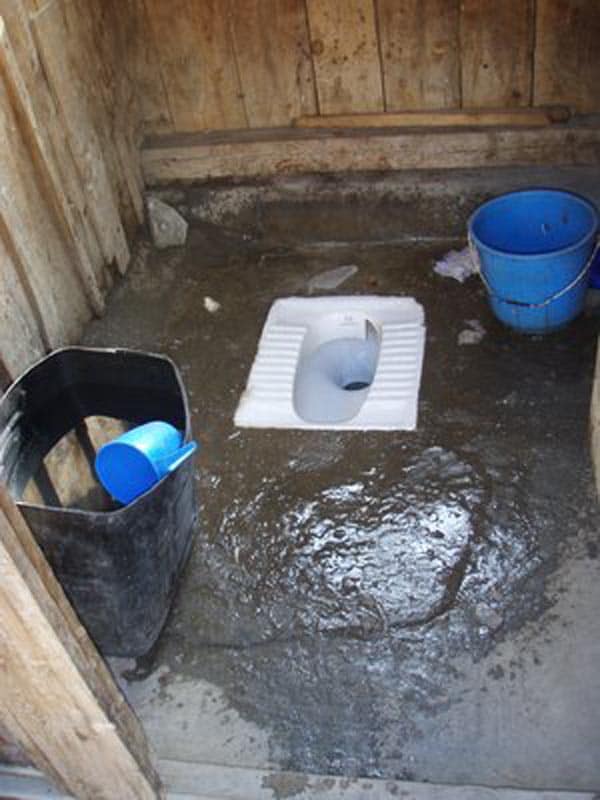
It was so cold the scoop bucket for the shared squat toilet froze over forming a patch of ice to form on the floor. It was a slippery trip to the outhouse. Sadly, we always have to pee a lot during the night when sleeping at high altitudes so we visited that toilet a lot.
Hot Tip: Pay for hots showers at lower elevations You won’t regret it! We realized that we should have paid the 250 Rupees for the hot showers offered at the accommodation in Namche Bazaar. Now that the weather was so cold there was no way we could face a bucket bath in a freezing shed. Dave and I set a new record in these mountains of Nepal, 9 days without a shower!
Namche Bazaar – Elevation – 3440 meters. (11246 feet) above sea level Tengboche – 3860 meters (12664 feet) Elevation Gain – 420 meters (1378 feet) Distance – 9.3 km (5.77 miles) Duration – 3 hours (without stopping) 5 hours for photos, lunch and rest.
Day 5 – Tengboche to Dingboche
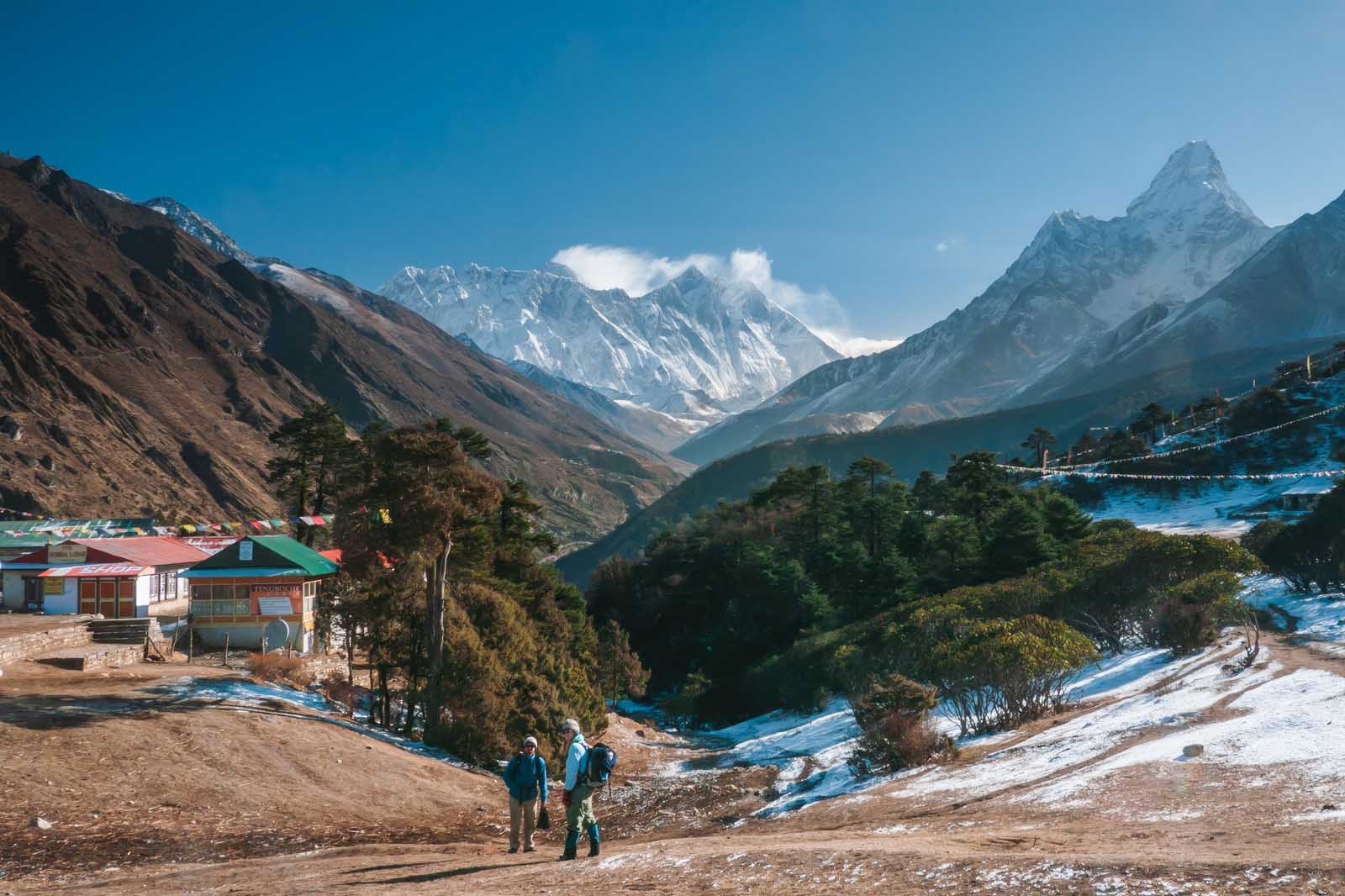
Day 5 of the EBC Trek was freezing! We had an early wake-up call and morning came too quickly on the Tengboche leg of the EBC Trek. But, we awoke to a winter wonderland of fresh snow at the Tengboche Monastery and clear views of Lhotse peak.
The snow from the night before made for more incredible views on the hiking trails. As we started out from the lodge, the sky was crisp and clear, showing Mount Everest in all its glory. It was stunning, and in between gasping for air, we admired the view.
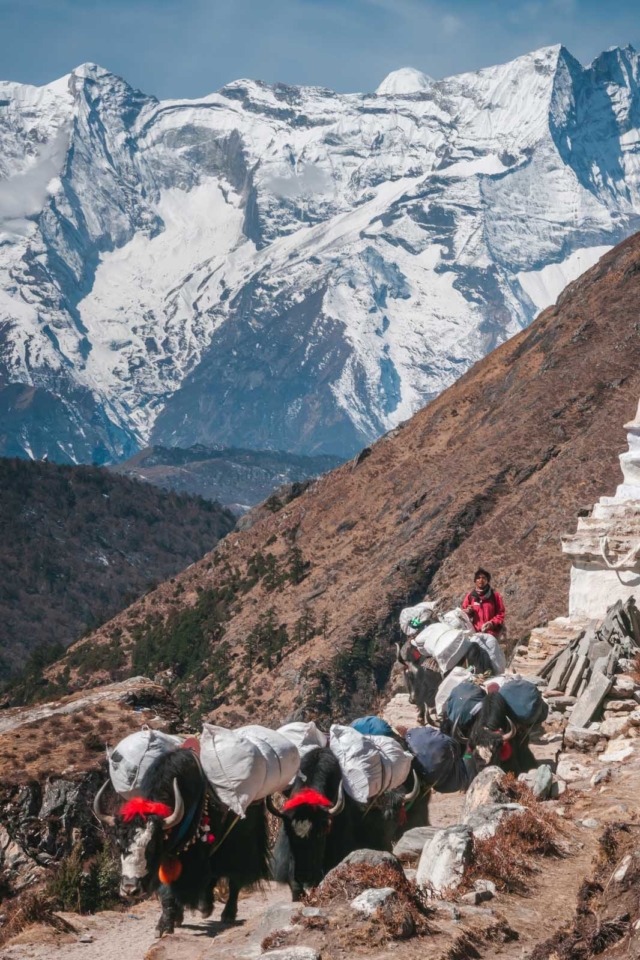
Today we walked to higher altitudes and saw our first trains of wooly yaks. Yaks cannot survive at low altitudes because it is too warm for them, so you don’t see yaks on the Everest Base Camp hike until at least 3000 meters. (9800 feet) They are beautiful.
Yaks on the Trek to Everest Base Camp
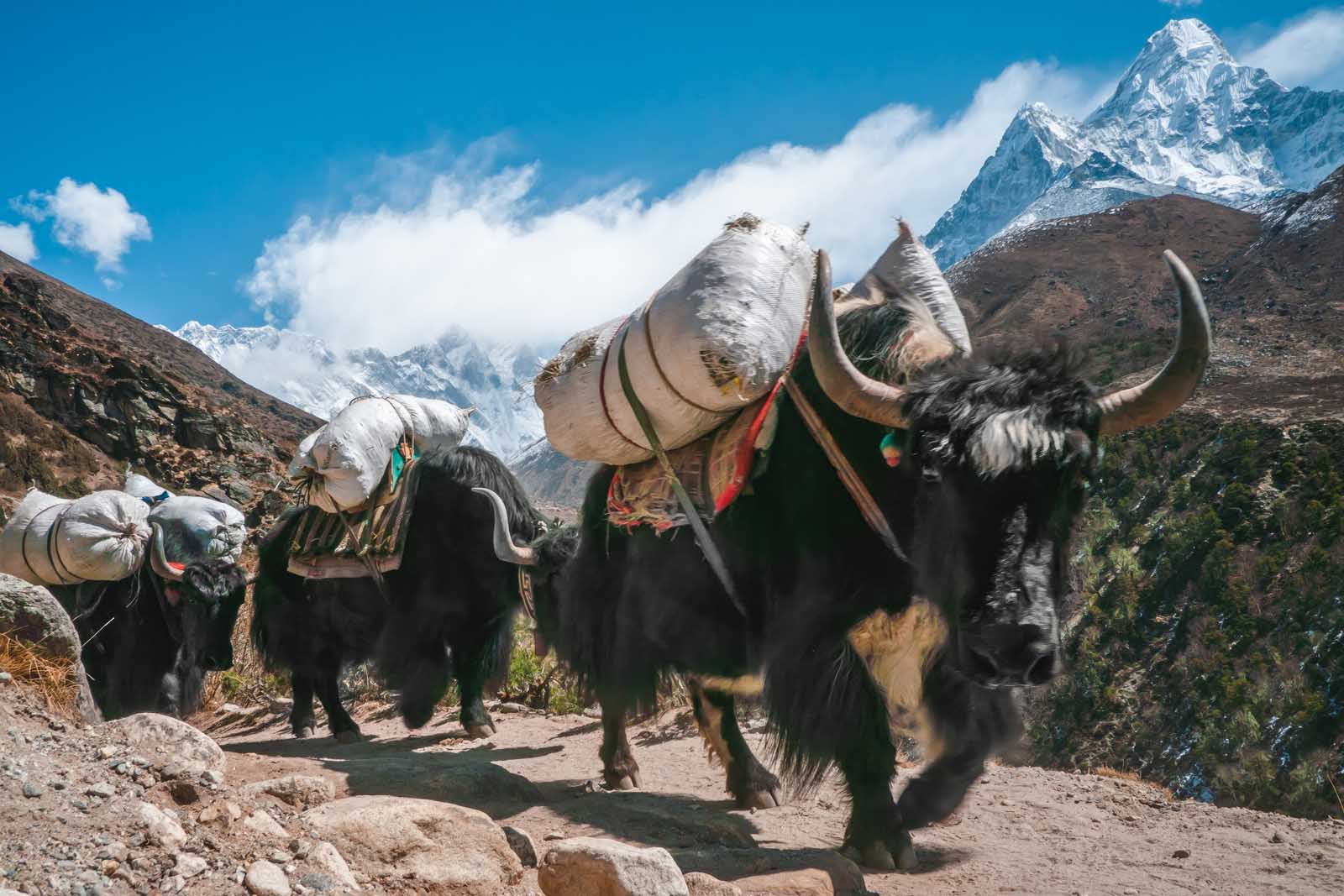
Woolly yak trains were more frequent and by day five of the EBC Trek, we had our system perfected to give them the right of way without letting them nudge us off the mountain.
As we said earlier, it is important to give yaks space. They will run you right off the mountain if you are in their way. Be sure to stand on the mountainside as they pass so you don’t get knocked over the edge. The yaks of the Everest Base Camp trek, have only one thing on their mind. To get to their destination.
On this day, signs of expeditions going up to summit Everest started to go by as large groups of yaks carried giant loads of climbing gear. It is exciting to think that we were walking the same route as so many great mountain climbers, like Sir Edmund Hillary and Tenzing Norgay Sherpa.
The Trek from Tengboche is breathtaking
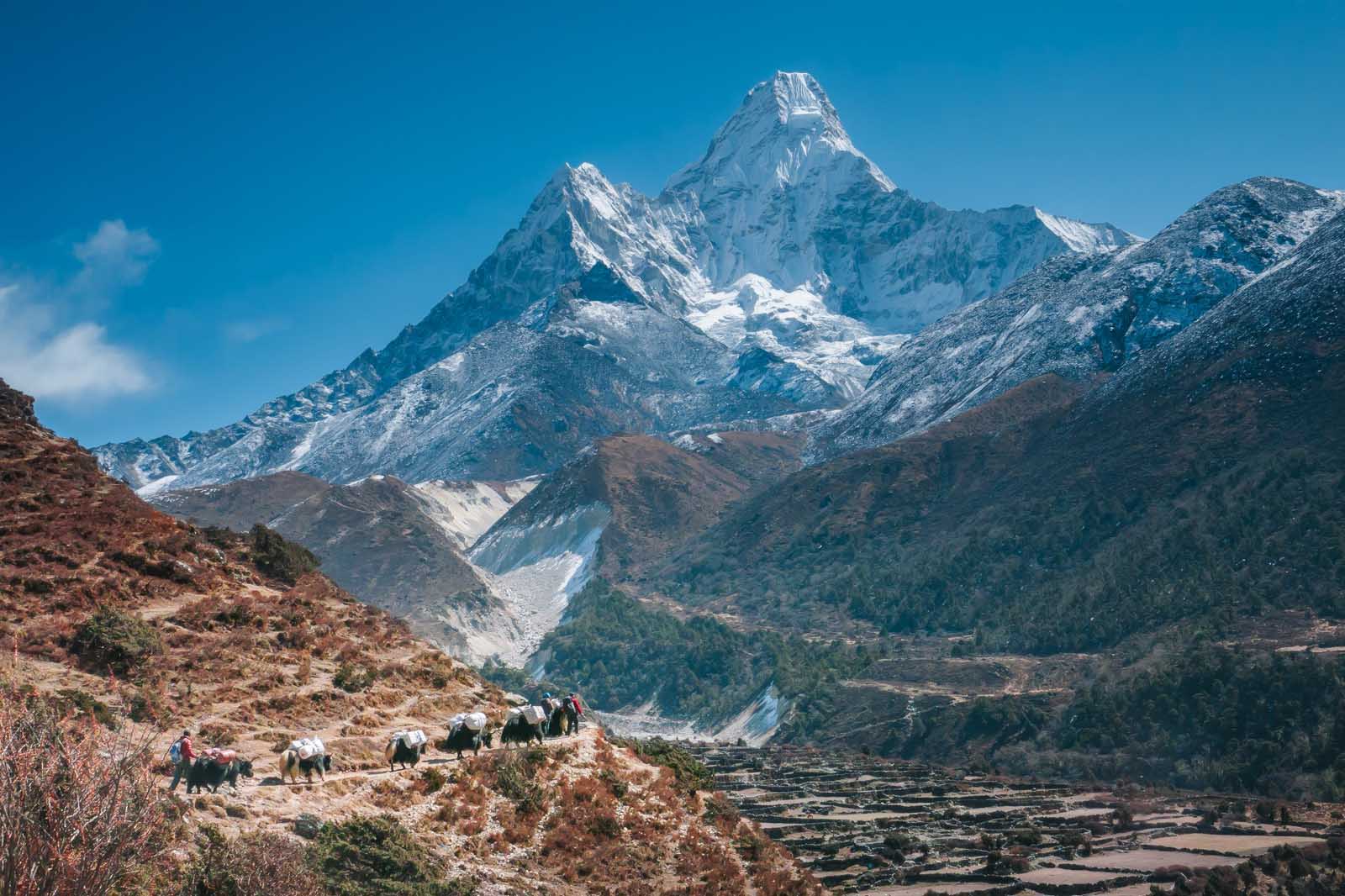
I conquered what little fear of heights I had left this day. Some of the narrow paths on the route dropped sharply into the deep valley below. Soon we found ourselves walking along the ledge not thinking at all about the dangers below. We hiked for a couple of hours before stopping for tea at a restaurant in Pangboche.
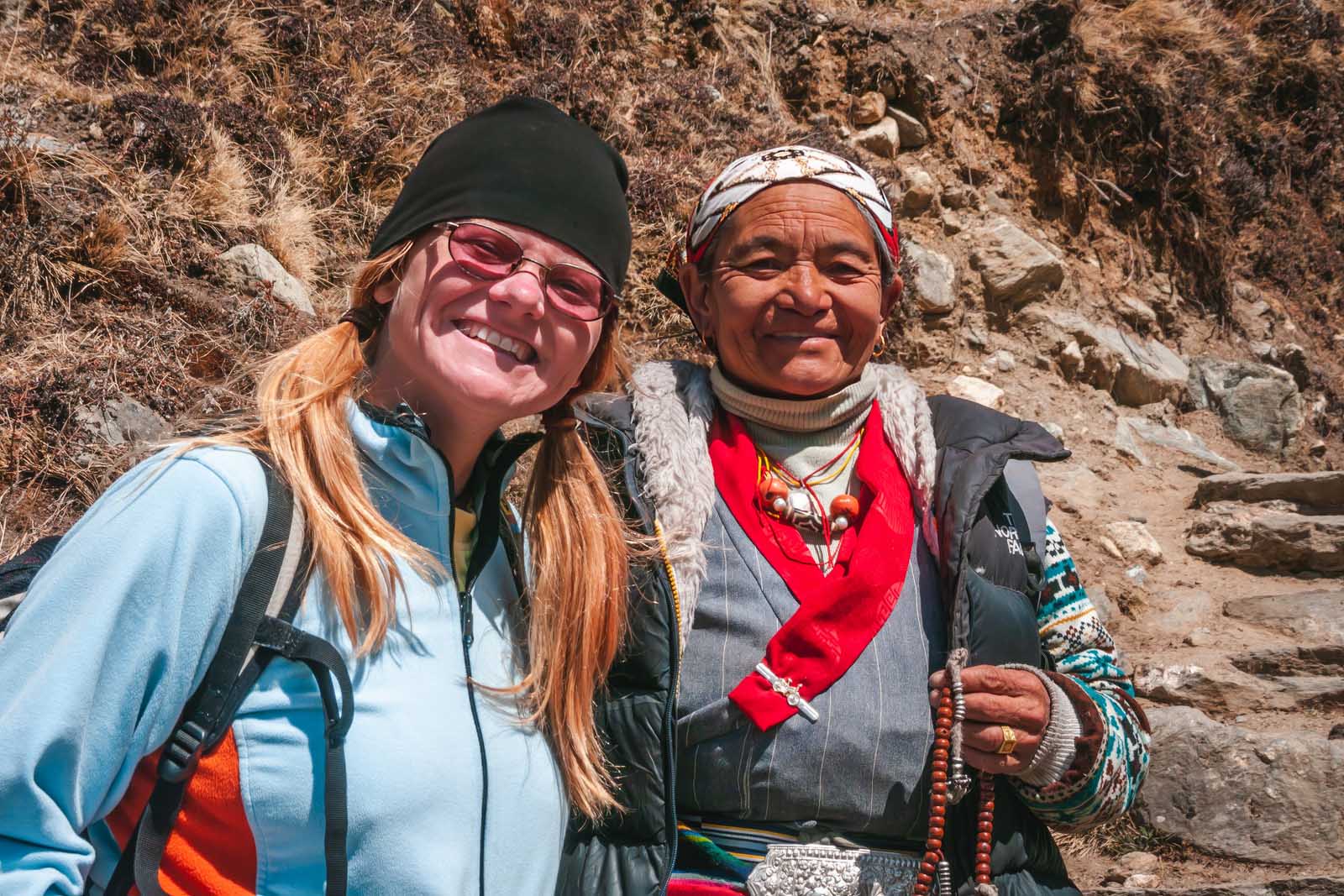
There are shops, teahouses, and restaurants along the route so we could buy lunch along the way and one of the more popular stops is in the village of Pangboche. After a tea stop in Pangboche, we met a sweet lady that walked with us all the way to the village of Dingboche. Her name was Yangshou and she waited for us as we struggled up hills and crossed the suspension bridge over the Imja Khola River.
Her cute laugh and quiet prayers helped to pass the time. She stopped to talk to everyone on the trail while we plugged along. She’d fall far behind when she chatted with friends, only to quickly catch us and then scoot by us with ease. She must have enjoyed our company because we really slowed her down. “ Yangzhou, we will always remember your smiling face!
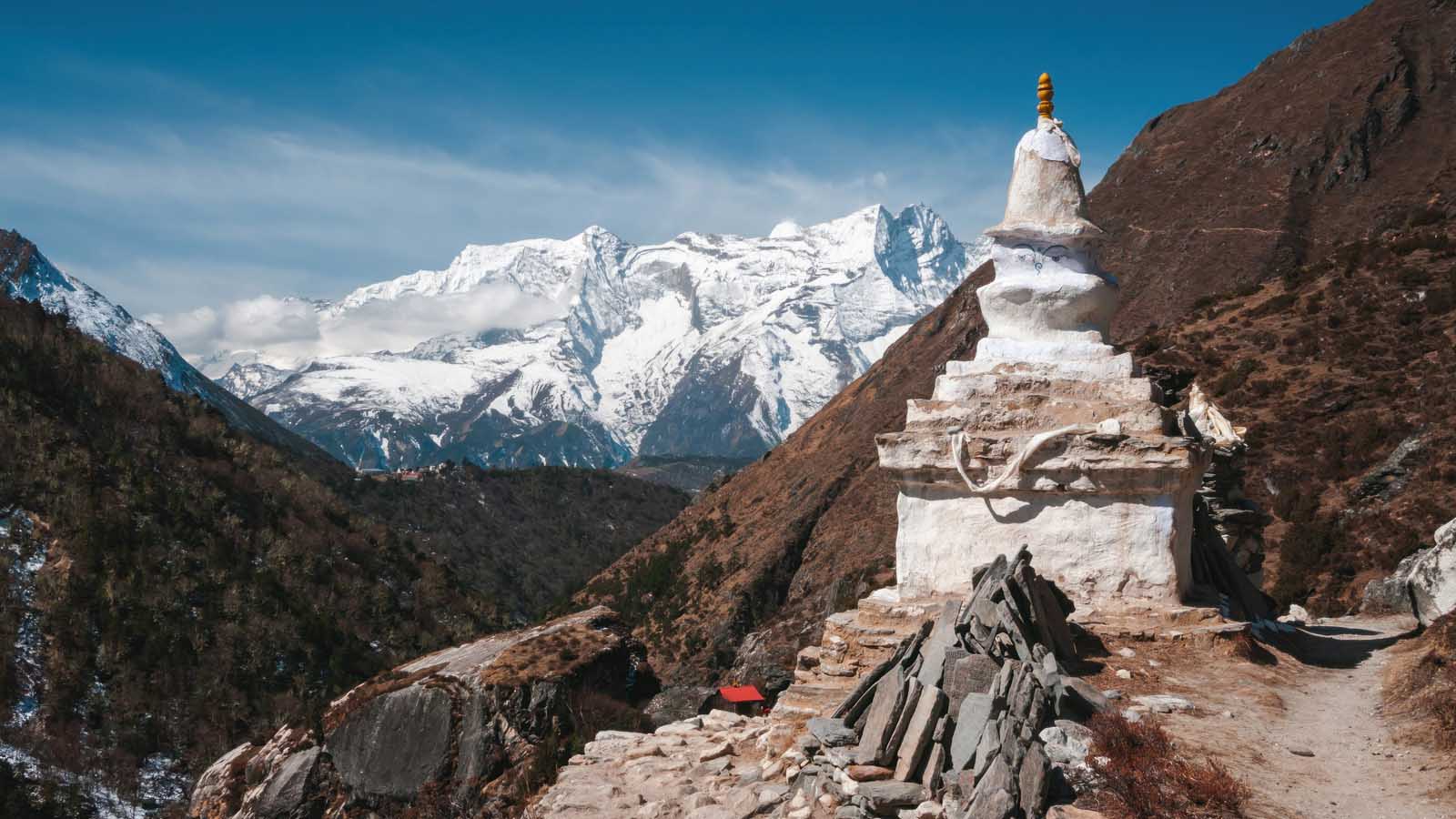
We spent the night in the village of Dingboche and wished that we had another night here. It is from here that you will see beautiful views of Island Peak and Lhotse, but it is also a good spot for another acclimatization day.
Tengboche – 3860 meters (12664 feet) above sea level Dingboche – Elevation – 4410 meters. (14468 feet) Elevation Gain – 550 meters (1804 feet) Distance – 10.8 km (6.71 miles) Duration – 3 hours (without stopping) 5 hours for photos, lunch, and rest.
Day 6 – Second Acclimatization Day at Dingboche
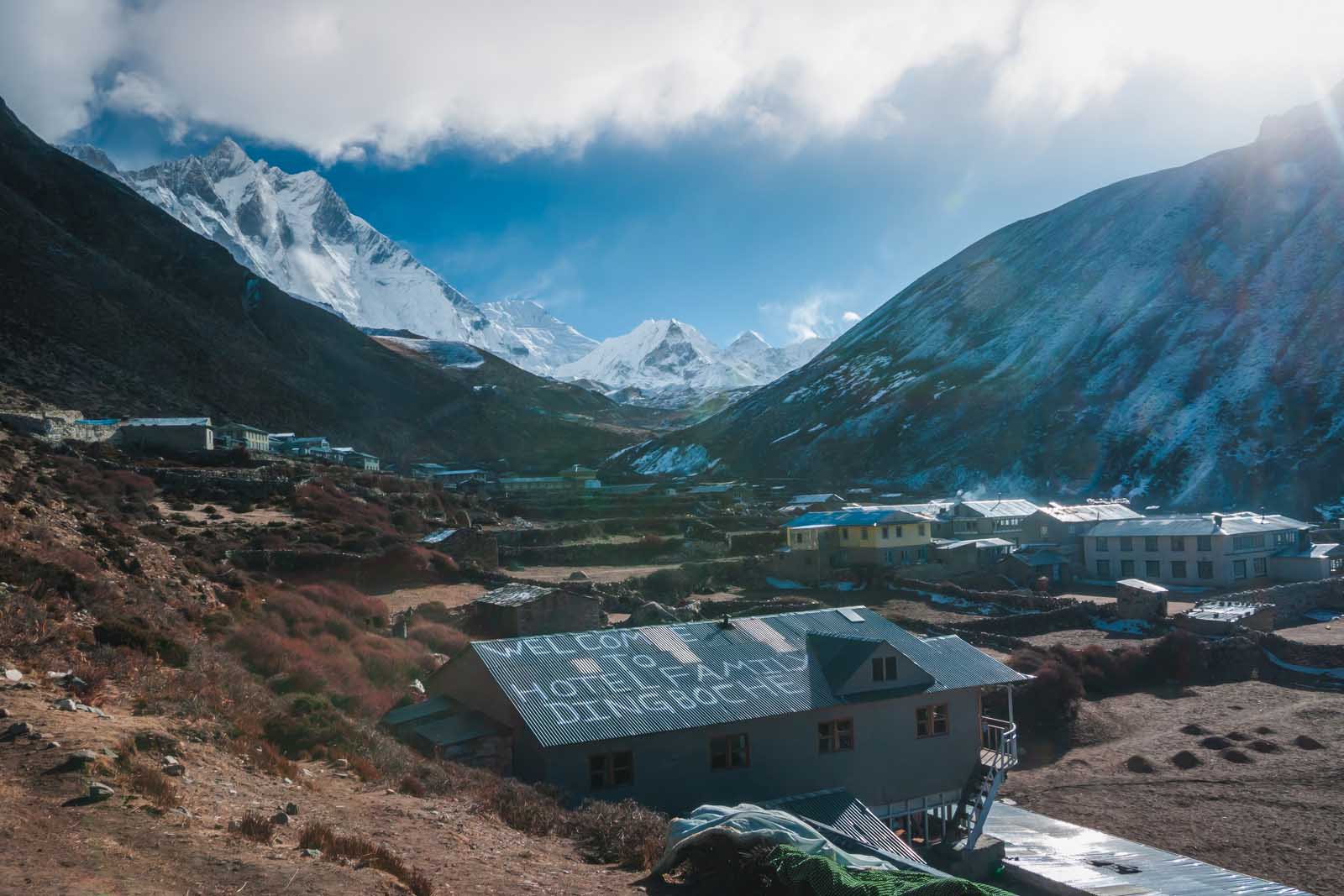
This is a day that most people spend acclimating to the high altitude. We did not do this day, but you should! So we are including it in the guide because it is a very important day when trekking to Everest Base Camp. If we were smarter, we would have spent 2 nights in the village of Dingboche where we would spend a day hiking up to Nagurjun Hill.
This is the best place for climbers looking to summit Everest, Ama Dablam (6812m), Lobuche peak (6,119 m), or Island Peak to do their acclimatization day. Dingboche is a small village in the Khumbu region with only a few guest houses, so it is a good time to relax, replenish and rejuvenate for the next push.
If we had brought our Lonely Planet Trekking in the Nepal Himalayas (which we forgot in Kathmandu and kicked ourselves about it every day) we would have realized that we should have taken an extra day to acclimate in Dingboche.
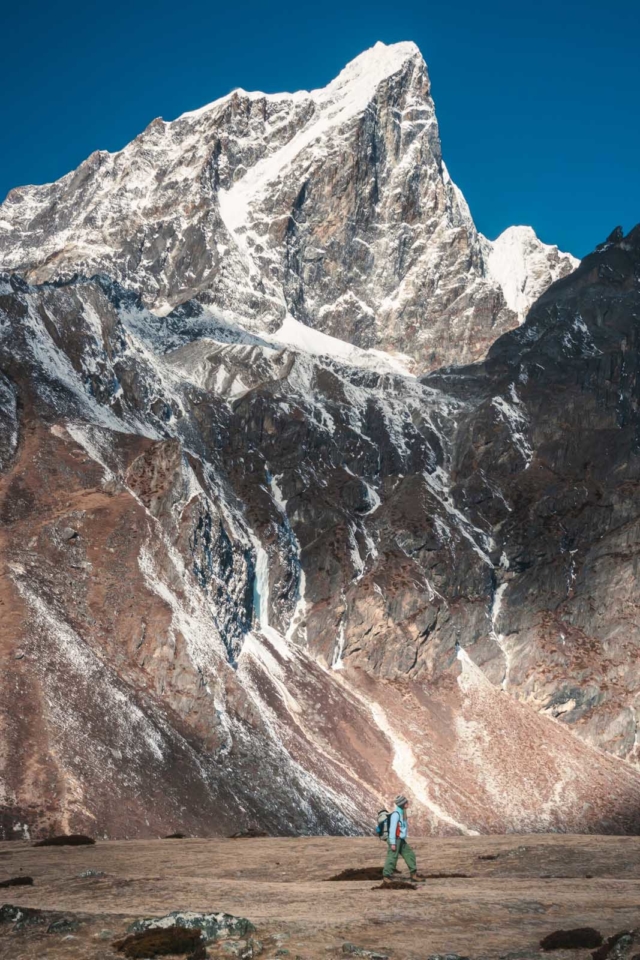
Dipendra was flexible so he would have easily added another day onto our trek, we just didn’t know any better to ask about it. Lucky for us, we felt strong, but other groups were complaining of headaches and dizziness.
In the end, we wish we spent the extra day here. Some people even spend two days here climbing to the surrounding peaks. We did suffer after reaching base camp and I believe that is because we didn’t spend time acclimatizing here.
Had we stayed, we would have done some light hikes to gain altitude and then come back down to rest at a lower elevation. Many people who are set to climb Island Peak or Kala Patthar stay here for a few days to get some practice climbs in.
Dingboche – Elevation – 4410 meters. (14468 feet) above sea level Nangkartshang Peak – Altitude – 5050 meters (16568 feet) Climb – 640 meters (2099 feet) Distance – 10.8 km (6.71 miles) Duration – 4 hours Elevation Gain – 0
Day 7 – Dingboche to Lobuche
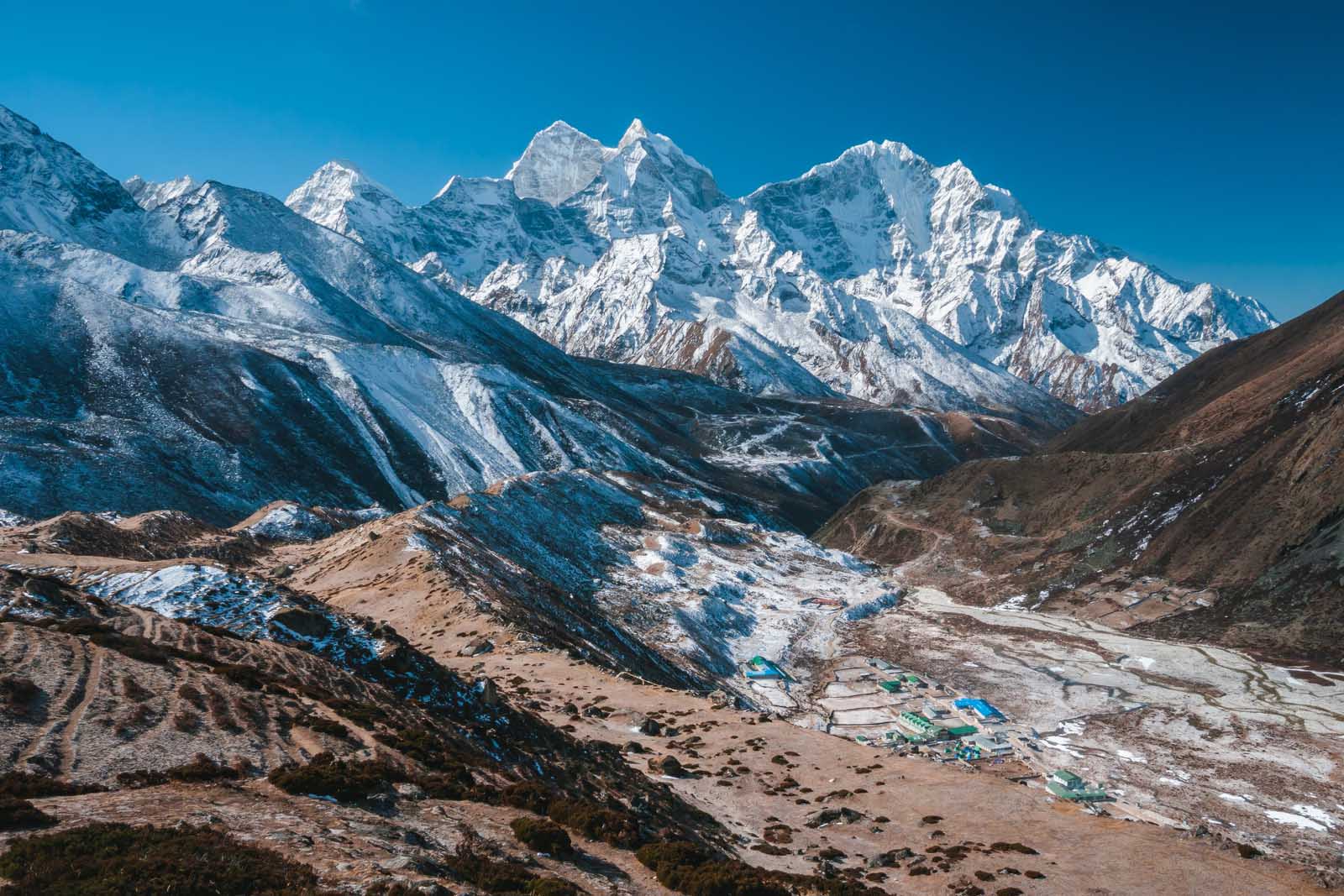
We walked with fellow trekkers we met at our guesthouse Martin and Richard from Slovakia during the morning hours. They carried their own packs and after watching them struggle, we were happy we hired a porter. (note: As of April 2023, you can no longer trek independently in Nepal) They were really starting to feel the altitude and we eventually left them behind.
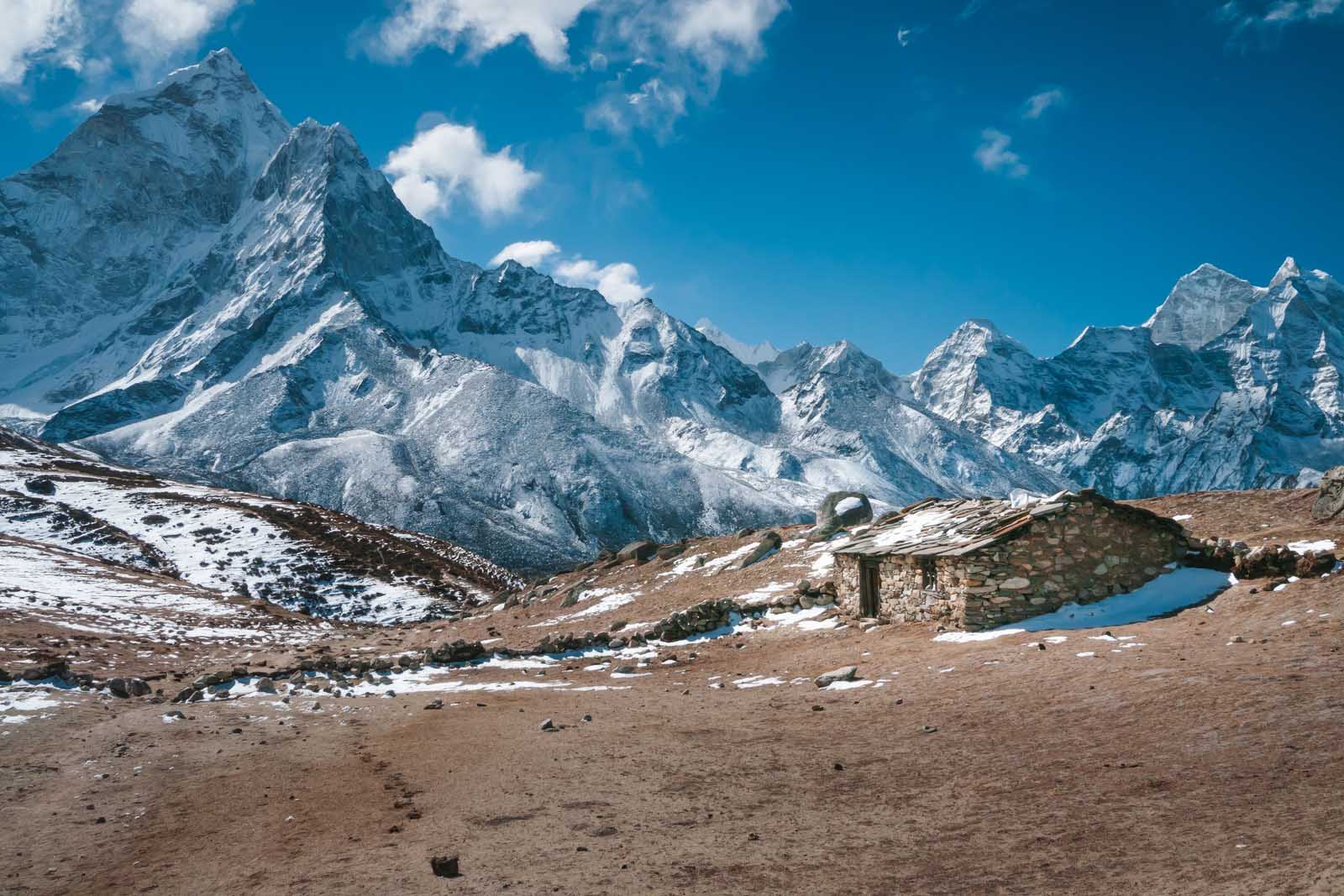
We enjoyed our day taking photos of the stunning clear views of the Everest region. It may be a little colder trekking in Nepal at this time of year (Early March), but the skies are clear and blue. When we came across a small cluster of houses, we felt like we had entered the Kingdom of Middle Earth. Little Hobbit houses lined a valley with giant peaks looming overhead.
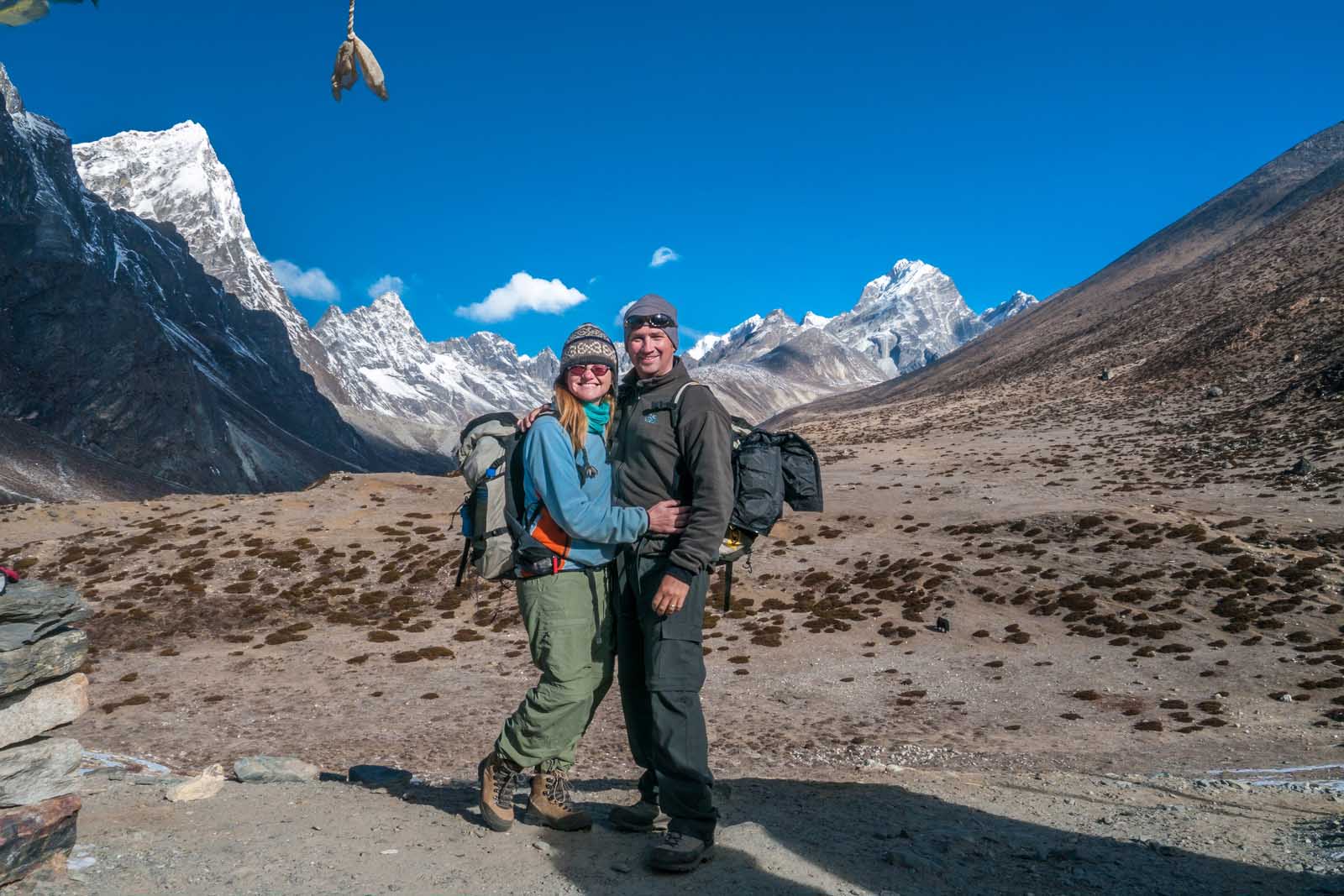
We had a front-row seat to some of the most breathtaking views on earth. An entire panorama of the mountains standing proudly overhead, reaching up to the deepest blue sky that I have ever witnessed. The scene took our breath away. The mountains looked more imposing with each corner we turned and we could not believe that we were fulfilling our dream of hiking to Everest.
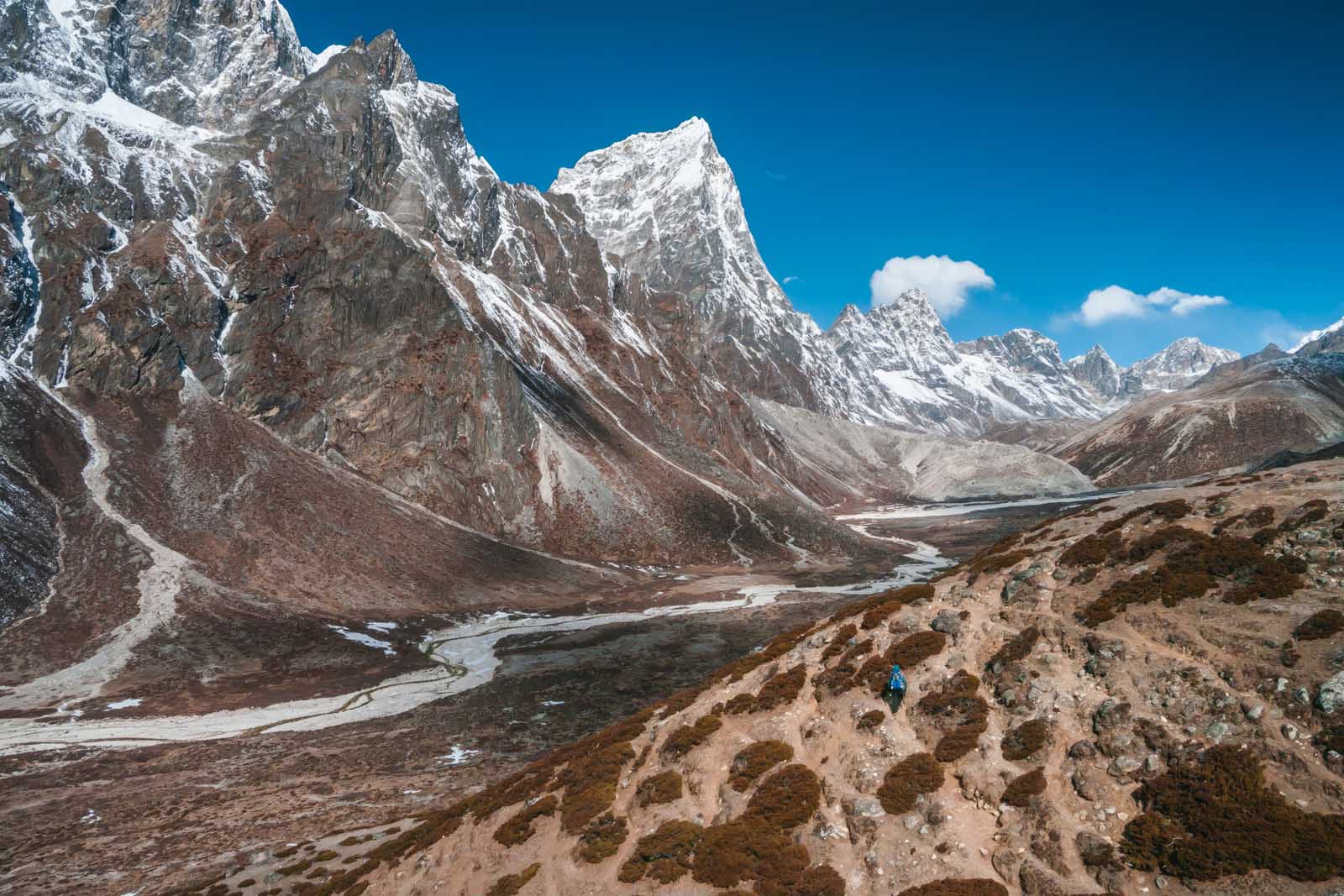
We had to knock on the door to see if Bilbo Baggins happened to be in. Sadly, he wasn’t home. I ended up singing Leonard Nimoy’s Ballad of Bilbo Baggin s for the rest of the day. A bad idea since I only know a few words.
Weather Conditions
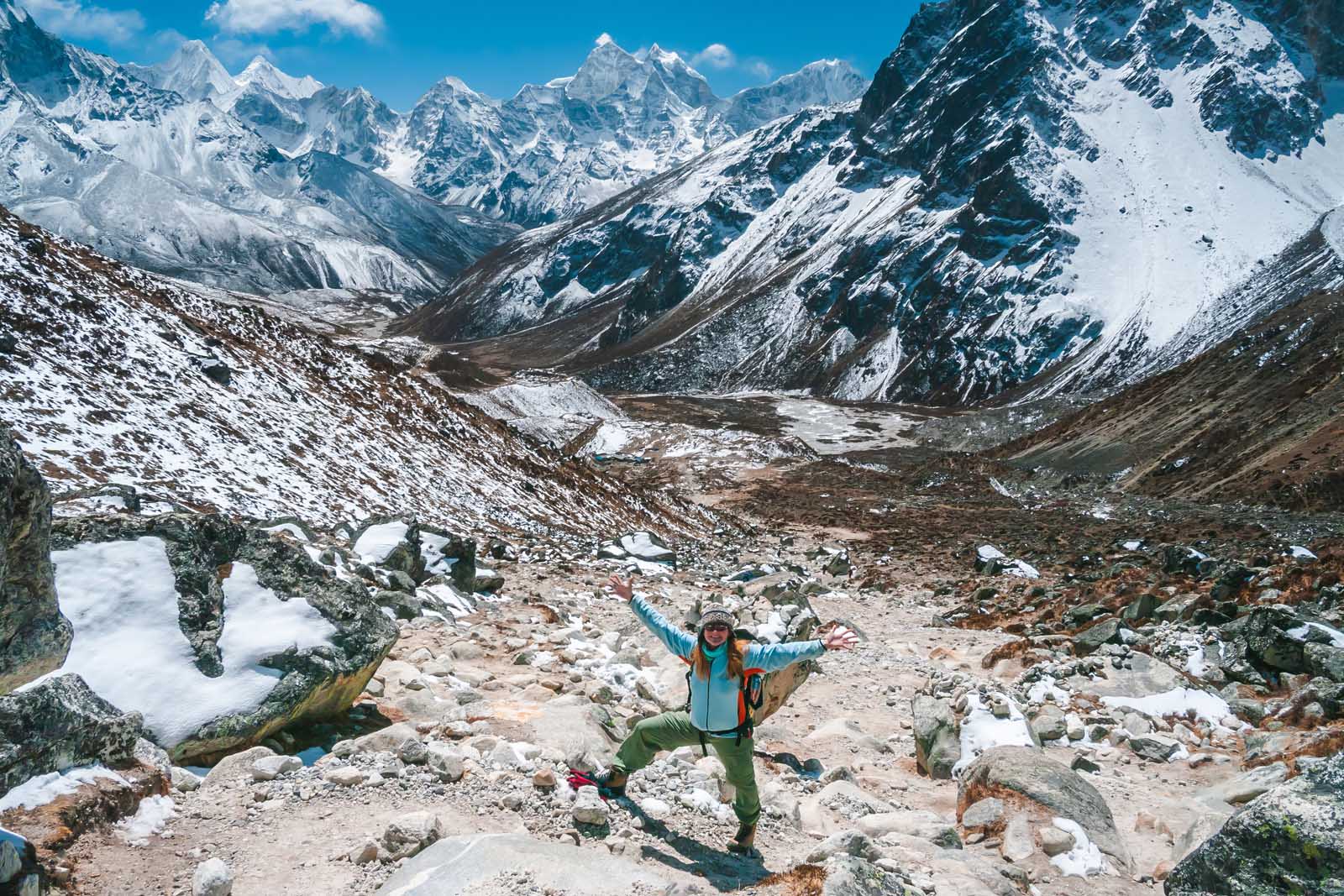
The wind picked up and we put on our outer layers for the first time. We were thankful to have them as we staggered through the high gusts. Weather varies greatly in the Everest Region and before you know it you can have inclement weather so be prepared with your layers. The sun can be shining one minute and then wind and clouds roll in the next.
After lunch, we faced quite the scramble up a steep hill littered with boulders. It looked like a tough climb, but we moved with ease and quickly made it to the top. Where we found our strength, I do not know.
Sherpa Monuments
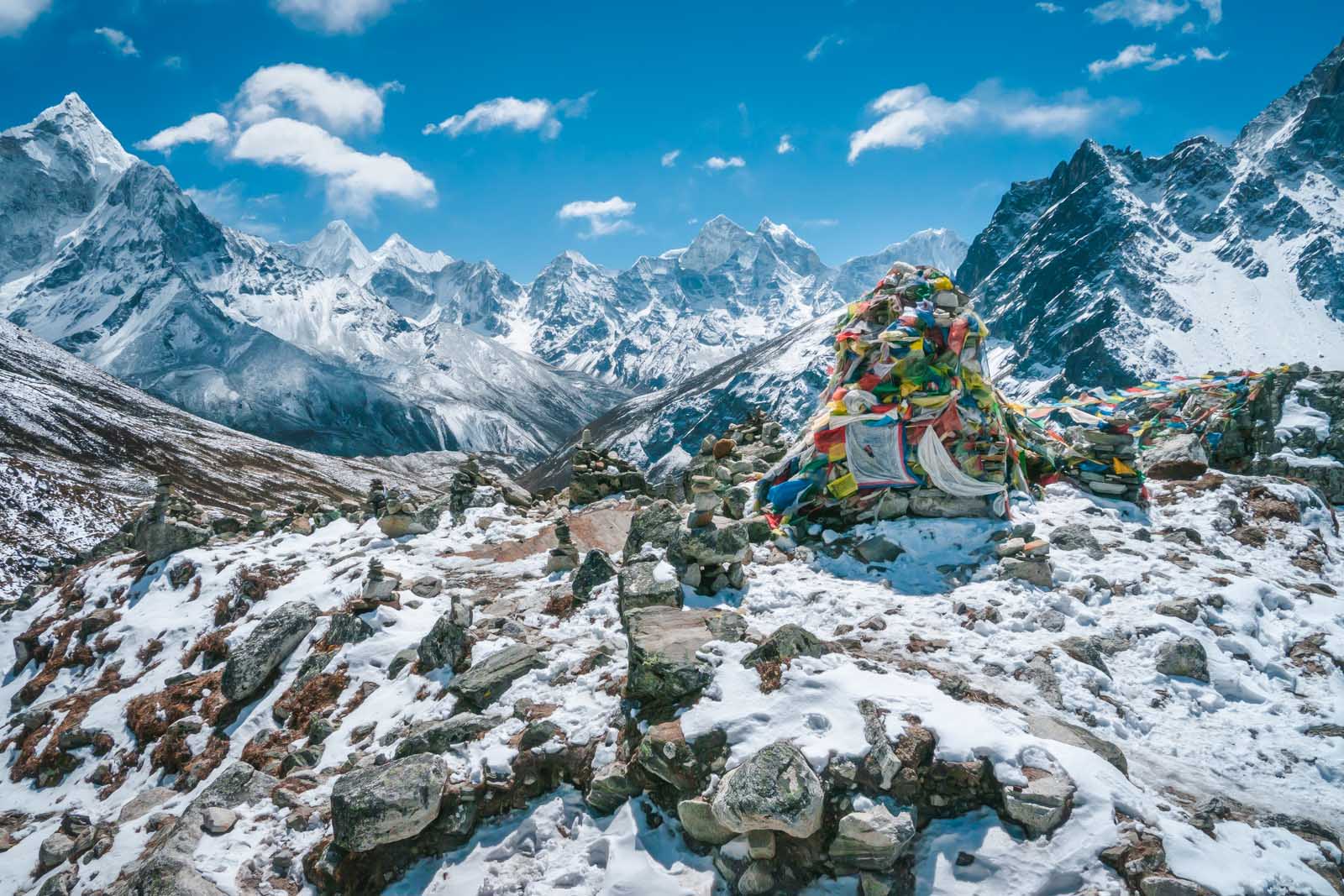
At the top of the hill is a very moving sight. Several monuments and stupas are erected, honoring Sherpas and climbers that have lost their lives on Everest. The most notable of these is Babu Chiri Sherpa .
Babu Chiri Sherpa was the former world record holder of the fastest ascent of Everest, the most number of ascents up the mountain, and the quickest back-to-back summits of 2 in less than 2 weeks. He tragically lost his life on his 11th attempt when he fell into a crevasse.
It was a moving experience and a strong reminder to not take things lightly on Everest, even if you are only trekking to Everest Base Camp. It is still a serious trek.
Dingboche – Elevation – 4410 meters. (14468 feet) above sea level Lobuche – Altitude – 4940 meters (16207 feet) Elevation Gain – 530 meters (1738 feet) Distance – 17.6 km (10.9 miles) Duration – 4 to 5 hours
Day 8 – Morning – Lobuche to Gorak Shep
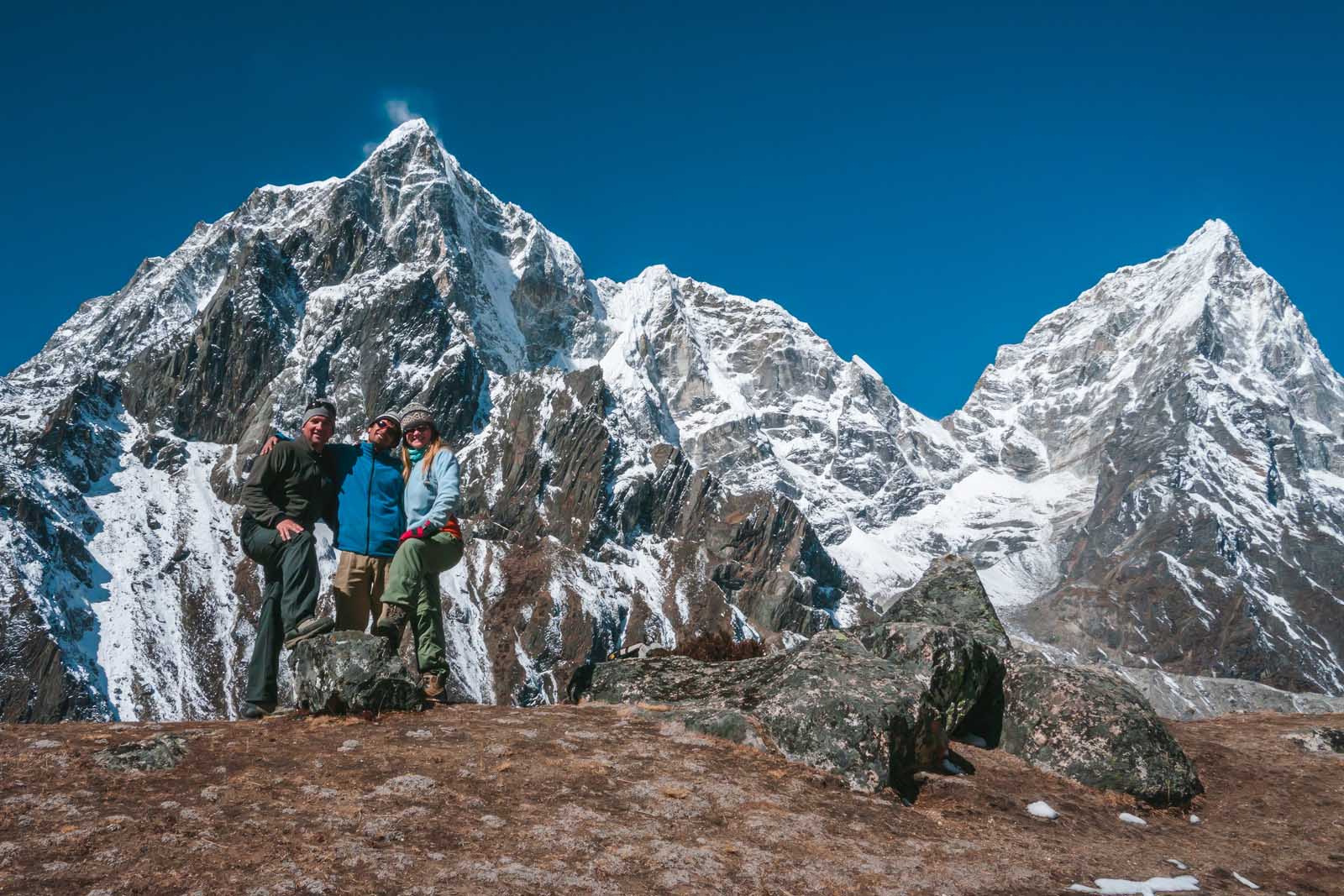
Day 8 on the Everest Base Camp Trek takes you to 5000 meters (16404 feet). How did we feel at 5000 meters? Terrible. Before entering Nepal, I had been suffering for a few weeks in India. The pollution of Kathmandu didn’t help and my congestion was worse when I started the climb. I thought it would clear up in the fresh air, but it intensified with each increase in altitude.
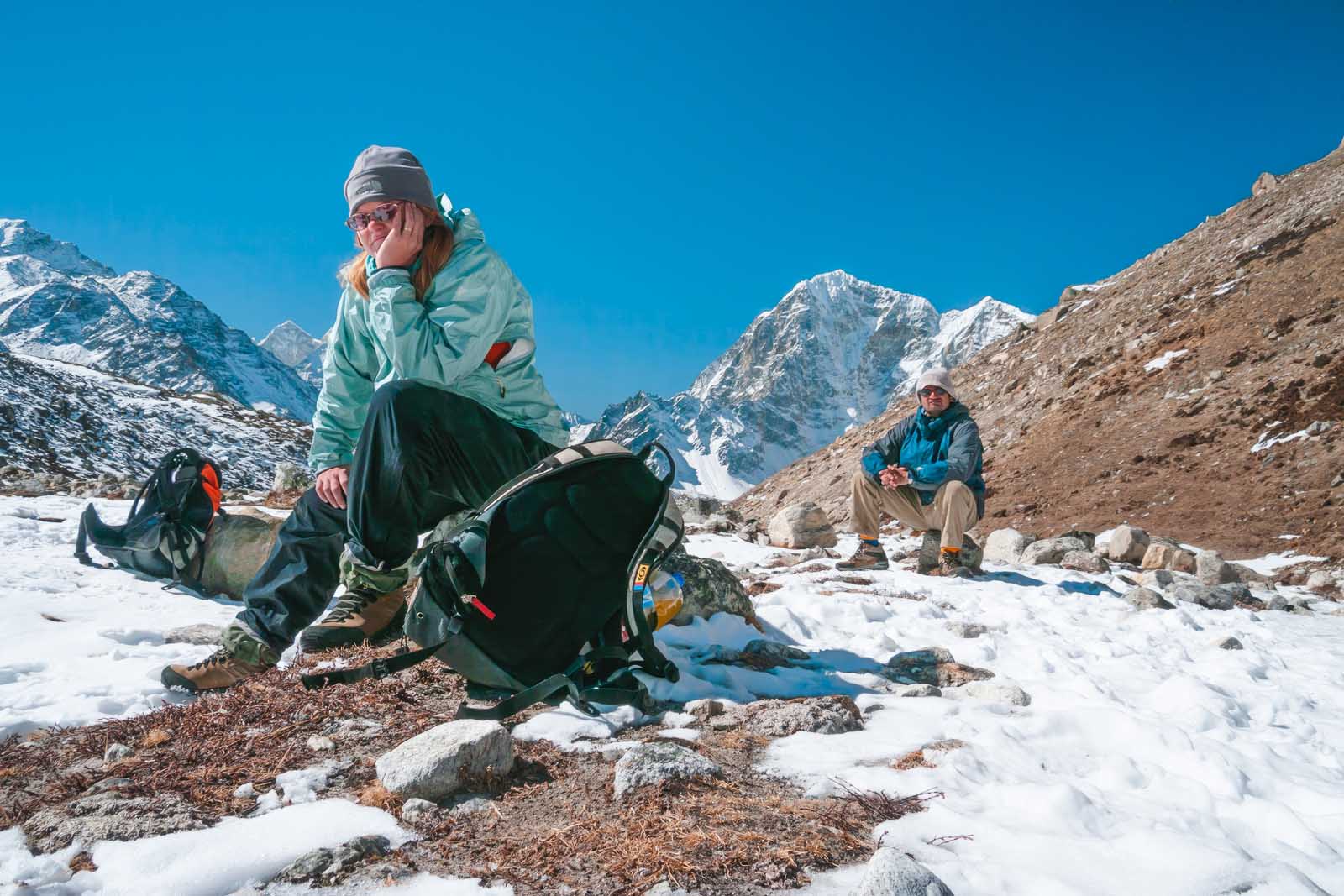
Every morning my cough got worse and my nose was stuffed up to the point of being unbearable. Today, I felt the effects of the congestion and couldn’t catch my breath. It didn’t help that we had gone into such a high altitude. The air is thin and cold.
Dave suffered his first symptoms of altitude sickness when reaching 5000 meters as well. He had a slight case of diarrhea and wasn’t happy about having to wait for the toilet in the teahouses. I think many people were suffering from the same symptoms.
Our was a slow climb to Gorak Shep. We stopped regularly to catch our breath and today we took more breaks than usual. Luckily it was only a couple of hundred meters in elevation gain so we made it to our guest house in Gorek Shep by 12:30.
Lobuche – Altitude – 4940 meters (16207 feet) above sea level Gorak Shep – 5164 meters (16942 feet) above sea level Elevation Gain – 224 meters (734 feet) Distance – 4.3 (2.6 miles) Duration – 4 Hours
Day 8 – Afternoon: Gorak Shep to Everest Base Camp
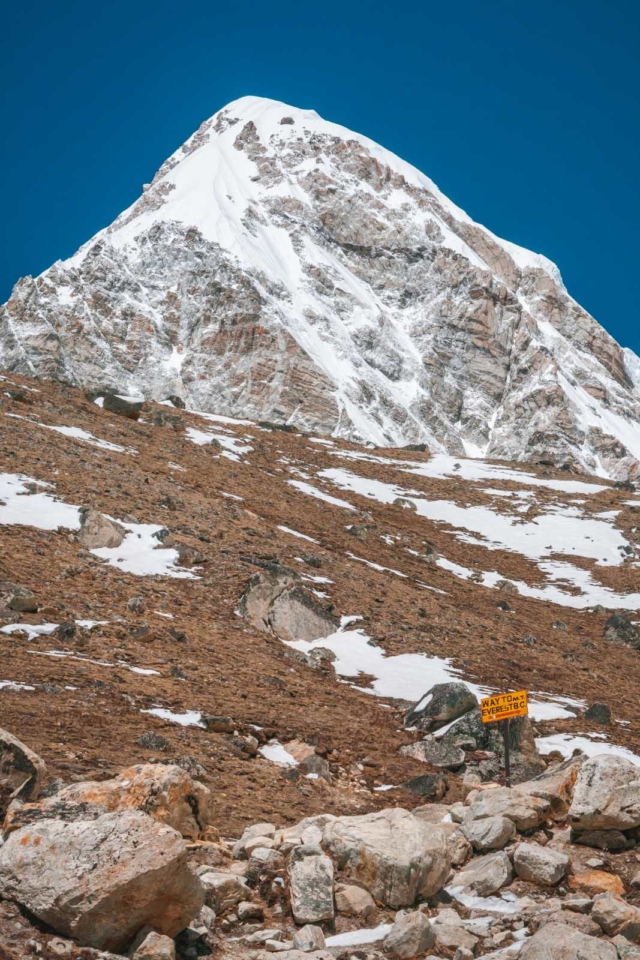
We took a break at Gorek Shep before making out way to Everest Base Camp. We sat in the sun marveling at the fact that we made it this far. After eating a hearty lunch of vegetarian Sherpa stew (Dal Bhat) on the terrace, (yes, we ate outside in the warm sun above 5100 meters) we set out for Everest Base Camp. The sun was shining brightly and it was quite pleasant outside so we were very excited.
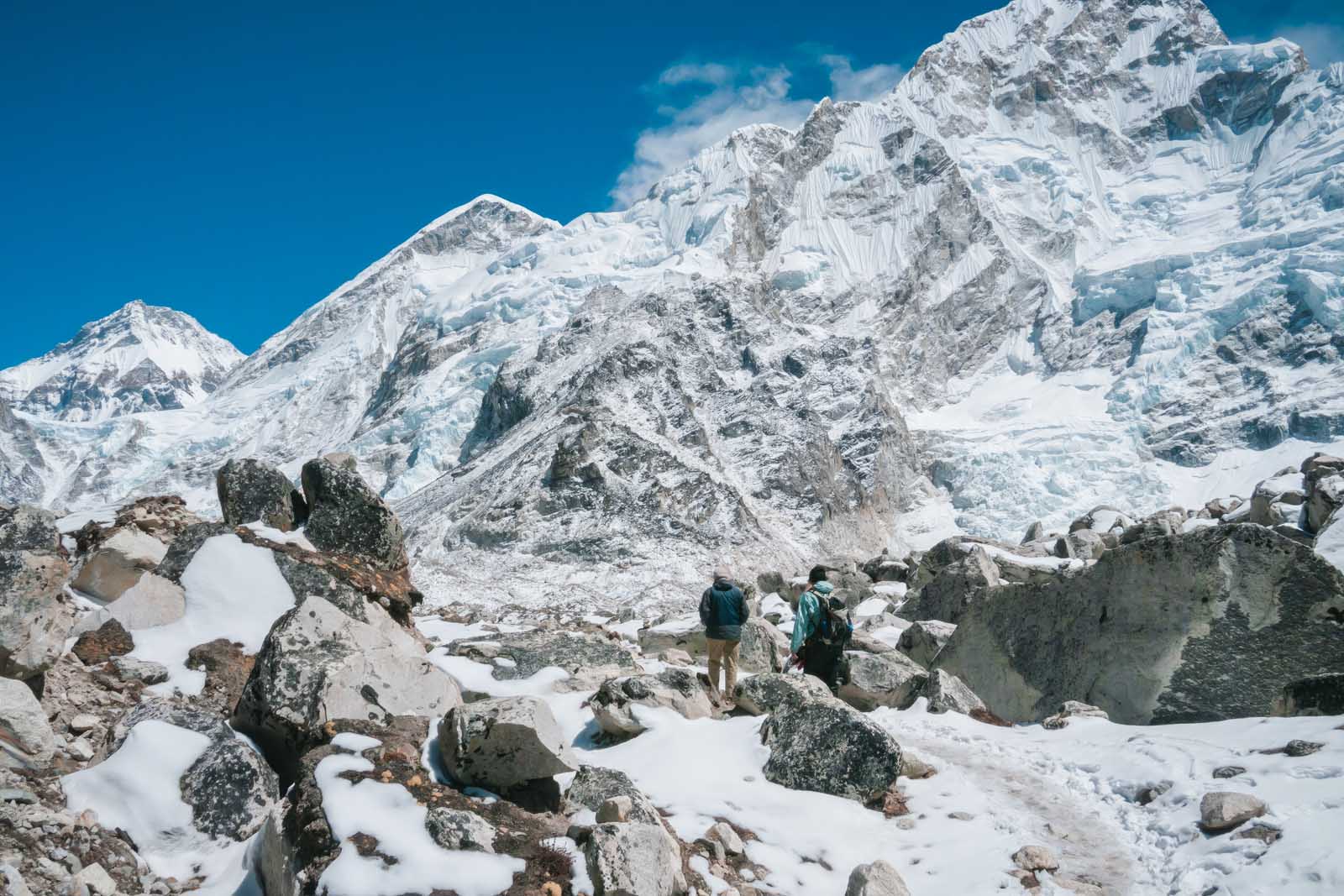
We were lucky and had clear skies. Up until today, the clouds had rolled in by early afternoon every day. Today the sun shone and the skies were blue until sunset. So, it was our perfect morning to make the push.
The trek to Base Camp from Gorak Shep is an easy one. It’s two hours of walking with only a small elevation gain, and we made it with ease. That break for lunch really helped our spirits.
Reaching Everest Base Camp
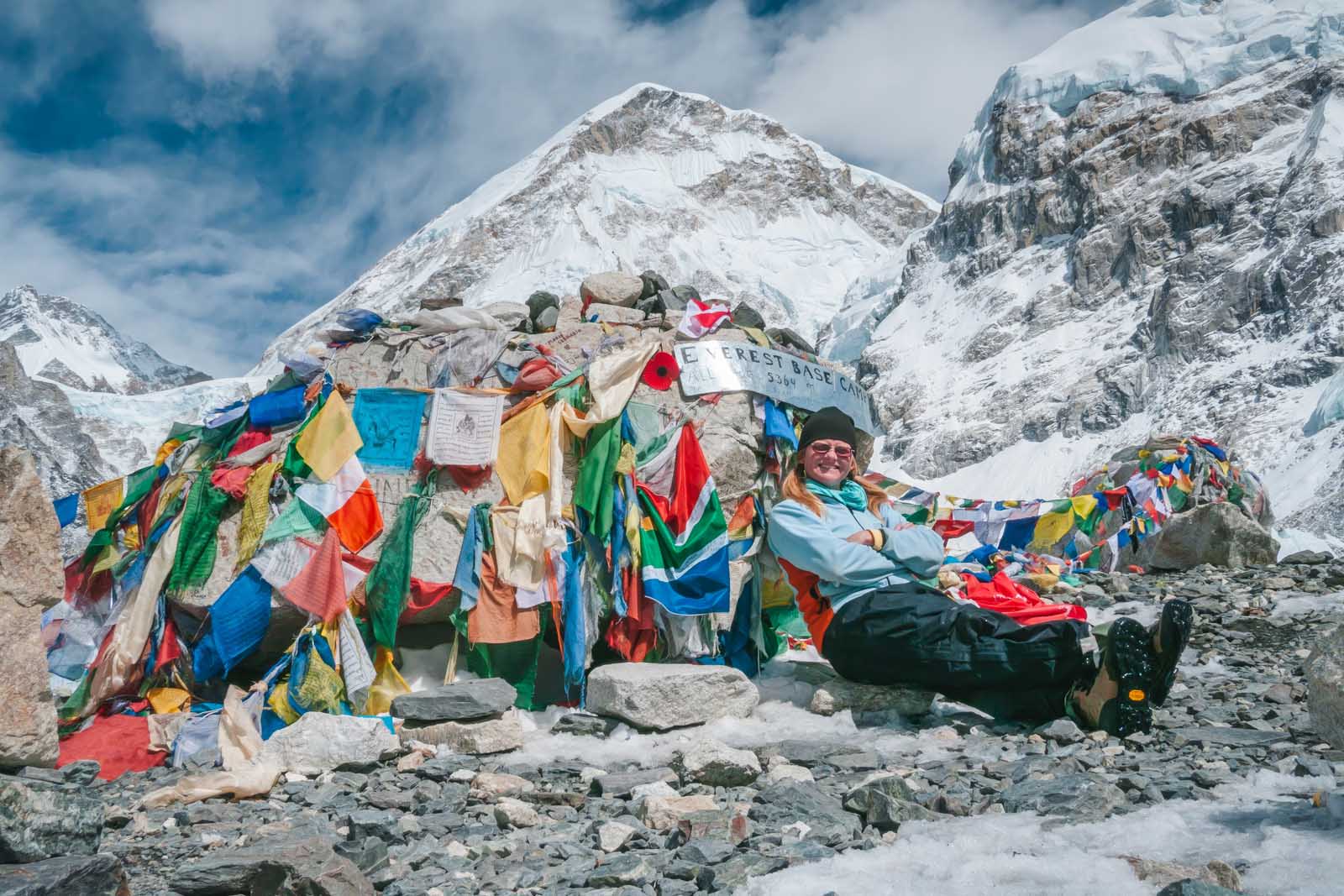
People can summit Mount Everest from Tibet, but the main Everest Base Camp expedition route is in Nepal, and it is busy when the season is in full swing. Even those climbing to the peak of Mt Everest hike the route we took along the Everest Base Camp trek.
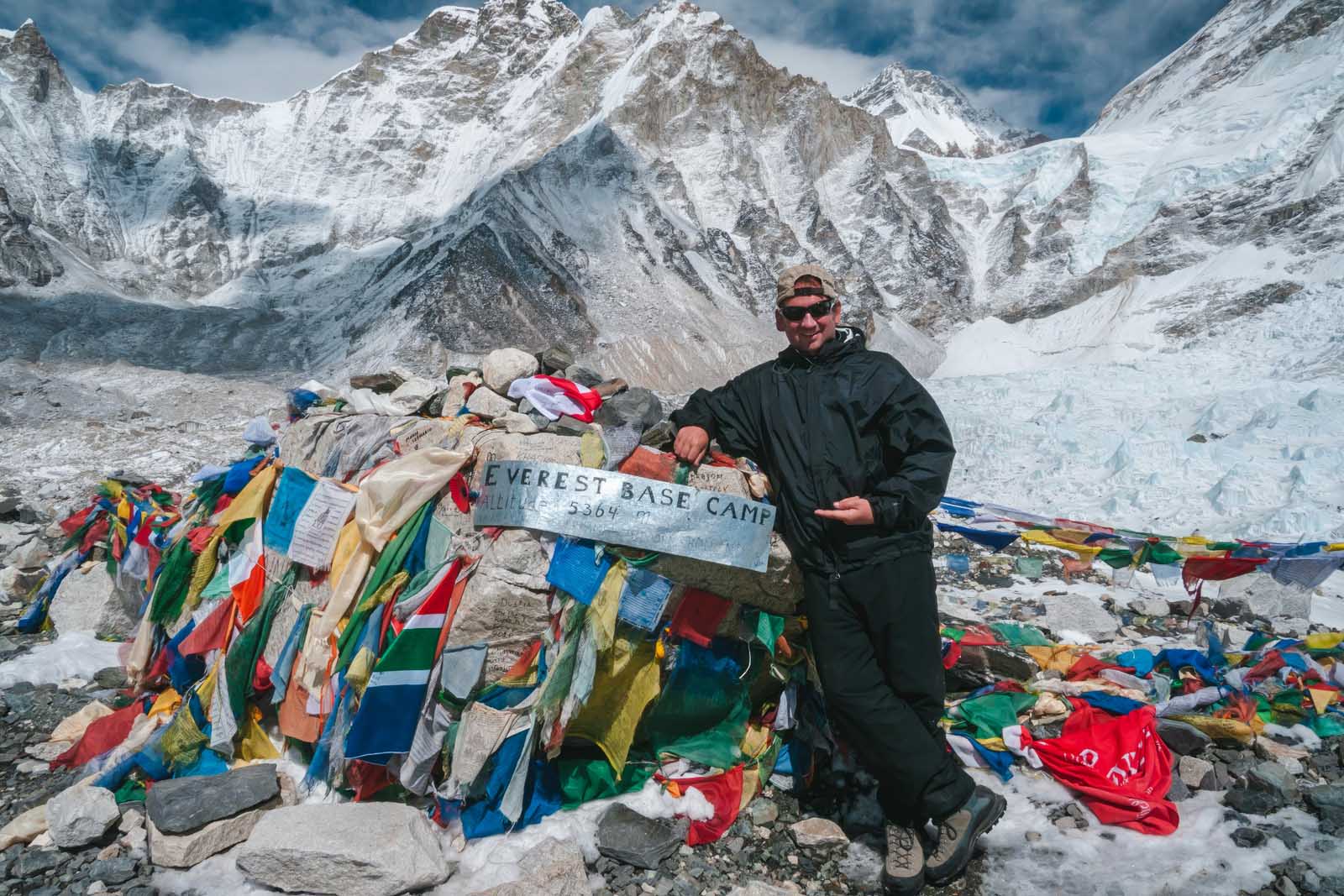
We arrived just a week or two before the season, so it was still quiet on the mountain. In fact, we were the only people at Base Camp that afternoon. We saw another group coming down on our way up, but once there we had it all to ourselves. It was thrilling.
To reach Everest base camp, you will hike out from nearby Gorak Shep and then hike back the same day to spend the night in the village. You do not spend the night at base camp.
Khumbu Glacier
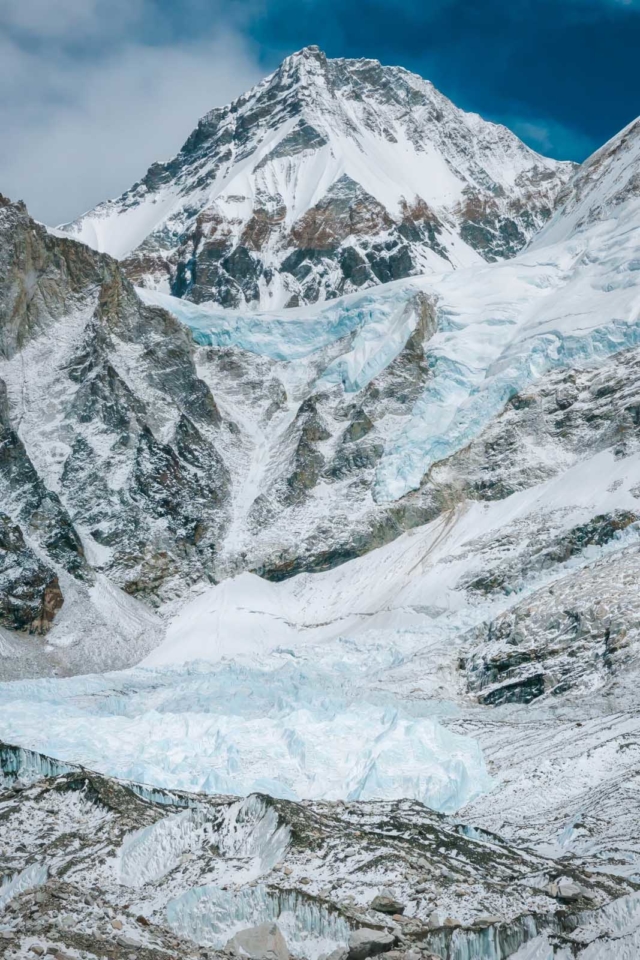
The Khumbu Glacier is the first thing to come into view, and it is unbelievable to think that we are actually standing there. The Khumbu Glacier is the largest glacier in all of Nepal and is famous for the Khumbu Icefall. This treacherous sheet of ice is the most dangerous obstacle that climbers face when summiting Everest.
We witnessed an avalanche that reminded us just how precarious the climb to Mount Everest is. It is an intimidating sight and I cannot imagine having the courage to cross that field of ice. Climbers walk across ladders that shift and move as the ice is alive and constantly settling. It has taken many lives, and we were happy to look at it from afar.
With an elevation of 7600 meters at its source, the Khumbu Glacier is the highest glacier in the world and the Khumbu Icefall is one of the most dangerous portions of the climb to the summit of the world’s highest peak. We were happy to look at it from afar.
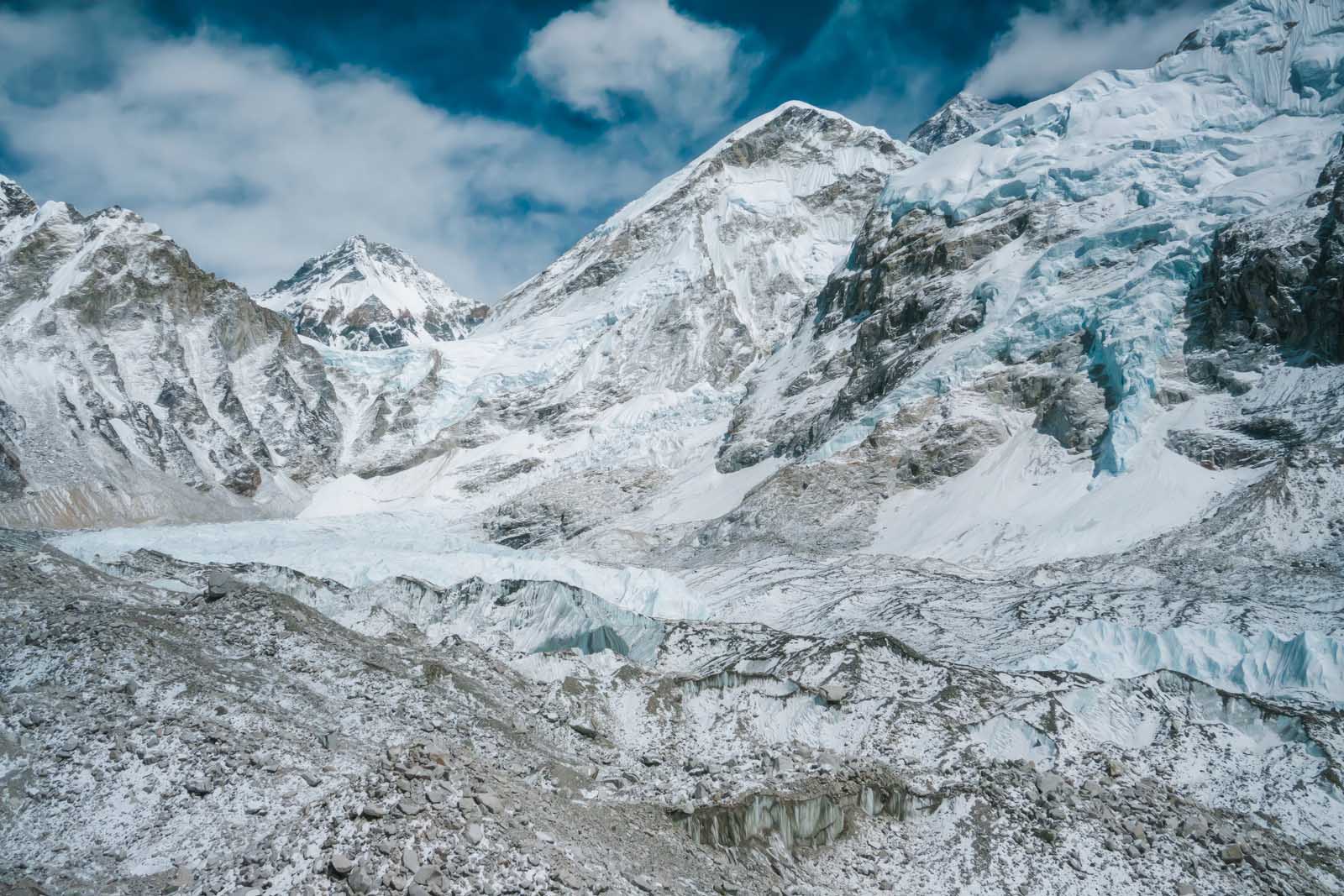
Everest Base Camp’s elevation is 5,364m (17,598 feet) so you will feel the high altitude. But, if you have taken your time you should feel pretty good. We had been at this elevation now for a while and stayed hydrated, so we could enjoy the experience.
We stood at a rock covered with prayer flags announcing that yes, we had made it to Mount Everest Base Camp at 5364 meters. We stayed for almost an hour taking videos, celebrating, and snapping photos. If you can bear it, don’t rush the experience, take it in and enjoy every minute. This will be the only time you’ll see it.
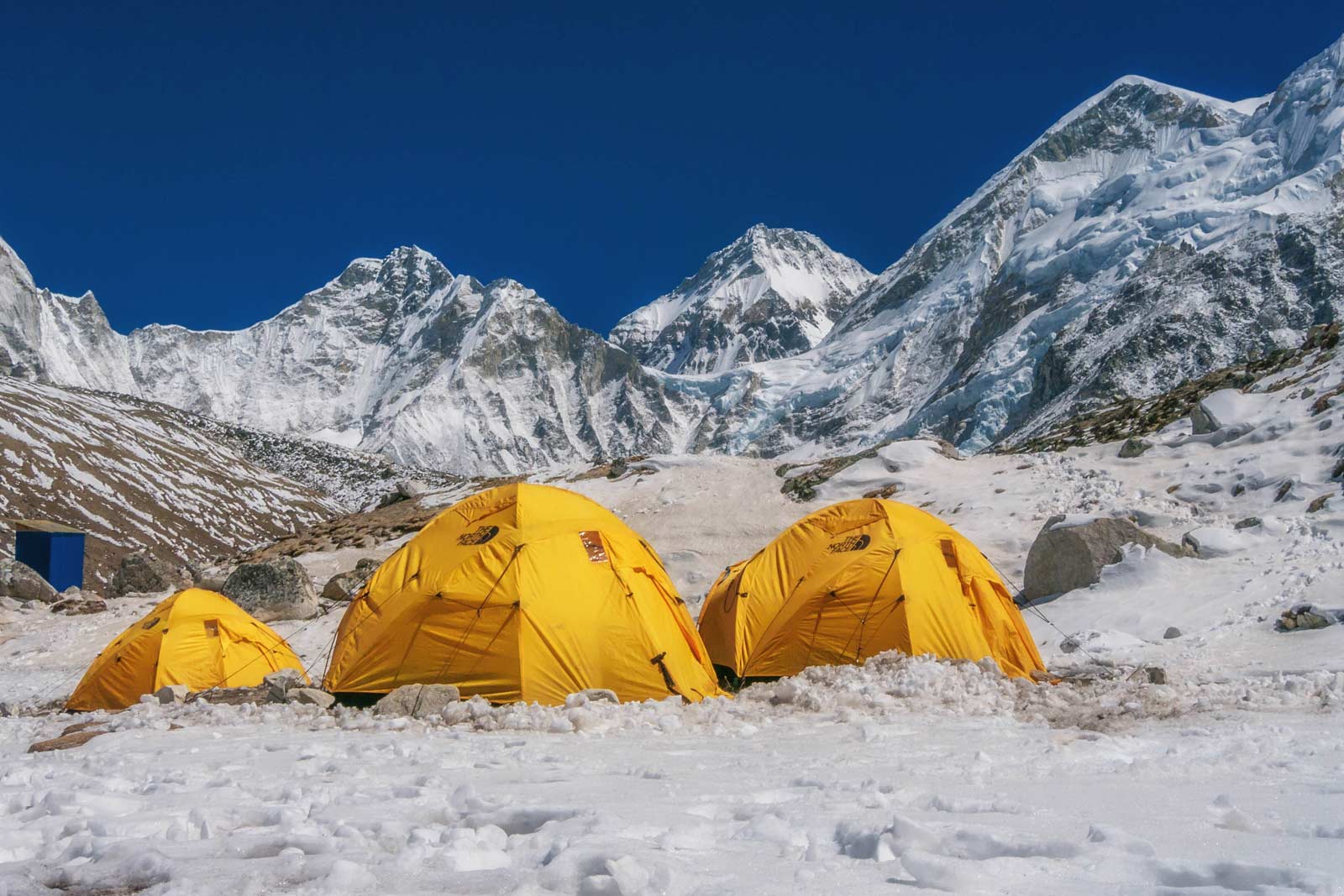
Trekking to Everest may be more exciting later in the season when Everest expeditions are there, but we really liked having base camp to ourselves. There wasn’t a soul on the mountain except for the three of us. We stayed for almost an hour taking videos, celebrating, snapping photos, and marveling at the massive Khumbu Glacier. Can it really be true that we are here? It felt like a dream.
We finished our climb about two weeks before the high season began and we wouldn’t have it any other way. We stood at a rock covered with prayer flags announcing that yes, we had made it to Everest Base Camp.
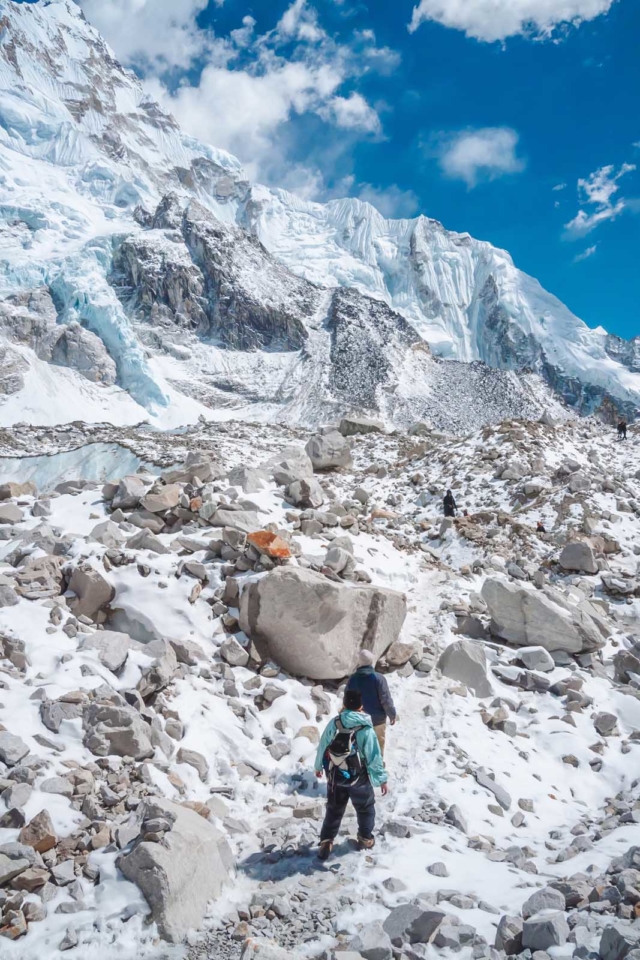
When it’s high season, base camp is filled with expeditions and tents spanning the valley. We only saw one expedition so far. They may have been here to climb Island Peak as base camp is also a place to acclimate for that peak.
We started to make our way back to Gorak Shep from Everest Base Camp at about 3:30 pm. Even though it was an easy trek back, there are narrow paths atop high ledges and it just so happens that while we were walking back, an ice bridge broke off after I stepped on it leaving Dave with a sticky situation of having to take one giant leap over a gorge. We made it back to Gorak Shep safely but it was a reminder just how dangerous the Himalayas can be.
Back to Gorak Shep
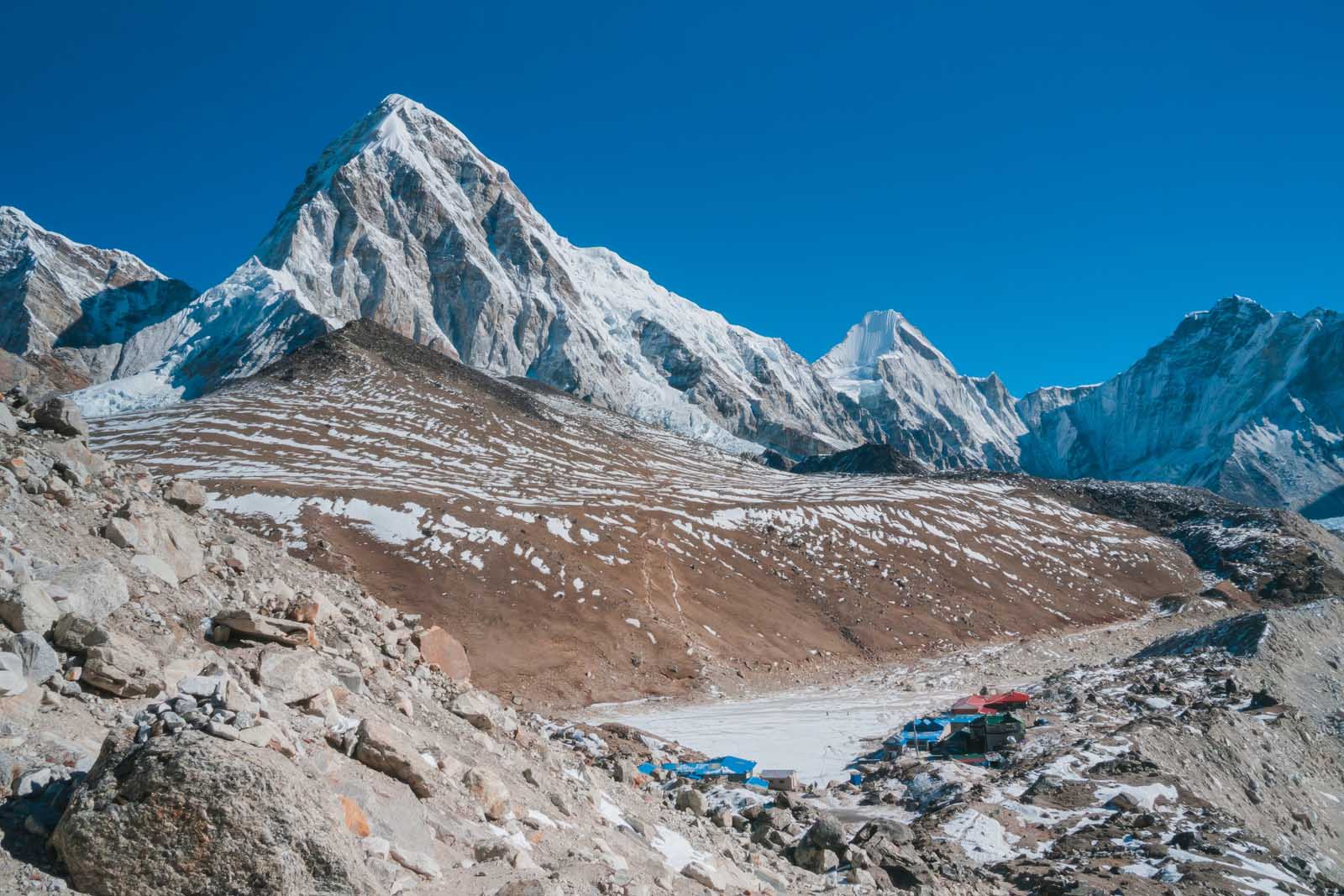
By the time we made it back to Gorak Shep, the excitement of reaching Everest base camp had worn off. We had reached our final destination Base Camp, but there was still a lot more trekking to go.
We were happy to have seen it, but we were exhausted. We felt the same when we climbed Mount Kilimanjaro. The thrill of reaching your destination is over and there is nothing more to look forward to, but there are still so many days to go.
That night I had serious sinus congestion and felt like I was suffocating in my freezing bed. It was quite scary to already be short of breath because of the altitude and then be completely congested. I really was terrified. Our guide Dipendra brought me hot tea all night and I slathered myself in Vicks Vaporub but nothing helped me to breathe easier.
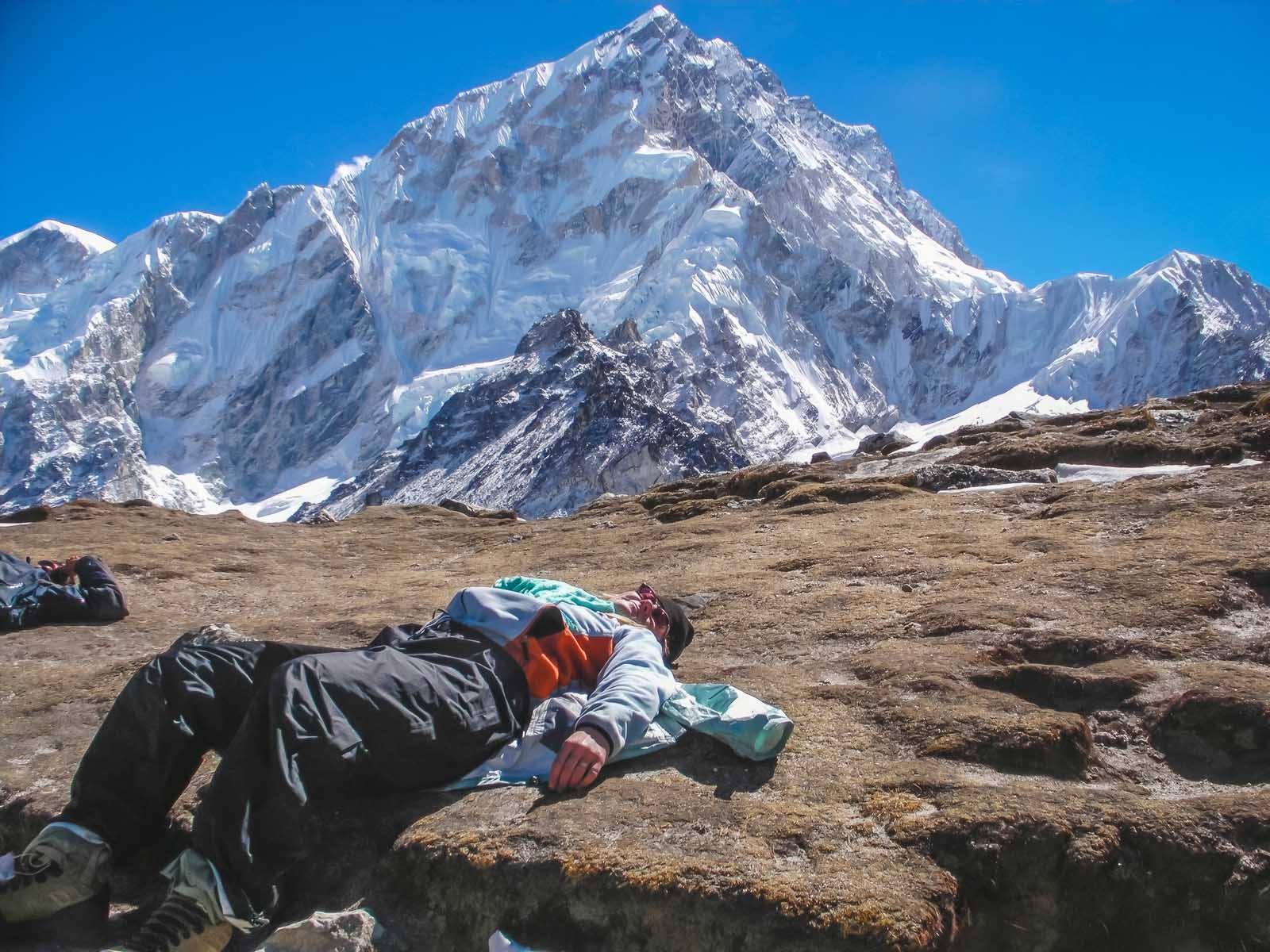
I was afraid as we had the Gokyo Lake trek ahead through the Cho La Pass. We were also planning to trek up to Kala Pattar for the best views of Everest in the morning. I hope I could make it but I was also dreading the day ahead. I barely slept a wink but I finally drifted into a not-so-peaceful slumber.
Gorak Shep – 5164 meters (16942 feet) above sea level Everest Base Camp Elevation – 5,364m (17,598 feet) above sea level Elevation Gain – 200 meters (656 feet) Distance – 3.5 km one way (2.1 miles) Duration – Three Hours Round Trip
Alternative Gokyo Lake Via Cho La Pass
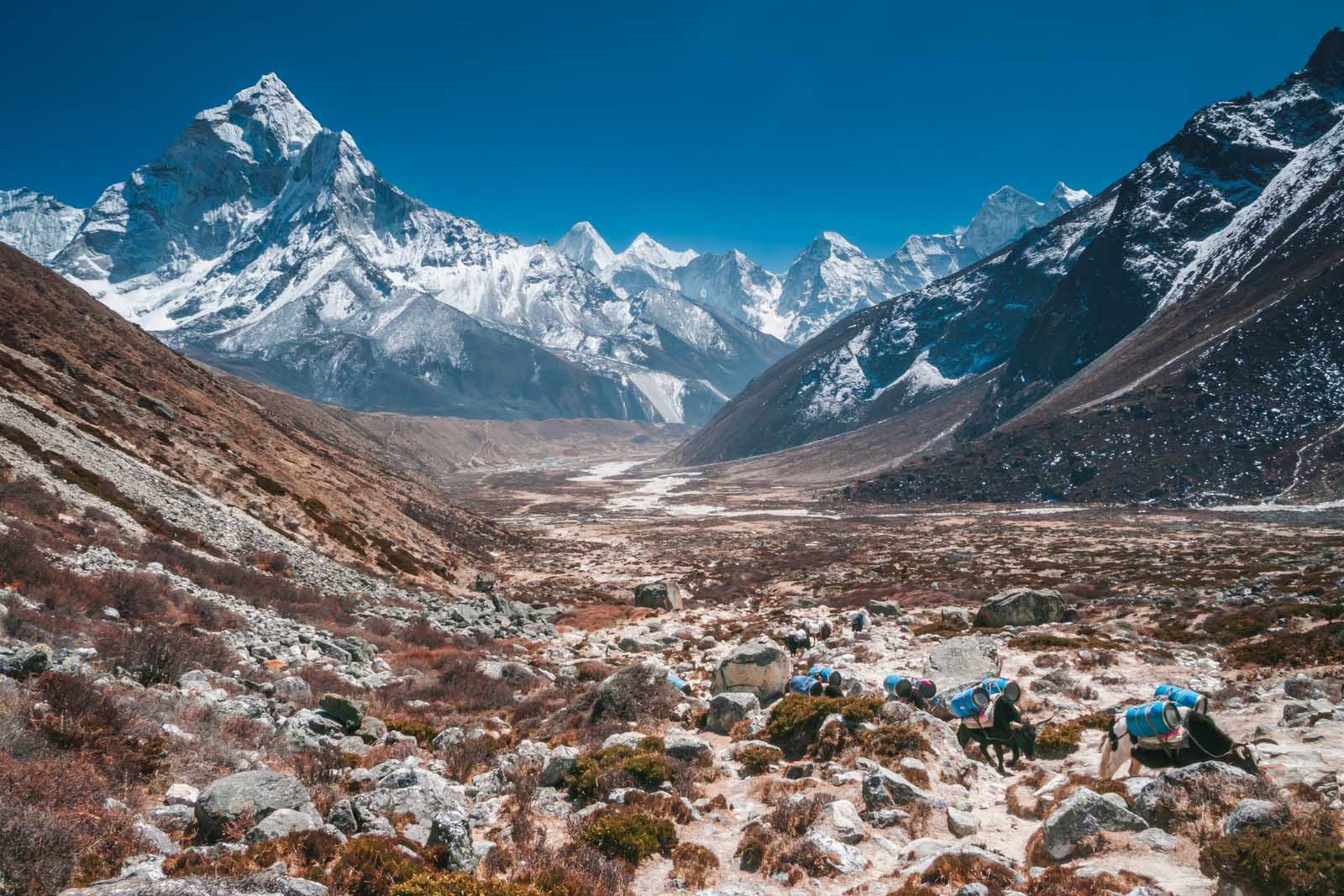
The next morning after a terrible night, we gave up our plans of climbing Kala Patthar and then on to the Gokyo Lakes and Cho La Pass trek. Even though I wasn’t feeling dizzy, nauseous, or lightheaded anymore, the sinus congestion was really getting to me. At altitude a cold can turn serious quickly, you just can’t take a chance when altitude is involved.
But, if we were going to trek on, this would be the next stop. It is supposed to be beautiful and if you are feeling up to it, we highly recommend it. This makes the trek much more interesting as you get to take a different way back to Lukla.
Cho La Pass: Altitude 5420 meters (17,782 feet) Gokyo Ri: 5357 Meters (17,575 feet) Gokyo Lakes: 4,700–5,000 m (15,400–16,400 ft)
Day 9 – The Descent and Kala Patthar
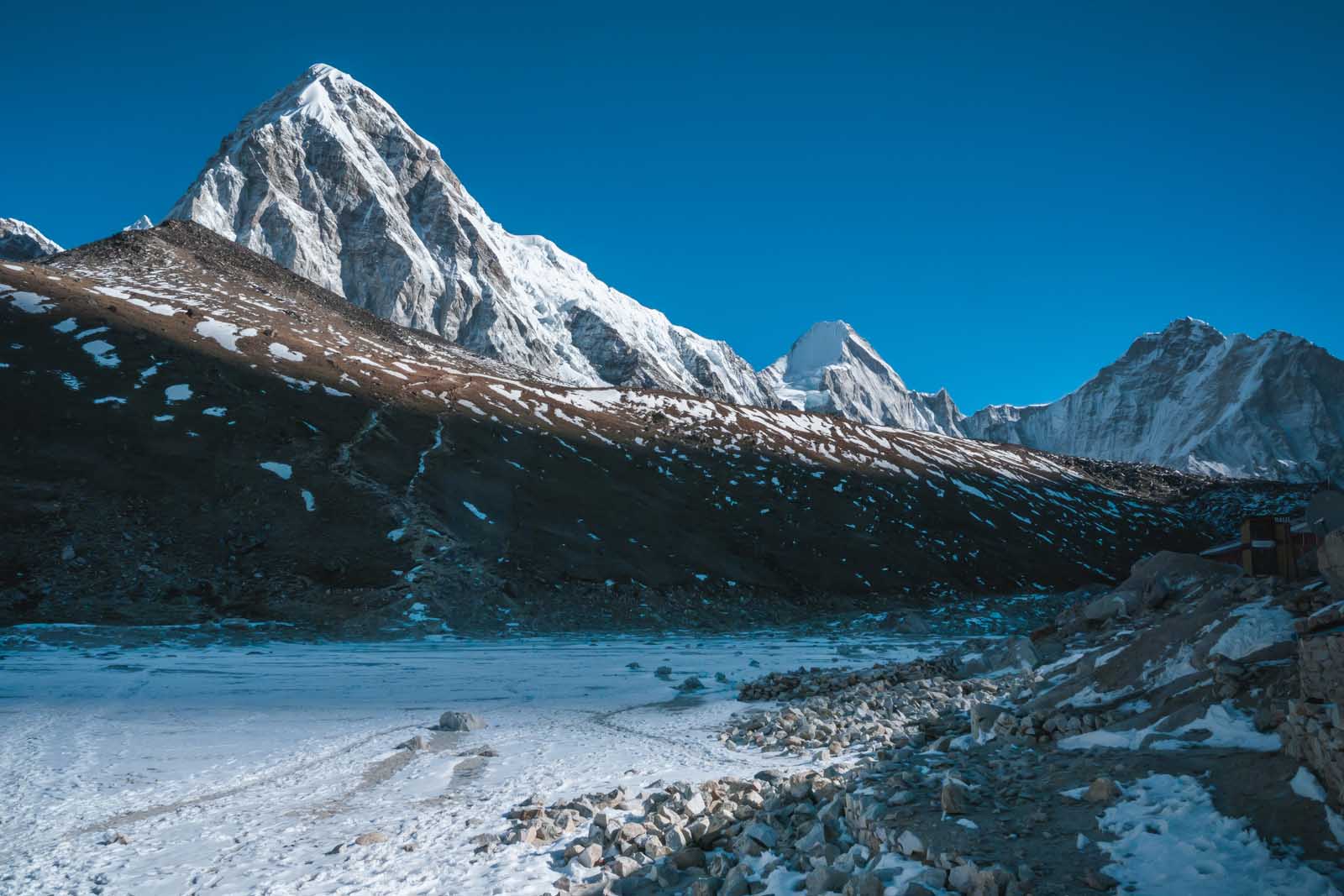
Kala Patthar is a hill above Gorak Shep that offers the best views of Everest and is a must-stop on anyone’s Everest Base Camp trekking route. We had planned to climb to the summit of Kala Patthar, but my congestion was so bad, that we decided it was safer to get to a lower elevation quickly.
Kala Patthar is a quick two-hour trek to add to your descent back to Lukla. It is a good option if you are feeling up for it as it gives a great view of Mt. Everest. Make sure to start early morning before dawn as there is still a long day of trekking after summiting Kala Pattar. Plan on another five or six hours to your next overnight stop at Pheriche.
Kala Patthar to Pheriche – Afternoon
By the time you reach your accommodation at Periche, you should be feeling a lot better. Dave and I find that we are fine in the 4000-meter ranges of altitude and experience very few symptoms of altitude sickness. It is at 5000 meters and above that, we start to feel our symptoms. Periche is a much more manageable 4371 meters.
Kala Pattar: 5643 metres Pheriche: 4371 Meters Altitude Loss : 1272
Days 10 to 11 – The Descent from Everest Base Camp
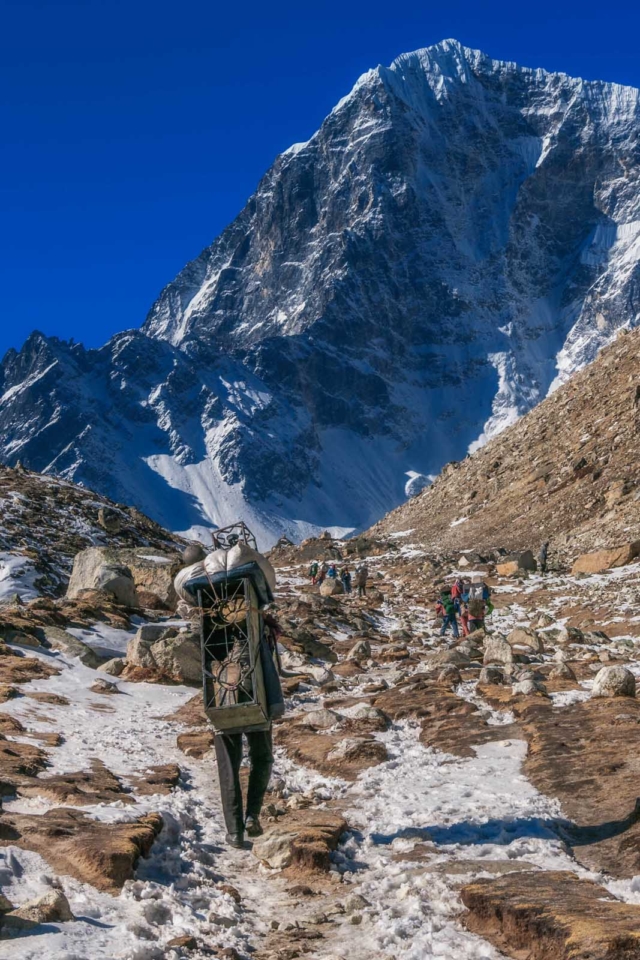
It took us two days more to trek back from Everest Base Camp to our final destination on the EBC Trek. I started feeling better on the second day as the dryness of the Everest base camp disappeared. My sinuses cleared and soon I was breathing easily. I started to feel guilty about turning around, but in hindsight, I know it was the right choice. You never want to take a chance with altitude sickness.
Even though we were heading down, there is still a lot of altitude gain as the EBC trek doesn’t continuously go downhill. I was feeling really fatigued and we still had a tough couple of days ahead of us. But knowing there was light at the end of the tunnel made everything easier.
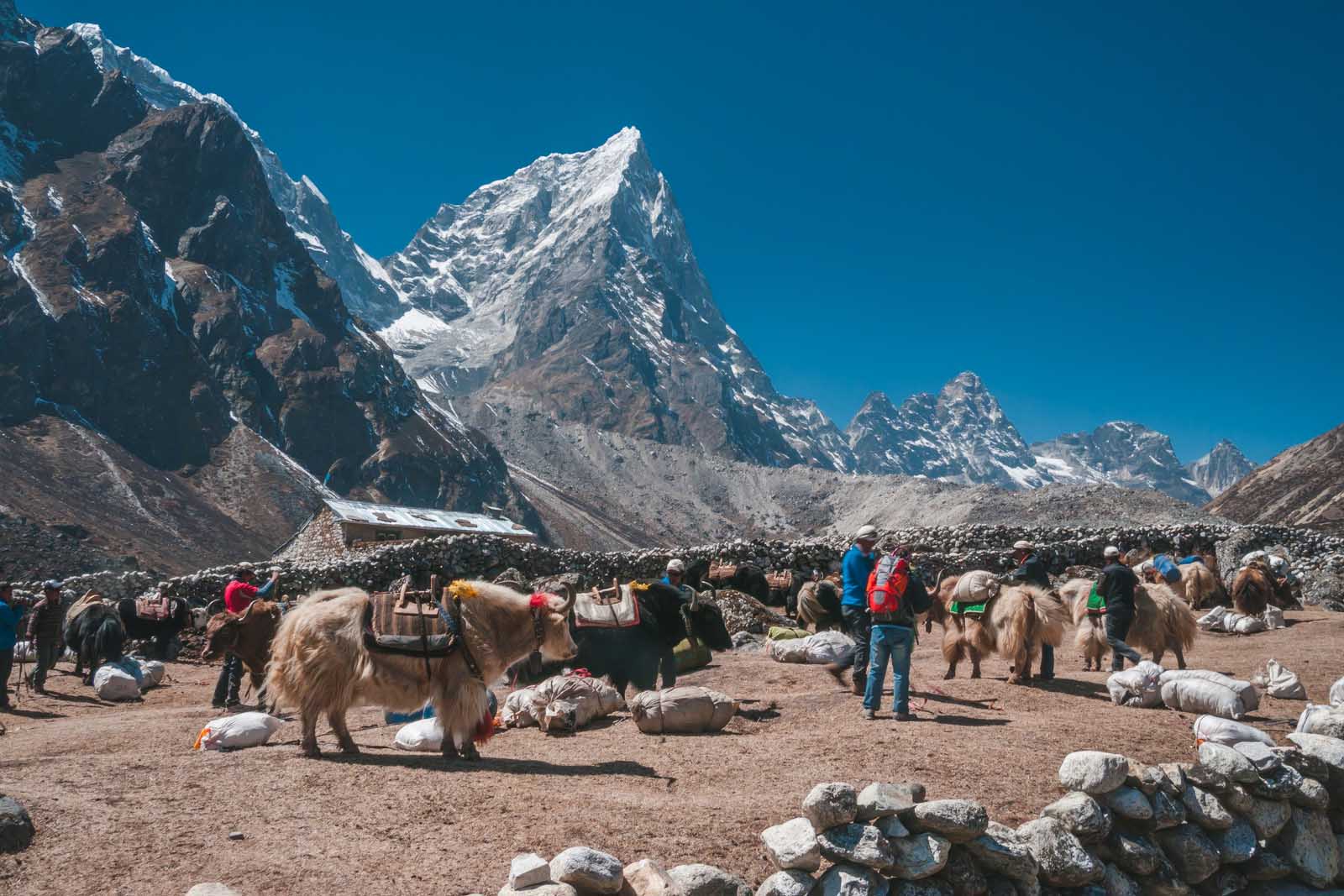
It takes a lot of mental stamina to climb back down as the euphoria of reaching the Everest base camp has worn off, but we made the most of it, by chatting with other trekkers and getting to know our guides better.
During our decent we could actually take our time to smell the roses or should I say enjoy the trekking trail that ran through the stunning rhododendron forest.
Rhododendrons are beautiful flowering plants that bloom in different shades of pink, red, white, and purple. The rhododendron forest is particularly prominent in the areas of Phakding, Namche Bazaar, Tengboche, and Dingboche which we really didn’t notice until we made our way down the mountains.
We followed the route we came up with, but it was much faster and we stayed in different villages. The beauty of booking organized trips with a local guide is that our guide Dipendra knew the routes like the back of his hand, so he could change accommodations easily to suit our speed.
Day 12 – Lukla
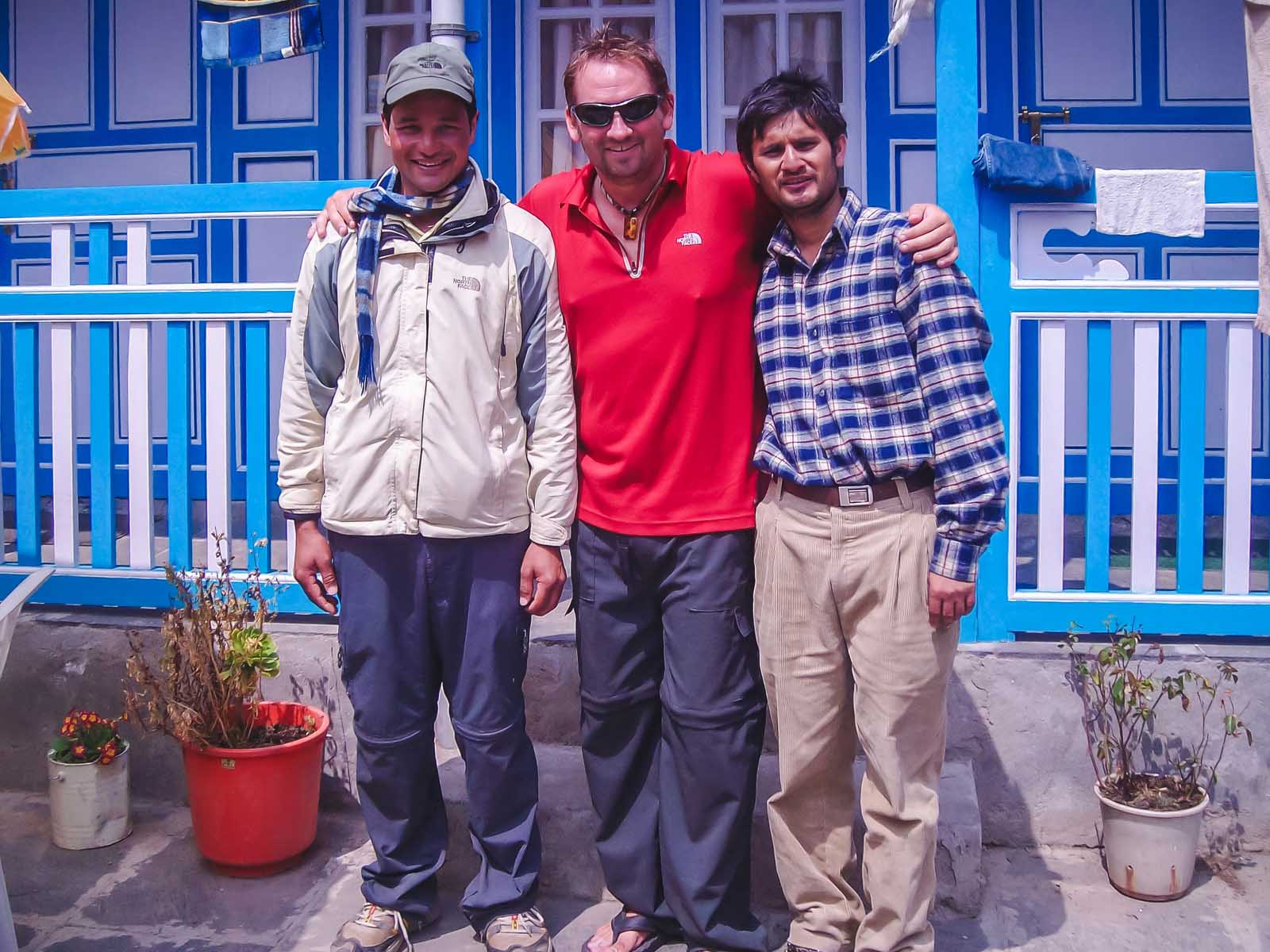
We were back in Lukla early on day 12 of our EBC Trek and had an evening booked in a guest house here to catch the first flight from Lukla back to Kathmandu in the morning. As much as we loved our trip to Everest, we were excited to be moving on to explore more of Nepal.
The accommodation was pleasant with a lovely restaurant, hot shower, and warm and cozy beds. It was a great way to end the trip.
Day 13 – Return To Kathmandu Flight from Lukla Airport
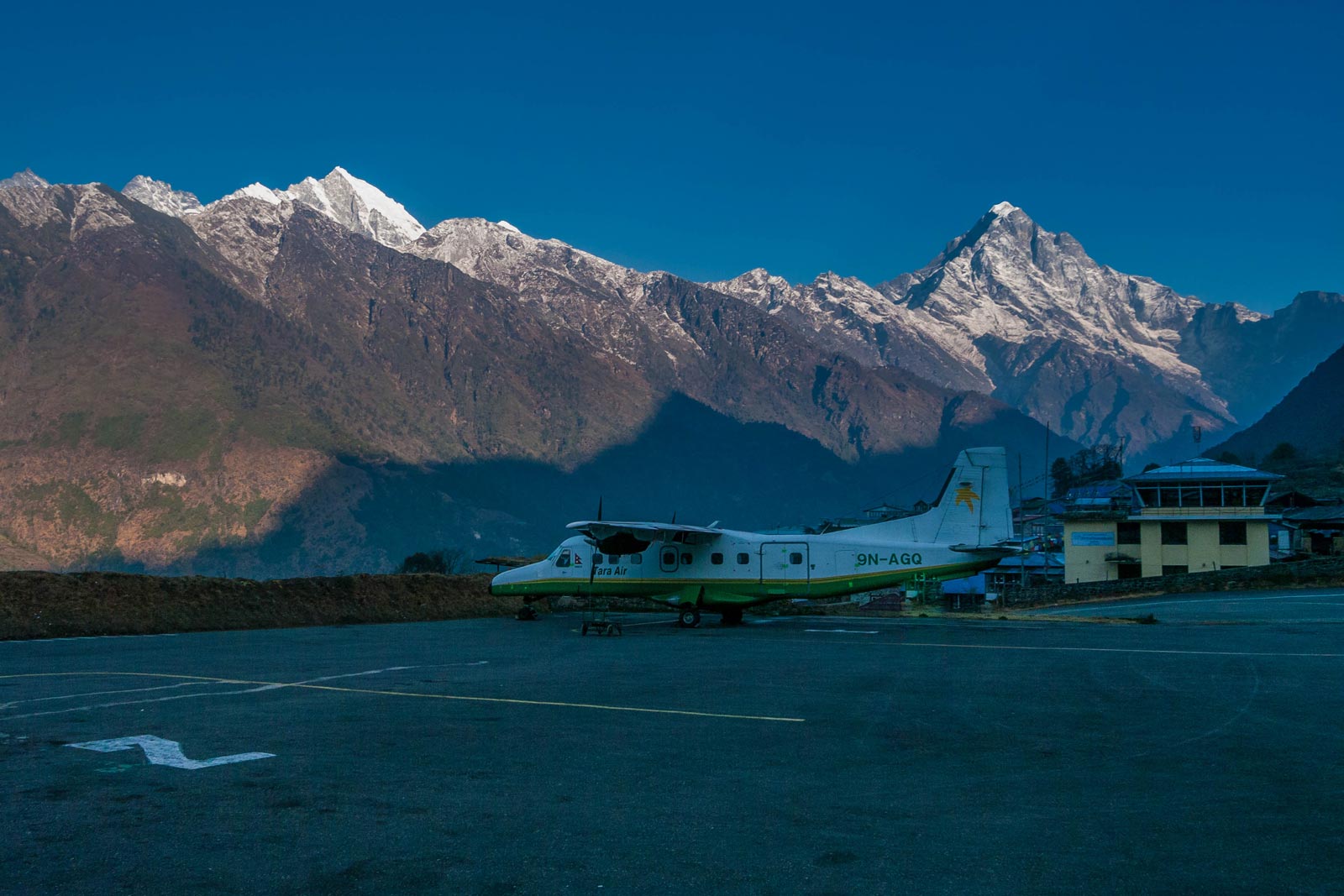
It is very important to give yourself an extra cushion when booking your return flight not only home from Kathmandu but from Lukla. We stayed overnight in Lukla on the final night of our trek and booked a flight to Kathmandu for first thing the next morning.
It is not uncommon for flights to be canceled or delayed flying out of Lukla Airport. Weather conditions change quickly. So give a bit of a cushion when booking your flight home from Nepal after you’ve finished your trek to Everest Base Camp. Many a traveler has missed their connecting flights home from Kathmandu because of delays in Lukla. It is safer to plan to spend a night or two in Kathmandu after your trek.
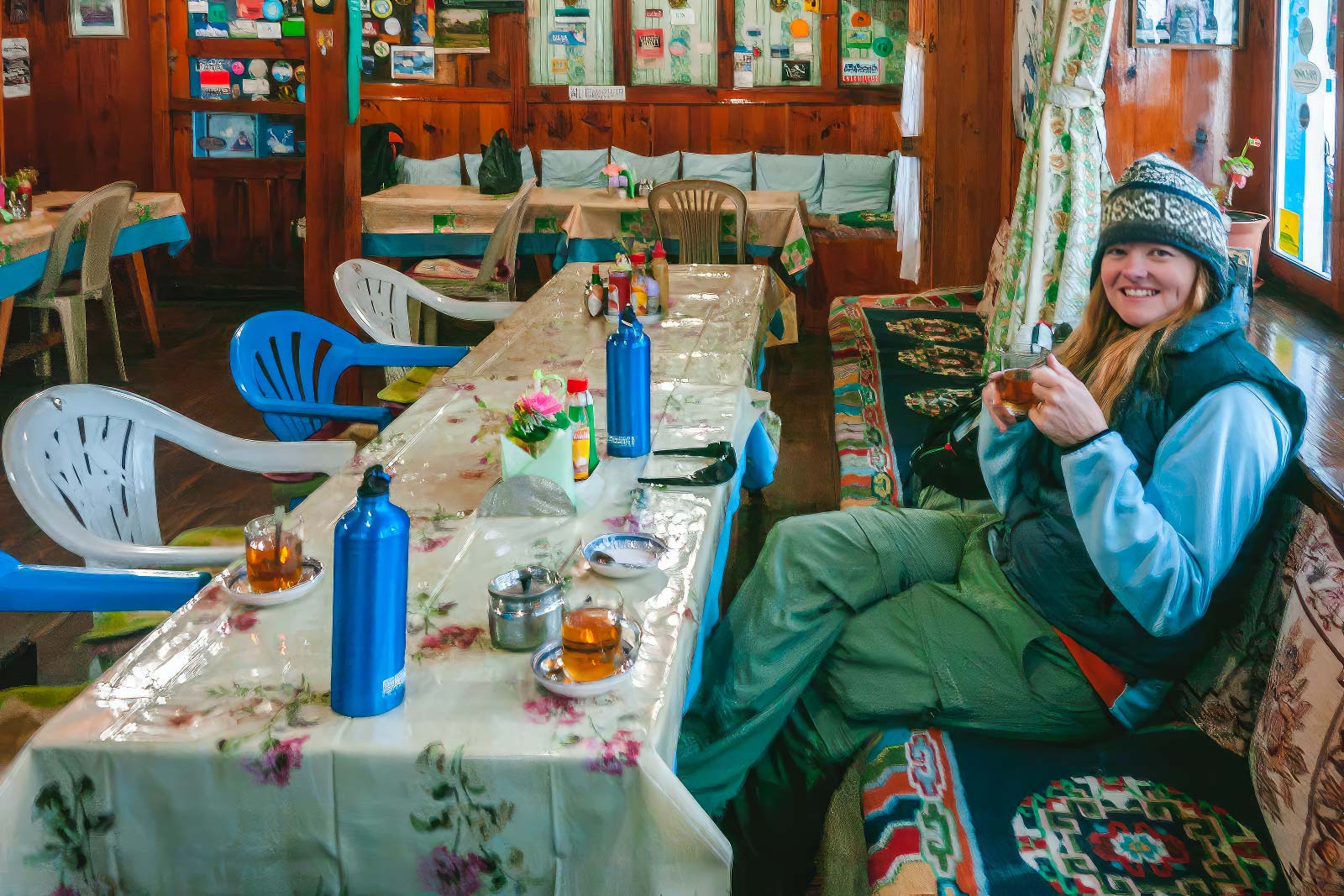
We were delayed an entire day. Even though we were booked on the first flight from Lukla, the weather made us wait until near sunset. We were the first (and only) flight out that day, so everyone else who was waiting for their flights all day was stuck another night.
It was a bumpy flight back to Kathmandu and we almost wished that we didn’t make it on the flight. The turbulence was so bad, I was sure we were going to drop out of the sky.
Everyone on the flight was silent as we were tossed about dropping huge amounts of elevation at a time. But we landed and we have never been so happy to arrive in Kathmandu. We kissed the ground, thankful to have trekked to Everest Base Camp, but vowed to never do it again.
Accommodation – Tea Houses on Everest Base Camp
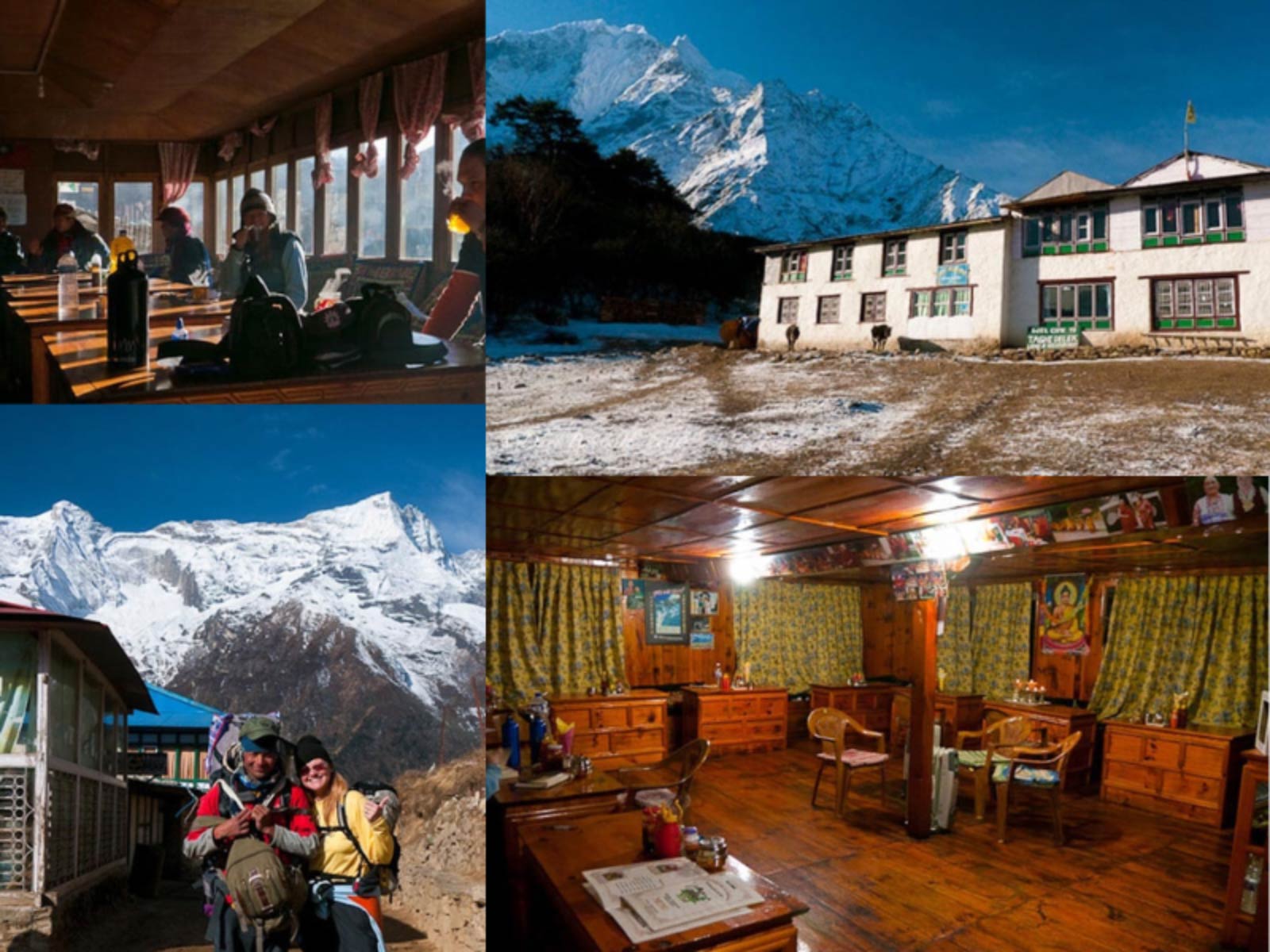
The main lodges of each teahouse we stayed in during the first half of our trip were cozy and warm. At the lower elevations, woodstoves burned wood in the dining room and common areas and our rooms were a comfortable temperature as we were wrapped up in our sleeping bags.
But as we ventured higher, the stoves were less abundant and instead of wood, they burned yak dung. You heard me, Yak Dung. Wood can’t burn in thin air, so they use yak dung to heat the teahouses at high elevations. Rooms are not heated so when we went to our rooms, we had to wear hats, thick socks, puffy coats, and long johns.
There were charging stations at the accommodation for electronics and we paid by the hour for electricity.
- We highly recommend taking a portable USB charger to charge your own electronics.
- We also used a solar USB charger that recharged during the day as we hiked.
Meals on Everest Base Camp
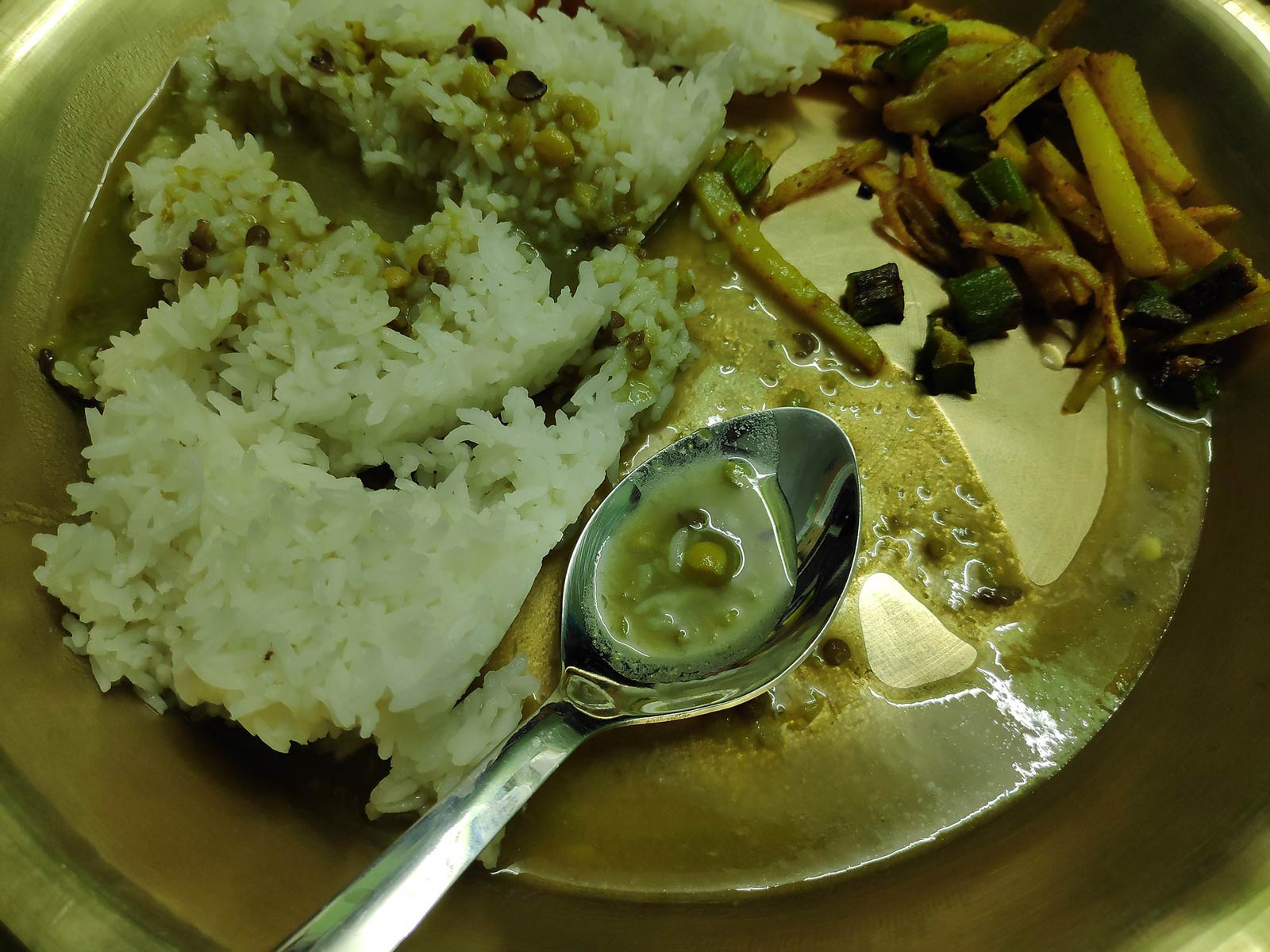
Because we booked an all-inclusive Everest Base Camp trek with Simrik Real Nepal tour company, all meals and snacks were included with our accommodation. Each evening, hearty meals were served that included pasta, rice, or Dal Bhat. Dal Bhat is the staple food of Nepal consisting of lentils, vegetables, steamed rice, and curry.
For the first few days, meat was served at meals, but as you climb higher, meals turned to vegetarian as it is more difficult to get the meat up the mountains.
Prayer Flags and Prayer Wheels – EBC Trek Etiquette
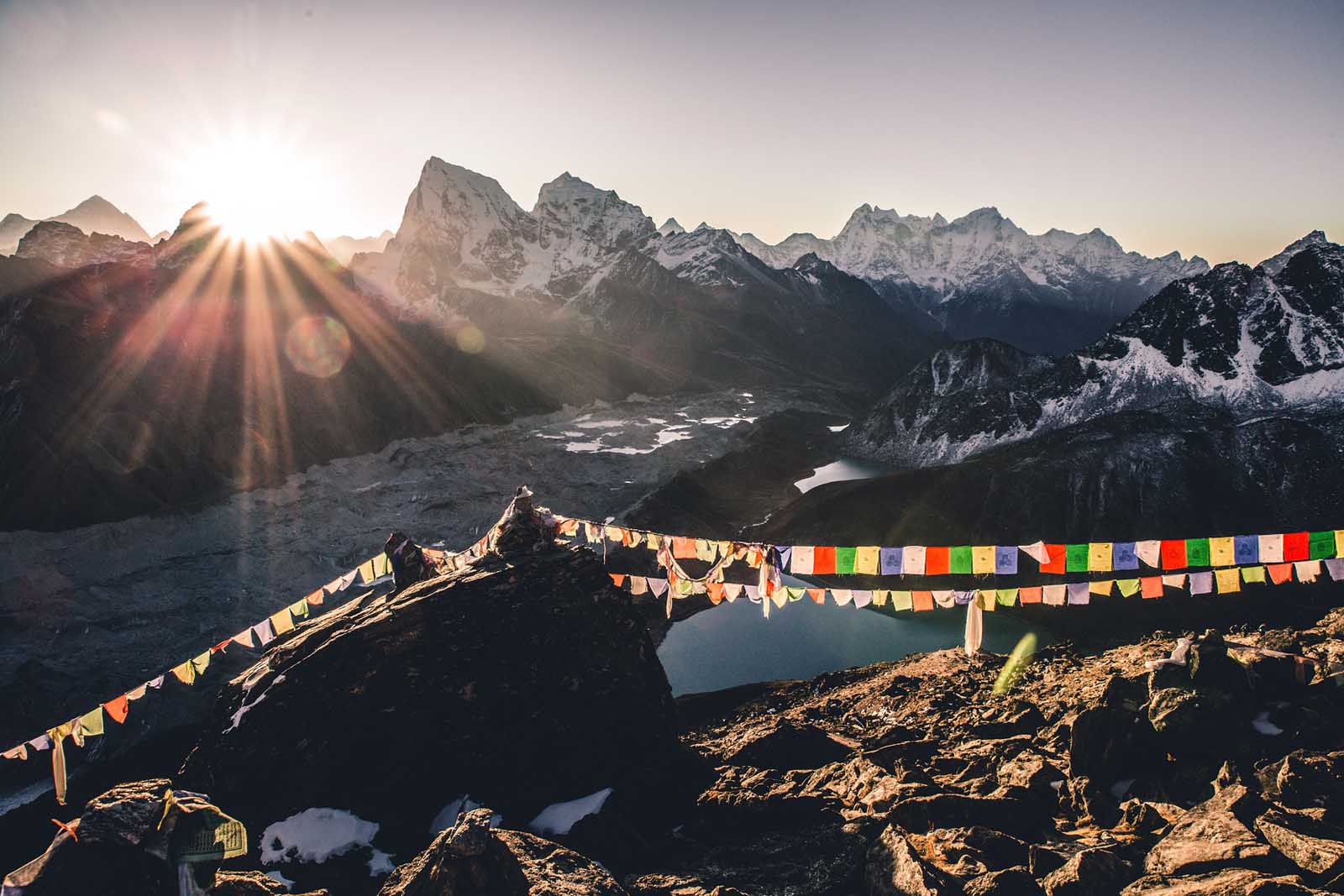
We saw many prayer wheels, prayer flags, and prayer rocks (mani stones) all along the trail to Everest. Everest is a sacred mountain and these monuments help give luck to the climbers on the mountain. There are customs to be followed when approaching prayer rocks or prayer wheels.
How to properly trek around prayer Wheels and Prayer Rocks
- When approaching a prayer rock, it is important to walk to the left of the prayer rocks (mani stones) in a clockwise direction. The stone on the right means you are on the “right hand of God.”
- When using prayer wheels, you walk along and spin them to ask for blessings for the climb ahead.
- Sherpas and locals spin prayer wheels saying the mantra “ Om Mani Padme Hum” giving blessings to the climb ahead.
- The prayer flags have prayers and mantras written on them which are believed to carry messages of positivity and to spread goodwill and compassion they are carried by the wind.
Altitude Sickness
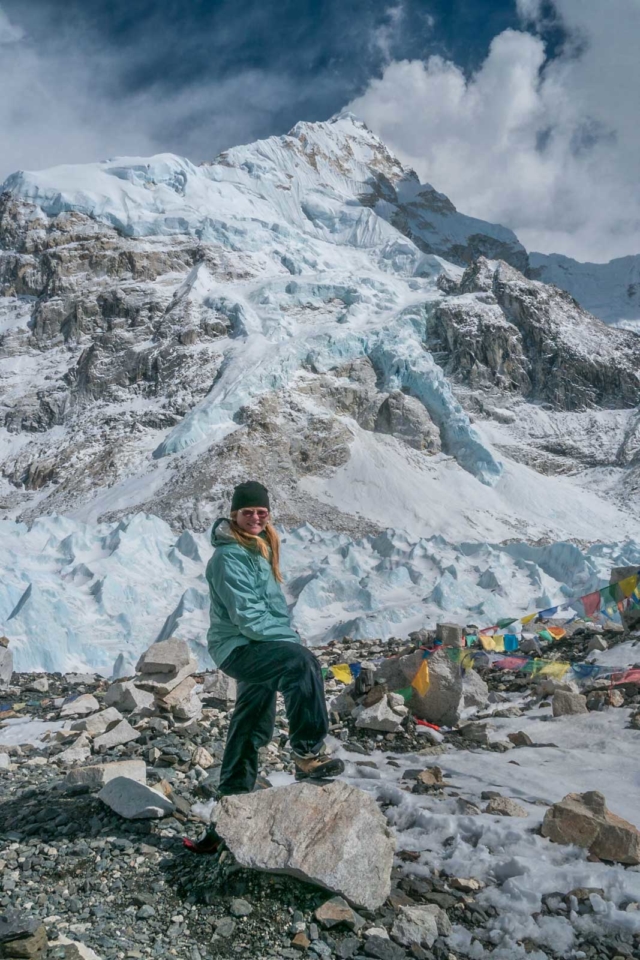
Altitude Sickness is a very real possibility on the EBC Trek. On average 3-5 people die each year doing the trek to Everest base camp. Make sure to keep an eye out for signs of Acute Mountain Sickness. Acute Mountain Sickness is life-threatening and early symptoms include nausea, headache, and vomiting. It can lead to death. The Best way to alleviate symptoms is to go down to a lower elevation.
If you start to feel dizzy, have a pounding headache, or if you start to vomit go down to a lower altitude as quickly as possible. Take your time climbing, stay hydrated, and listen to your body.
Drink plenty of fluids, try to eat, and rest regularly. It is better to walk slowly and steadily rather than rushing at high altitudes. And when you get to your accommodations each day, relax as much as possible.
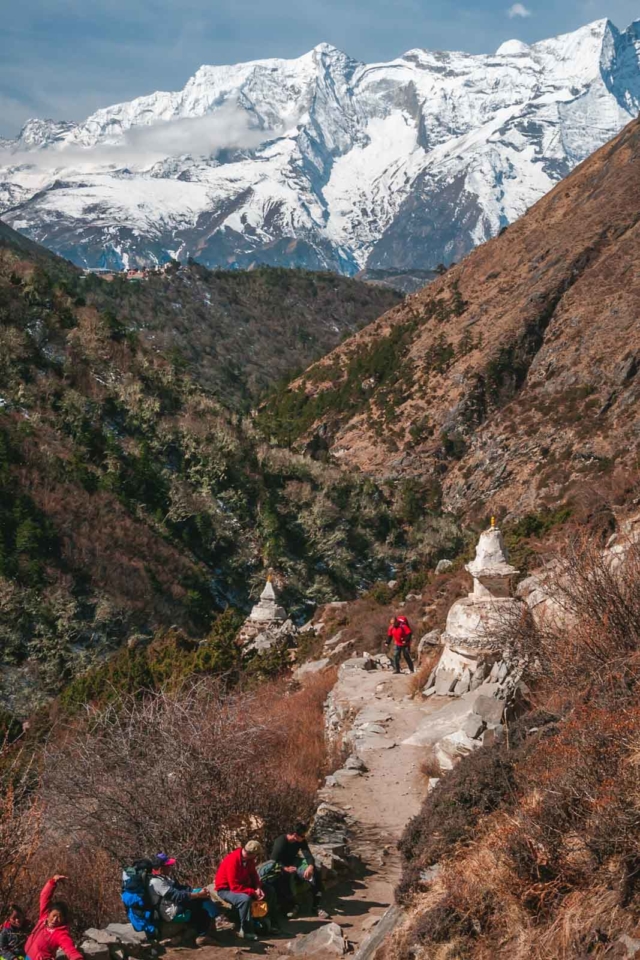
It can be dangerous trekking to Everest Base Camp from falling off the mountain to succumbing to altitude sickness. Some people have simply disappeared. Hiring a guide is a good option (and now the only option) for safety and it is very important to look for signals of altitude-related sickness.
But the Everest basecamp trek isn’t nearly as dangerous as climbing to the summit of Mt Everest. In 2019, 11 people died while trying to summit Mount Everest.
The village of Lukla is located at a high elevation so you will feel the effects of the thin air as soon as you land. The elevation of Lukla, Nepal is 2869 meters (9,350 feet). We were short of breath and already feeling fatigued upon landing. So instead of immediately starting our trek, we had a hot breakfast at one of the many restaurants in Lukla.
Travel Insurance for Everest Trek
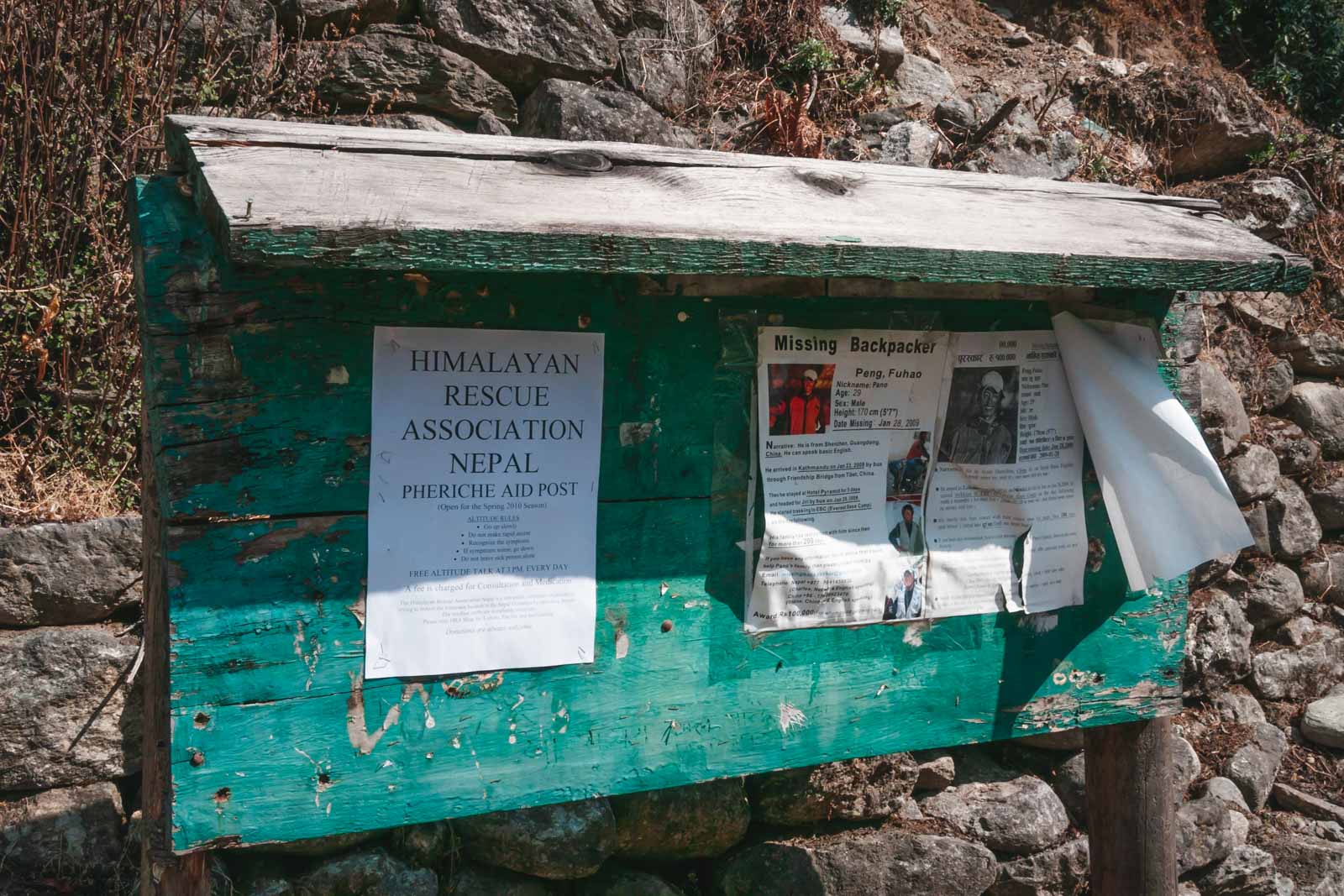
We always travel with travel insurance on our travels, but hiking to Everest Base Camp will not be covered by regular insurance providers. It is highly recommended to get supplemental comprehensive travel insurance that offers trip cancellation insurance, and medical evacuation insurance.
Medjet is a good option for medical evacuation insurance and is a good addition to your regular travel insurance. There is a very real possibility of altitude sickness and we knew of two people that needed helicopter rescues during our trek.
World Nomads offers specific Everest Base Camp Insurance. You can check them out to get a quote. I would suggest a combination of World Nomads travel insurance and Medjet medical evacuation insurance. Regardless of what travel insurance you choose, be sure to call them directly to ask for specific advice about trekking to Everest Base Camp.
For a trip like Everest Base Camp, you will want to make sure to have trip interruption and trip cancellation insurance as well as lost luggage. This is a trip of a lifetime, so make sure you have a backup plan.
Can you Trek Independently to Everest Base Camp?
As of April 1, 2023, Nepal has banned solo trekking. Foreigners must hire a guide for treks in high-altitude trekking regions of national parks. According to the Kathmandu Post in March, “ solo or independent trekkers have to mandatorily hire a guide or a porter before setting off to Nepal’s mountains.” However, after an updated article in the Kathmandu Post, it seems that the Everest Region is an exception. Before booking, we would check with local companies and authorities as rules are constantly changing.
Regardless, we loved hiring a local guide to make oure experience richer, to support the local economy and to feel safer hi
- Our all-inclusive Everest Base Camp Trek through the Simrik Real Nepal included return flights from Lukla, food, lodging, guiding, and all permits and paperwork.
- We didn’t have to search for accommodation at the end of each day of trekking
- We had English-speaking guides and a porter.
- We had our own room, but you can also share rooms on the EBC Trek
- We never worried about the cost of meals. They were all prepaid.
- And our guide (Dipendra) and porter were part of the package for the trip.
Costs for Everest Base Camp Trek
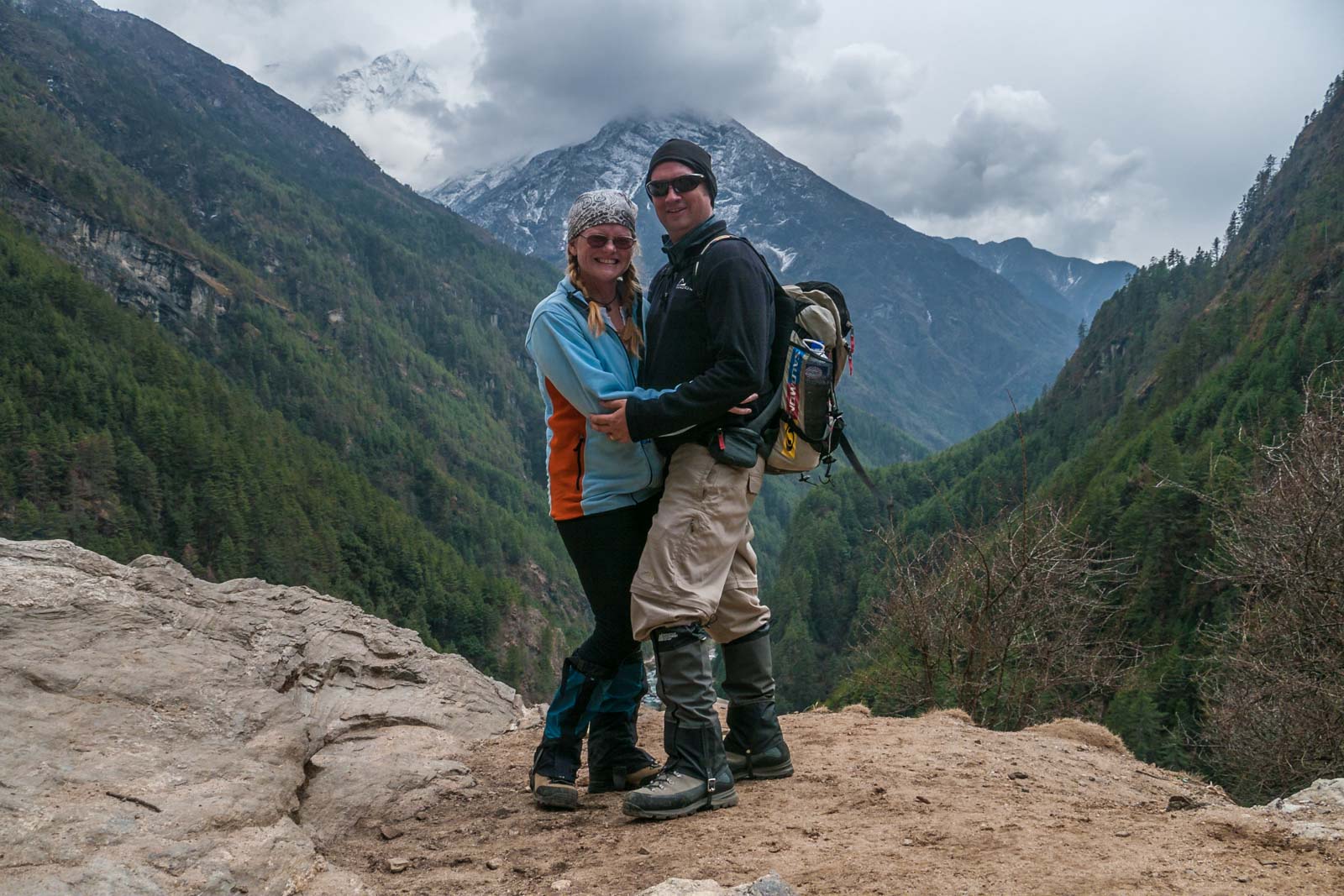
Prices can vary greatly for trekking to Everest Base Camp. You can contact Simrik Real Nepal for up to date prices.
- Booking with an international agency can cost from $1800 – $5000 USD
- Booking with a local agency and be anywhere from $1400 – $2500
W hen is the Best time to Trek to Base Camp?
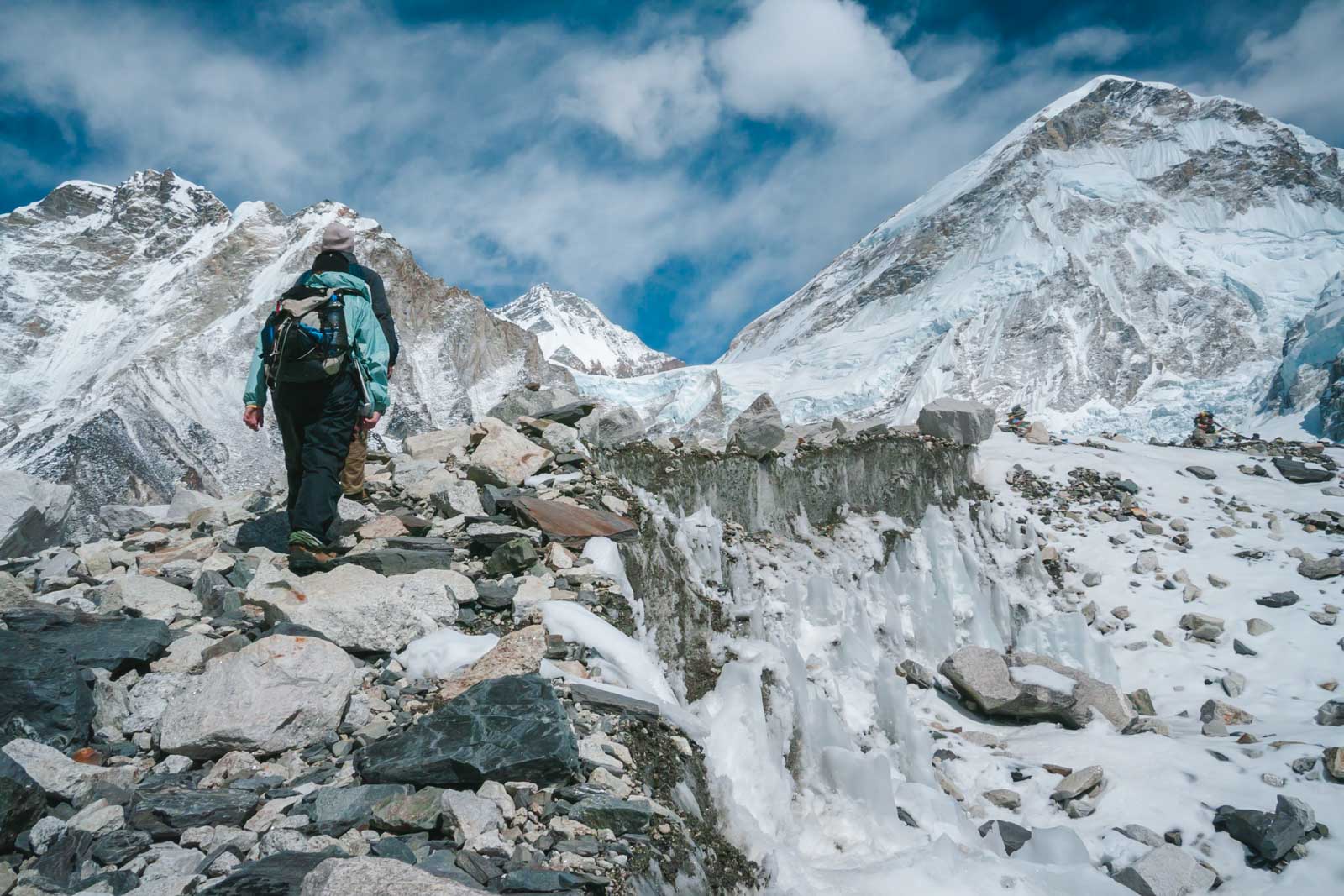
The high season for treks is April to May and October to November. We climbed in early March and felt that it was the perfect time of the year. The weather was beautiful, the skies were clear and the official climbing season hadn’t picked up yet. So we had a lot of the mountain to ourselves. We had heard stories of how busy the trail is, but at this time of year, it was quite deserted.
But a week and a half after our trek started as we made our way back to Lukla, it was already busier. We saw a lot of parties climbing up and the trail was getting congested. I can only imagine how packed the trails are during the high season.
What to Pack For Your Everest Base Camp Trek
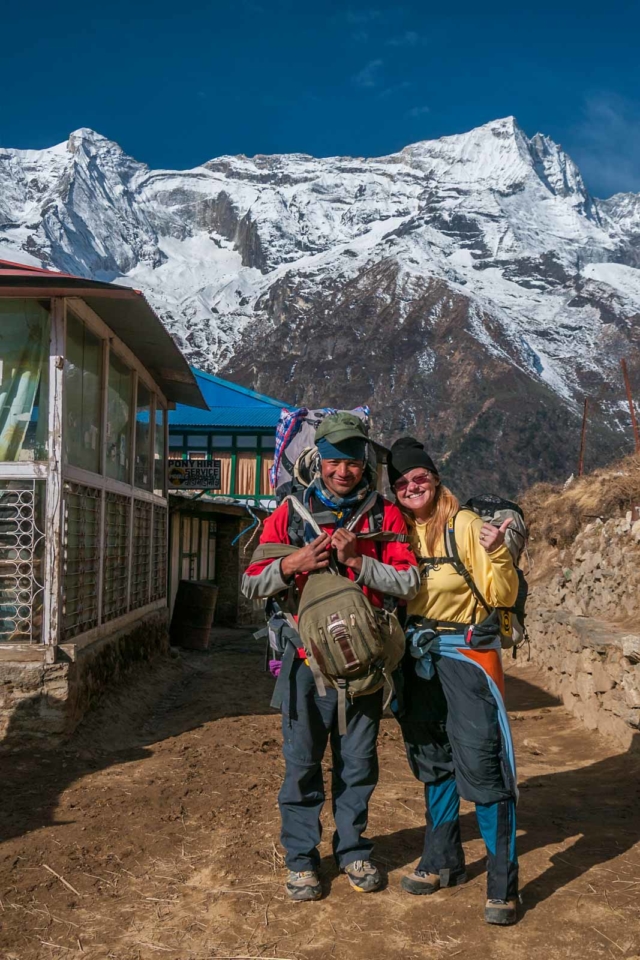
Layering is extremely important when trekking to Everest Base Camp. This is a quick guide for clothing but we wrote a complete packing guide for base camp here .
Make sure to have a day pack to carry the important items and layers that you will need for your day of trekking for the entire trek. Your porter will carry everything else.
- 2 quick drying long sleeved base layer shirts
- 2 trekking shirts short sleeve
- 2 Thermal Base Layer – 2 leggings/2shirts
- 2 liner socks
- 3 pairs of woolen blend trekking socks
- 2 pairs of trekking pants with zip-off bottoms
- 2 fleece sweaters – one lightweight, one heavier
- Outer windproof jacket and pants
- 2 water bottles to fill regularly
- Steripen or Lifestraw – this is great for purifying water
- Portable USB Charger
- Basic First Aid Kit – A first aid kit is important to have but your guide, they will have one as well.
- Warm sleeping bag. If you don’t have a sleeping bag rated to below zero, we recommend renting one from your guding company.
Treats and Medication
- Tang – I was glad we packed Tang for our water. It made it taste better, keeping us well-hydrated. We didn’t really want to drink just water, but the Tang (which we bought in Kathmandu) was actually delicious. Gatorade or another electrolyte-replenishing drink is a great idea.
- Diamox – (You can buy this in Kathmandu without a prescription) I highly recommend using Diamox tablets for altitude sickness as well. We met so many people suffering from headaches, dizziness, and fatigue and they weren’t taking anything. We’ve always used Diamox when climbing to altitude and it has worked beautifully for us.
- Chocolate – When we were feeling ill, we were happy to have chocolate to eat. It was the only thing that we could eat at times.
How to Get Fresh Water on An Everest Trek
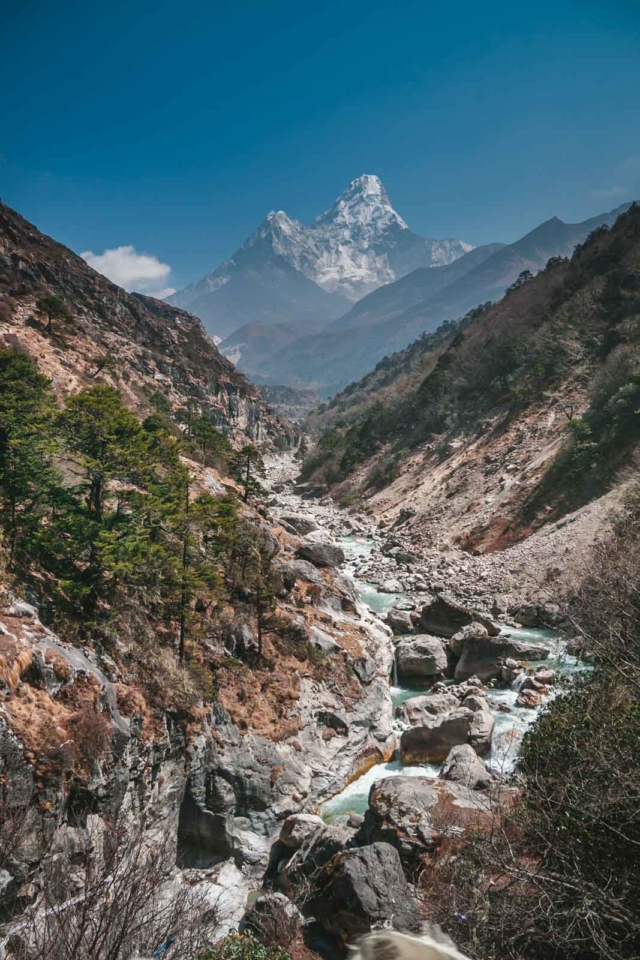
We recommend two refillable water bottles per person that can be refilled along the way. You can fill up anywhere for free along the Everest Base Camp route, but make sure you have a SteriPen or some other form of water purification with you. We love the SteriPen for purifying water, see our review here.
You can also use the LifeStraw or water purification tablets , but once we discovered the SteriPen , we never went back. See our complete Packing a Travel First Aid Kit here
Do You Need Climbing Experience for Everest Base Camp Trek?
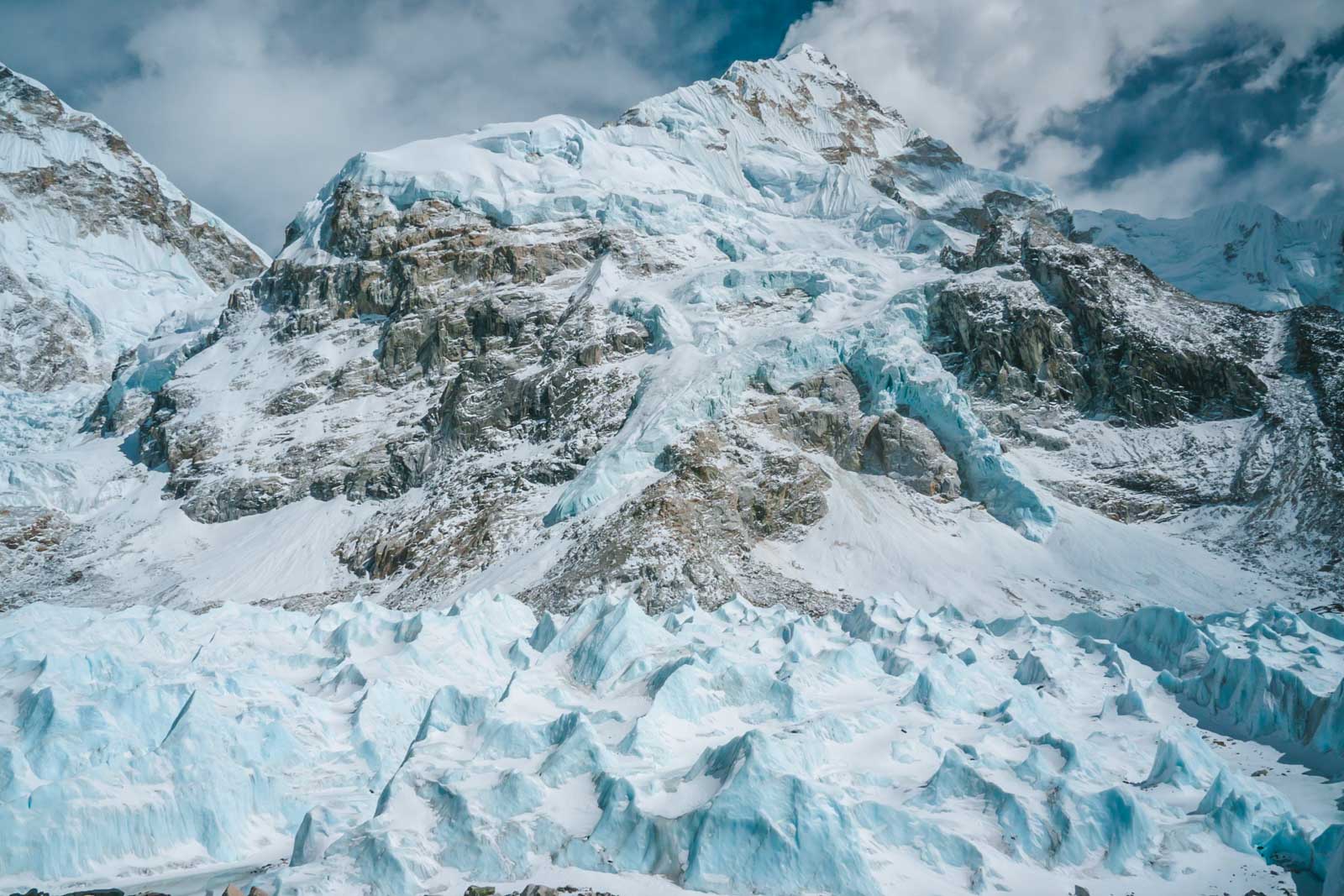
There is no need for any technical climbing experience to make it to Everest Base Camp. If you are relatively fit, it is very doable. But it is a full two weeks at a sustained altitude of over 4000 meters.
We didn’t train for our Everest Base Camp Trek but we had been to altitude before and had spent a lot of time backpacking leading up to the months prior. It’s good to know how your body reacts to altitude. We suggested doing a couple of treks above 3000 meters (9000 feet) to see how your body reacts.
Hot Tips for Trekking to EBC
- Keep your camera batteries close to your body when not in use. The cold and altitude really eat up battery life, so you will want to keep them warm for as long as you can.
- Bring USD, ATM Fees are high and you are limited to the amounts you can take out of the ATM, so have ISD to exchange instead.
- Pack handi wipes and Gold Bond Powder – it’s a lifesaver when you can’t get hot showers.
- See our Full list of Everest Base Camp Tips here.
How to Get to Everest Base Camp
There are daily flights to Kathmandu International Airport from international hubs around the world.
Where to Book Your Everest Base Camp Trek
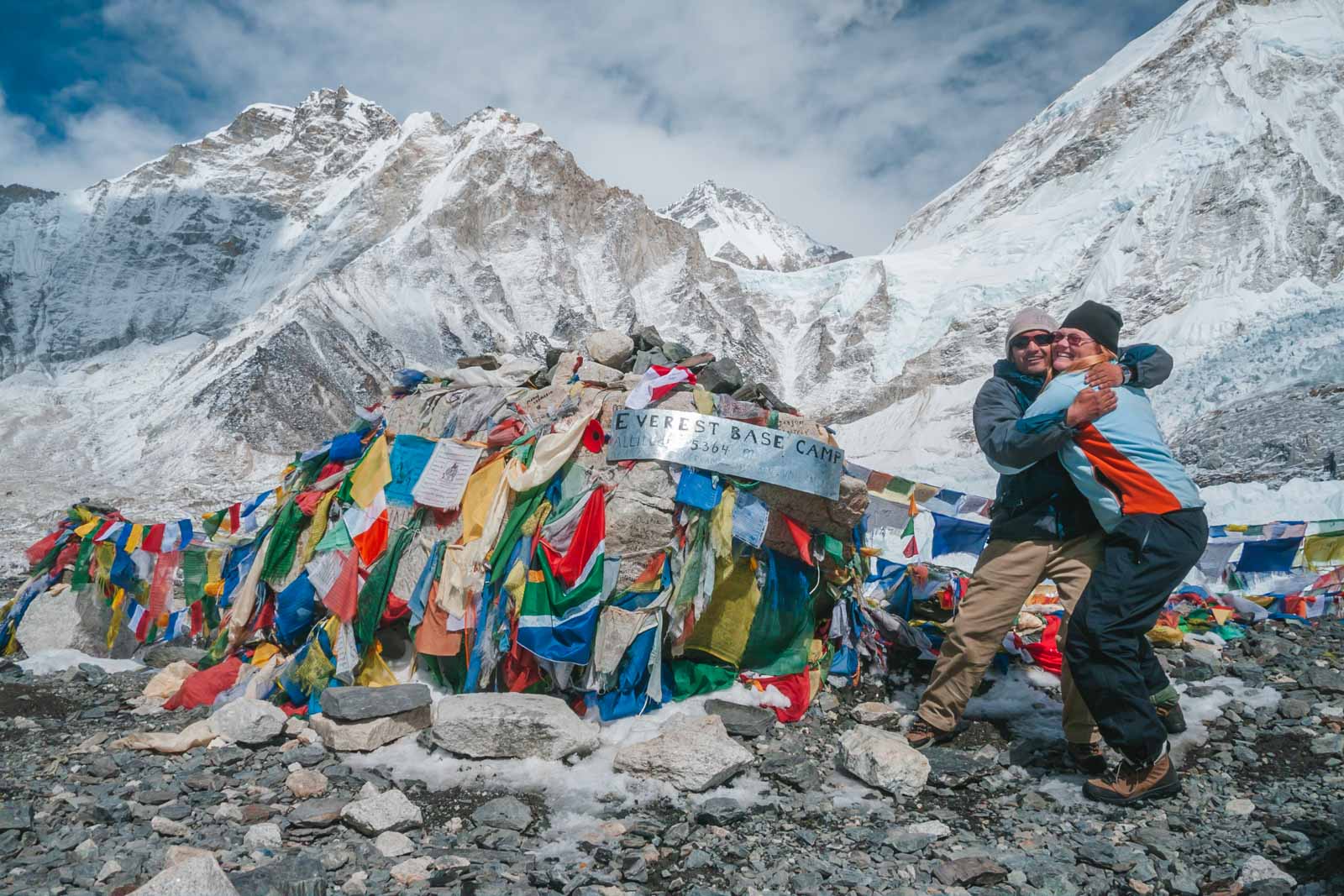
We booked our trek in Kathmandu with Local Guide Dipendra of Simrik Real Nepal. If you are looking for a local guide he is an excellent choice with nearly 20 years of experience in the mighty Himalayas.
Prices for the Everest base camp trek cost can vary depending on where you book. Group tours booked in North America will charge more. Ranging from $1500 – $5000 USD
You can save a lot of money by booking a local guide as you will cut out the middleman prices. Having a local guide let us know our money was going directly to the Nepal economy. Check with Simrik Real Nepal for current prices.
How Much to Tip Guides and Porters for an EBC Trek
Guides and porters in Nepal do not make a lot of money and rely on tipping. When we take tours of any kind, we (ourselves) tip 15% – 20% but that is a part of our culture in North America, we are quite large tippers and realize that others are not comfortable with that. We’ve done a lot of research and gone by what our tour companies have suggested on other tips, what we feel is a fair tip and what the average is across the internet.
For tipping in Nepal we have broken down the cost for a guide and porter.
Guide – Tipping – 10% – 15% of the total cost of the trip. We find this the easiest to figure out. If you paid $2000 for your trek, the lead guide should receive $200 – $300
Guide per day – Some suggest $10 – $15 per day per person for guides – For a 14 day trek that means you would tip your guide $140 – $210.
Porters per day – $5 – $10 per day per person for porters. – $70 – $140 for your porter.
We like to start at 15% of the total cost of our trips to give to the guides and then pay the porters a daily fee of $10.
If you can afford to trek to Everest Base Camp, you should be able to tip your guides and porters who have worked so hard accordingly.
Daily Life in the Everest Region of Nepal
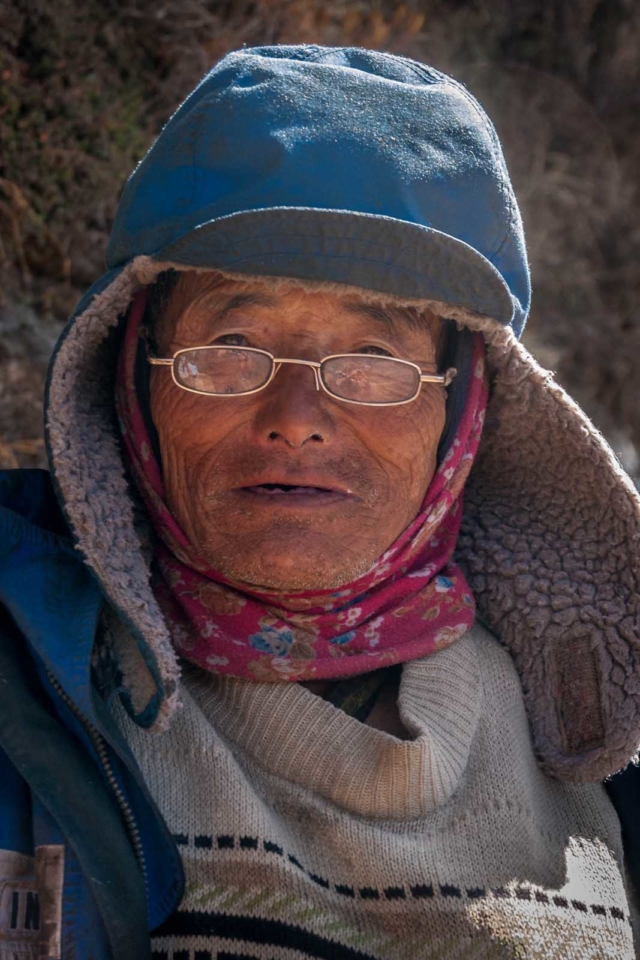
While trekking to Everest we passed through many picturesque villages. The people are friendly and life goes on as it would in any community in Nepal. People do well in the Khumbu Region and they respect the tours passing through because the tourists are what keep them going.
There is electricity from the water that they harness from the Imja Khola River and Dudh Kosi River; two rivers that run through the trek. They also have solar power for electricity as well. There are schools, fresh running water, televisions, a health clinic, and bars.
That is not to say that life is all roses. It is a remote region of Nepal and it is difficult to get any supplies in. Food and equipment need to be carried into villages on foot. Porters carry heavy loads on their backs and women and children also do the heavy lifting. Everything needs to be carted in by hand or by animals. Check out our tips for climbing to Base Camp
How Long Does it Take to Trek to Everest Base Camp?
The Everest base camp trek takes 12 – 14 days to climb including two acclimatization days. Treks can be done in 11 days and it is not uncommon for trips to take 15 days to allow for more acclimatization.
How Difficult is it to trek to Everest Base Camp?
Trekking to Everest Base Camp requires good fitness. You spend several days at a sustained altitude of more than 4000 meters (16,404 feet). Altitude sickness is a genuine possibility, it is important to take your time, stay hydrated, and listen to your body.
Can you trek to Everest Base Camp on your own?
As of April 1, 2023 the government states that all high altititude treks require a guide, but then after some backlash, they made an exception for the Everest region. However, we highly recommend hiring guides and porters . You can trek the region yourself carrying your own packs and gear, but you have a much better chance of making to base camp (and enjoying the experience) if you hire guides.
How Long is the Everest Base Camp Trek?
The trek is 63km (39 miles) each way . 126 km (78 miles) round trip from Lukla. Expect to hike anywhere between 7 to 17 km per day.
And that is a day-by-day breakdown of our experience on the Mount Everest Base Camp Trek. If you plan ahead and understand what to expect on the EBC Trek, you will be sure to have an amazing journey.
It’s an experience we’ll never forget and highly recommend it to everyone. The Himalayan Mountains are the most beautiful and spiritual place on earth and this trip will change your life.
Read More about travel to Nepal and things to do in Kathmandu before your trek
- Flight to Lukla
- Packing list for Everest Base Camp
- Remarkable Everest Base Camp Trek in Photos
- 30 Tips for Trekking to Everest Base Camp
- Nepal Travel Guide
- Top 6 Places to visit in Kathmandu, Nepal
- Where to Eat in Kathmandu – Eight Great Spots to Indulge After Your Trek
- The Ultimate Travel Songs Playlist to Inspire Wanderlust
Dal Bhat photograph courtesy of Wikimedia – I don’t know why we never took a photo of our Dal Bhat. We ate it nearly every day while trekking to Everest Base Camp. You’ll either learn to love it or despise it.
- Inca Trail – Machu Picchu Hiking Tips – How To Hike the Inca Trail
- Complete Guide to Climbing Mount Kilimanjaro – How Hard is It?
- Top 13 Best Treks in Nepal to Help you Choose The Right Trek for you
- Trolltunga Hike – Trekking to Norway’s Most Famous Landmark
- The Complete Guide to Climbing Mount Fuji
Travel Planning Resources
Looking to book your next trip? Why not use these resources that are tried and tested by yours truly.
Flights: Start planning your trip by finding the best flight deals on Skyscanner
Book your Hotel: Find the best prices on hotels with these two providers. If you are located in Europe use Booking.com and if you are anywhere else use TripAdvisor
Find Apartment Rentals: You will find the cheapest prices on apartment rentals with VRBO .
Travel Insurance: Don't leave home without it. Here is what we recommend:
- Allianz - Occasional Travelers.
- Medjet - Global air medical transport and travel security.
Need more help planning your trip? Make sure to check out our Resources Page where we highlight all the great companies that we trust when we are traveling.
You May Also Like
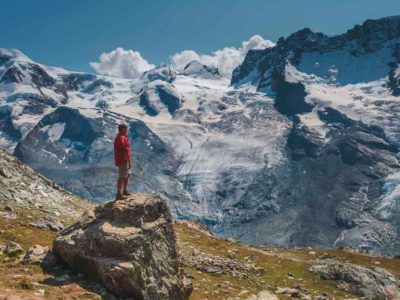
30 Beautiful and Best Hikes in the World
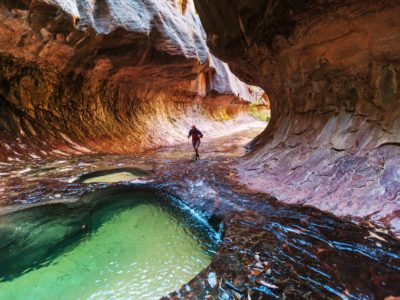
24 Best Hikes in the USA to Add to Your Bucket list
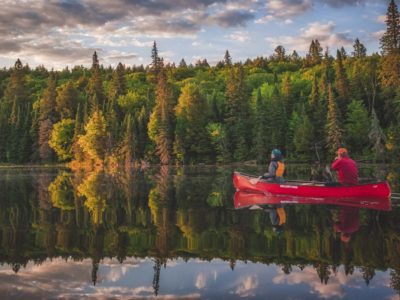
Weekend Warriors – 14 Awesome Hobbies to Turn You Into an Adventurer
About The Planet D
Dave Bouskill and Debra Corbeil are the owners and founders of The Planet D. After traveling to 115 countries, on all 7 continents over the past 13 years they have become one of the foremost experts in travel. Being recognized as top travel bloggers and influencers by the likes of Forbes Magazine , the Society of American Travel Writers and USA Today has allowed them to become leaders in their field.
Join thousands of others who get our monthly updates!
Leave a comment cancel reply.
Save my name, email, and website in this browser for the next time I comment.
53 thoughts on “Everest Base Camp Trek – Ultimate Guide For 2024”
Beautiful article! You have shared a thrilling journey with us till the end. It will definitely be useful for us trekkers. Thanks for the great pictures, videos, and useful tips!
This is a fantastic and unique post! After reading it, I learned a lot about Basecamp that I didn’t know before. Excellent article! That is true adventure, and conquering Mount Everest is without a doubt the goal of all hikers around the world. Keep up the excellent work. Thank you for providing this information.
Wow, the content has got all the details about the trek. Thank you so much for sharing your Journey experience of Everest Base Camp Nepal.
Hi There, Great Article! That’s the real adventure and especially climbing Mount Everest is the dream for all hikers across the globe without any doubt. Keep up the good work. Thanks for sharing.
Wow, the content has got all the details about the trek. Thank You so much for writing such an efficient article on Everest Base Camp Trek.
That’s the real adventure and especially climbing Mount Everest is the dream for all hikers across the globe without any doubt.
Thank you for taking the time and effort to produce such an awesome post with amazing pictures. Loved reading all your posts, really good insights here into Everest Base Camp ! Looking forward to read more.
Nice article on trekking best of luck for your new journeys
Dear Dave and Deb Namaste It is really beautiful article regards of Everest base camp trek in Nepal. Your article provides a lot details of the EBC trek. I’m sure your blog helping lot to organize other trekkers.
Excellent article. Everest Base camp is in my bucket list but I haven’t attempted because I’m prone to sickness quickly. Reading this article has triggered the interest even more. Thank you so much for explaining in detail about EBC trek. I hope One day I too can share my experience 🙂
Hey, I love trekking, I went last month with my friends in Nepal after reading your blog the memory are refreshed Thank you for sharing
Namaste, Dave and Dave, Thank you so much for sharing your Journey experience of Everest Base Camp Nepal. And also glad to read that why not support the local economy by hiring a guide and porter… I salute to your positive view. Visit Nepal anytime.
It is very interesting to read this Everest base camp trekking. I love trekking and i am excited very to do this base camp trekking once. Thanks for sharing.
This popped up in my inbox I love the way you break down your travel itinerary this way. I’m one of those people that love to know every detail of a place before travelling there myself. Another place to add to the list, thanks to you guys! Beautiful photographs.
Thank you for taking the time and effort to produce a terrific blog of your trek to EBC. I really appreciate being able to experience what it is going to be like before I actually arrive.
Everest is the highest mountain. It is at the Zenith. Most of the people just a dream of it.Very useful information. Thanks for sharing with us.
Excellent article !! Thanks for sharing such a great informative post it really helpful and amazing so keep it up and all the best………….
this was just amazing… keep sharing
The post was very informative. If you love adventure and treks you should definitely visit Nepal, it’s gonna be a life time experience. This post will really help people who are planning their next trek to Everest base camp. If you are planning your next trek to Nepal, North Nepal Trek can help you to make your trek much easier and will give you unique experience.
All of your photos are just awesome. Information is perfect.
Such an awesome post with amazing pictures. Thanks for sharing your experience with us.
This is really a very good blog post and thanks for sharing it with the community
It’s an informative post and I was thinking how you backpack for the weather? There are many things that somewhere can’t be cope at altitude like a sickness. I remember I scare when I attempt sky diving in Dubai. It’s was a wonderful experience but I have a fear of altitude places.
I have read about it but never tried. I am glad that at least i am reading such an informative article that clearly shows experience of treking over there. It might so much exciting and filled with happiness because seeing something like that would always be more of fun and achieving some of our own. Would love to try it once for sure!
Hi guys. Nice blog. Very informative. I just wonder, how did you prepare for the weather? How did you acclimatise so that you can cope with thr danger of altitude sickness? It is the ine thing that scares me to try to trek on high altitude places. To climb Kilimanjaro and to reach the EBC are in my bucket list. I’m hesitant because of my fear that I might die from cold temperature and altitude sickness.
Dress in layers, and drink plenty of water. You will want to bring DIamox with you and take it. You can get it in Kathmandu, or go to a travel clinic before leaving home. You won’t die from cold temperatures at Base Camp if you have a proper guide, and dress properly. The real dangers are if you are summitting Everest, that’s when you can get into problems, but Base Camp is very doable for anyone that is physically fit. If you don’t have the gear, you can buy winter coats, boots etc in Kathmandu. But we do recommend breaking in your boots beforehand, so you should buy those before you leave home and wear them a lot. Get warm, waterproof breathable boots with wool socks and bring several pairs. We have a guide to winter base layers to avoid the deep freeze here: https://theplanetd.com/layering-tips-for-cold-weather-travel/
Loved reading all your posts, some really good insights here into EBC! You mention putting your hair in braids, why is that? Is it because of the sweat? Is it windy so it gets knotted up? Just curious as I am doing this trek in a week and am open to all tips ?
Yes, hair can get really matted due to wind, dryness and lack of showering. The Braids kept it from matting up like dread locks. Have a great time!
Long hair can get very matted almost like dread locks. It’s becuase there aren’t a lot of chances to shower after Namche Baazar, the wind, sweat and dryness from altitude really takes its toll on both hair and skin and the braids, keep the hair from matting and breaking off.
Great read! Just curious. what time of year did you go to avoid the masses of tourists?
Thanks for sharing articles and videos it will be helpful to all people those wants to go Mount Everest.
This is just amazing and knowing each and every experience that we will have while travelling is another aspect that made me read this article fully. I am in Dubai now on a trip and would surely try to visit this place i could. I should consider the right time and other things roo. I must thank you for this wonderful piece.
Such a great journey you have shared from start to finish and your presentation is also impressive. I would love to follow these things when I will go for a camp tour.
Regards, Ronit
Your Video is superb, I feel your treking experience in this article. worth to read it.
Wow what an wonderful place is this. Want to trek this place in my life.
Great article, thanks, surprised at the early time of year you did the trek, but sounded ideal – any other good write-ups or links discussing the pros and cons of going in the spring vs fall? …weather, landscape, crowded w/ other trekkers, festivals, etc Thanks!
I am looking forward for this kind of base camp.
What an excellent post!! Thank you so much for an informative article and personal feel. This is very helpful and inspiring for my upcoming trek to Everest Base Camp.
There is so great view in pictures.it’s useful and helpful for the trekkers .i like these types of views .and tourist are also love these types of views.
Anyways amazing photos and love the videos! really gives you a feeling how it is there and must be just thrilling. Looking forward to read more about your travels.
Nice Articles and sharing a good details of Everest base camp and amazing photos. I will try to go this year Nepal and go to Everest Base Camp.
Great post. I am doing the Everest Base Camp trek in October. I completed the Annapurna Circuit in 2012 and loved it. Nepal is a such a lovely place and the people are amazing. Thanks for sharing!
Wow congratulations on your trip and everything looks really cool. I would love to do the same! Did you train a lot before you went there? Did you prepare physically? I don’t know how fit I have to be to be able to take on such a travel. Anyways amazing photos and love the videos! really gives you a feeling how it is there and must be just thrilling. Looking forward to read more about your travels.
Hi Marus, we didnt’ train a lot before. We were traveling a lot though. Before heading to Nepal we spent 4 months traveling Sri Lanka and India. We did a yoga retreat and a lot of hiking and walking, but we didn’t do any proper training. We were in relatively good shape. It’s mostly just a long uphill hike. The difficulty is being at altitude for a sustained amount of time. It affects everyone differently. Some people can be in tip top shape, but not do well at altitude and vice versa. So, it’s best to take it slow and steady, drink plenty of fluids and pay attention to how you are feeling.
All your photos are simple awesome and your posts are speaking a lot of useful information. Thank you for sharing this article.
Thanks for your beautiful video. I fell a little up lifted seeing this. I believe one of the prayer flags is for a lady I knew. Inspiring. I wish I would have done adventurous things like this when I was young. Young people don’t put off adventure.
I’m glad I read this. This is something I have always wanted to do but have been a little nervous to think about doing it when the climbing season is in full swing. The time of year you went and the company you chose make a lot of sense! Thanks for sharing.
The views are amazing!! I love adventure, but I would definitely need to build up my stamina to do the Everest Base Camp trek. It looks like it was an awesome experience for you!
Wow, what a beautiful experience. Your photos are amazing!
-Siggi The Voyaging Viking
Amazing! Can’t wait to check this off my list!
Thanks for writing this.
Thank you for sharing these helpful tips. Your post has given me some great ideas. Thanks again for the valuable information!
Himalayan Magazine
A comprehensive guide to everest base camp trek (ebc).
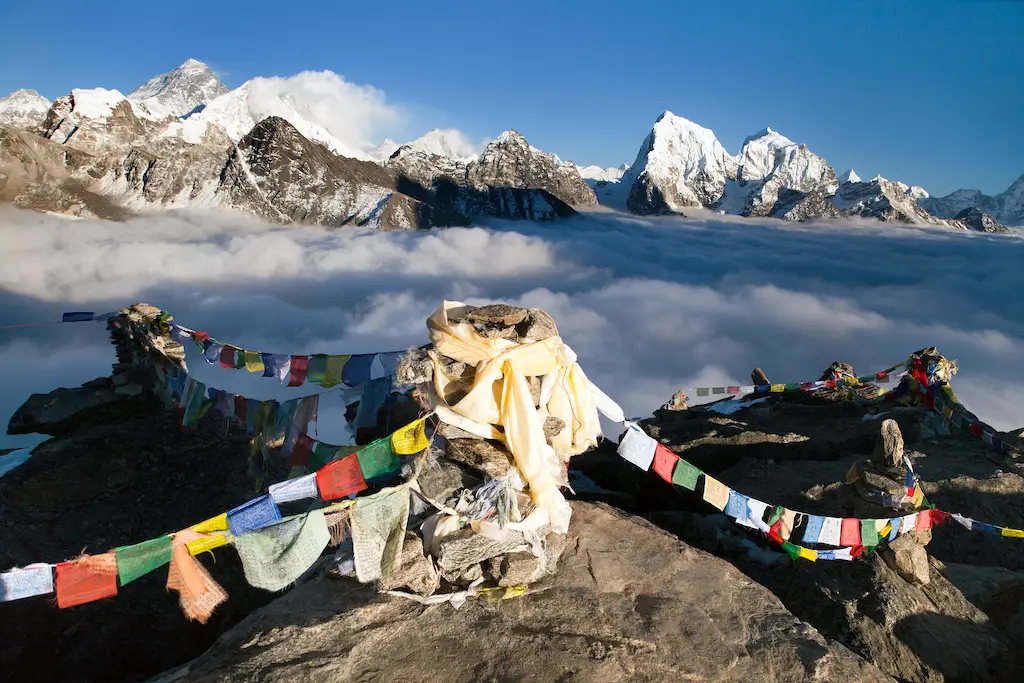
Are you looking to trek to the base camp of the highest mountain in the world, Mount Everest? This Essential Guide to Everest Base Camp Trek has got you covered! This guide provides extensive information on preparation, planning, and packing for the trek and first-hand accounts of the journey. It also covers important topics such as altitude sickness, acclimatisation, the Sherpa culture, and the significance of preserving the environment. This guide is the perfect resource for anyone eager to take on this incredible adventure.
Everest Base Camp (EBC) trekking routes
Elevation and altitude, best time to trek everest base camp (ebc), is the everest base camp (ebc) trek difficult, itinerary for everest base camp trek, understand the risks associated with high-altitude trekking, checklist of essential trekking items, looking for trekking gear and rental shops, get advice from experienced trekkers, stay up-to-date with the latest weather forecast from everest base camp, how to find a reliable guide and porter service for everest base camp (ebc), costs for nepal government trekking permit, rules for trekking in the everest region, acclimate to the altitude before beginning the trek, importance of hydration and nutrition on the everest base camp (ebc) trek, culture and traditions, have a plan for emergencies, is travel insurance necessary for ebc trek.
Everest Base Camp Trek is a popular trekking route in Nepal, offering stunning views of the Himalayan mountains. The trail follows the traditional path taken by climbers attempting to summit Everest, starting from Lukla and ending at the Everest Base Camp. The route takes you to one of the most iconic landmarks in the world – the base camp of Mount Everest, the highest mountain in the world.
Everest Base Camp (EBC) Trek duration
The trek is often done over around 12-15 days and covers a distance of approximately 100km. The route takes you through some of the most stunning mountain scenery in the world, with spectacular views of the surrounding snow-capped peaks. The trek starts in Lukla, a small village in the Khumbu region. Along the way, you will pass through Sherpa villages, traditional monasteries, and lush forests.
The trek to Everest Base Camp takes place in the Khumbu region of Nepal and reaches an altitude of 5,364m (17,600ft). The areas surrounding the hike have elevations ranging from 2,844m to 5,545m (9,330ft to 18,150ft).
For the best trekking experience at Everest Base Camp, planning your trip between late March to May or September to December is recommended. Among these months, April and May are particularly favoured as the weather is pleasant, and the rhododendron forests are in full bloom, offering a stunning view. During these months, clear skies are typical, providing an unobstructed view of the world’s highest mountain peak.
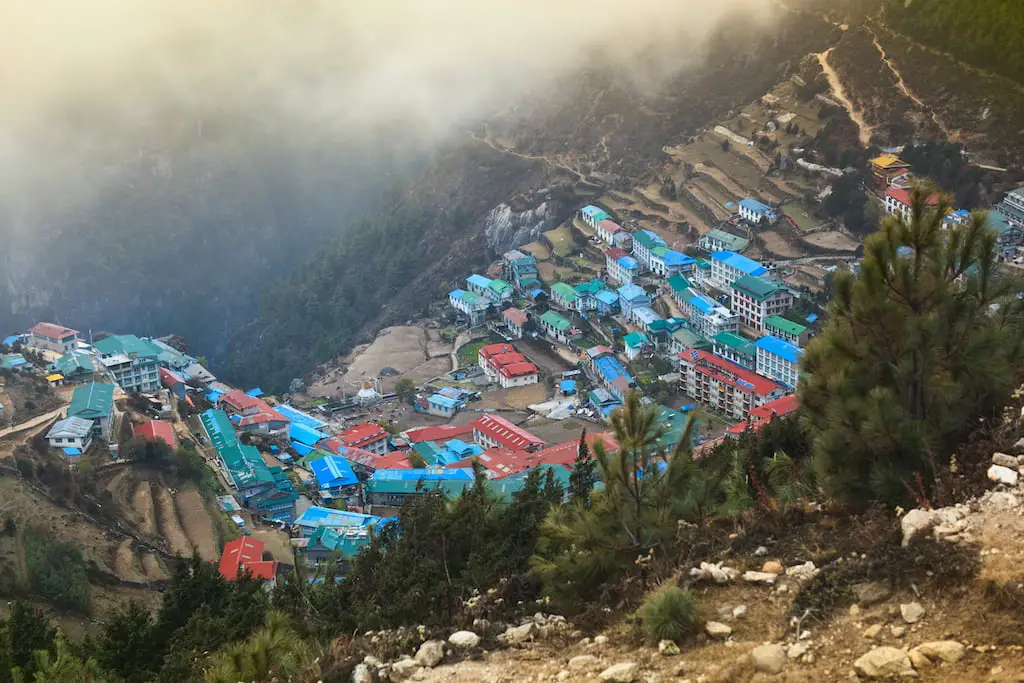
The Everest Base Camp Trek is generally considered a moderately difficult trek. While it does require a certain level of fitness and endurance, it is a very achievable goal for most people. The terrain is often steep and uneven, and the altitude can be challenging, so taking your time and pacing yourself is important. If you have prior experience in trekking with a heavy backpack over long distances, the trek should be easy with proper acclimatisation. However, if you are a beginner trekker, you will need to train extensively for this journey, as it will likely be quite difficult.
- Day 1 : Arrive in Kathmandu and transfer to your hotel. Spend the day relaxing and exploring the city.
- Day 2 : Fly from Kathmandu to Lukla and start the trek to Phakding.
- Day 3 : Trek from Phakding to Namche Bazaar.
- Day 4 : Acclimatisation day in Namche Bazaar.
- Day 5 : Trek from Namche Bazaar to Tengboche.
- Day 6 : Trek from Tengboche to Dingboche.
- Day 7 : Acclimatisation day in Dingboche.
- Day 8 : Trek from Dingboche to Lobuche.
- Day 9 : Trek from Lobuche to Gorak Shep.
- Day 10 : Trek to Everest Base Camp and back to Gorak Shep.
- Day 11 : Trek from GorakShep to Kala Patthar and back to Lobuche.
- Day 12 : Trek from Lobuche to Pheriche.
- Day 13 : Trek from Pheriche to Namche Bazaar.
- Day 14 : Trek from Namche Bazaar to Lukla.
- Day 15 : Fly from Lukla
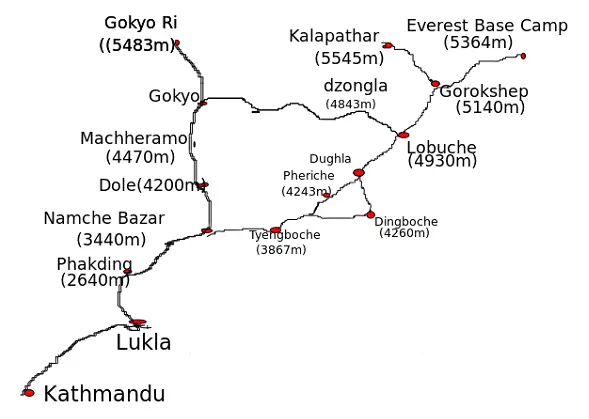
High-altitude trekking can be a thrilling experience, but it carries a certain risk. The primary risks associated with high-altitude trekking are altitude sickness, hypothermia, and the danger of falling due to slippery surfaces or steep slopes. Trekkers may also be exposed to extreme weather conditions, such as heavy snow, high winds, and lightning.
Altitude sickness is a real risk as trekkers ascend to higher and higher elevations. Symptoms of altitude sickness can include headache, nausea, fatigue, and difficulty sleeping. It is essential to be aware of these symptoms and to take precautions to avoid them.
Hypothermia is another risk when trekking at high altitudes. Hypothermia can occur when the body cannot maintain its temperature in a cold environment. Trekkers should wear layers and carry a sleeping bag to avoid hypothermia.
High-altitude trekking can be an incredible adventure, but it is essential to be aware of the risks associated. Finally, there is the risk of falling when trekking in areas with steep slopes or slippery surfaces. Trekkers should be aware of their surroundings and wear appropriate shoes for the terrain.
- Clothing : Appropriate clothing for the cold weather is essential. This includes multiple layers of synthetic or wool thermal base layers, fleece and insulated jackets, waterproof/breathable outer layers, waterproof pants, hats, gloves, and a good pair of warm boots.
- Backpack : Choose a lightweight and comfortable backpack of 40-50L capacity which will easily fit all your items.
- Sleeping bag : You need a high-quality sleeping bag rated to -20 degrees Celsius.
- Water : Water bottles, filters, and purification tablets are essential to stay hydrated.
- Food : High-energy snacks such as nuts, dried fruits, energy bars, and chocolate are ideal. You can also bring freeze-dried meals.
- Trekking poles : These will help you keep your balance during the trek. 7. First-aid kit: A basic first-aid kit with essential medication and items such as bandages and antiseptic cream.
- Sunscreen and sunglasses: Sun protection is essential for high-altitude trekking.
- Toiletries : Toothbrush, toothpaste, hand sanitiser, soap, and toilet paper

If you forget any of the essentials mentioned above, don’t panic! You can easily find them in larger cities like Kathmandu and Pokhara, which are filled with shops and outlets dedicated solely to trekking supplies. However, check the prices of the items you’re purchasing, as they may vary from shop to shop. You can also rent trekking gear from hire shops; the equipment is usually in good condition. While you can rent trekking shoes, it’s not recommended, as they need to be broken in and tailored to the individual’s feet for maximum comfort.
Many experienced trekkers and adventure travellers are willing to share their experiences and advice. The best way to get advice from experienced trekkers for trekking Everest Base Camp Trek is by joining trekking forums or asking questions on social media platforms such as Facebook and Instagram. You can also find and join trekking groups on social media that focus on Everest Base Camp Trek and connect with other trekkers who have already been on the trek. Additionally, numerous websites, blogs, and articles are written by experienced trekkers with advice and tips for Everest Base Camp Trek.
The weather at Everest Base Camp is quite varied and can change drastically from day to day. Temperatures typically range from -20°C to 10°C (14°F to 50°F). The highest temperatures usually occur in the summer months of May, June and July, while the coldest temperatures occur in December, January and February. The area is known for its strong winds, which can often reach speeds up to 90 km/h (56 mph). The wind chill factor can make temperatures feel much colder than they are.
Due to its high elevation, the area is prone to heavy snowfall. The snow can be quite deep and reach over 2 meters (6 feet) in some areas. Snow can fall as early as September and continue until April. The area is also prone to thunderstorms, especially during the summer months. Lightning can be a significant hazard, and hikers should be aware of the increased risk of an electrical storm.
The weather conditions at Everest Base Camp are highly unpredictable, often preventing climbers from reaching the summit. Being well-prepared for adverse weather conditions is crucial when exploring this area. You can download a weather app to stay updated on the latest weather forecast.
- Search online for reviews from past guides and Porter services customers. Read through the reviews to get a sense of the quality and reliability of the service.
- Ask for recommendations from friends, family and other trekkers who have completed Everest Base Camp Trek. That includes joining forums and social media groups, especially for the EBC trek.
- Speak to the guide and porter service directly. Ask questions about their experience, qualifications, and safety protocols.
- Compare the costs and services offered by different guide and porter services.
- Check that your guide and porter service is licensed and insured.
- Make sure the guide and porter service you choose is familiar with the route and can provide you with maps, itineraries and other resources.
The Nepal government requires trekkers to obtain a permit to visit the Everest Base Camp. The permit fees vary depending on the route taken and the duration of the trek. Everyone who goes high-altitude trekking in Nepal must purchase specific permits to enter the trek routes. These are:
- An entry permit into the relevant national park or conservation area When visiting any of Nepal’s national parks, there is a one-time entrance fee of approximately $25, regardless of the duration of your stay. The Everest Base Camp trek lies inside the Sagarmatha National Park.
- A Trekking Information Management System (TIMS) card If you plan to trek to Everest Base Camp, know that you need a Trekking Information Management System (TIMS) card. This is a mandatory requirement aimed at regulating the trekking industry and ensuring the safety of trekkers. The cost of obtaining the card is around $20 for solo travellers and $10 for those in a group.
- Rural municipality trekking permits Some municipalities charge trekkers an additional fee. Those trekking to Everest Base Camp must purchase the Khumbu Rural Municipality Permit for around $20.
All trekkers must register with a trekking agency and obtain the necessary permits before beginning their trek.
- Trekkers must also hire a guide and/or porter to accompany them and provide assistance while trekking.
- Trekking parties must not exceed ten people.
- Trekkers are not allowed to camp near villages and must stay in designated camping areas.
- Trekkers must respect the local culture, customs, and environment.
- Trekkers must carry their own trash and dispose of it properly.
Starting in April, all foreign trekkers must have a licensed guide, whether alone or with a group. The Nepal Tourism Board (NTB) announced this in early March, and this rule applies to cyclists and hikers. To obtain a guide, visitors must contact trekking agencies registered with Taan (Trekking Agencies Association of Nepal). There are over 2,000 government-approved trekking and mountaineering guiding companies.
Although the Trekking Agencies Association of Nepal (TAAN) has announced a rule for needing a mandatory guide, there are no apparent signs of its implementation on some trekking routes.
- The trek is physically demanding and requires a good fitness level. So keep yourself fit.
- Give yourself plenty of time to adjust. Before hiking, taking at least 1-2 days at the same altitude is recommended. If more time is needed, it is best to take it.
- Take it easy. Avoid overexertion and try not to push yourself too hard. 4. Stay hydrated. Drink plenty of water and electrolyte drinks to help your body adjust.
- Eat light meals that are high in carbohydrates.
- Get plenty of rest. Give your body time to adjust to get used to the altitude.
- Take breaks. If you feel short of breath, stop and rest for a few minutes before continuing.
- Use oxygen if available. If available, use supplemental oxygen to help your body adjust.
The Everest Base Camp Trek is a challenging trek that requires excellent physical and mental stamina. Staying hydrated and well-nourished while on the trek is essential to ensure your body can cope with the high altitude and strenuous trekking conditions.
Hydration is essential for maintaining energy levels, preventing altitude sickness and keeping your body functioning optimally. Staying hydrated throughout the trek ensures your body has sufficient water to sustain itself. This can be done by drinking plenty of fluids and eating water-rich foods like fruits and vegetables.
Nutrition is also important for the Everest Base Camp Trek. Eating the right foods can provide the body with the energy and nutrients it needs to cope with the rigours of the trek. Eating a balanced diet rich in carbohydrates, proteins, fats, and vitamins will help keep your energy levels up and your body well-nourished. It is also important to stay hydrated while eating to ensure that the body can absorb the nutrients from the food.
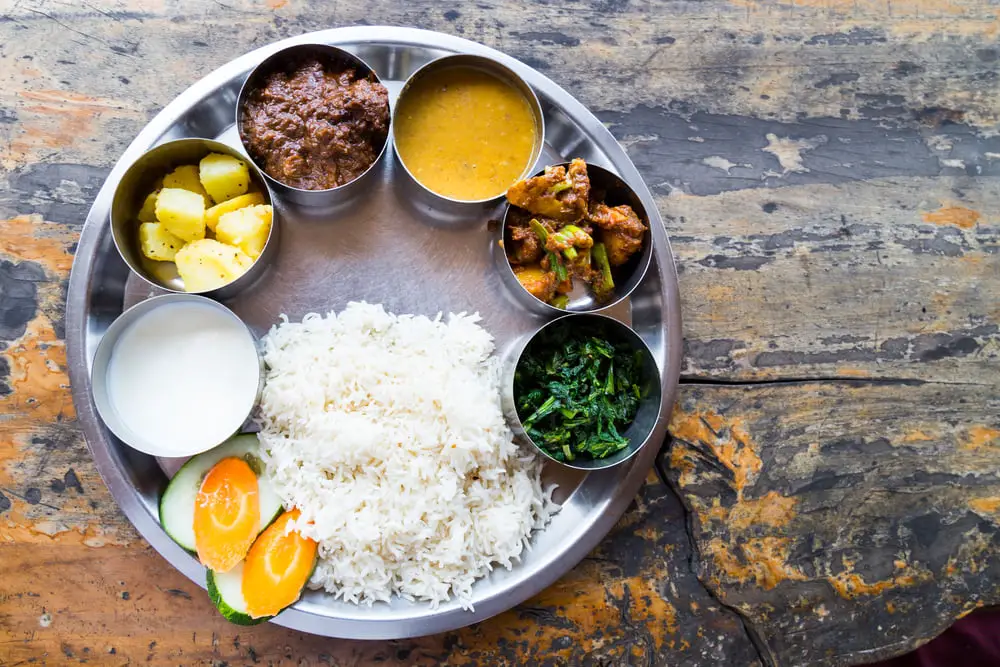
The people of the Everest region have a unique and vibrant culture shaped by the landscape and environment surrounding them. This culture is based on a shared belief in the power of nature, spiritual and religious practices, a strong sense of community and respect for their elders.
The core of the culture of the Everest region is based around the Sherpa people, a Tibetan ethnic group who live in the area and have been living there for centuries. They are typically Buddhist, and their cultures and traditions are based on this religion and their traditional beliefs in the power of nature and the spiritual world.
The Sherpa people are renowned for their strong sense of community and willingness to help those in need. This is reflected in how they build their homes, which multiple families often share. They also have a strong sense of hospitality and often invite travellers into their homes to share their stories and culture.
The Sherpa people are also well known for their incredible mountaineering skills. This is primarily because they have lived in the area for centuries and understand the terrain and elements better than anyone else. They are often hired as guides and porters for those attempting to climb Mount Everest.
An emergency plan for trekking to Everest Base Camp must be in place before the trek begins. The plan should include:
- A list of emergency contact numbers, such as local police and rescue teams and any nearby medical facilities.
- A map of the area.
- A plan of action in the event of an emergency.
- A mobile phone with enough credit throughout the trek.
It’s essential to have an emergency plan when going on a trek, including evacuation routes and a plan for medical care. The plan should be reviewed and discussed before the trek, and all trekkers should be familiar with it so they know what to do in an emergency. The guide will brief all trekkers on how to respond in an emergency.
The mountainous terrain of the Himalayas poses many risks, and without adequate insurance, you could be left exposed in the event of an accident or illness.
When considering travel insurance for the Everest Base Camp Trek, look for a policy that covers you for the following:
- Medical coverage : This is the most crucial element of any travel insurance policy; make sure that the policy covers evacuation and air ambulance costs if you need to be taken to a hospital in a different country.
- Trip cancellation : To ensure you’re prepared for unexpected events that may prevent you from travelling, it’s essential to have coverage for trip cancellation. Seek out a policy that provides full reimbursement for your trip’s cost if you cannot go.
- Trip interruption : This covers you if you have to cut short your trip due to an unexpected illness or injury. Again, look for a policy that offers reimbursement of up to the full cost of the trip.
- Baggage and personal items : Make sure your policy covers the cost of any lost or damaged baggage and personal items.
- Adventure activities : If you plan to participate in any adventure activities, such as paragliding or rafting, ensure that your policy covers these activities.
Finally, ensure that you read the policy documents carefully to understand what is and is not covered. The last thing you want is to be left exposed in the event of an accident or illness.
The trek commences in Lukla, where trekkers can buy supplies and meet their guides at the local market. The journey takes hikers through Namche Bazaar, Tengboche Monastery, and the highest village in the world, Gorakshep. Along the way, trekkers can enjoy stunning mountain views, explore the local culture, and experience the thrill of reaching the highest point on earth. After reaching the Everest Base Camp, trekkers can hike to Kala Patthar, a peak that offers a spectacular view of the world’s tallest mountain.
The Everest Base Camp trek is a popular adventure for trekkers worldwide. It’s a challenging but rewarding two-week hike through the breathtaking Himalayan Mountains, with an elevation of over 5,000 meters.
Sign up to receive content in your inbox.
Check your inbox or spam folder to confirm your subscription.
Leave a Reply Cancel reply
Your email address will not be published. Required fields are marked *
Save my name, email, and website in this browser for the next time I comment.
Recent Posts
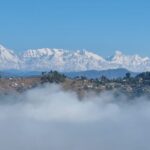
- Destination 39
- Lifestyle 4
- People And Culture 13
- Technology 3
- Travel Blogs 20
2022 ANCA Annapurna Conservation Area Annapurna Region Antelope Api Nampa Conservation Area Bardiya National Park Bhutan Blackbuck Caterpillar fungus China Conservation Areas Culture Gaurishankar Conservation Area Gurung Himalayas Honey hunting India Kanchenjunga Conservation Area Kathmandu Krishnasar Conservation Area Manaslu Conservation Area Mount Everest Nepal People Pokhara Travel Trekking Uttarakhand Viagra


Everest Base Camp Trek – 13 Things to Know for Your Trip in 2024

Just a mention of the Everest Base Camp Trek (EBC) in Nepal is usually enough to stir the soul of hikers all over the world. Thousands of aspirational ramblers have gained valuable experience on this Himalayan route. Some see this hike as a rite of passage for all true trekkers. Others go on this trek because it’s a ticket to the soaring roof of the world, where an up-close encounter with the highest summit of all awaits. The Everest Base Camp in Nepal itself sits at an impressive 17,598 feet (5,364m) high, but more on its impressive heights later on.
Whatever your reason for wanting to strike the Everest Base Camp Trek from the bucket list this year or the next, this guide can help in your pursuit. It will run through all the basics of this iconic trekking route between Namche Bazaar and EBC in Nepal, detailing the best time of year to go, what sort of challenges can be expected along the way, what trekking gear you’ll need on such a trip, and so much more. Find answers to the most frequently asked EBC Trek questions here. Dive in!
Our experience on the Everest Base Camp Trek
Like many, we began offering the trek to Everest Base Camp largely because of its reputation as one of the most extraordinary adventures on the planet. As soon as our team set foot on this legendary path we could instantly see why it was the case. Travelers of all stripes, all nationalities, join together on this true Himalayan adventure. The EBC Trek has the feel of a true expedition as you fly into the small airport at Lukla and take your first steps on the wooded trail towards the small village of Namche Bazaar.
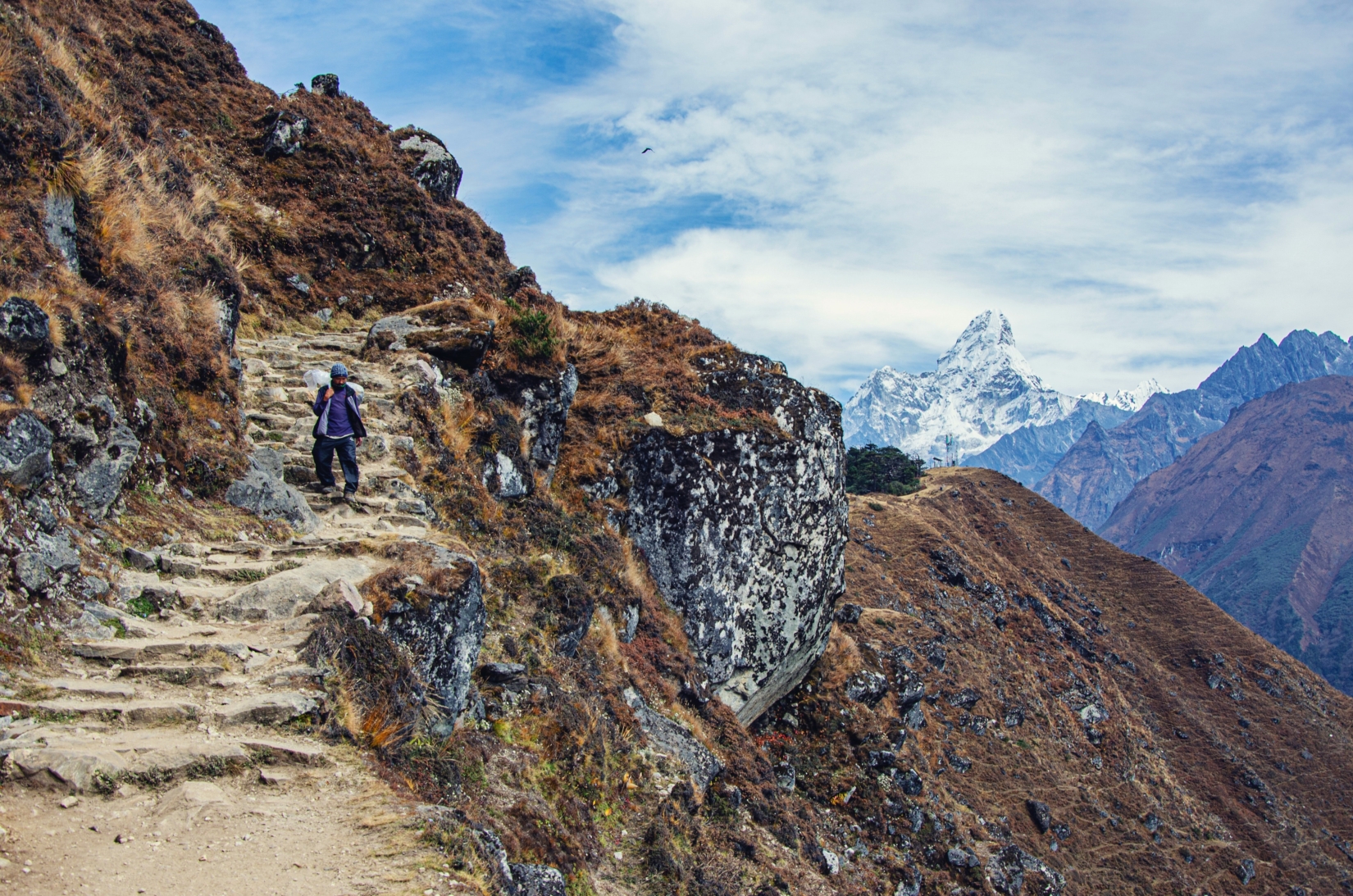
For me, Nepal is unlike any country I have visited. On my visit to this culturally rich and diverse nation I felt like I had entered into a new world. With the influences of both Buddhism and Hindi, the capital city of Kathmandu provides a window into the beautiful culture and history of the Nepalese people and bags you to explore more of this remarkable country.
What’s in this guide?
- Where is Everest Base Camp (EBC)?
- History of Everest Base Camp
- How long is the trek to EBC?
- Is it worth it? Things to see & costs
- How hard is the trek? Terrain, elevation, and altitude
- Food on the Everest Base Camp Trek
- Accommodations on Everest Base Camp
- When’s the best time to go? Temperatures & weather
- What gear and equipment should I pack?
- Should I use a porter service?
- Getting there
- Travel visas and permits
- A typical Everest Base Camp Trek itinerary
1. Where is Everest Base Camp (EBC)?
There are actually two base camps for Everest trekking: the North Base Camp in Tibet and the South Base Camp in Nepal. The Nepalese camp in the Khumbu region is the Everest Base Camp that most people talk about, and the endpoint of this legendary trek. It’s tucked away at the end of a long valley that carves through the Himalayas after splitting at the Sherpa village of Dingboche. The formidable Khumbu Icefall – the first obstacle for those attempting a summit push to Everest – begins right on the doorstep of the camp, leading up to the Western Cwm (also known as the Valley of Silence) and the peaks of Lhotse and Nuptse.
2. History of Everest Base Camp
Climbing on Mount Everest started at the beginning of the 1920s, when a team led by George Mallory (who some think may well have been the first person to reach the summit) came to map out the north face. However, Mallory and his team never established a permanent base camp on their trips, and the north route was all but shut when China invaded Tibet in 1949.
Then came the conquering expedition of Edmund Hillary and Tenzing Norgay . It took place on the south slopes in Nepal. Hillary and Norgay realized it made more sense to have a place to store supplies at the base of the mountain rather than trek the whole length of the Khumbu Valley whenever they needed gear. Thus, Everest Base Camp was born.
3. How long is the trek to EBC?
The Everest Base Camp Trek may be the single most famous trek in Asia, and arguably the world. Some say its booming popularity is the trek’s own worst enemy, and it’s true that the trail has suffered from overcrowding and some pollution in recent years. However, nothing can take away from the thrilling sense of adventure that comes with climbing towards the edge of the world’s highest peak. That reaches a fever pitch in the early days of your hike, when you’ll catch a jaw-dropping broadside of Mount Everest from a lookout on the south side of Ama Dablam.

Distance
The rewards of the trek don’t come so easily. EBC is a high-altitude path that requires considerable acclimatization over a good distance. You’ll typically need 12-14 days of full-on trekking (that’s right, your “rest days” involve walking too!) to complete the 80-mile (130km) roundtrip that starts from Lukla.
This distance is roughly divided into individual daily sections of 8-10 miles (13-16km), but the reason the whole adventure takes so many days is because it needs to be broken down into bite-sized chunks due to the altitude with acclimatization and rest days mixed in. Most itineraries will leave enough time to complete each leg on any given day at well below the average trekking pace.
Walking times
Most walkers find that they hike a maximum of 8 hours each day, though that can go up a little when you reach the higher altitude sections of the route – not just because of the physical challenge, but because you’ll be stopping often to take in all the breathtaking views!
4. Is it worth it? Everest Base Camp trip highlights & costs
The joy is in the journey here, as you trek further up to gaze from the roof of the world. Some of the best sightings of the famous Everest arguably come during the Everest Base Camp Trek itself, from various lookout points along the way. These magnificent views combined with mystical monasteries and Sherpa villages offer a host of intriguing trip attractions en route. For me, the best highlights of the trek are:
- Kala Patthar (Kalapathar) – Roughly translates to “Black Rock”. Detour to this soaring lookout point that’s 18,208 feet (5,550m) up on the ridges above Gorak Shep . It’s a real challenge (think a 1,640-feet / 500-meter ascent in 2 hours) but is hailed by many as the best view over Everest, with the Khumbu Icefall crashing through the valley below.

- Gorak Shep (Gorakshep) – A settlement that seems at the end of the world, this tiny town is the heartland of the Sherpa people and sits at the base of Kala Patthar.
- Sagarmatha National Park Museum – You’ll encounter this one very early on in the trek during your rest day in Namche Bazaar. It’s worth the climb to its perch above the village, mainly because the forecourt has incredible views of Everest and Nuptse – your first glimpse of the great mountain. Inside, you can learn all about the unique culture of the Khumbu Sherpa people .
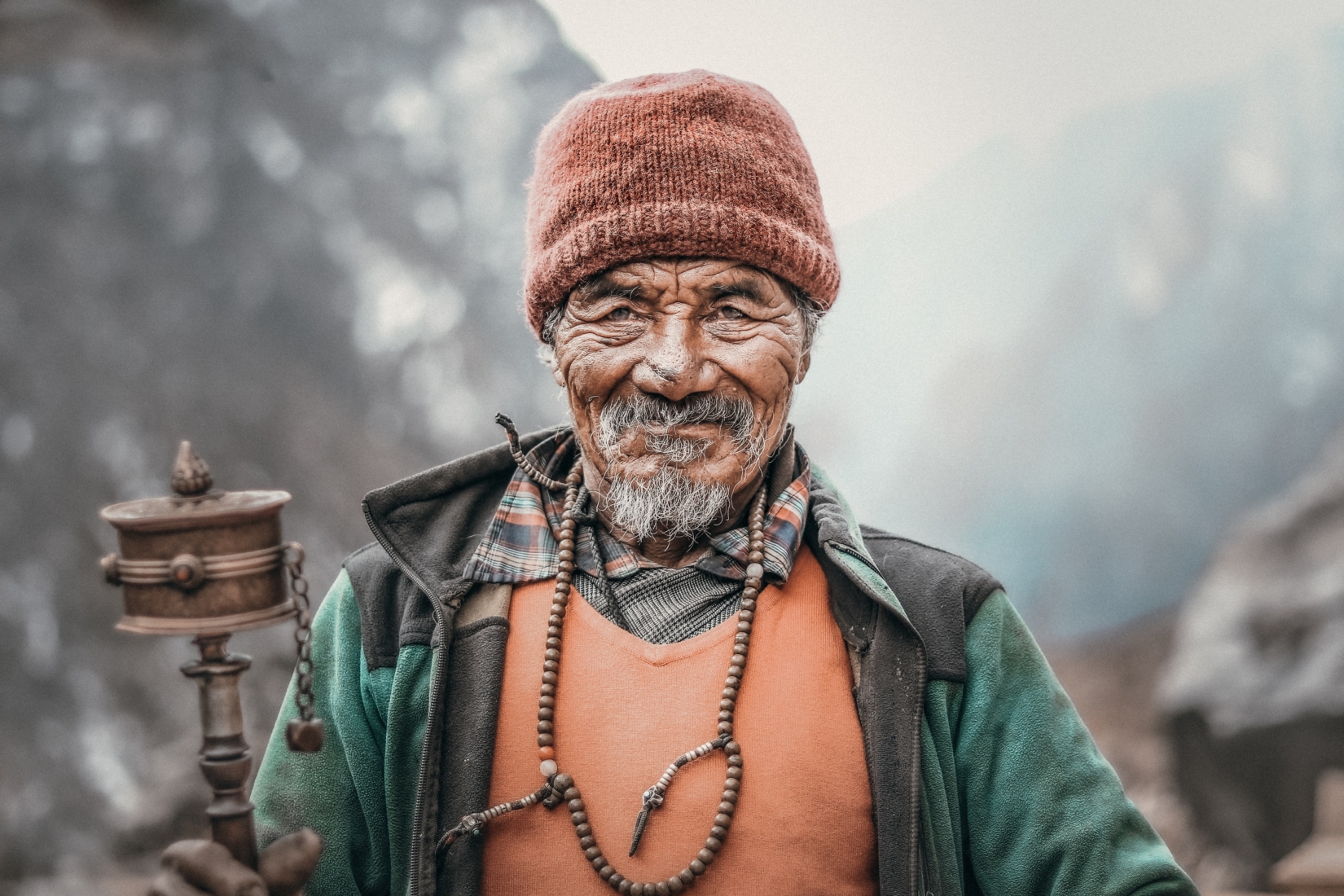
- Tengboche Monastery (Thyangboche Monastery or Dawa Choling Gompa) – The largest Buddhist gompa in the valley of Everest, Tengboche Monastery is a pitstop for determined trekkers bound for the summit. They come to light candles and ask for blessings.
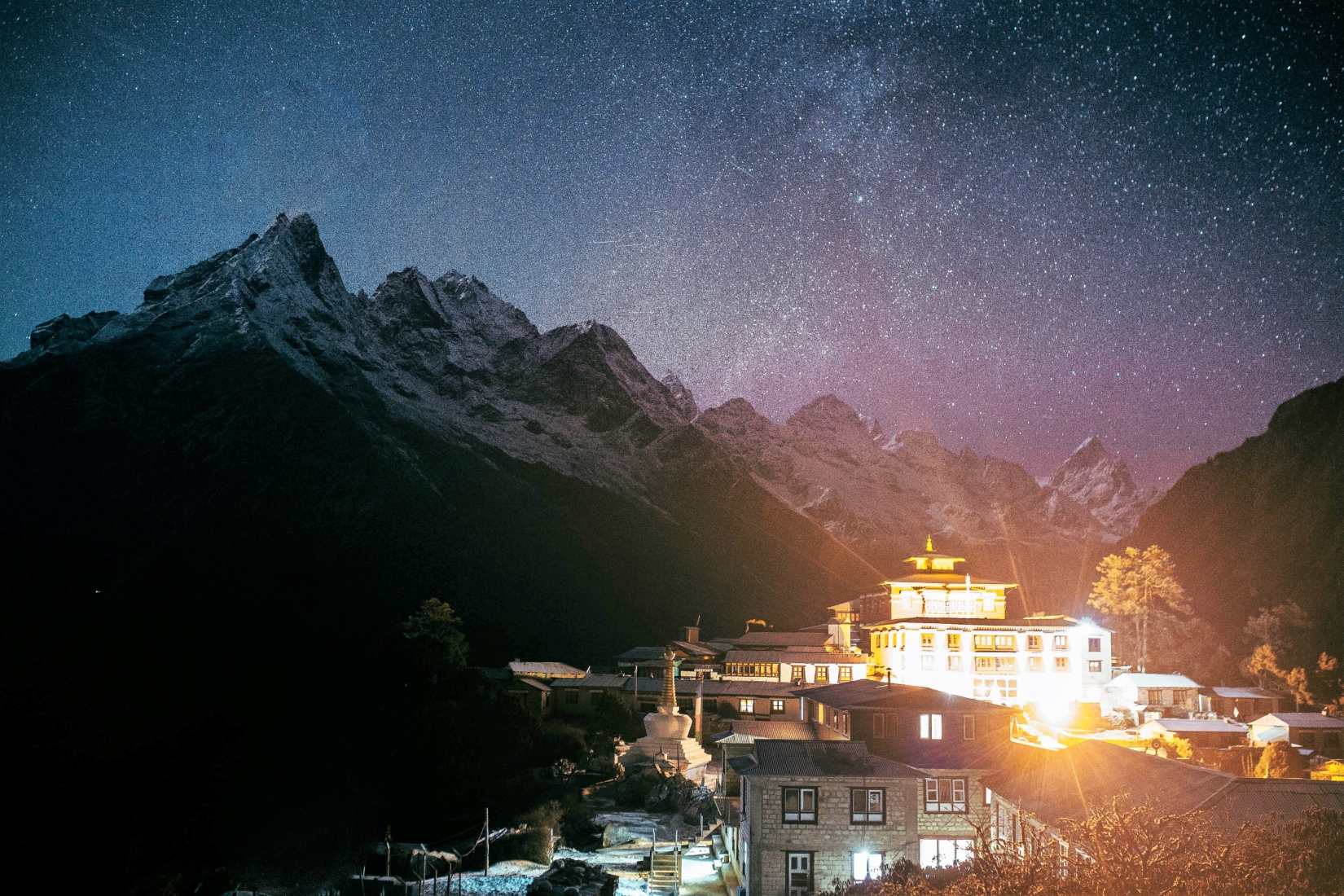
- Nangkar Tsang / Dingboche Viewpoint – Above the town of Dingboche, this detour off the main route is good acclimatization trekking and offers a panorama that takes in the Khumbu Glacier and the whole Imja Khola Valley.
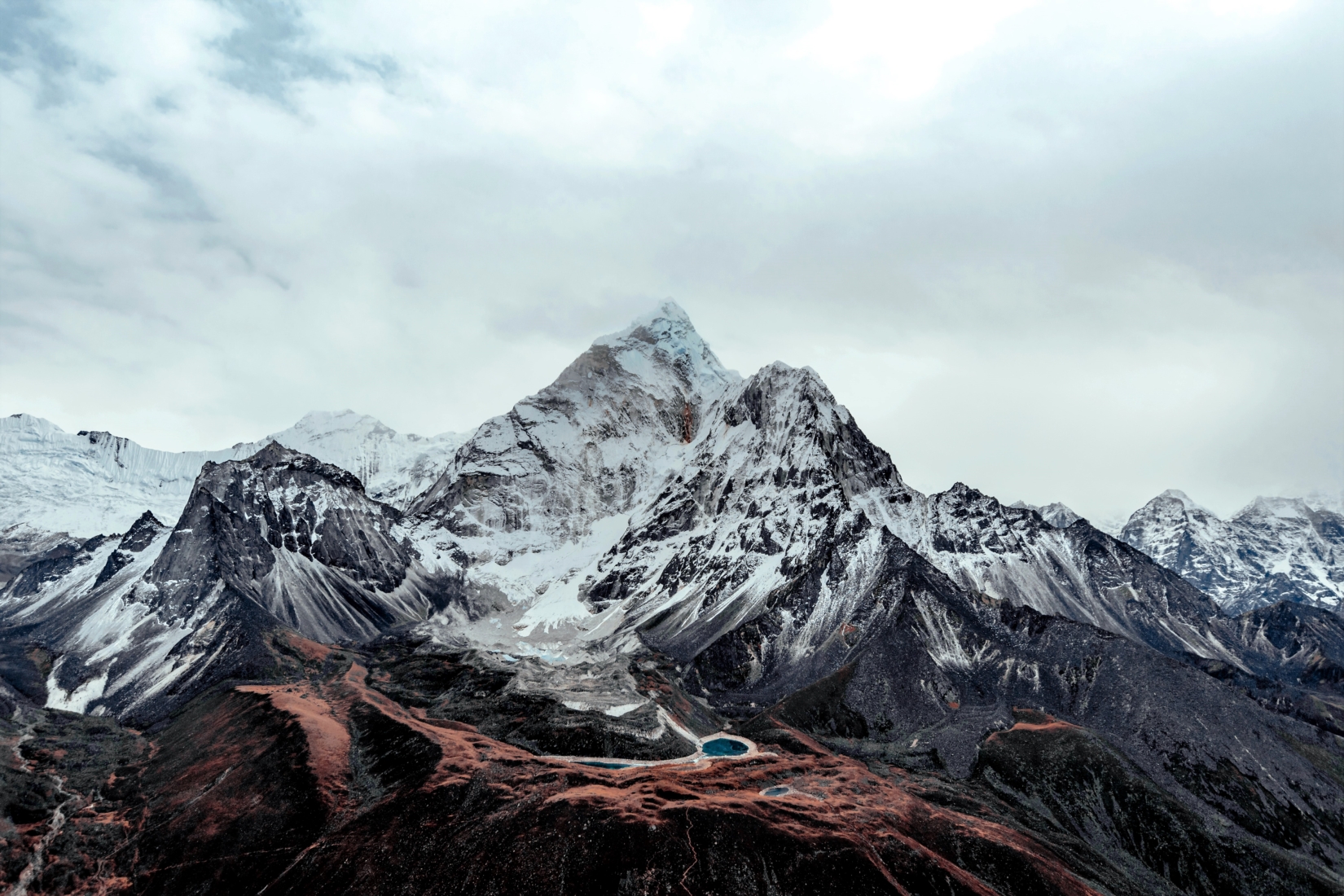
With so much natural beauty to be experienced, how much will it set you back? When it comes to pricing, costs of the Everest Base Camp Trek can range widely but the best all-inclusive tour packages start at around US$4,295 (including domestic flights to/from the trek start point) . If this number is giving you sticker shock, don’t let it deter you from the trip of a lifetime to Nepal, because my team at The Explorer’s Passage is always here to work with you and your preferences to craft a trip that fits your needs .
5. How hard is the trek? Terrain, elevation, and altitude
So just how difficult is the trek to Everest Base Camp? To answer this, you’ll have to consider the terrain and heights of EBC. Your physical fitness also plays a factor in the perceived difficulty of this adventure. Based on our Trip Activity Level Guide , we classify this trek as an advanced level, but you may be glad to know that no technical training or mountaineering experience is required.
Not sure if this Himalayan adventure is right for you? Contact us and we’ll walk you through details on the physical demands, recommended training, and more so you can make an informed decision.
The Everest Base Camp hike graduates from the alpine surroundings at the south end of the Sagarmatha National Park to the scree-covered ridges of ancient moraines in the final push towards the trekking finish line. The first sections are easier in terms of terrain but more difficult because they are constantly steep. You’ll notice this in the ascent from Lukla to Namche Bazaar, and then again from Namche Bazaar to Tengboche. The path there is largely shaded by pine and ironwood forests, muddy when wet but also interspersed with rocks wedged into the ground. You’ll stroll across suspension bridges to cross most rivers.
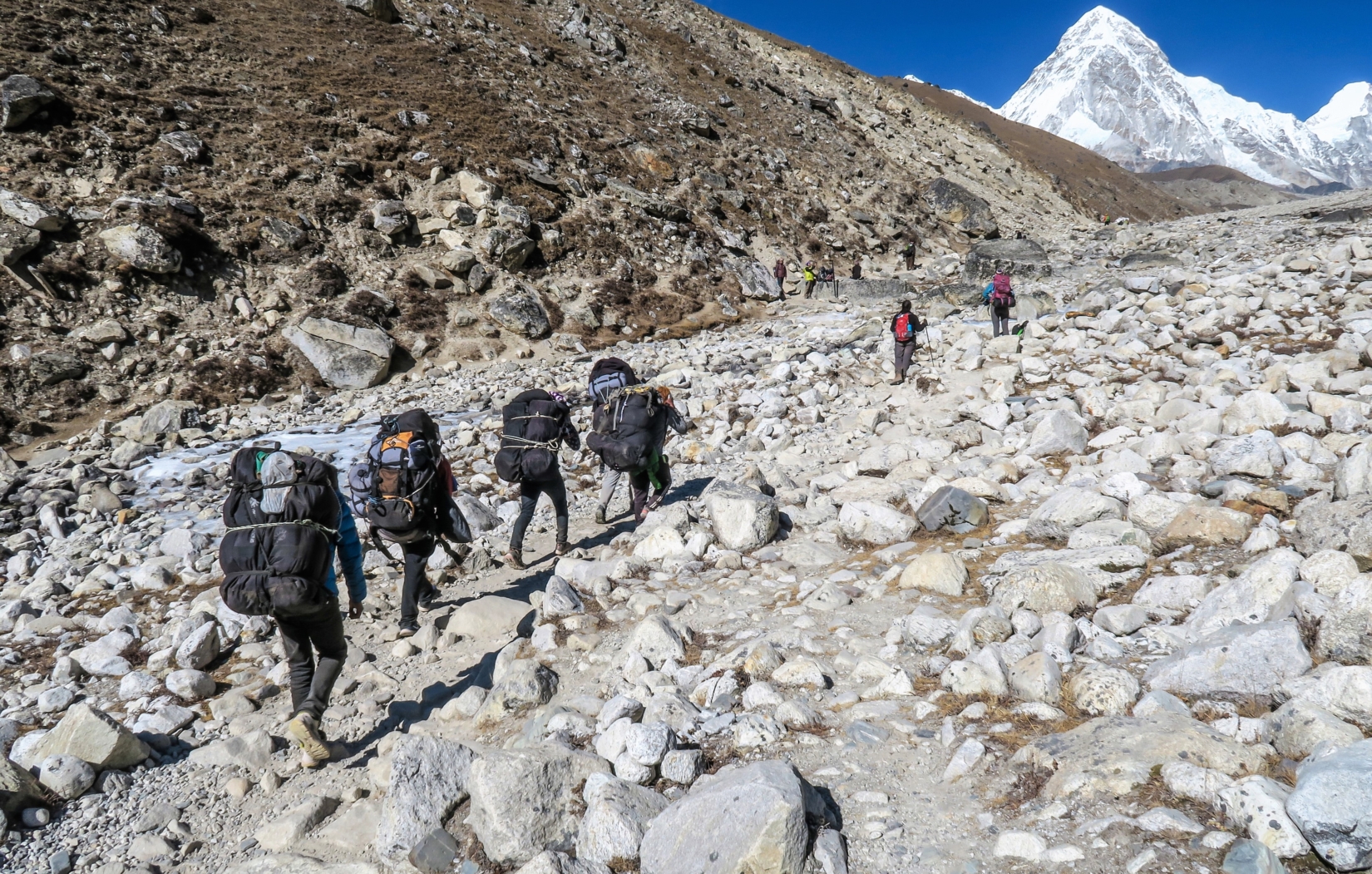
After the first few days of your trip, you’ll see that the trekking path levels a little as it skirts a wide, flat valley with the mighty Himalayas looming on all sides. This is where you lose the tree cover for good, so be sure to have the sunscreen handy. It’s rock and grit underfoot until you near Gorak Shep. There, the route sort of merges with the great pebble and rock moraine at the end of the Khumbu Icefall. It’s normal to find snow coverage in those parts, especially if you’re trekking between November and March.
Elevation and altitude
How high is Everest Base Camp? Well, altitude is commonly travelers’ biggest challenge on this tall trek. As mentioned before, you’re going to have to clock up a hefty 17,598 feet (5,364m) above sea level. You’ll manage 9,400 feet (2,865m) at the EBC trailhead, which is taken care of by the flight from Kathmandu to Lukla. The rest is up to your legs. You’ll knock out about 1,800 feet (549m) by climbing to Namche Bazaar. After that, days on the trail (not including acclimatization days) average around 1,200-1,600 feet (366-488m) in elevation gain, though it’s on less-steep paths once you cross the tree line around Tengboche. Everest Base Camp elevation is no joke and can be difficult for some.
Acute Mountain Sickness (AMS) – the mildest form of altitude sickness – is certainly a risk here. It can affect anyone over altitudes of 8,000 feet (2,438m), but usually has severe impacts at higher levels. Since the EBC Trek reaches altitudes of more than double the height where AMS can possibly kick in, there are usually two full acclimatization days planned in – one in Namche Bazaar and the another in Dingboche or Lobuche. These days aren’t for resting but instead used to climb high and then descend to sleep at lower altitudes, a common practice that’s known to help the body acclimate to conditions at higher elevations.
Don’t be surprised if your Everest Base Camp Trek guide constantly reminds you to drink enough water as it’s another way to combat AMS. Once you hit the higher altitude parts of the path, you can typically expect your guide to be prepared with a supply of oxygen, should you need it. You might also want to consider packing an AMS medication like Diamox on your trip to Nepal.
Even seasoned alpinists find the trip a challenge and lots of climbers struggle with Acute Mountain Sickness. Just remember: no pain, no gain on this most incredible of trails! On this trip, you’ll see the sheer majesty of the Nepalese Himalayas up close and scale to viewpoints that are simply some of the best you’ll ever hike to.
6. Food on the Everest Base Camp Trek
All that trekking is going to work up a serious appetite, you can be sure of that. Thankfully, EBC teahouses tout some decent grub for when it’s time to refuel. Don’t be surprised to find that the menus are virtually identical the whole way along, even if the dishes themselves vary greatly with the whims of different chefs up and down the trip route.
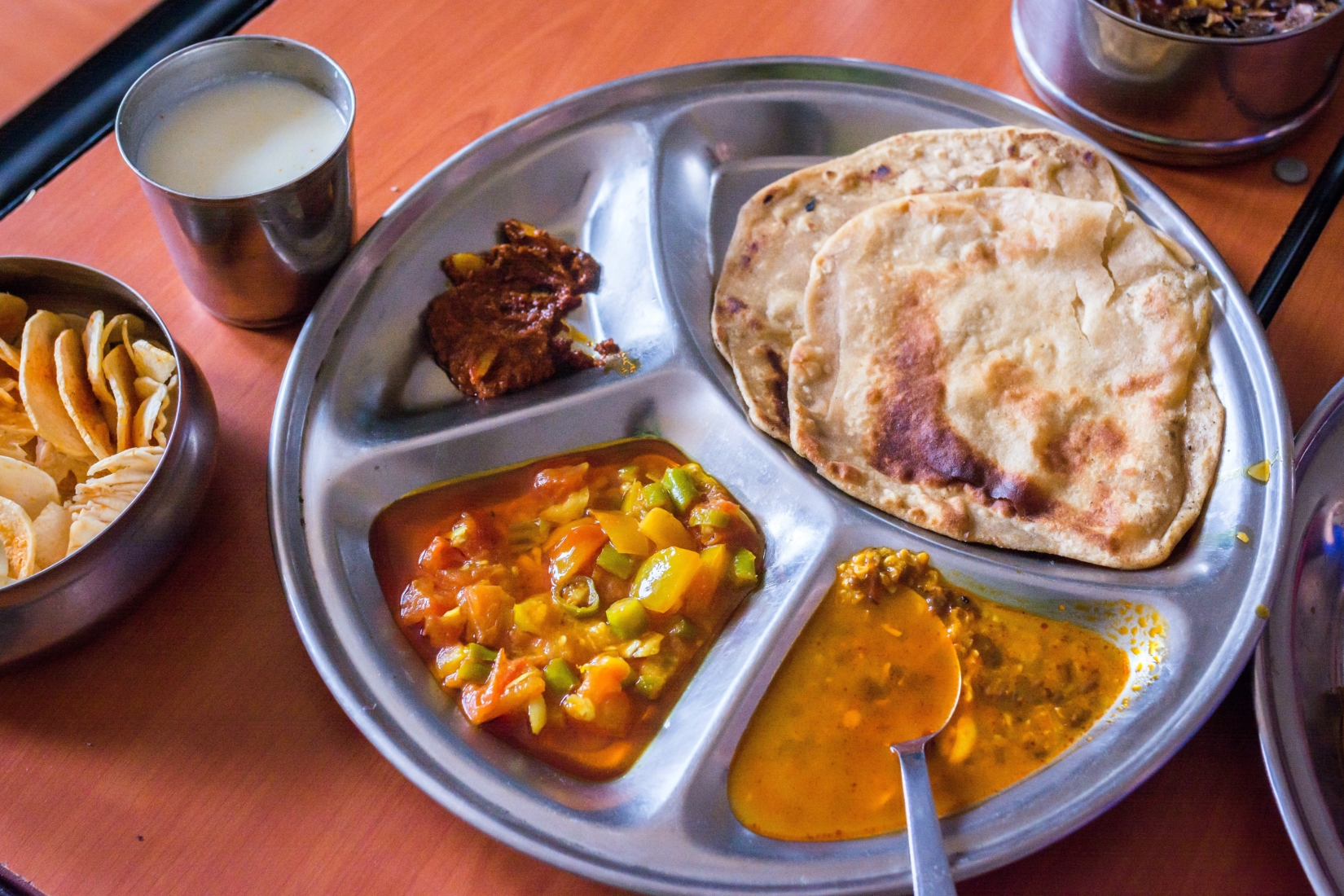
Common dishes include:
- Dal bhat – The most popular EBC meal of all. Every hiker who’s done the route has warmed up with this spicy lentil stew at least once. It’s usually served with rice and chapati flatbread.
- Egg and fries – A hearty option for those feeling really hungry, this one includes hand-cut, fried potatoes and a double-egg omelette.
- Shyakpa ( Sherpa stew ) – A classic favorite of sherpas in Nepal and a great vegetarian option that’s basically broth with cut potatoes, carrots, and other root vegetables.
- Pizza – Some teahouses try their hand at pizza. We’ll let you be the judge of whether or not the Italians would be proud.
Is your mouth watering yet? These dishes will surely give you the energy you need to power through the trek.
7. Accommodations on Everest Base Camp
Apart from the hotels in Kathmandu at the start and at the end of your quest, all of your accommodations on the Everest Base Camp Trek route are likely to be teahouses. Don’t let the name fool you – these aren’t just places to stop for a hot drink. They’re actually full-fledged bed and breakfast lodges purposely designed to host travelers.
EBC teahouse accommodations in Nepal are simple, clean, and comfortable. The general rule is that the quality is better towards the start of the trek, where the teahouses are both larger and better supplied. Rooms are usually minimally decorated. They have wood-paneled or plastered walls and, for the most part, a single window, along with low-rise beds with foam mattress pads. Some have in-room heating, while other teahouses are warmed by a central stove that’s kept alight in the evenings. Some places offer hot showers, but most only offer cold. Electrical charging of devices is on offer at most places, though that could come at an extra cost.
For more details on accommodations, check out our Everest Base Camp tour page .
8. Best time to trek to Everest Base Camp
There are two main seasons for trekking to Everest Base Camp in Nepal. The first is in the spring (late March to May) and the second comes in the autumn (late September to November) . Both high seasons essentially straddle the main monsoon season, offering more dryness and clearer skies without too much precipitation. Although, it’s important to note that zero rain can never be guaranteed this high up.
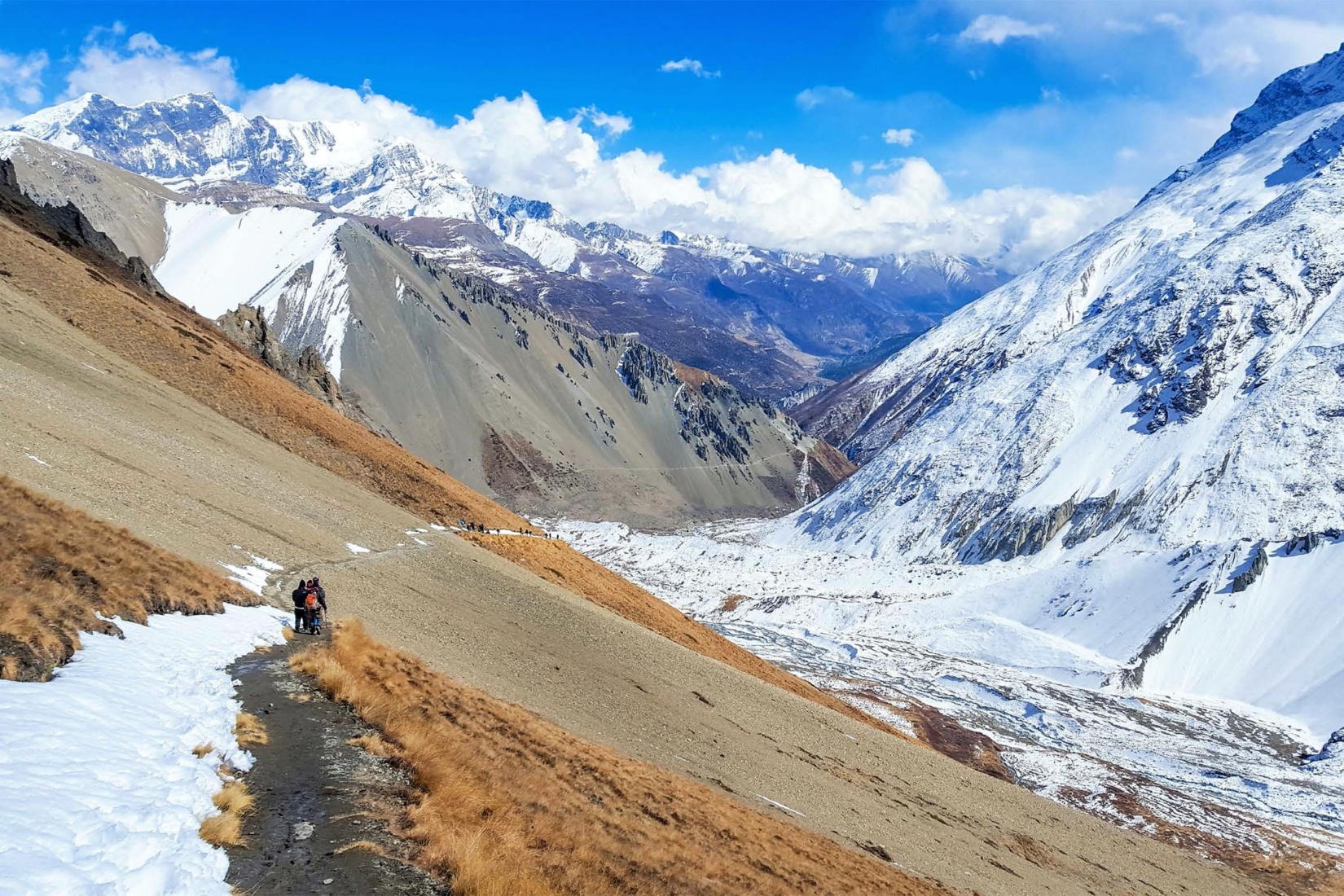
Here’s a breakdown of the best months to go:
- March – Marks the beginning of the trekking season proper but it’s not its peak. That means a good balance of smaller crowds, availability in teahouses and affordability. Most of the ground snow has melted by this point, but rising temperatures do mean there can be some heat haze to obscure the views.
- April – The busiest time of all on the Mount Everest Base Camp Trek, but for good reason: Clear skies abound, the views are wonderful, and temperatures are comfortable. You can also come in April if you’re keen to see the hardcore mountaineers prepping for a summit push up Mount Everest itself.
- May – The hottest month on the trail with less harsh conditions in the evening. Downsides include heat haze that can obstruct the views and the potential for some early-monsoon rains.
- September – The first month after the monsoon can see some rains stick around. However, that also means the lower-altitude parts of the trek between Lukla and Namche Bazaar are wonderfully lush with flower blooms and vivid greenery.
- October – Second only to April in terms of crowds of travelers. Lots of people hit the EBC trail at this time because there’s a great balance between comfortable temperatures and clear skies. In fact, I’d say that this is the clearest time of all, so it’s perfect for those wanting uninterrupted views of Everest.
- November – Cold winter conditions can start to set in by November. It’s not unusual to encounter snow at higher altitudes and you’ll need proper thermal gear to get through the nights. The payoff is super-clear skies and way fewer hikers on the trail.
December to February is the low season for one main reason: Snow. Temperatures during these colder days drop to an average of 25 degrees fahrenheit (-4℃) in the middle of the winter season, and that’s in Namche Bazaar, one of the lowest points on the trek. It’s not ideal for overnight hikes that rely on teahouses made of plywood walls. That said however, completing the EBC certainly isn’t impossible at this time, it just presents unique challenges. You’ll need way more thermal layering, special trekking equipment to handle the snowdrifts, and probably extra days to complete the trek. The upside is that winter days offer very clear skies and there’s rarely a big crowd on the trail.
9. What gear and equipment should I pack?
When considering what to pack for your trip, it’s good to know there are strict limits on the weight each passenger can take on that initial flight from Kathmandu to Lukla. What’s more, there are limits on the size and weight of bags that you can ask porters to shuttle up and back to EBC for you. Due to these limits, you’ll want to think very carefully about what to bring for this once-in-a-lifetime trek. As a general rule, it’s good to stick to about 22-33 pounds (10-15kg) in your main pack, with a small 30-litre day pack on the side to carry the things you’ll need on the trail.
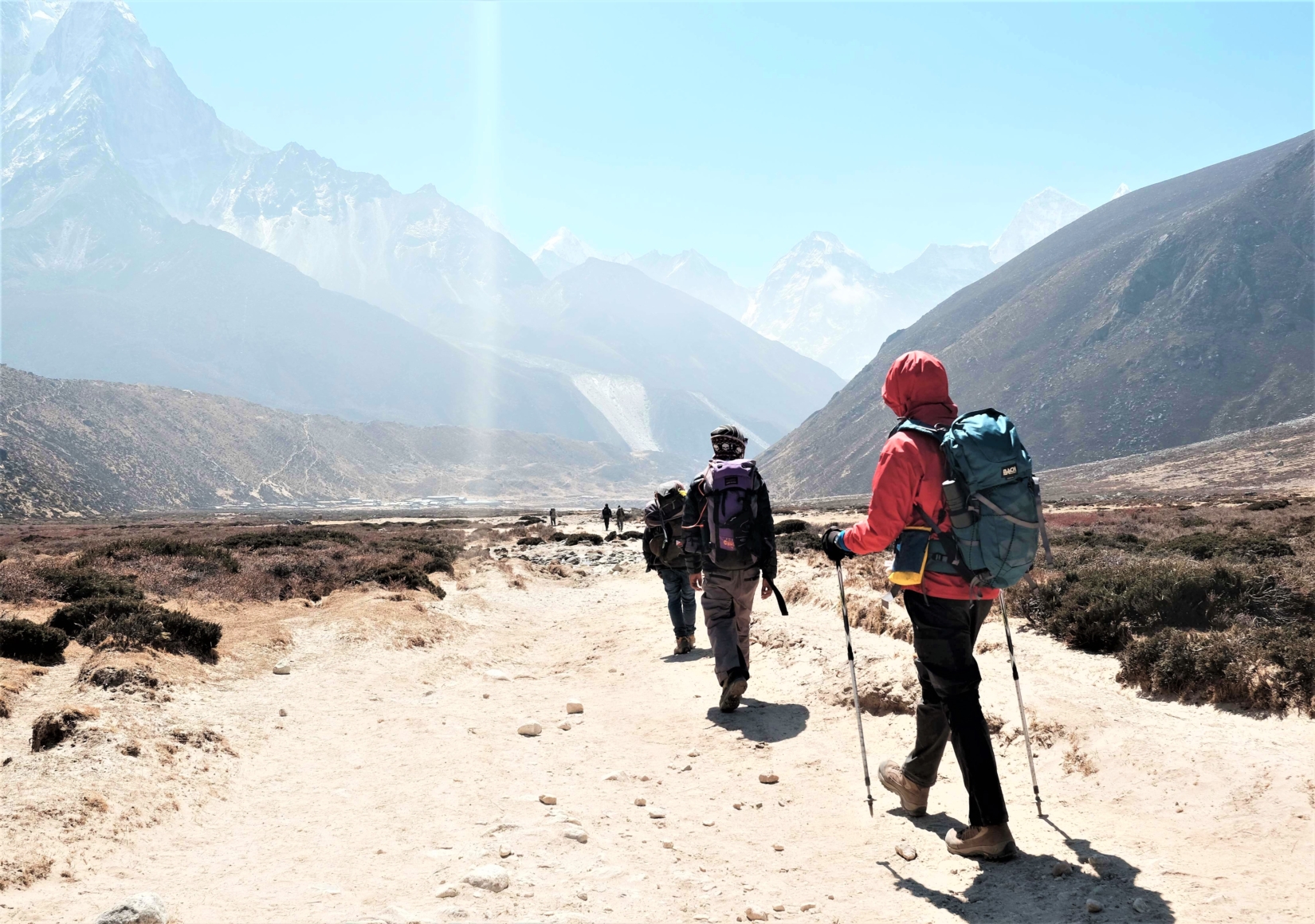
Layers are always key in the Nepalese mountains, as temperatures can warm up considerably during the day and drop suddenly at night. You’ll want to be able to add and remove fleeces and thermals on the upper body to match the fluctuating temperatures. For the lower body, I’d recommend bringing both shorts (mainly for the lower elevations of the trek where it can be positively balmy) and sturdy trekking pants (for higher elevations), backed up by good thermal-rated underlayers.
Waterproofs are also essential for your trip. Rain and snowfall can come without warning in the high Himalayas, and weather patterns on the EBC Trek have little respect for the so-called high season, so inclement weather can happen any time of the year. Winter trekkers will need to plan a little more, though, in order to deal with all that ground ice and much colder conditions.
On top of that, you’ll need to think about all those hiking essentials. Good boots, a pair of hiking poles you feel comfortable with, both a wool hat and a sun hat, strong sweat-resistant sunscreen, headlamps, and a decent-capacity water bottle should all be on your packing list.
That’s just scratching the surface, but The Explorer’s Passage will make sure you’re fully prepared for your chosen season on the EBC route when you plan with us – just ask us for a full packing list !
10. Should I use a porter service?
Put simply, porters are essential on the trek to Everest Base Camp. They’re very much the superheroes of the expedition, transporting the bulk of most trekkers’ gear and equipment from camp to camp outside of Lukla or Namche Bazaar. For larger groups of trekkers, some operators will utilize animal support for transport assistance. Porters will carry one standard rucksack or duffle bag per hiker. Usually, that’s limited to a weight of between 22-33 pounds (10-15kg) per person, though it can be lower or higher depending on the Everest Base Camp tour you pick. That leaves you to only carry what you need for the day. As mentioned above, a 30-litre pack typically works best, just enough for water, snacks, fleece and waterproof layers, your camera, and sunscreen.
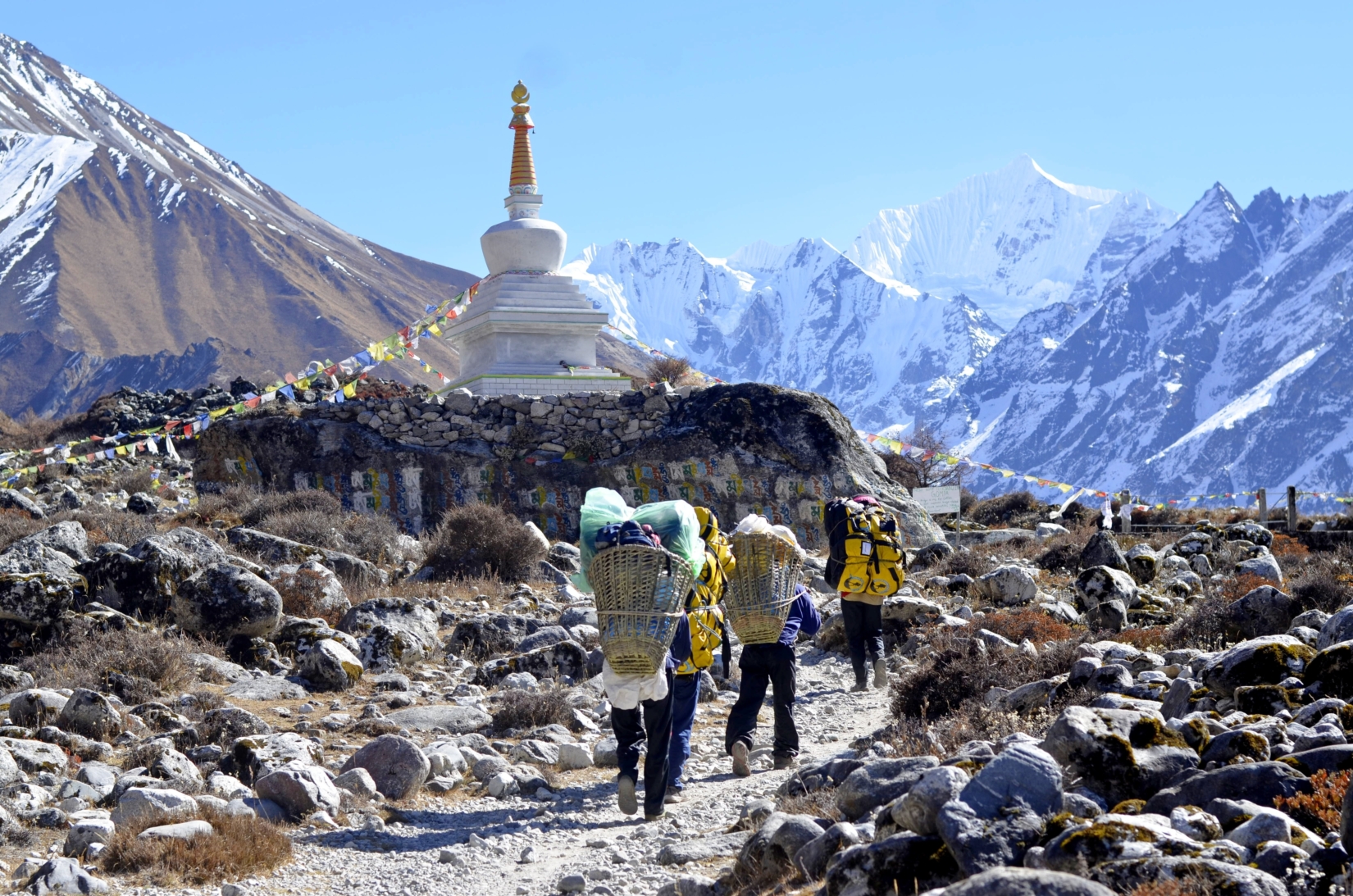
I do, occasionally, see people who choose not to engage a porter but that’s a tough task. Ultimately, when you’re deciding whether or not porter service is right for you, remember that the Mt. Everest Base Camp hike involves several days of walking at altitudes over 12,000 feet (3,658m) above sea level, on tricky terrain to boot. It’s a challenge even without 44 pounds (20kg) of gear strapped to your back!
11. Getting there
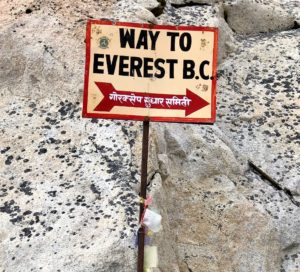
So now you know what this infamous excursion holds and you can’t wait another moment to go, how will you get there? The trip to the start of EBC is a journey in itself. You’ll first jet into Kathmandu, the heady, rickshaw-rattling capital of Nepal. It’s an amazing place, filled with UNESCO temples and the aromatic spices of Nepalese curry houses. We usually recommend that travelers arrive at least a couple of days before they are due to set off for the trek, not really to help with altitude acclimatization – Kathmandu is a relatively modest 4,500 feet (1,372m) up – but more for cultural acclimatization.
Doing that means you’ll have time to score any last-minute gear you might have forgotten for the hike itself. Kathmandu has plenty of decent outfitters that offer good deals on key items like down sleeping bags and thermals. It also means you’ll get to see some of the great cultural treasures of the country, including the tower-topped temples of Durbar Square and the colossal Boudhanath Stupa, which is usually writhed in prayer flags dancing in the wind.
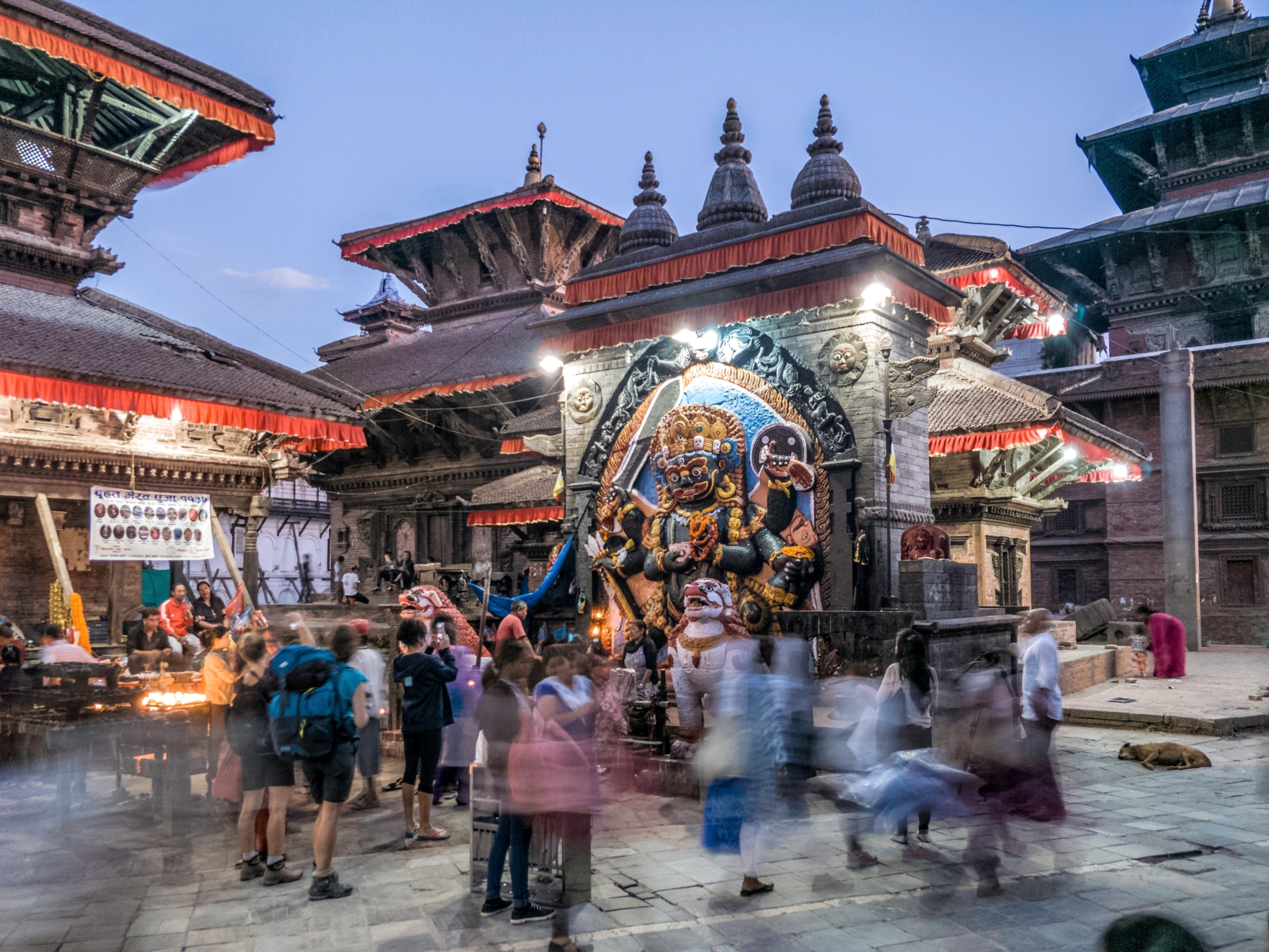
After Kathmandu, there’s a short-haul flight from the domestic terminal of Kathmandu Airport that takes you all the way to the trailhead of Everest Base Camp in Lukla. The plane ride is relatively quick – about 30 minutes total – and pretty spine-tingling, especially as the landing strip on the Lukla side sits a whopping 9,300 feet (2,835 meters) above sea level on a precipitous mountain plateau. It’s not a flight you’ll forget in a hurry!
12. Travel visas and permits
Some nationals of specific countries can enter Nepal without a visa, but most travelers will require one. For those who do, entry visas for tourists traveling into Nepal are generally available in advance or upon arrival at Tribhuvan International Airport and various land borders. If you’re unsure of which category you fall into, use this easy tool to double check your entry and health requirements .
When it comes to permits, there are no permits for the Everest Base Camp Trek itself, at least not like there are for the Inca Trail and some other bucket-list hikes elsewhere on the planet. However, there are limits to the number of guests teahouses can host (so it’s important to book early) and you will be passing through some regions and conservation areas that require visitors to obtain special passes, but no need to worry as The Explorer’s Passage will handle all of these details for you. Just make sure your travel documents and essentials are still valid.
For the route to Everest Base Camp from Lukla, there are two key documents that we will secure for you:
- Khumbu Pasang Lhamu Rural Municipality Entrance Permit – This is a pass for access to the whole Khumbu region.
- Sagarmatha National Park Entry Permit – This is your pass to enter the national park that contains Mt. Everest.
It is important to note, those looking to do the longer, 20-day extension to the EBC Trek, going from Kathmandu by road and then onwards by foot from Jiri, will also need a pass for access to the Gaurishankar Conservation Area.
13. A typical Everest Base Camp Trek itinerary
The temple-topped, bazaar-busting city of Kathmandu is likely to be where you enter Nepal. You’ll definitely want to take some time out of your trip to explore this amazing city first. Then, it’s time to head northeast to start your Everest Base Camp hike. Most travelers do that with a flight to Lukla and then walk from there, but it’s also possible to trek all the way if you have the time. Still, most Everest Base Camp Trek itineraries officially start at Lukla airport.
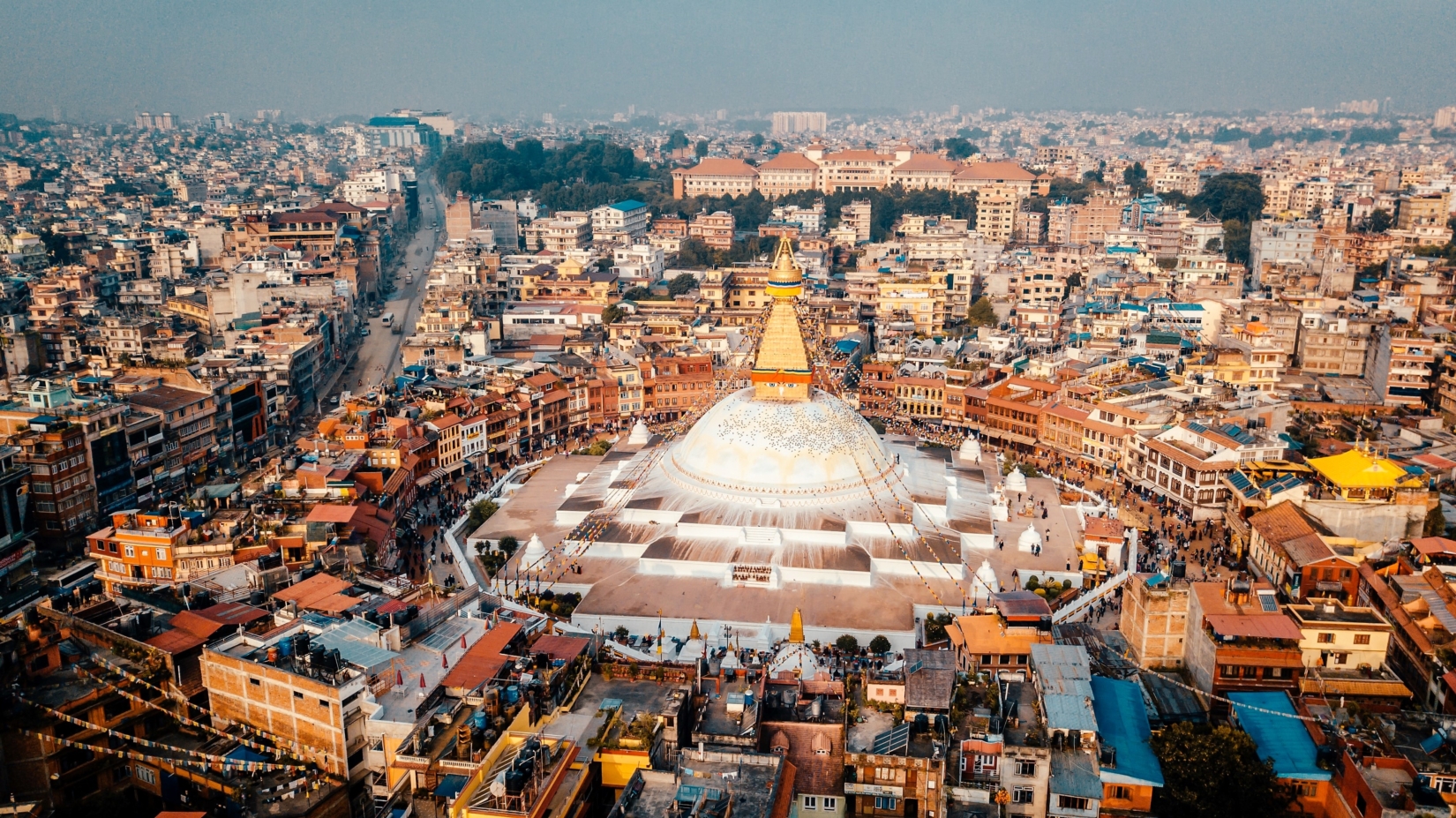
For a customized itinerary, connect with us to craft your ideal trip.
- Day 1: Namaste and welcome to Kathmandu! Get ready to experience one of the most awe-inspiring journeys our planet has to offer. You’ll arrive in Kathmandu and explore the dynamism, scenery, and history the city has to offer.
- Day 2: Today will be filled with cultural immersion. Begin by exploring three UNESCO World Heritage Sites. The first is Boudhanath, one of the largest stupas in Nepal. Next is Pashupatinath, a sacred Hindu temple located on the banks of the Bagmati River. Finally, you’ll visit Durbar Square, which sits in front of the old royal palace. Finish your day with one of the most classic walks through the old narrow streets of Kathmandu. In the heart of this city, soak up the buzzing atmosphere of the local markets and stores, before heading back to the hotel.
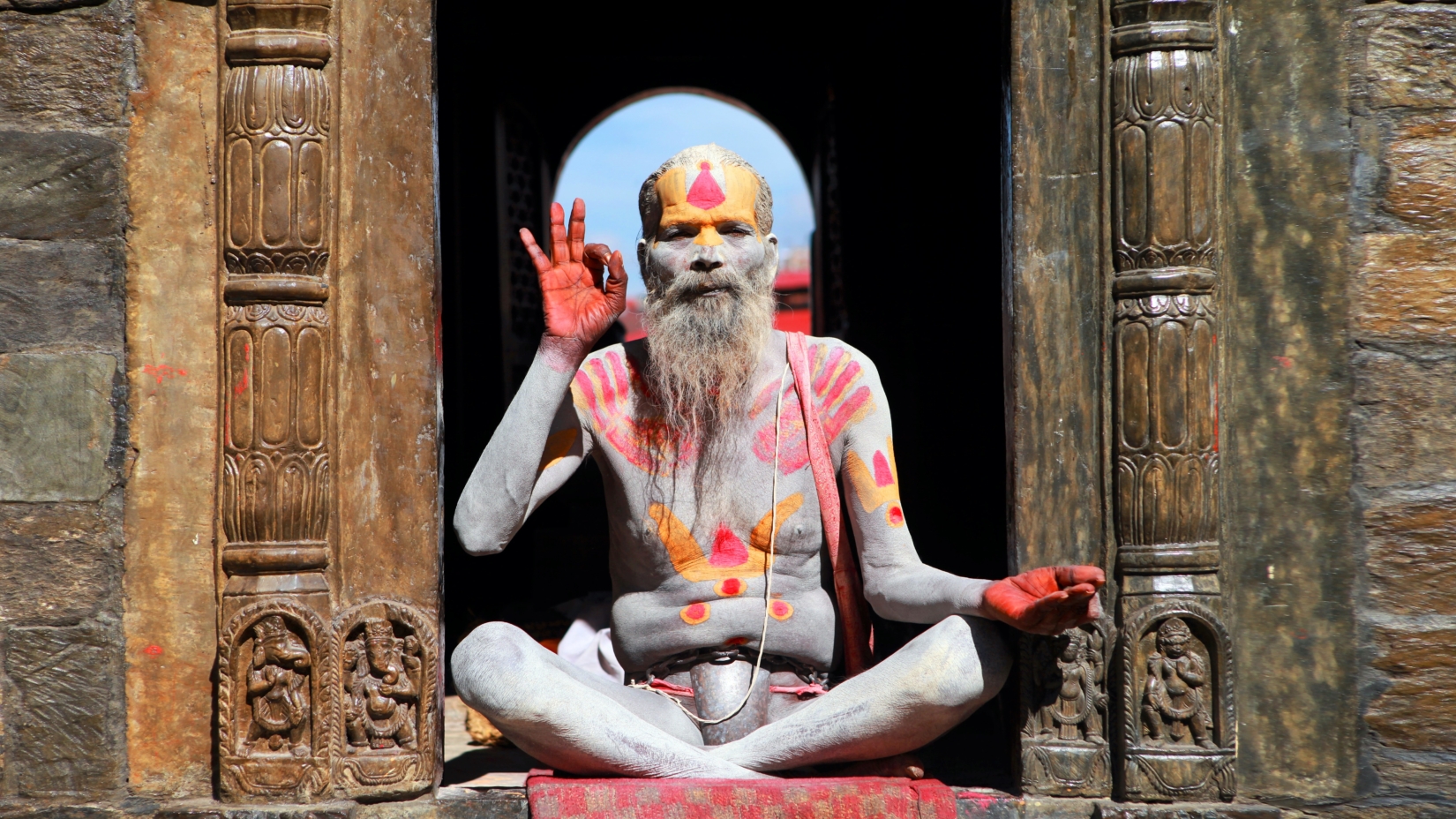
- Day 3: Kathmandu to Phakding (8,562 ft / 2,610 m) – After a short flight to Lukla, it’s a pleasant hike through dense pine forests and steep gorges traversed by swinging suspension bridges. There’s a real bustle about this part of the path, with oodles of hikers fresh onto the trail to chat to. It’s also the lushest part of the trail, with wildflowers and roaring riverways, more Alps than Himalaya.

- Day 4: Phakding to Namche Bazaar (11,286 ft / 3,440 m) – Today you’ll go up to the main hub of EBC: Namche Bazaar. This is a good place to stock up on any essentials you may have forgotten to bring on your trip. Enjoy the town that’s abuzz with hiker cafes and lodges, and comes with stunning views of the jagged Mount Khumbu Yül-Lha (Khumbila), loosely translated as “God of Khumbu” peak, to the north.
- Day 5: Namche Bazaar (11,286 ft / 3,440 m) – This is your first official acclimatization day. The best way to prepare for the altitude is to hike high during the day and return to lower altitudes in the evening to sleep. The Khunde and Khumjung Loop is the perfect option for that, taking you to long-lost Sherpa villages with mystical Buddhist stupas.
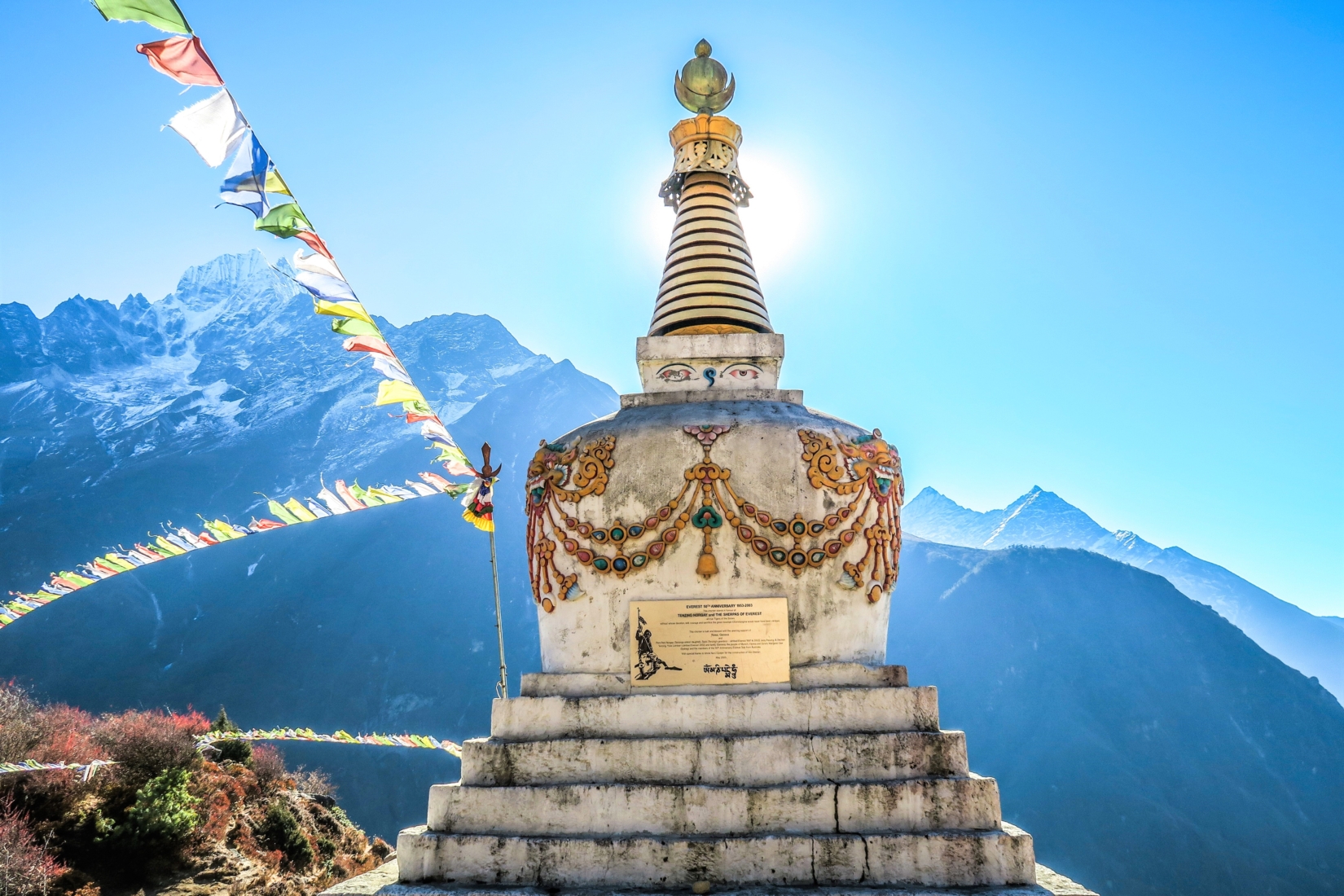
- Day 6: Namche Bazaar to Tengboche (12,664 ft / 3,860 m) – Your first steps on the Everest Base Camp Trek proper begin with a steep incline that takes you almost out of the treeline. The path levels and then emerges into a lunar-like world of big brown rocks where the Himalayas draw ever closer. The destination? The rhododendron forest, where you’ll stay for the evening.
- Day 7: Tengboche to Dingboche (14,470 ft / 4,410 m) – Expect exposed trekking except for some sections through high-altitude pine woods. Later in the day, the trail wiggles across the sides of Ama Dablam peak and you’ll get to appreciate the Everest massif in all its glory looming overhead.
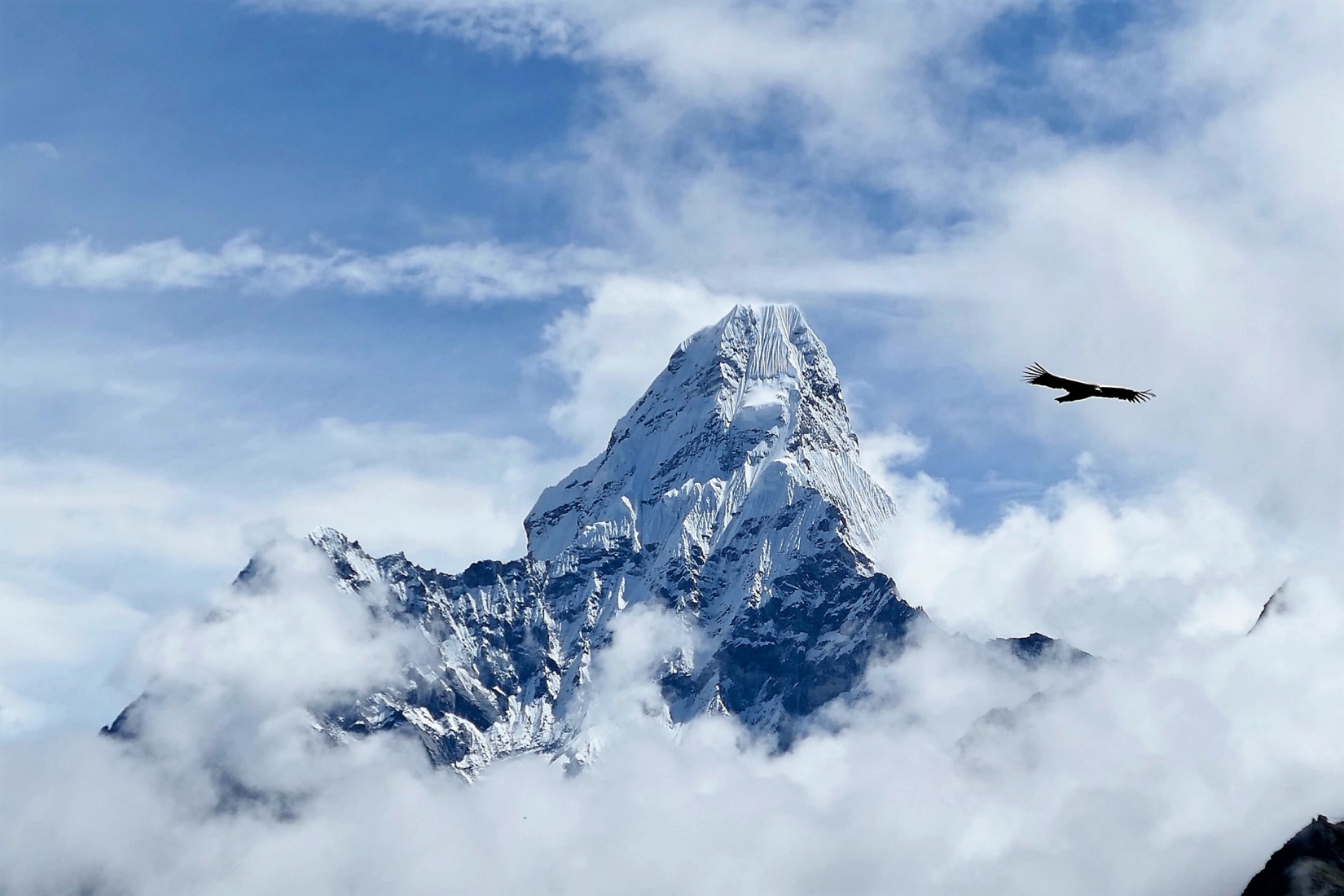
- Day 8: Dingboche (14,470 ft / 4,410 m) – A second acclimatization day is needed at this stage of the trip. Perhapstake some time to experience Chukhung (15,518 feet / 4,730 meters), a place traditionally used to raise yak. Lodges rise up amongst the peaks, making it a perfect spot for relaxation, observation and absorbing the scenery and local life.
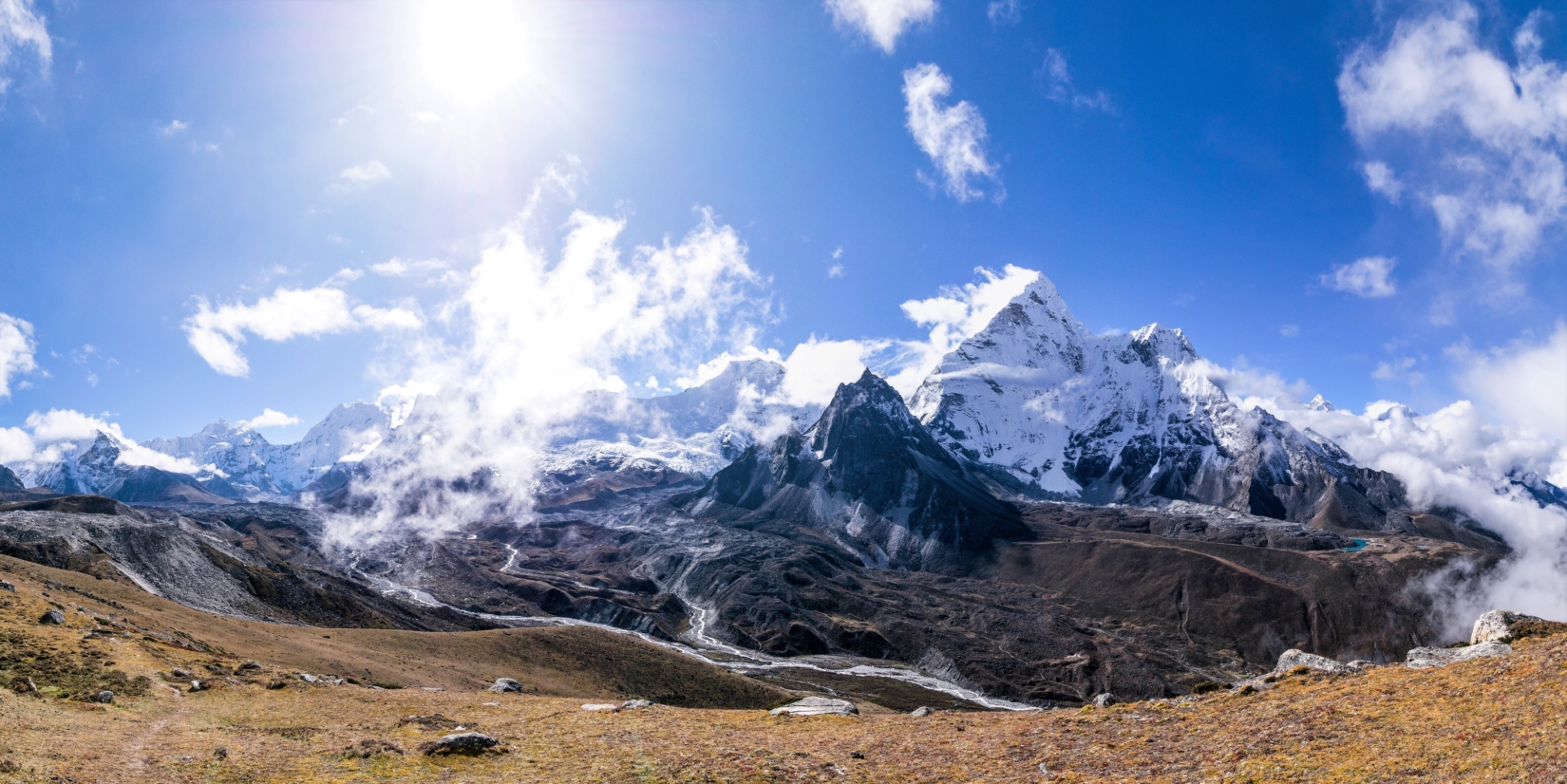
- Day 9: Dingboche to Lobuche (16,210 ft / 4,941 m) – You’re now onto the penultimate push towards Everest Base Camp. Welcome to the high Himalayas. Trees are long gone in this land of rugged rocks and the cascading tongues of glaciers. The day includes some amazing visions of the approaching Everest massif, especially the closer face of Nuptse.
- Day 10: Lobuche to Everest Base Camp (17,598 ft / 5,364 m) – The final part of the trail starts by weaving over rocky highland terrain and then passes through the Gorak Shep village, where a small trekking lodge clutches the edge of the Khumbu Icefall. There’s a chance of a small rest there, but not for long, because EBC is only another 1.5 hours up the valley!
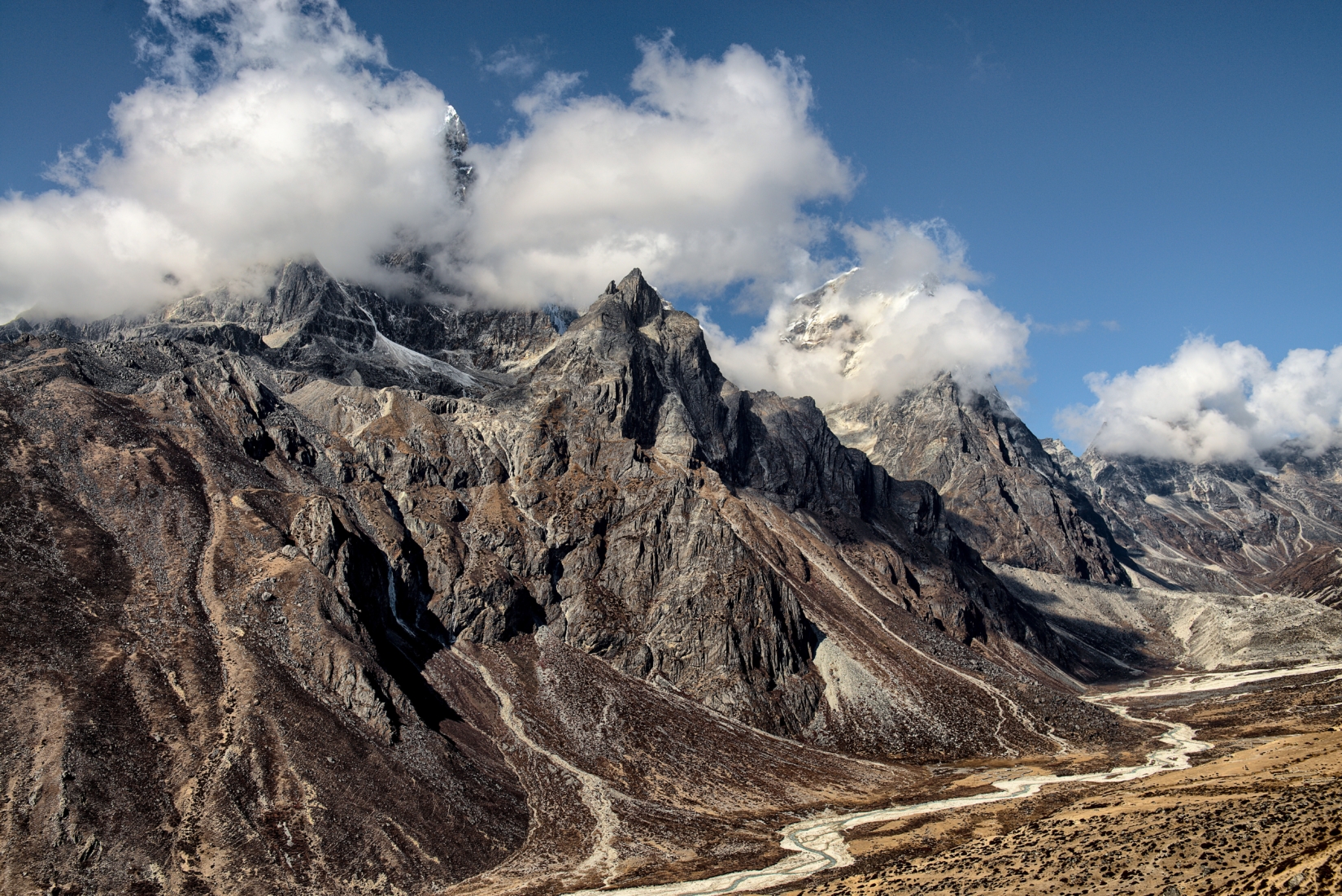
- Day 11: Everest Base Camp to Pheriche (14,340 ft / 4,371 m) – Today you’ll retrace your steps towards Pheriche, hiking first towards Kala Patthar. Oxygen begins to increase and much of this portion is downhill, and you’ll have the chance to take in the panoramic views with an easier trek.
- Day 12: Pheriche to Debouche (12,533 ft / 3,820 m) – You’ll work back via Deboche, passing the Old Nunnery. Follow the river back towards Debouche, a campsite, not far from the Tengboche Monastery.
- Day 13: Debouche to Namche Bazaar (11,286 ft / 3,440 m) – Today you’ll double back towards Namche Bazaar, the Sherpa village that is the hub of activity and local culture. Here you’ll see many porters like Norgay, who aid climbers and know this terrain better than anyone. Observe the local mountain life, as you continue on tomorrow towards Phakding.
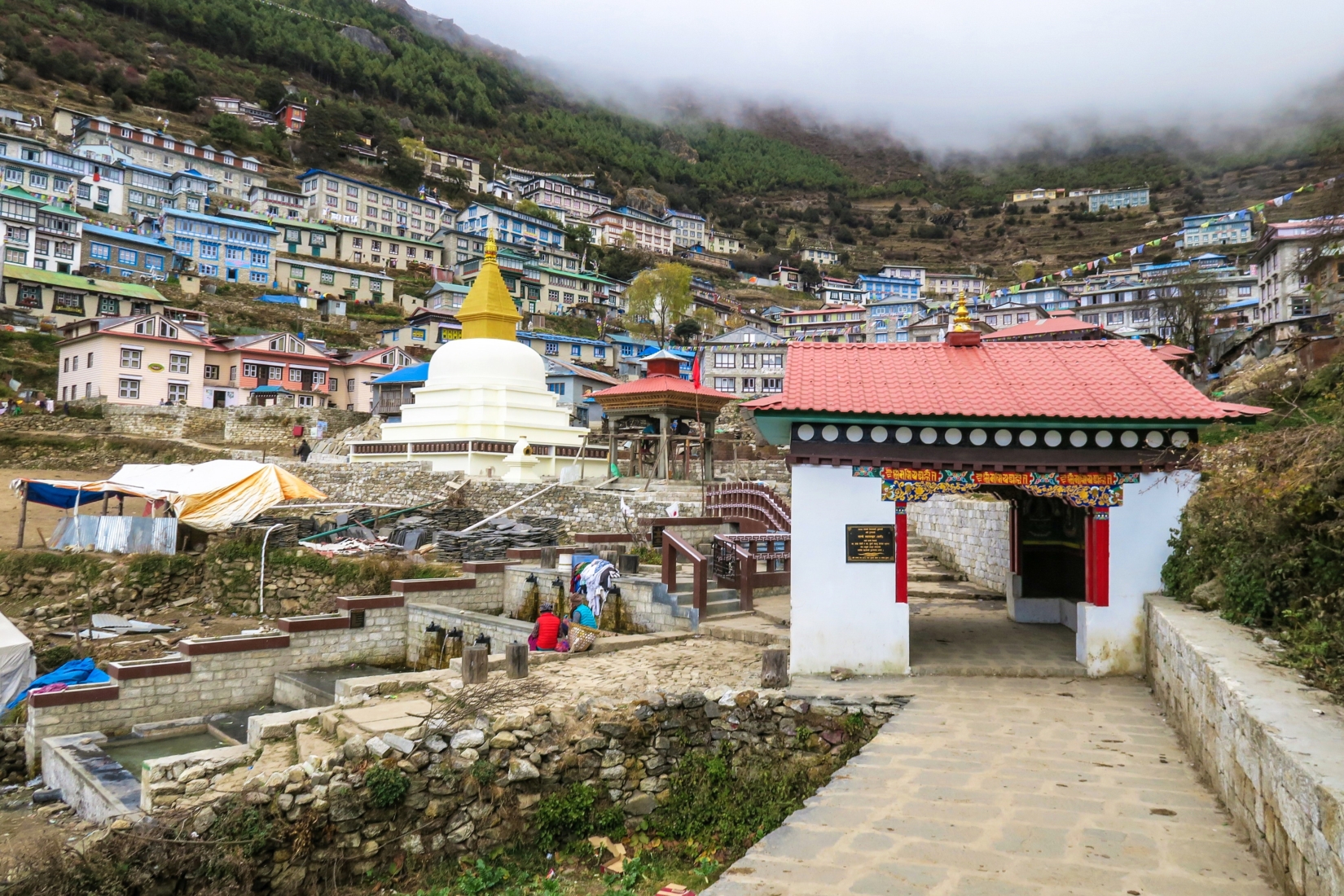
- Day 14: Namche Bazaar to Phakding (8,562 ft / 2,610 m) – As you continue downhill towards Phakding, observe the local agriculture and yak pastures as you pass by the majesty of the Himalayan peaks. You’ll spend the evening alongside the Dudh Kosi River, and take in the sights and sounds of the crystalline waters.
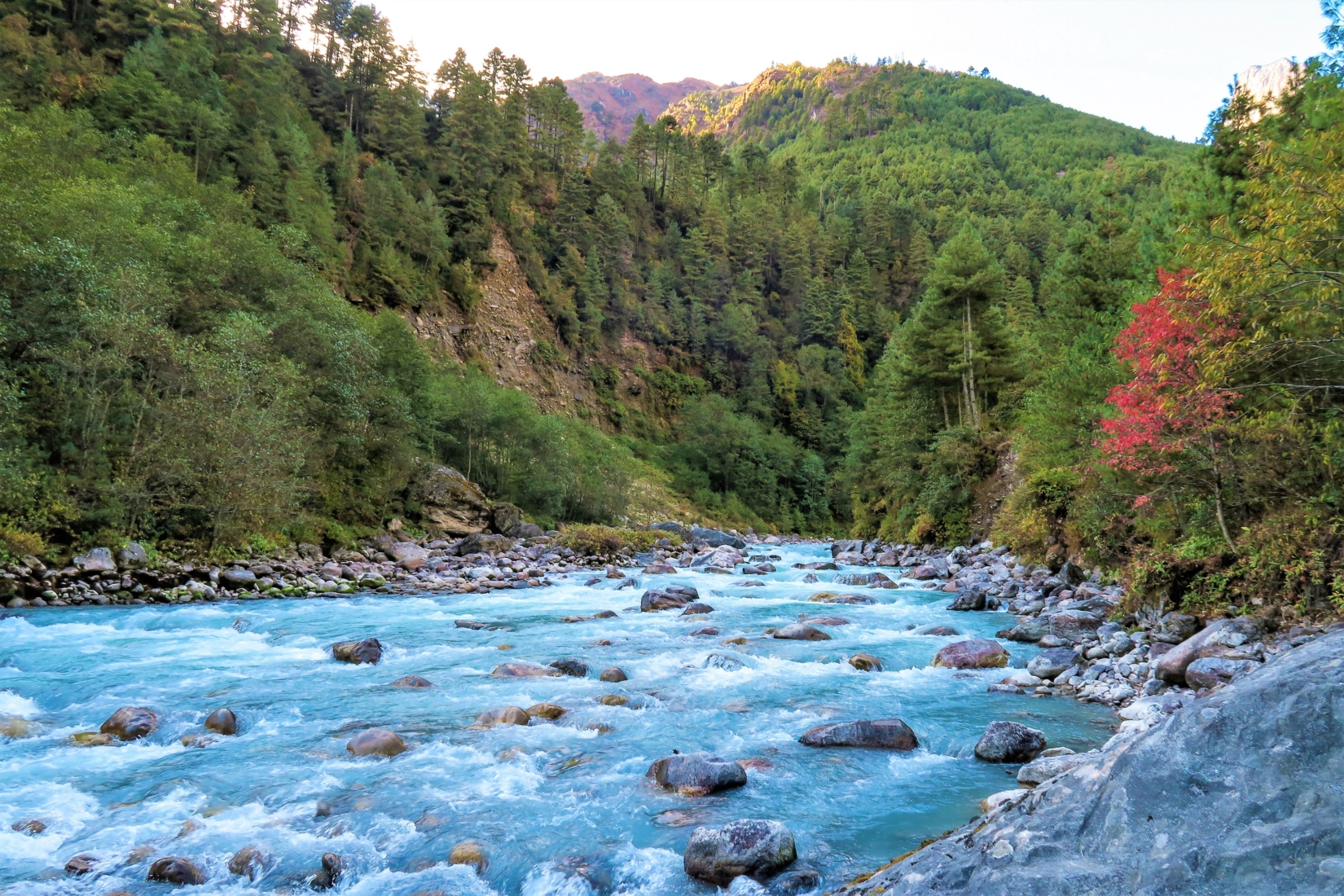
- Day 15: Phakding to Lukla – From Phakding, you’ll make our approach towards Lukla. Gather your new memories from the trip and enjoy your last days amongst unparalleled natural views in Nepal. You’ll stop for lunch in Lukla, with plenty of time to appreciate the clear landscape.
- Day 16: Lukla to Kathmandu – Returning to Kathmandu, you’ll have time and space to explore after having a chance to refresh and recuperate in your hotel. The Thamel district is a great place to wander with its many winding streets lined with souvenir shops, bars, restaurants, and more. There’s plenty to see and to try on the final day of your trip in Kathmandu. Soak up as much of the city’s offerings as you can as the end of our trip approaches.
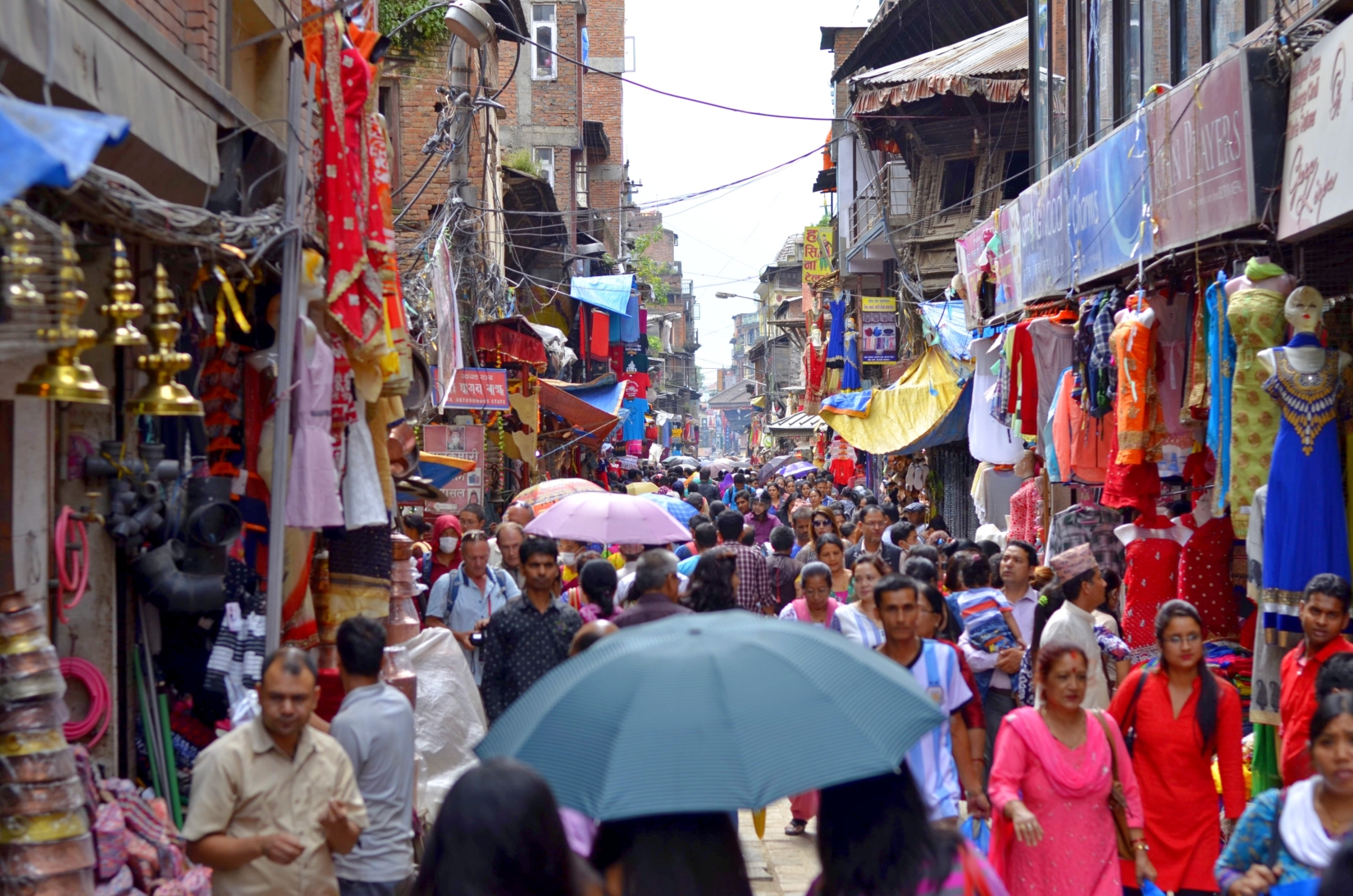
- Day 17: Today is your final day as an intrepid traveler exploring Nepal. You might have time to see some live music in Lazimpat or venture to Patan, which was originally known as Lalitpur, or the “City of Beauty”. Stop off at Newa Chen to add a visit to a 350-year-old Newari home, restored to its former glory and open to the public, to your trip. Be sure to experience as much of Kathmandu as you can, before you reluctantly head back home from this exhilarating adventure trip!
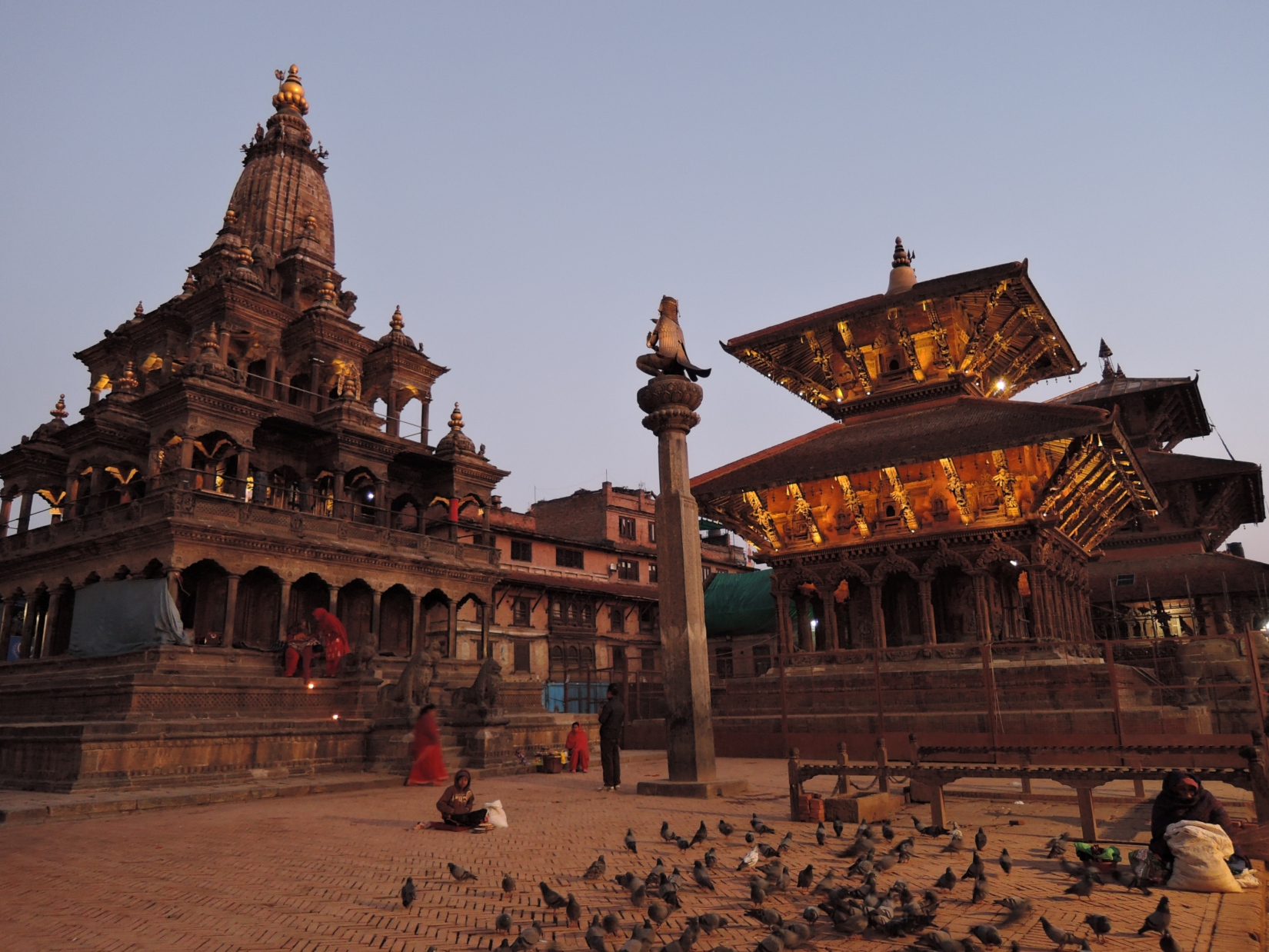
- Day 18: Depart from Kathmandu. Today you’ll return home having retraced many of Hillary and Norgay’s historic steps. You’re officially one of the lucky few who have witnessed the majesty of Everest up close!
Other Variations of the EBC Trek
The main up-and-back EBC Trek outlined above is by far the most popular route to the fabled camp on the slopes of Mount Everest, but there are also other options. Take the Three Passes Trek. It’s a circular romp that encompasses a trio of the highest traversable passes immediately around Everest itself, starting with Kongma La (18,175 feet) before pushing on through Cho La (17,782 feet) and then Renjo La (17,585 feet).
This is a considerably more challenging undertaking than the classic Everest Base Camp Trek, usually reserved for hikers with high-altitude experience. The reason? You spend multiple days walking at heights of over 16,400 feet. There’s also more chance you’ll have to contend with snowpacks – especially late and early in the main trekking seasons (April and November). The reward is a chance to explore all the nooks and crannies of the Khumbu Region, with visions of the gleaming Gokyo Lakes and remote Sherpa hill villages along the way.
Other variations include the dedicated Gokyo Lakes Trek, which involves portions of the Three Passes Trek at Cho La to offer a fuller visit of the Gokyo Valley before re-joining the route to base camp at Lobuche.
This trip guide is just a taste of what you should know before embarking on the remarkable trek to Everest Base Camp. For more details on general trip costs, accommodations, and more, check out the specifics on our Everest Base Camp tour page .
Better yet, if you have more questions on hiking to Everest Base Camp or need help planning your trip to the Himalayas, let’s connect! Our knowledgeable Adventure Consultants would love to hear from you so contact us and let us show you what’s possible .

Why travel with The Explorer’s Passage?
Experience the Everest Base Camp Trek with the best tour operator in Nepal. Our guides have been leading adventure trips in the Himalayas for over 30 years and are experts of trekking to Mount Everest Base Camp. They are also native to the Khumbu region of Nepal, the home of the Sherpa community, so you know you’ll enjoy an authentic experience.
We pride ourselves on delivering extraordinary tours based on travelers’ needs and are humbled by our guests’ testimonials . In fact, our dedication has earned us a 5-star rating on Tripadvisor , and awards by Travel+Leisure Magazine and Newsweek. Check us out and discover why so many travelers worldwide choose us . My team and I would love for you to join us on the trek to Everest Base Camp or any of our many other adventure trips !
I hope to go exploring with you soon!
Jeff Bonaldi Founder & CEO The Explorer’s Passage
About Jeff Bonaldi
Jeff Bonaldi is the Founder and CEO of The Explorer’s Passage, a premier adventure travel company. His mission is to provide travelers with the opportunity to transform their lives and the planet through the power of adventure.
Learn more about Jeff’s story and his company HERE .
Share This Amazing Location!
Related posts.
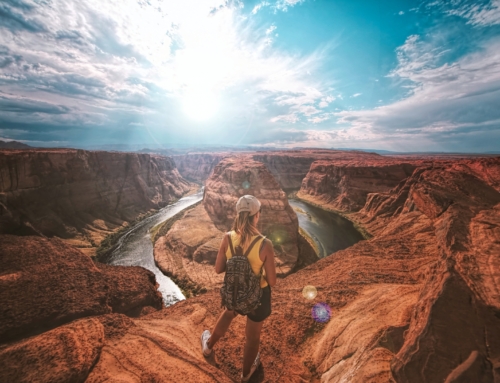
Expert Guide to Solo Travel & Top Destinations in 2024
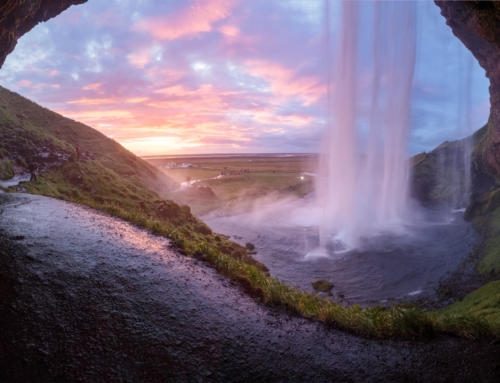
14 Best Places to Visit in Iceland in 2024
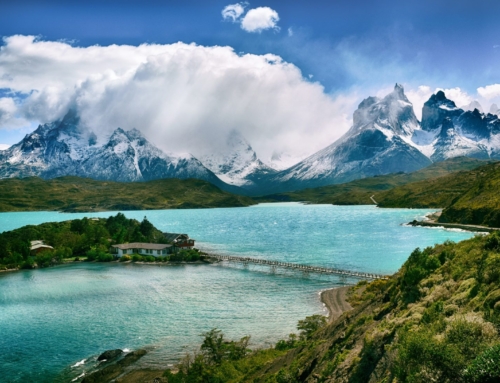
19 Things to Know Before Hiking the W Trek in Patagonia’s Torres del Paine in 2024

14 Things to Know Before You Climb Mount Kilimanjaro in 2024

The Ultimate Guide to Inca Trail Permits for 2024
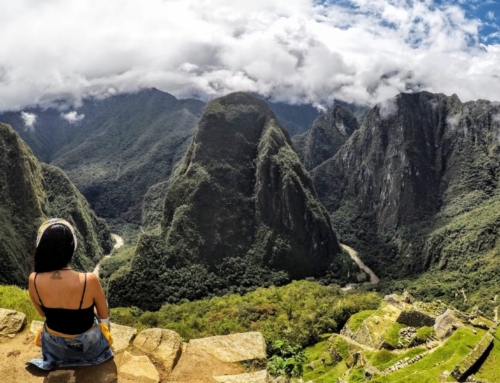
The Classic Inca Trail Route: A Day by Day Guide

Everest Base Camp Trek
14 Days Itinerary

- Includes/Excludes
- Book the tour
- Deals and Discounts
- Everest Region
- Nepal - Land of Himalaya
- Trekking Holiday
Embark on a lifetime of exhilarating experiences by retracing the path of Sir Edmund Hillary and his guide, Tenzing Norgay—Trek from Lukla, Nepal, to the summit of the world at Everest Base Camp and beyond.
The Everest Base Camp Trek is widely renowned as one of the most popular trekking routes globally. It holds immense significance for individuals from diverse backgrounds, including trekkers. This sacred landmark serves as a source of income for the locals, a challenging adventure for thrill-seekers, a soul-searching journey for casual trekkers, and a paradise of varied flora and fauna for biologists. The list of its offerings goes on and on.
If you’re looking for an unforgettable hiking adventure, the Everest Base Camp Trek in the Khumbu region is a must-try. This scenic trail winds through the breathtaking Sagarmatha National Park, eventually leading to the majestic Mt. Everest base camp. The picturesque views you’ll encounter along the way are nothing short of enchanting, making you feel like you’ve stepped into a magical fairy tale.
What do you expect in EBC Trek?
Everest Base Camp 14 days itinerary
If you prefer to go to Everest Base Camp, you need to know the variable itineraries. The Everest Base Camp route is expandable according to your needs. If you haven’t enough time to make the classic route, the Everest Base Camp – 12-day trek will be ideal.
Likewise, the Everest Base Camp Trek routes spread from 10 to the 14-days or even more, including the Everest Base Camp via Island Peak .
No more time, but if you have a keen interest in trekking to the Everest Base Camp and are physically fit, then a short Everest Base Camp Trek – 10 Days would be perfect.
The Everest region has four glacial valleys that expand from the Himalayas to the Tibet border. Similarly, a 19-day Everest Base Camp Trek via Gokyo Lakes would be ideal if you wish for more challenges.
Are you an adventure enthusiast looking for your next thrilling escapade? Look no further than the Everest Three Pass Trek! The ultimate trekking to the Everest Three Passes Trek is perfect for those who want to explore something new and exciting.
Tailor your holiday with help from a local travel specialist that matches your requirements.
Everest Base Camp Trek Difficulty Level
The route to Everest Base Camp is only about 40 miles long from Lukla, but you’ll gain more than 2,400 meters in altitude. It is highly adventurous since it goes through high altitudes and requires proper acclimatization to prevent health hazards. It is crucial to be in good physical condition for a safe and enjoyable trip and travel slowly up the path to allow your body time to acclimatize to the altitude.
While you do not have to be an Olympic athlete to complete the EBC trek , we highly encourage you to read our guide on how to trek to Everest Base Camp :
- Proper insurance
- The right level of fitness
- Some walking experience in the mountains
You get fitter, which means the more you enjoy the days of trekking, the less tired you are and the quicker your body recovers. Of course, getting out in the mountains is the best training possible, but any exercise would be helpful.
The Everest region is the most visited Trek across Nepal. The facilities are handy; also, the lifestyle throughout the journey is fascinating. The folks are honest, helpful, and hospitable, making it a better experience. So, the EBC trek can be arranged throughout the year. However, spring and autumn are the best seasons to Trek to Everest Base Camp .
Getting there and away
There are two ways to get to the Everest region. Kathmandu to Jiri or Phaplu by bus is known as a walk-in, followed by 21 days of trekking and 14 days of hiking, known as a fly-in. Is the Everest Base Camp Trek Worth It ? Here’s a comprehensive cost breakdown to help you decide.
Are you eagerly looking forward to an adventure that will last your lifetime? Look no further! We present the ultimate guide to the Everest Base Camp Trek , highlighting the awe-inspiring beauty of this iconic trekking destination. Be prepared to be enchanted by the breathtaking vistas and feel the excitement of scaling one of the highest peaks in the world!
Day 1: Arrival in Kathmandu.
Day 2: free day in kathmandu, day 3: kathmandu –lukla (2800m) – phakding(2600m) 40 minutes by plane and 3h00 walk., day 4: trek to namche bazaar. (3440 m) 6h00 walk., day 5: acclimatization day, explore the village., day 6: namche – tengboche (3860m), day 7: tengboche - dingboche (4410m), day 8: acclimatization day, day 9: dingboche – labuche (4900m) 5h00 walk, day 10: lobuche – everest base camp (5364m) – gorakshep (5140m) 7h00 walk., day 11: gorakshep – kalapattar (5545m) – pangboche (3900m) 7h00 walk., day 12: pangboche – namche 6h00 walk, day 13: namche – lukla 7h00 walk., day 14: lukla – kathmandu (hotel includes), day 15: free day in kathmandu (hotel includes), day 16: final departure..
The prices are quoted in US$ dollars and payable in convertible currencies. All published rate on our website is set as low as possible. The Prices may vary at any time due to currency fluctuation, fuel prices, and unforeseen economic circumstances. However, we guarantee our prices which already signed up for your tour. Please consult us for a custom quote.
Is the water at Everest Base Camp Trek safe to drink?
Am i going to be sick on my trek at altitude, how can i conquer the altitude sickness, what happens if an emergency evacuation is required while i am trekking, what about simple medication during the trek, do i need to buy travel insurance before coming to nepal, should i use crampons for this trek, will tents and mattresses use for the trek, what happens if i forget to bring something home with me, can i leave my stuff in kathmandu while i am on trek, who will be the guide, do i need a porter for my trek, how many kilograms can a porter carry, are your staff insured against accidents.

Tour Reviews
What can I say! Spent 2 weeks with Kumar and HET. Great experience! Myself and Tom Paradis trekked to EBC and had a wonderful trip. I highly recommend Kumar and HET for anyone who wants to experience a trip of a lifetime.
I spent 3 weeks there with Sanu (guide) and it is definitely the most unforgettable experience in my life! The itinerary is well-planned by Himalayan Exploration Treks for different levels of trekkers and minimizes the risk of suffering from the high sick. I had a wonderful time with Sanu. Such a professional guide!
Leave a Review
Cancel reply.
You must be logged in to post a comment.
You May Also Like

Dhaulagiri Circuit Trek

Upper Dolpo To Jomsom Trek

Lobuche Peak Climbing
.png?w=auto&h=400)
Everest Base Camp Trek
Everest base camp trek overview.
The trek to Everest camp base is one of the most adventurous and thrilling treks in Asia, which along with different kinds of trails also has the enchanting scenic natural beauty to please you with. The camp base, located in the Khumbu region of Nepal, is the gateway to the highest mountain peak in the world, therefore it’s also called “steps to heaven”. The trekkers would garner a wholesome experience of himalayan culture for as long as 12 days as they trail through the different himalayan villages with each composting its unique culture. The plan of expedition of the Everest Base Camp is tailored such that trekkers don’t feel burdened and get a good time to spend around the different sites they pass by during the journey. During the trek while passing through its shaded trails, rough and steep terrains you’d get to explore the beautiful sunset views from the sightseeing location in the village Dingboche.
Each day of the expedition would take a minimum of 4 to 5 hours of trek to complete the journey to the destination point. The leftover hours of the day could be well spent in discovering the place of your stay and at some places you’ll stay mandatorily for acclimatisation purposes, on such days exploring local markets and sightseeing locations would be best. The major and important highlighted places like Namche Bazaar, Tengboche Monastery at Dingboche, Imja Khola Valley and other places would be fun to explore as well.
Book Everest Base Camp Trek Package
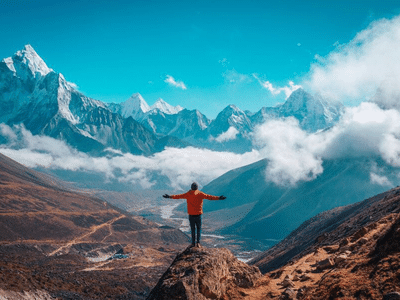
Ascend to the iconic Nangkar Tsang / Dingboche Viewpoint for panoramic vistas of Mount Everest, Lhotse, Cho You, Makalu, and Ama Dablam.
Traverse through Sagarmatha National Park, a UNESCO World Heritage Site and witness some rare wildlife like Himalayan Snow Leopard, Red Panda and Musk Deer.
Immerse yourself in the local Sherpa culture, visit ancient monasteries and interact with friendly communities in quaint villages.
Trek along rugged terrain, crossing suspension bridges and alpine forests, offering a thrilling experience amidst snow-capped peaks.
Conquer Kalapathar's summit as a part of the Everest Base Camp trek, for unparalleled sunrise views.
- All foreign nationals must share their passport and visa details at the time of booking, and also upon arrival.
- Do not bring non-bio gradable materials.
- Pay heed to the instructions given by the trek leader and guide.
- Consumption of alcohol and other intoxicating substances are strictly prohibited.
- Since Kathmandu-Lukla flights are dynamic, we recommend you keep a buffer day in hand.
- ID proof Is Mandatory ( Passport, Driving License, Voter ID ) Either One Of them Is Required.
- There are no ATMs in Lukla, so one is advised to carry enough money with them in case of need for an emergency. And even for buying trekking equipment in Kathmandu. It is one of the best and cheapest places to buy the same.
- Tea is very expensive at Everest. But getting hot water won’t cost you much. Carry your own tea bags to be used while on the EBC trek.
- Be prepared for extreme weather conditions, All accommodation on the trek to Everest Base Camp is in small tea houses, run by the local Sherpa people or Mountain Lodges. There are options for showers lower down on the trail, if you decide to use them, however, many people keep clean by using baby wipes and a bowl of warm water each day. The toilet situations can be difficult at times, as in the tea houses they are generally not Western-style toilets, rather just a hole in the ground instead of a toilet bowl.
- Warm clothes, sunglasses, trekking boots, gloves, trekking stick, woolen caps among other trekking equipment you want to carry. However, the most important thing to bring is a good pair of trekking shoes that you have hiked in previously. Kathmandu is a great place to buy trekking clothes that are both cheap and of decent quality. If you can bring your own sleeping bag otherwise you can rent one for about 500-600 rupees a day.
- If it’s sunny you might be surprised at how warm it can get during the day. Most trekkers wear t-shirts and shorts for the first few days while the elevation is still low. When the sun sets the temperatures drop quickly. Wear a warm hat while sleeping and take a Nalgene bottle filled with hot water and keep it in your sleeping bag to stay warm.
- Make sure to drink plenty of water while on the trek. Do carry extra water bottles with you at all times.
- A headache can be one of the first signs of altitude problems. Do carry suitable medications for the same. Small headaches are common and should not stop you from trekking or worry you. However, if it persists or increases, it might be advisable to ascend or even trek down.
- Taking care of your skin and eyes are important. Sunburns happen much quicker at high elevation so make sure to apply sunscreen a few times a day and wear a hat. Sunglasses are a must-have and if you wear prescription glasses it’s good to come to Nepal with a pair of prescription sunglasses or at least a clip-on.
- Layering allows you to easily regulate your body temperature and stay comfortable while Mount Everest trekking. It’s even better if your layers have zippers so that you have even more control of your body temperature.
- EBC trek is one of the most beautiful Himalayan treks. So much so, that one would want to stop at every step and take pictures to make memories for life.
- In the cold, your batteries will die much quicker than they do at home. This holds true for basically every kind of electronics you'll be using from phones to cameras to kindles. While some of the tea houses allow you to charge things, they all charge you for it (some more than others). An easy way to avoid this is to bring spare batteries and a portable charger.
- Itineraries are based on information available at the time of planning and are subject to change. "Thrillophilia'' reserves the right to change expedition dates, people or itineraries as conditions warrant If a trip must be delayed or the itinerary changed due to bad weather, road conditions, transportation delays, government intervention, airline schedules, sickness, or other contingency for which Thrilllophilia or its agents cannot make provision, the cost of delays and/or other changes are the responsibility of the participant. Thrillophilia reserves the right to decline, or accept, any individual as a trip member for any reason whatsoever.
- Liability for change in itinerary due to reasons beyond our control like a change in flight and train schedule, cancellation of flights/1trains, political disturbances, natural phenomenon, roadblocks, etc. will not be accommodated in the package cost. No bill will be reimbursed for any missed service/facility.
- During a trip, in case the roads are blocked due to landslides or a reason that is beyond control, Thrillophilia will rearrange the itinerary for the travellers real-time, however, the cost of alternative accommodation will be borne by the customer as the hotels pre-booked execute their cancellation policies and are nonrefundable.
- Because of any reason natural or personal, if the Trek or a particular activity is not completed, no refund will be processed.
- The difference in the cost shall be borne by the client in case of any amendment in the package due to change in the number of guests, hotel change, itinerary change, etc.
- If in case any traveller wants to or decides to leave the trip in the middle, all the expenses from that point onwards will be borne by the traveller. Neither the operator nor Thrillophilia will be held responsible for such decisions or for any refund.
- The refund or compensation is also not issued if for any reason you have to come down from the trek. The trek leader may send you down from the trek, owing to reasons like lack of fitness, AMS, blood pressure, turn-around-time, health issues, or if you are found smoking/ drinking, or breaking the rules of the trek. refund or compensation are issued only when the whole trek is cancelled or called off on behalf of Thrillophilia.
- At Thrillophilia, we almost never call off or cancel our treks. But in the rare event we might have to call off or cancel a trek due to any unforeseen natural catastrophes like continuous rain or snow, thunderstorms, snowstorms, landslides, floods, earthquakes, or any other natural calamity or other issues like local riots, curfews, pandemics, lockdowns, government orders, or any such situations that might prevent a safe trekking experience. In such cases, Thrillophilia will issue a Credit note summing up to the same amount as your trek fee that can be redeemed on any of the treks over a period of the next year.
- Rescheduling Policy for Private (Standard & Deluxe Package) & Group Bookings: 1) If rescheduling is made 7 days after the Booking Date till 15 days prior to the Date of Travel then 30.0% of the total tour cost will be charged as rescheduling fees. | 2) If rescheduling is made 0 days to 15 days before the Date of Travel then 100.0% of the total tour cost will be charged as cancellation fees. | 3) If bookings are made 15 days before the Date of Travel no rescheduling & modifications will be made.
- Rescheduling Policy for Private (Super Deluxe) & Hotel Specific Bookings: No modification or Rescheduling will be catered. A standard cancellation policy will be applicable for such cases.
- Force Majeure: In cases of force majeure events (e.g., natural disasters, political unrest, or other unforeseeable circumstances), [Thrillophilia] reserves the right to reschedule Tours & treks or offer alternative itineraries to ensure the safety and well-being of clients and staff.
- Cancellation After Rescheduling: Clients who reschedule their tours or treks but later decide to cancel will be subject to our standard cancellation policy. Any rescheduling fees paid will be non-refundable.

Brief Overview of the Trek
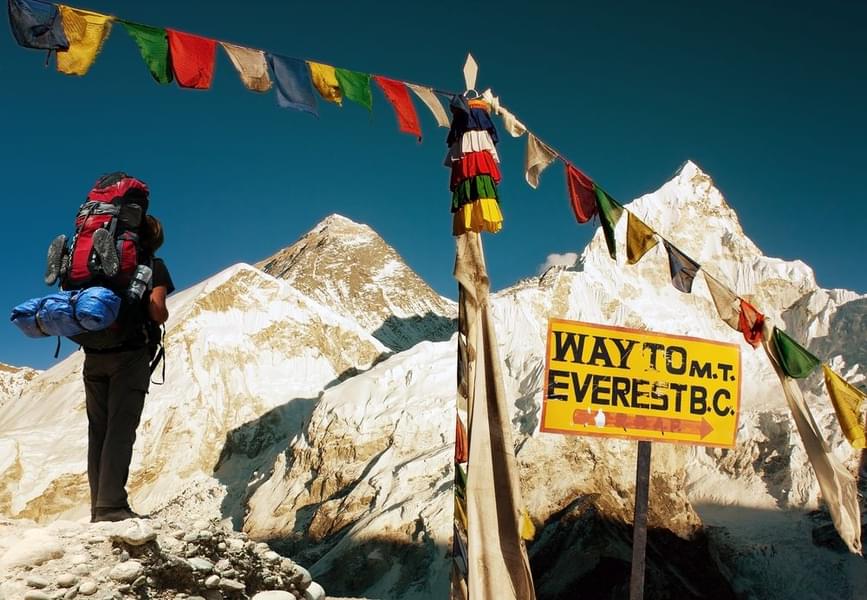
- Maximum Altitude of Everest Base Camp - 18,513 ft
- Duration - 8 Days
- Trekking Distance - 130 Kms
- Trail type - Difficult
- Airport - Tribhuvan Domestic Airport, Kathmandu
- Snow Season - Winter, usually starting in the month of November
- Service Available (in months) - throughout the year
- Base Camp - Lukla
- Best Season - April to early June and September to mid-December
- Region - Nepal
- Who Can Participate - The minimum age required to embark on the most thrilling trek is 15 years. The maximum age for this trek isn't specified, however if you're above 70, it would be advisable to proceed with extreme caution.Participants are required to have previous experience of at least one high altitude trek of upto 5,000/16,400 ft.
Short Glance At Itinerary For Mt. Everest Base Camp Trek
Day 1: It would be a 2 to 3 hours long trek from Lukla to Monjo.
Day 2: Move from Monjo towards Namche Bazaar over a trek of 2 to 3 hours.
Day 3: Stay at Namache for the purpose of acclimatisation. A short stroll of 20 to 30 minutes to Namche Museum.
Day 4: It would be a long day, when you walk to Phunge Tenga from Namche in 3.5 hours, then to Tengboche Monastery in an additional 2.5 hours. Stay at Deoboche village.
Day 5: A 3 hour long trek from Deoboche via Pangboche. Another 2.5 hours trek to the village of Dingboche.
Day 6: It would be the no-trek day. But you may explore the local sightseeing locations.
Day 7: You’d aim to reach Lobuche by crossing Dudh Koshi river.
Day 8: From Lobuche the trek to Gorak Shep would be arranged. It would take 5 to 7 hours to reach the Base camp and after spending some time there a return to Gorak Shep would be accomplished.
Day 9: Descend back to Kala Patthar from Gorak Shep in around 3 hours.
Day 10: Further descending to Namche Bazaar in a few hours long trek, crossing places like Tengboche and Phungi Thanga.
Day 11: The last trek of 5 hours to Lukla from Namche Bazaar.
Day 12: Transferred back to Kathmandu from Lukla.
EBC Trek Detailed Itinerary
Everest Base Camp trekking is a 12 days long expedition and the itinerary of each day is meticulously planned. Therefore, it’s advisable to read the layout of each day plan while choosing for the programme.
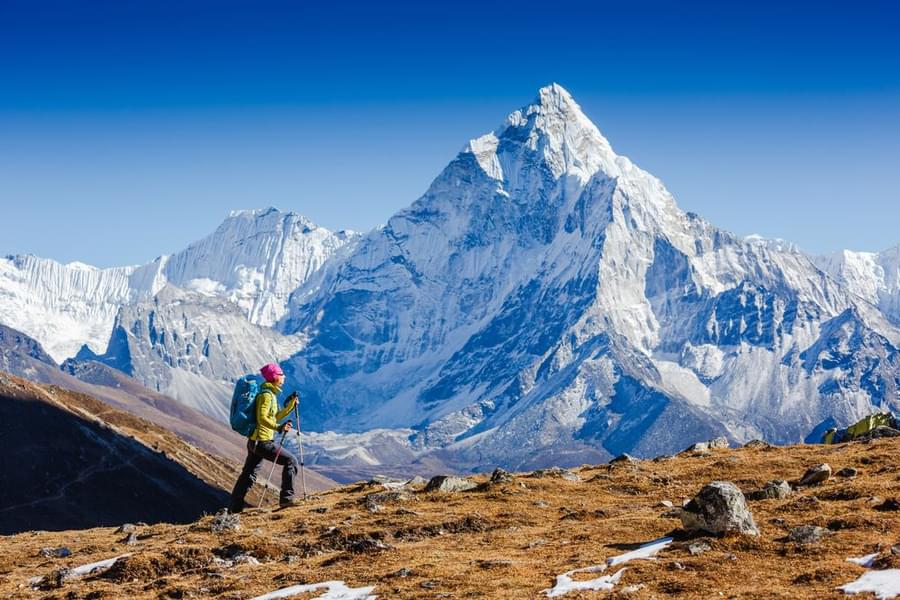
Trek Distance: 7 Kms | Duration: 3.5 Hours | Elevation: 2652m
A picturesque flight awaits us as we leave Ramechaap for Lukla, the entry point to the Everest region. With only one runway and a perilous location atop a cliff, this airport ranks among the most risky in the world.
When you get to Lukla, you will meet our representatives waiting to greet you.
Your first hike to Phakding begins after lunch as you follow the Dudh Koshi river's banks.
At Phakding, you spend the night.
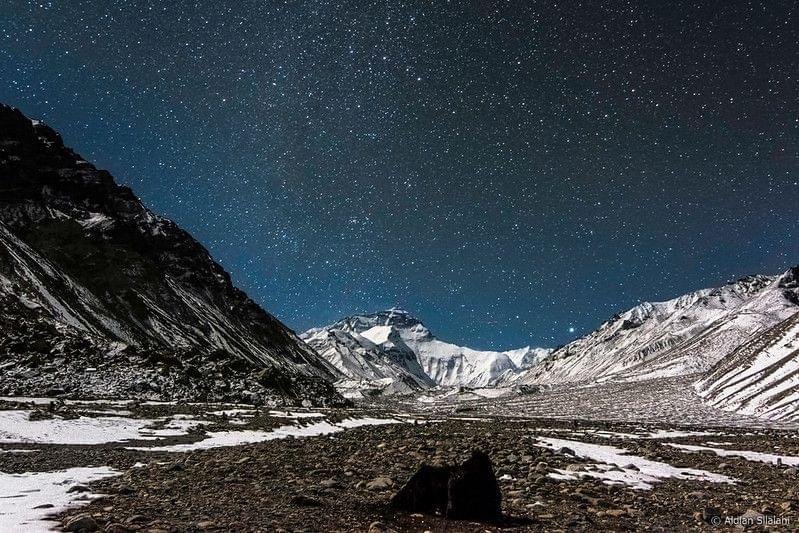
Trek Distance: 10 Kms | Duration: 4 Hours | Elevation: 3440m
Prepare for the journey to Namche Bazaar after breakfast.
Huge, verdant mountain ranges frame the path, and the rivers Dudh Koshi and Bhote Koshi can be seen below on their respective suspension bridges.
You'll be stopping for lunch at Monjo, so stock up on nutritious necessities before continuing on to Namche, as this is the final place to eat before reaching that city.
Ascend a steep trail after receiving your Sagarmatha National Park permits at Jorsalle till you reach Namche Bazar.
On the side of a mountain shaped like an arch, you'll find Namche, the region's traditional commercial hub.
You'll be spending the night in Namche Bazaar.
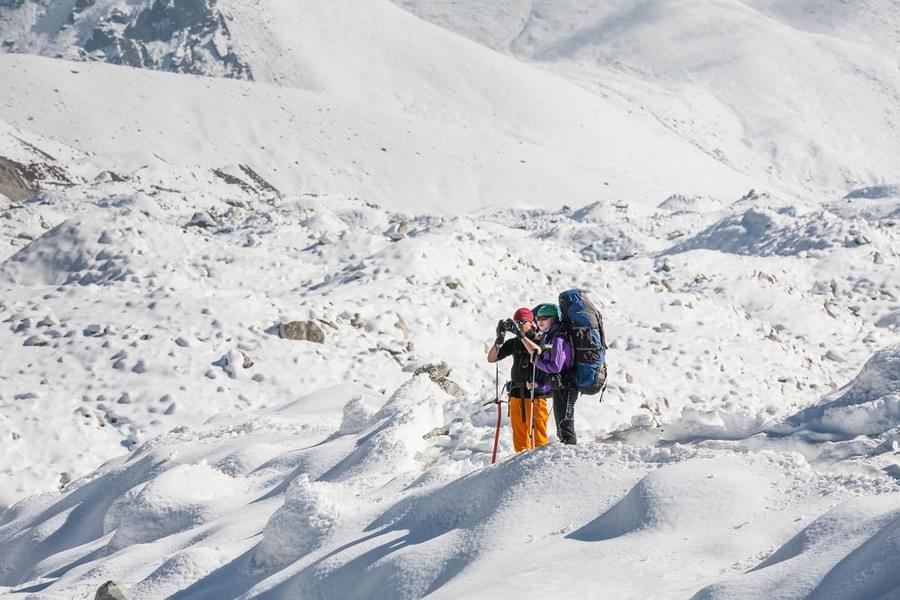
Elevation: 3440m
The whole day you would stay in Namche for acclimatisation.
Spend the day sightseeing, shopping for essential items, exploring coffee shops and bars and finally dining a sumptuous meal at the restaurants.
At Namche Museum there is a lot to know about the history of the place which you can stop by while exploring the colourful Namche Bazaar.
Spend the night in the Mountain lodge/ stay houses of Namche.
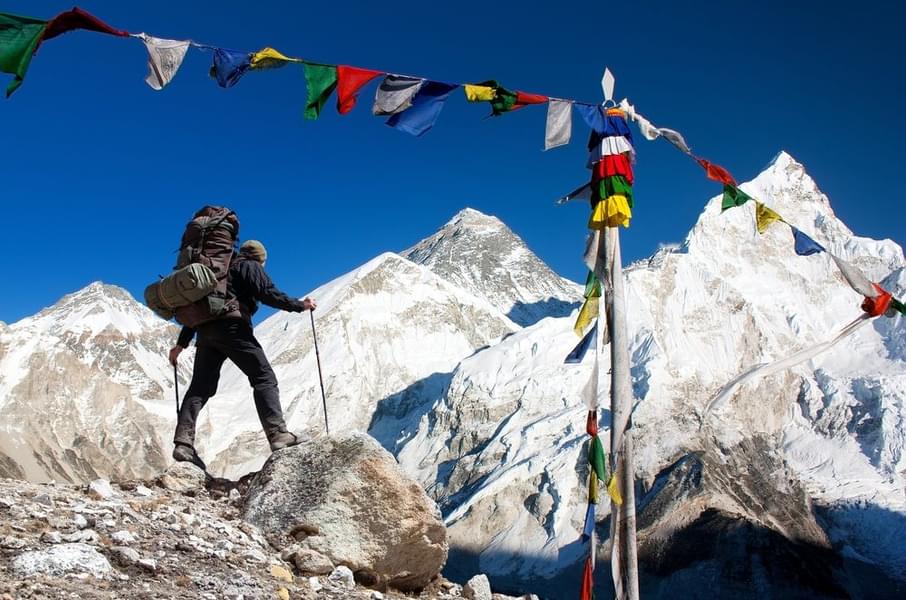
Trek Distance: 8.6 Kms | Duration: 5 Hours | Elevation: 3860m
Have a hearty breakfast, and then pack up your things for the day's hike to Tengboche.
Take it slow on this flat and easy trail with stunning views of the Himalayas.
Explore the region and look for native animals like the Himalayan tahr and the monal.
Eat lunch in Phunki Tenga, a little town with teahouses and military outposts.
Discover the Khumbu region's largest Buddhist monastery, Tengboche, at the top of the mountain.
Reaching up to Deboche, make yourself comfortable and eat dinner in your house.
Spend the night in the peaceful town of Deboche, home to a number of monks.
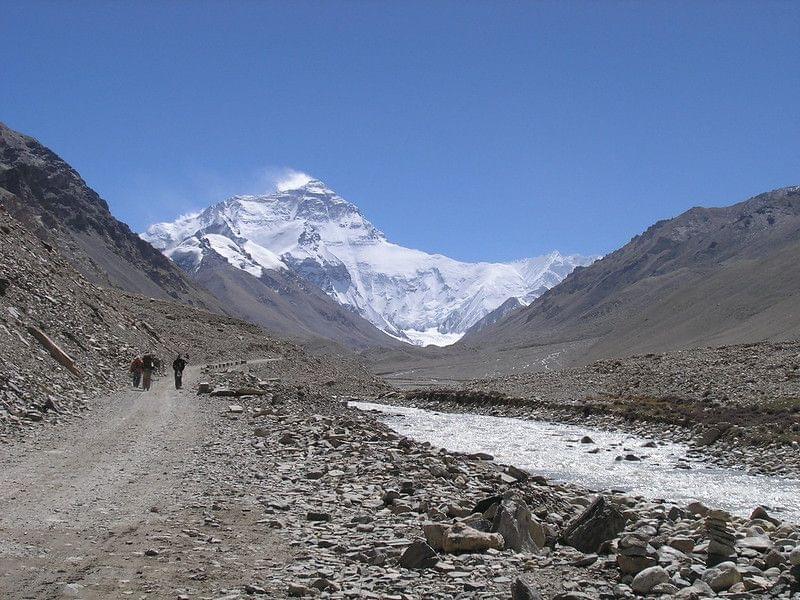
Trek Distance: 11 Kms | Duration: 6 Hours | Elevation: 4360m
The next in the itinerary of Everest Base Camp trekking is passing the village of Pangboche through the Chortens and Mani walls.
In the village is located The Pangboche Monastery, where you’d find the fragmented mummified hand and the legends say that it came from a Yeti.
You would get tired after walking for 14 kms in upto 4 hours, then a lunch treat at Imja valley is a must before descending to Lobuche River.
Night stay would be arranged in Dingboche village for the day.
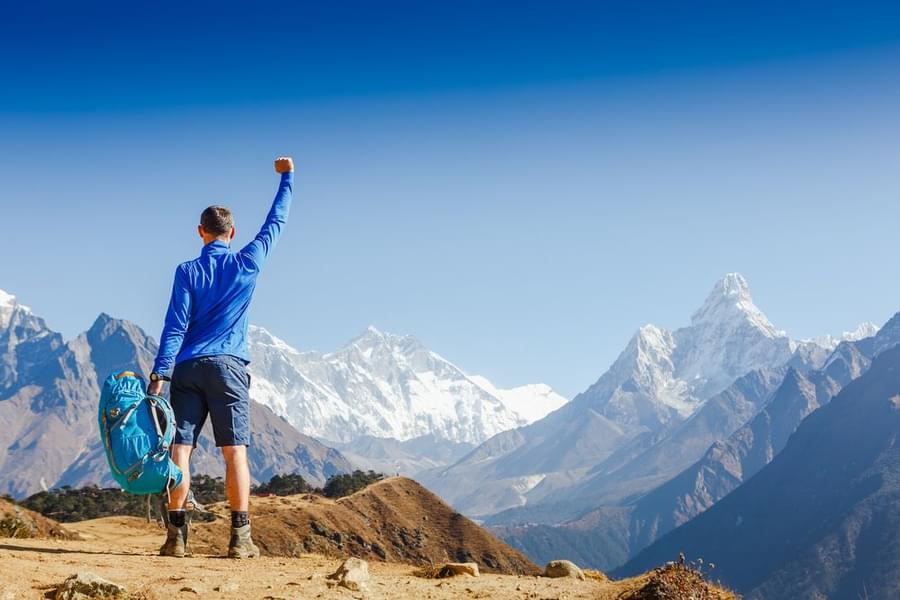
Elevation: 4360m
This another day would be spent in Dingboche for the purpose of acclimatisation and giving yourself some rest.
You would trek upto the sightseeing location of the world's top three mountain peaks- Mount Lhotse, Mount Makalu and Mount Cho Yu.
A perfect night stay would be arranged in the stay houses of Dingboche.
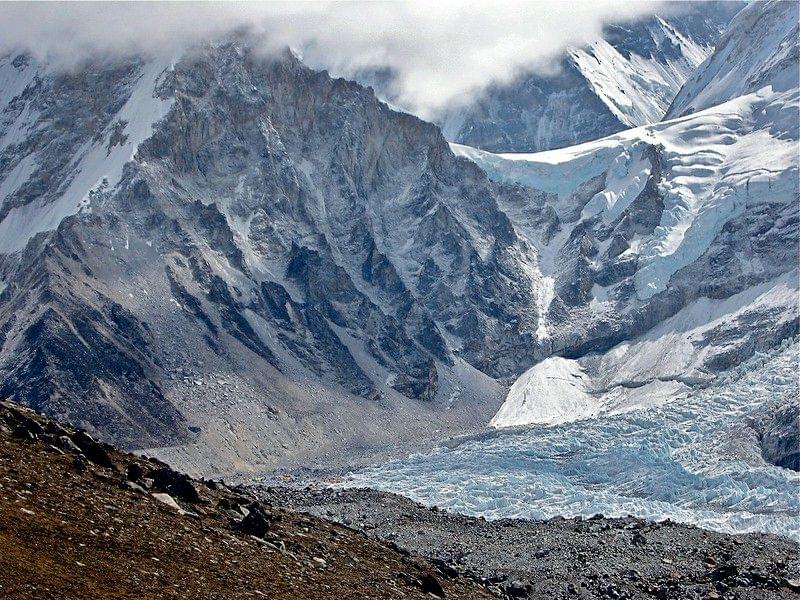
Trek Distance: 18 Kms | Duration: 4.5 Hours | Elevation: 4940m
You would leave Dingboche on day 7, to trek upto Dusa and along the edge to Dughla town.
While dragging yourself along the flat trail till Dughla you’d get to embrace the most beautiful Mount Everest base camp views of the expedition.
As you keep walking innumerable pinnacles like Taboche (6,542m/21463 ft), Cholatse (6,440m/21129 ft), Ama Dablam (6,856m/22493 ft), and Lhotse (8,516m/27940 ft) would cross your path.
After strolling 18 kms for over 4.5 hours across Dughla pass, you would reach Lobuche.
Finally, concluding your day at a height of 4940 metres, enjoy a tea and your stay at Tea House/ Mountain Lodge at Lobuche.

Trek Distance: 23 Kms | Duration: 6 Hours | Elevation: 5634m (Everest Base Camp)
It would really prove to be an adventurous day when you cover the longest trek so far through narrow mountain gaps with glacial moraines reflecting the morning sunlight alongside world’s highest Khumbhu glacier.
You would finally set your foot at the base camp after a 23 km long trek. After a brief lunch break before resuming the journey of Everest Base Camp trekking, as you reach the destination and enjoy every spilling emotion of happiness, victory captures every moment well.
After a 6 hour long trek and covering a trail upto the height of 5634 metre you would finally come back to Gorak Shep and stay there overnight.
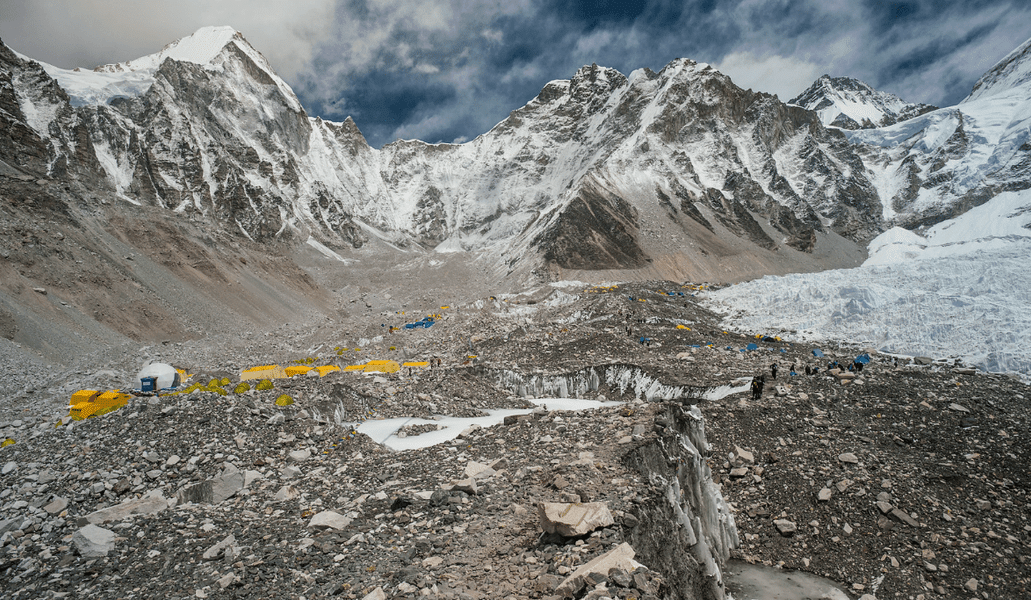
Trek Distance: 11 Kms | Duration: 3 Hours | Elevation: 5550m (Kala Patthar)
After a tiring and long day, on the 9th day a short trek of 11 kms to Kala Patthar would be arranged.
You’d experience the beauty of an extraordinary sunrise view at an altitude of 5550 km which would compensate for all your hard work.
A trek back to Gorak Shep to enjoy a warm breakfast would conclude the day. After coming down to Pheriche, you’d have an overnight stay there.
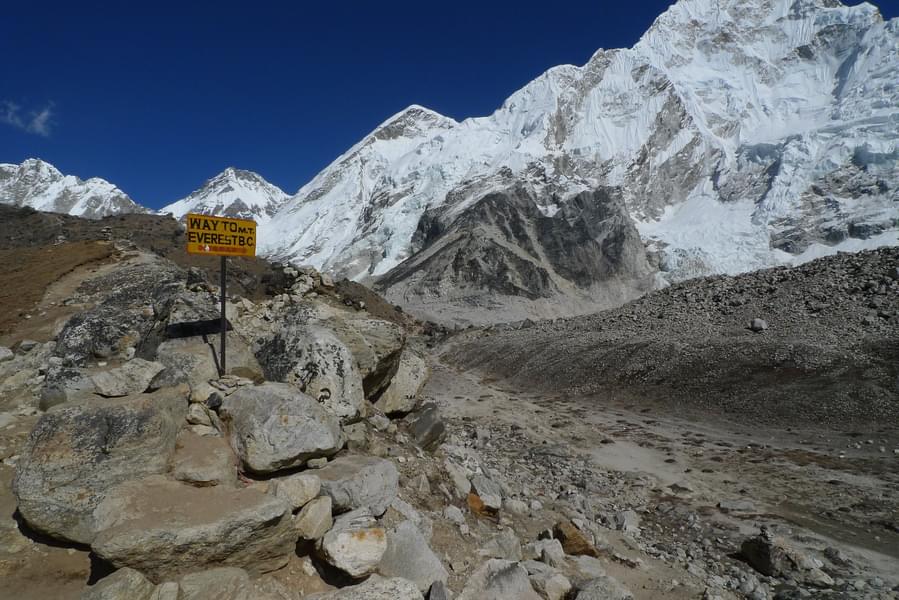
Trek Distance: 19 Kms | Duration: 5.5 Hours | Elevation: 3440m
Descending the steep mountains would be fun, after a tasty breakfast at Pheriche you would come back to Namche after a 19 km long trek.
The 5.5 hour long trail would take you through Orso Somare and Pangboche tracing the west bank of Imja River.
While coming down to Namche Bazaar you would get through the dense forest of Tengboche and descend to Phunki Thengafor, where you would rest overnight.
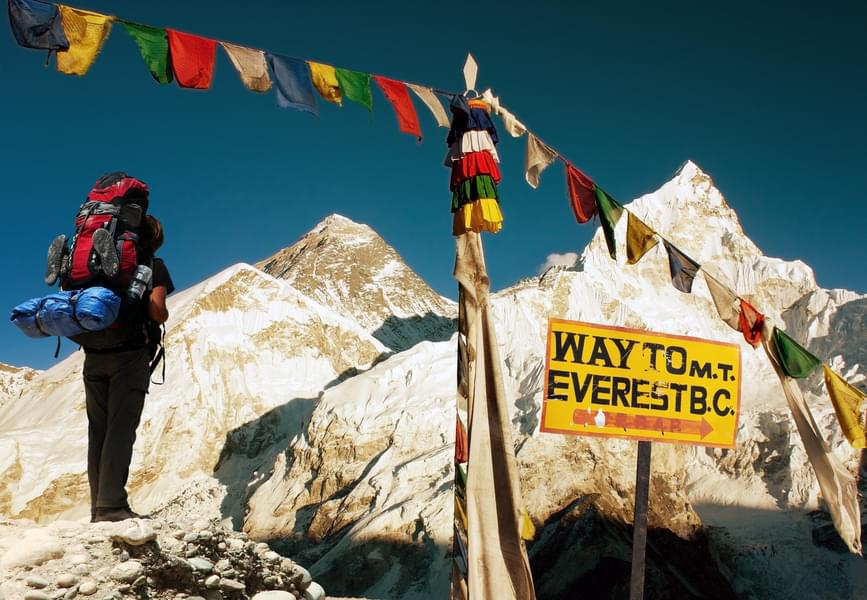
Trek Distance: 18 Kms | Duration: 5 Hours | Elevation: 2800m
This would be the last day of trek, the challenging and soul stirring journey of Everest Base Camp trekking would be completed after descending a distance of 18 km.
You would cross over the Dudh Koshi river and take a descent route to Jorsaley national park while enjoying the blissful scenery en-route.
The trek would be headed towards Lukla via Phakding, where you would conclude the accomplishment of the most adventurous trek of Asia.
Spend a camp night at Lukla one last time and enjoy the peace and beauty of its night before returning back to your hay day life in cities.
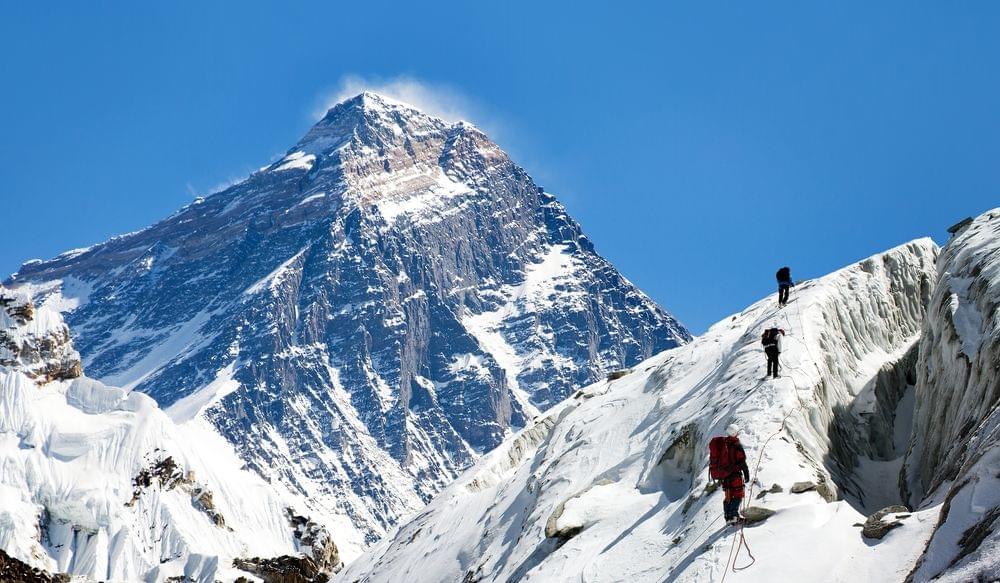
- From Lukla, you would fly back to Kathmandu with the last glimpse of the heart melting views of Himalayas. Before finally moving back to your hometowns, take a last stroll around colourful backpackers hub Thamel.
Everest Base Camp Trek Packages
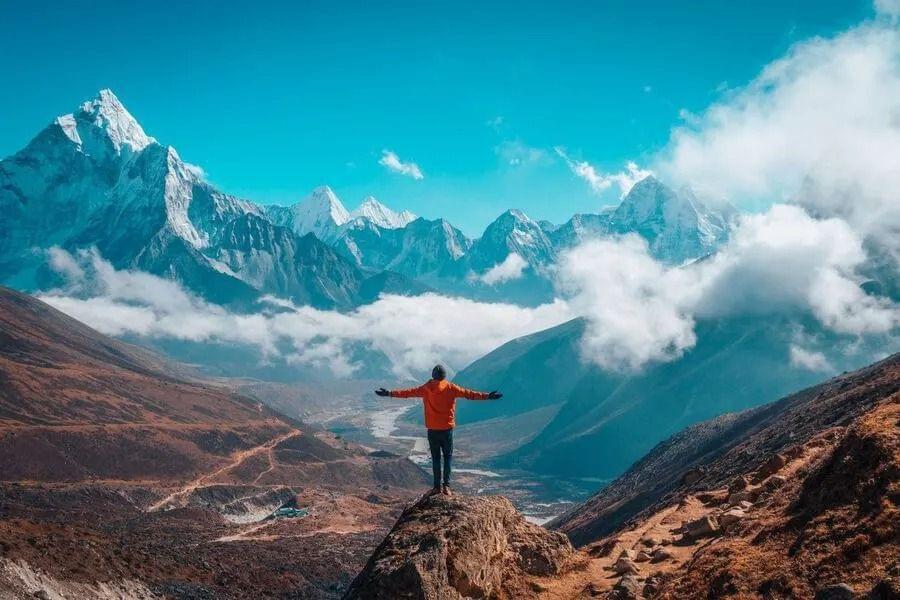
You are only a little distance away from reaching the world's summit. Cross "Trek to Everest Base Camp," a.k.a. "The World's Most Adventurous Hike," off your list.
Price Inclusions
Stay: Included in the price is your lodging in local Tea Houses or Mountain Lodges for the duration of your tour (11 nights).
Activities: Traveling to the foot of Mount Everest is a bucket list item for many.
Guide: During the trek, you'll be assisted and guided by a certified trek leader and a Sherpa. Each hiker may have their porter carry a maximum of 10 kg.
Permits: Permission to trek in Sagarmatha National Park, often known as a TIMS card. Permission to Enter the Khumbu Area. Inclusion of all federal, state, and local levies.
Transfers: Flights within the country, for transfers (Ramechhap- Lukla -Ramechhap)
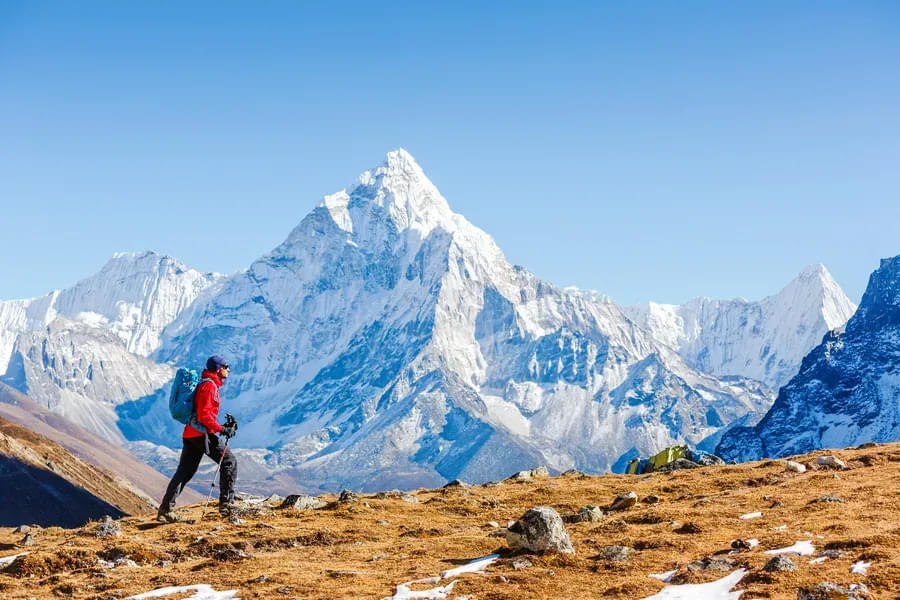
You are only a little distance away from reaching the world's summit. Tick off the most daring Everest Base Camp Trek from your list.
Price inclusions
Stay: Tea Houses and Mountain Lodges for lodging throughout the tour (11 nights). Kathmandu hotels for overnight stays (02 nights)
- Activities: Journeying to the foot of the highest peak in the world
- Guide: All the way through the trek, you'll be assisted and guided by a certified trek leader and a Sherpa. Each hiker will have one porter carry up to ten kilogrammes of gear.
- Permits: Permits to trek in Sagarmatha National Park, also known as a TIMS card. Permission to Enter the Khumbu Area. All local and governmental fees.
- Transfers: Transportation to and from Kathmandu's airport. Pickup and Drop-Off at Ramechhap's Manthali Airport. Local flights (Ramechhap - Lukla - Ramechhap)
What to Pack for Your Everest Base Camp Trek?
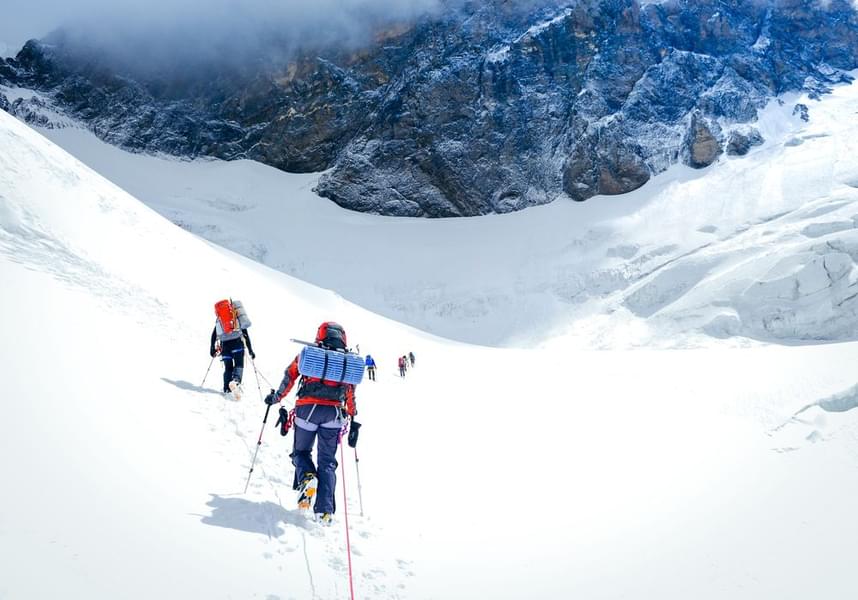
- Heavy fleece or down jacket
- Moisture-wicking long-sleeve t-shirts
- Gortex or waterproof jacket with hood
- Fleece pants
- Moisture-wicking short-sleeve t-shirt
- Windbreaker
- Hiking shorts
- Trekking pants
- Waterproof pants
- Hiking socks
- Long underwear
- Warm thermal socks
- Sock liners
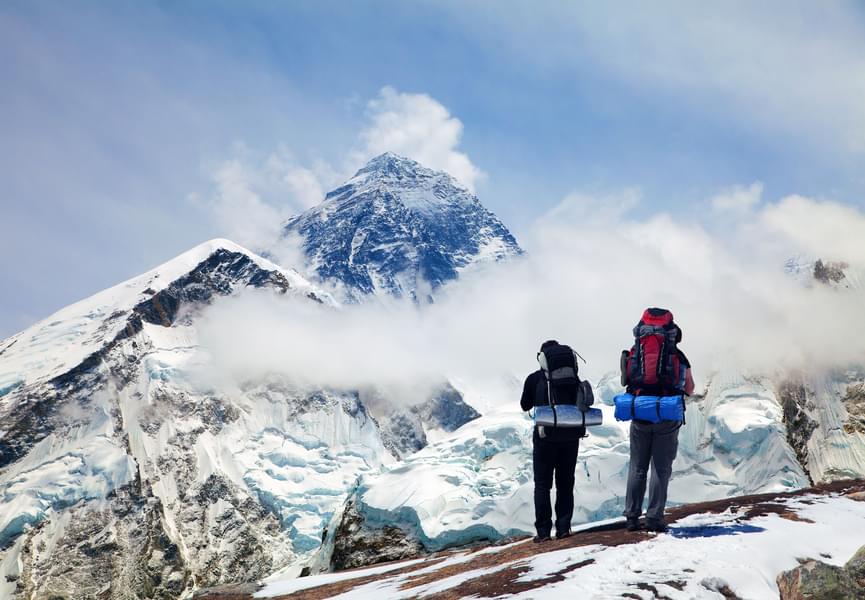
Toilet Paper
Lip balm with sunscreen
Advil or Ibuprofen
Antibiotics (Cipro for travellers’ diarrhoea)
Medical tape, Moleskin, duct tape for treating/preventing blisters
Diamox (for altitude sickness)
Anti-chafe balm
Diaper rash cream (Can treat rashes or chaffing)
Personal prescriptions
Toothbrush/toothpaste
Hand sanitizer
Razor (as needed)
Face lotion
Feminine hygiene products
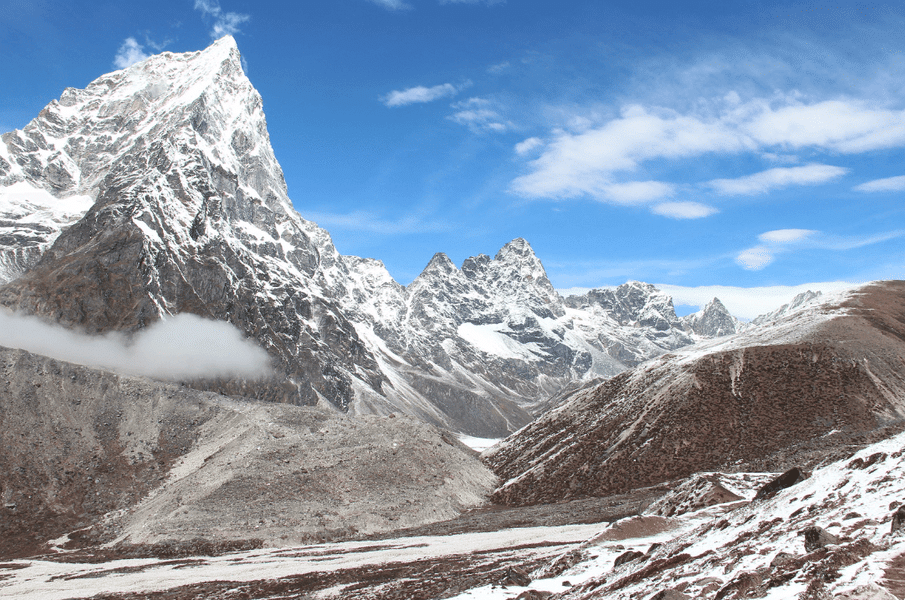
Duffle bag for carrying gear
Trekking Gear & Supplies
Water bottles or hydration bladder
Waterproof cover for daypack
40L Daypack
Lightweight water filter or iodine water tablets
Travel pillow or pillowcase
Headlamp with extra batteries
Sleeping bag rated to -18°C/ 0°F
Hand warmers
Camera with extra batteries and memory cards
Quick-drying trekking towel (optional)
Small lock(s) for duffle bag and daypack
Sleeping bag stuff sack
Drybags in several sizes
Stuff sacks for dirty clothes/shoes
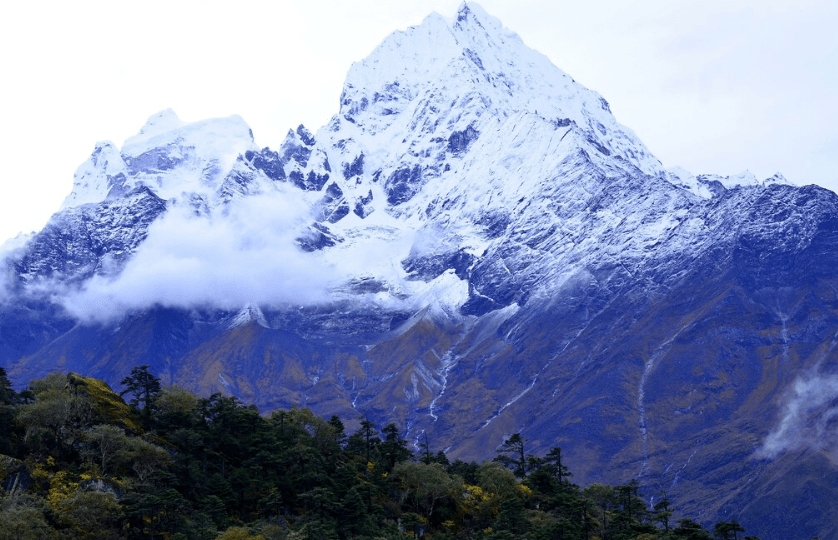
- Snacks & Food
- Rehydration powder or gels
- Snacks (combine protein & carbs)
- Thermos (optional for hot beverages)
- Important Documents
- Passport (needed at entry gate for registration)
- One passport-size photo
- Travel insurance
- Money ($200-300 cash is recommended)
- Additional Supplies
- Journal/pen
- Playing cards
- Portable solar charger/power bank
Know Before You Go to EBC Trek
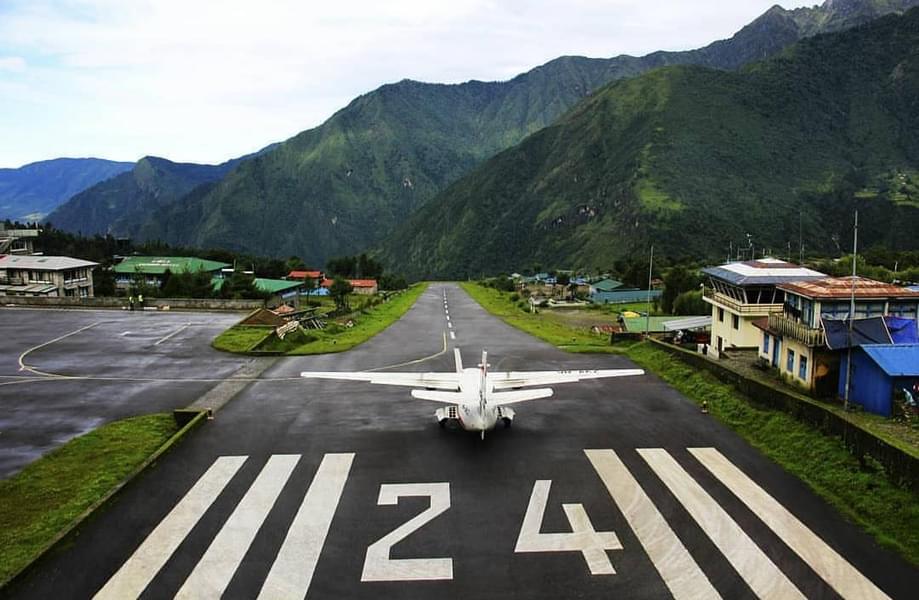
Taking the 25-minute flight to Lukla from Kathmandu is the most convenient route to the Everest base camp. Due to ongoing repairs and renovations, however, flights between Kathmandu and Lukla are now departing via Ramechhap Airport (Manthali Airport) instead of the original route. Jiri is also accessible through road, which can be taken to continue on to Lukla. Additionally, a helicopter service is available to transport you from Lukla to Kala Pathar. To get to the base camp, also known as Gorak Shep, from Lukla, you'll have to pass through Phakding, Namche Bazaar, Thyangboche, Dingboche, and Lobuche.
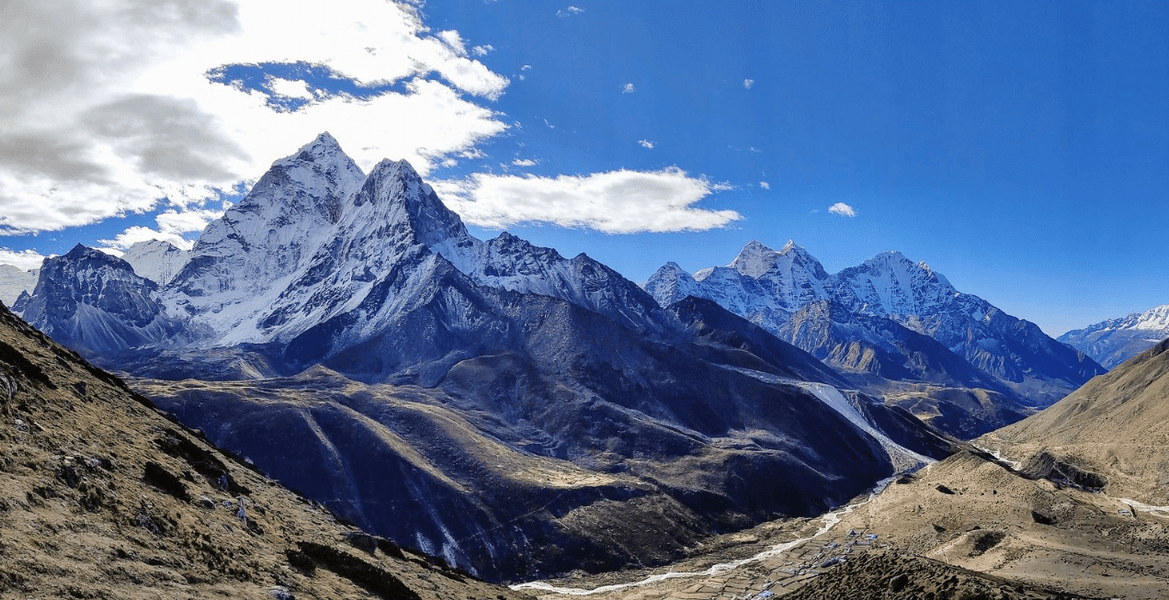
Anytime from late May and mid-Sep is the ideal time to visit Everest Base Camp. The best times to embark on a hike are between the months of September and November, or February and May, when the weather is relatively predictable, the views are unobstructed, and the temperature at Base Camp rises to a comfortable minus six degrees Celsius. At the end of April or the beginning of May, you might also run into teams of mountaineers at Base Camp, getting ready for their summit bids on Everest. Although the temperatures between late November and early February are exceptionally low—around -15°C during the day and even lower at night—clear skies are typically the norm, and quieter routes and teahouses add to the exhilarating sense of untamed remoteness.
It is possible to walk to Everest Base Camp in January even if there may not be much snow, but it is freezing.
- February and March
Nighttime temperatures in February and early March can drop to roughly -20°C, but clear skies should allow you excellent visibility of Everest during this time. In addition, there will be fewer people on the path, and the teahouses will be more peaceful, making the journey to Base Camp feel more like an expedition.
- March and April
March and April are peak hiking months because of the higher temperatures and the abundance of rhododendrons and other flowers further up the trail. The lengthening of the days means there will soon be plenty of time to go sightseeing, especially since the early mornings will be bright and clear. Late in April, you might see climbers in Base Camp acclimatising before starting their ascent to Camps I, II, and III on Everest's slopes, and then making an attempt at the summit.
In early May, just before the monsoon, you can still make the trek to Base Camp, though you may have to share the area with mountaineers who are engaged in a series of 'rotations,' in which they climb higher and higher before retreating to Base Camp to rest and recoup before attempting to reach the summit.
- June July and August
The monsoon season in Nepal begins in late May and continues through the months of June, July, and August, into the beginning of September. Trails are muddy and infested with leeches, the mountains are frequently shrouded in cloud, and landslides are regular and disruptive to travel during the rainy season, even though it may not rain continuously throughout the day.
- September, October and November
Towards the end of September, as the monsoon winds down, the autumn trekking season begins. The weather is perfect for hiking in the months of October and November, thanks to the lack of precipitation and the resulting abundance of clear skies and clean air. Daytime highs are around -10 degrees Celsius at Base Camp, which is cooler than the spring season, but the days are dry and the scenery is beautiful.
Even though it will be much cooler in late November and December (with nighttime lows well below freezing), these months are also ideal for going on a hiking adventure. People who want to avoid the cold will likely abandon their treks, which means the trail to Everest Base Camp will be much less crowded.
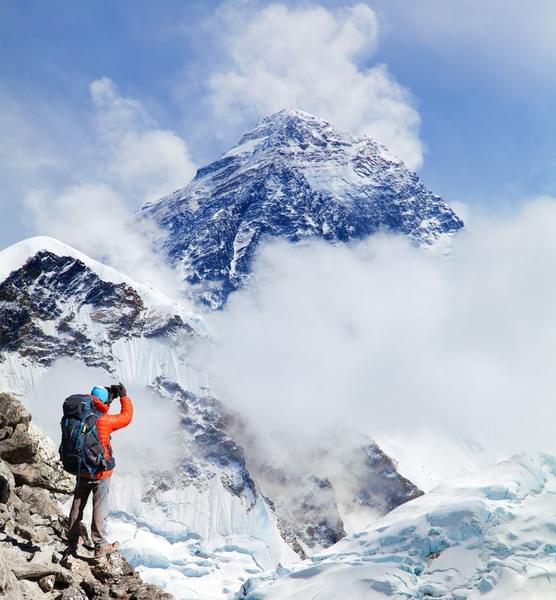
It is advisable to the trekkers to not bring any non-biodegradable material along and contribute to sustainable tourism.
While following the difficult Everest base camp trek, all the participants must follow the instructions of the trek leader and guide for their own safety.
Don't push yourself too hard; instead, take it easy and let your body relax and recuperate between daily hikes. Experiencing pain and exhaustion when hiking is inevitable, so make sure to get enough rest and take pain medication as needed.
All the participants are required to carry enough money at hand because you won’t find ATMs in Lukla at short distances.
Pack an efficient daypack with all the essentials like warm clothes, sunglasses, trekking boots, gloves, socks, woollen caps, medicines, rainwear, water bottles and other essentials
Before setting off on a trek, one of the most crucial things to consider is whether or not you have the proper gears. Thus double-check your gears to make sure nothing will let you down.
Take a note that sunburn at higher altitude might happen quicker, so keep your skin and eyes safe with moisturiser and sunglasses.
Keep extra batteries for head torch and other electronics handy as the batteries in cold might die quicker than at home.
- Don’t forget to carry water bottles along and keep yourself hydrated throughout the trek.
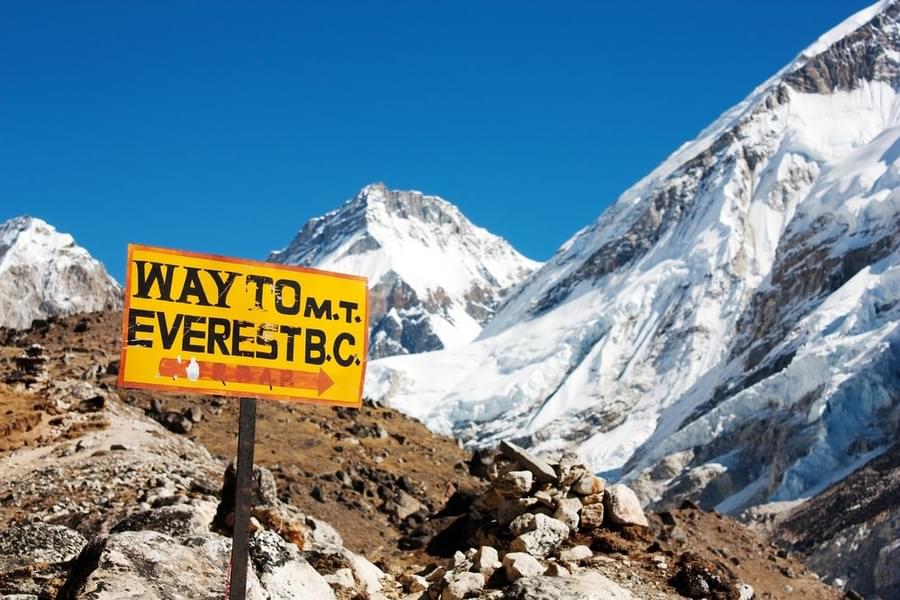
In order to reach Everest base camp, one can explore the various routes available. All the routes are unique, and adventurous in their own ways and ready to welcome you in their pleasant beauty while offering challenges simultaneously. However, here is explained the shortest route from Kathmandu to the base camp via Namche.
Kathmandu to Lukla ( 130-140 km) - The intriguing Everest base camp trek begins from Lukla which is the gateway to Everest region. In order to reach Lukla, you'd require to take a plane from Kathmandu and land at Lukla airport, one of the most risky airstrips in the world.
Lukla to Namche - After the commencement of the iconic trekking, As the trailhead and entry point for the EBC Trek, Lukla is where the journey begins. You begin your ascent from Lukla and hike to Phakding before continuing up to Namche Bazaar. Namche is a great tourist hub and is renowned for its breathtaking Everest view from a comfortable elevation.
Namche to Everest Base Camp- To reach the destination of base camp, on moving out of Namche trekkers would ascend to the villages of Pangboche, Tengboche, Dingboche, Lobuche and the renowned Gorakshep. The trail would continue for a minimum of 8-10 days.
General Trivia About EBC Trek

There are two base camps for Everest trekking, one in the North at Tibet and the other at South in Nepal. Everest Base Camp, in the Khumbu region of Nepal is the endpoint of this legendary trek for Everest.
While following the trek to the base camp you would pass the famous Sherpa village of Dingboche. It’s the home of Tenzing Norgay,the first person to climb Everest.
Edmund Hillary and Tenzing Norgay had marked the south base camp of Everest in Nepal and stored their supplies at the mountain base and that is how the Everest Base Camp was born.
Every trekker aspiring to climb Mount Everest makes sure to stop at Tengboche Monastery, which has the largest Buddhist gompa in the valley to light candles and seek blessings. Overtime, it has become a very significant ritual without which a trekking event won’t even be started.
Why To Go for Everest Base Camp Trek?
Everest base camp trek is one of the most sought-after trek routes where the trekkers from across the globe arrive to escape the fast cities and gain a valuable soul stirring experience. As they climb up the base camp in Nepal covering an impressive 17,598 feet height, not only do the trekkers overcome obstacles of the journey but also enjoy the serene splendid beauty of the mighty mountains. The trek is considered amongst the most famous treks in Himalayas for being towards the edge of the world's highest peak as well as due to the kind of adventure it offers. While following the trail one gets to enjoy the magnificent sights of mystical monasteries and Sherpa villages, the highlights of the trek would also include Kala Patthar, Gorak Shep and Sagarmatha National Park Museum.
You May Also Book
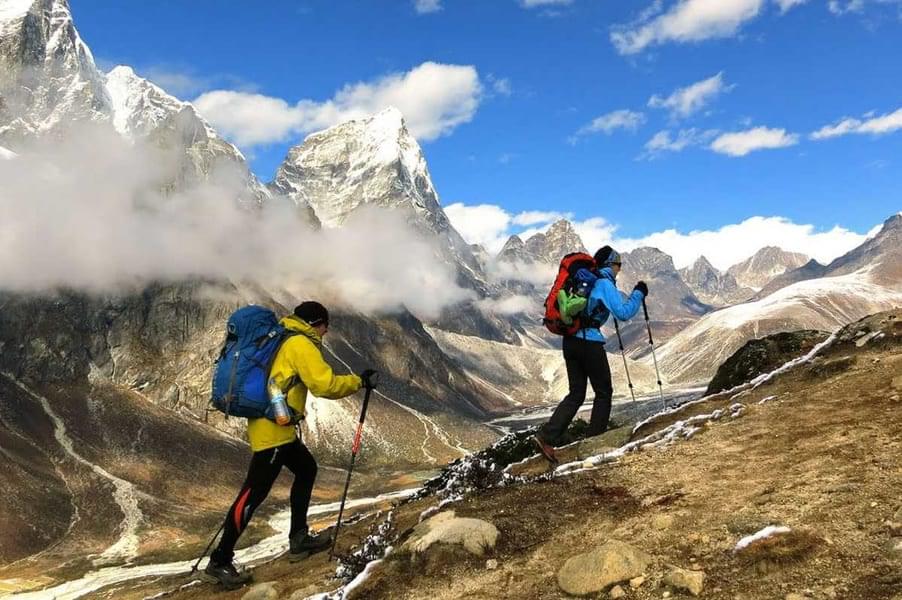
FAQ's of Mt. Everest Base Camp Trek
How difficult is the everest base camp trek.
The trek to the Everest Base Camp is among the most difficult treks in Asia. But, that shouldn’t discourage you from going on the trek because the difficulty level of the trek is moderate. The trail of the trek passes through the villages of Nepal which are located at higher altitude. The passage is diverse, sometimes quite harsh but other times smooth, therefore the trekker won’t require any expertise and past experiences in trekking for joining in. You would be walking 8 hours per day for a continuous 12 to 14 days to finally land at the formidable Khumbu Icefall. Therefore, it’s advisable to add a good exercise schedule in your daily routine as well, to keep yourself in physically good shape to not face any problem during the trek like cramps and fatigue. he basics like walking, jogging, squats and stair climbing would be sufficient though you may add other exercises as per your bodily requirements. Try to be consistent with the exercise schedule and keep repeating the exercises for longer duration.
What is the best time to go on a trek at Everest Base Camp?
The schedules for Everest Base Camp are arranged throughout the year, but the best and suggested months to plan a trek would be March to Mid June ( spring season) and September to Mid December ( Autumn season). The valleys and villages of Nepal become more beautiful and pleasant during these months and seasons of the year.
How many days are required for Mount Everest Base Camp trekking?
The level of difficulty of the trek is modest and it takes around 12 to 14 days to complete it via the route from Lukla where you land after an adventurous plane ride from Kathmandu. The usual route passes through the town of Namche, villages of Pangboche and Dingboche and Khumbu region to finally land at the Everest Base Camp.
What are the package inclusions of Mount Everest trekking?
A round trip between Kathmandu and Lukla via flight.
Accommodations throughout the trip are covered in the package.
Different sightseeing short treks would be arranged.
Entry permits for Sagarmatha National Park, TIMS and Khumbu region would be covered.
The essential facility of porters who would carry luggage weighing upto 10 kgs.
A basic medical kit would be provided during the onset of the trekking.
What is the total length of the Everest Base Camp trekking?
The total length of the trek is around 130 Km, with 65 Km falling on each side. This distance can be usually covered between 12 to 14 days at ease.
Do you need any special training for the Everest Base Camp trek?
The trek of Everest Base Camp is considered moderately difficult, but you won’t require a special training to participate in the trek. The trek doesn't involve a very steep mountainous trail, it also has smooth and shaded pathways which makes the passage pleasant to tread. You may still include a basic set of exercises in your daily schedule like walking, cycling, swimming and other such cardiovascular activities.
How much heavy backpack should you pack for Mt. Everest Base Camp trek?
Your backpack should have the capacity to carry at least 60 Litres of weight. Don’t worry if you have packed extra stuff, you would have potters accompanying you to carry at least 10 kg of your load.
What are the nearby places in Kathmandu which can be visited?
While going for a trek to Everest Base Camp and your stay at Kathmandu you can visit other nearby places like Pashupatinath Temple, a sacred hindu temple complex; Thamel, a local market place which is quite famous for its coffee; Garden of Dreams, it’s the perfect place to rejuvenate your spirits after the 12 days long trekking tour; and, at last you can visit Hanuman Dhoka Temple.
What is the Everest base camp height?
The height of the Everest base camp varies. Like, the camp will be located at 5,380 m (18,513 ft) on the south side of Mount Everest in Nepal if your climb is beginning from the south east ridge. When approaching the Kala Pathar from the Gorakshep valley, your base camp elevation will be 5,545 metres.
Which is better: Everest Base Camp or Annapurna Circuit?
Because it is a longer route overall, the Everest Base Camp trek is more difficult than the Annapurna Circuit trek.The Annapurna circuit is a little easier because the average height is substantially lower, and there are less hard ascents.
Is Everest base camp hard?
Yes, it is a moderately demanding destination. Usually, two weeks are needed for the trek. The EBC Trek doesn't necessitate any prior trekking experience, but it is recommended that the trekker be both determined and physically fit.
Can a beginner go to Everest Base Camp?
Yes, Absolutely, beginners can participate in the Everest Base Camp Trek. The trek to Everest Base Camp is recognised for its gentle gradients and only a few hard ascents, making it certainly doable by beginners as well.
How cold does it get at Everest Base Camp?
It is quite cold at the Everest Base Camp. There is perpetual snow on top of Mount Everest besides a lot of severe weather. At Everest Base Camp, you can easily anticipate a nighttime temperature range of -20 to -3 degrees Celsius.
How far is the walk from base camp to Everest Summit?
From Nepal's Everest Base Camp, the peak of Everest is another 20 kilometres away. About 40 or 45 days are needed to make the ascent to the top of Everest. This is because hikers have to set up at least four separate camps in different areas, supply each one with essentials like food and fuel, and then return to the original base camp.
More Treks in India
- Treks in Himachal
- Treks in Uttarakhand
- Treks in Ladakh
- Treks in Nepal
- Treks in North-East
- Treks in Kashmir
.png?w=auto&h=400)
The content and images used on this site are copyright protected and copyrights vests with the respective owners.

Everest Base Camp Trek
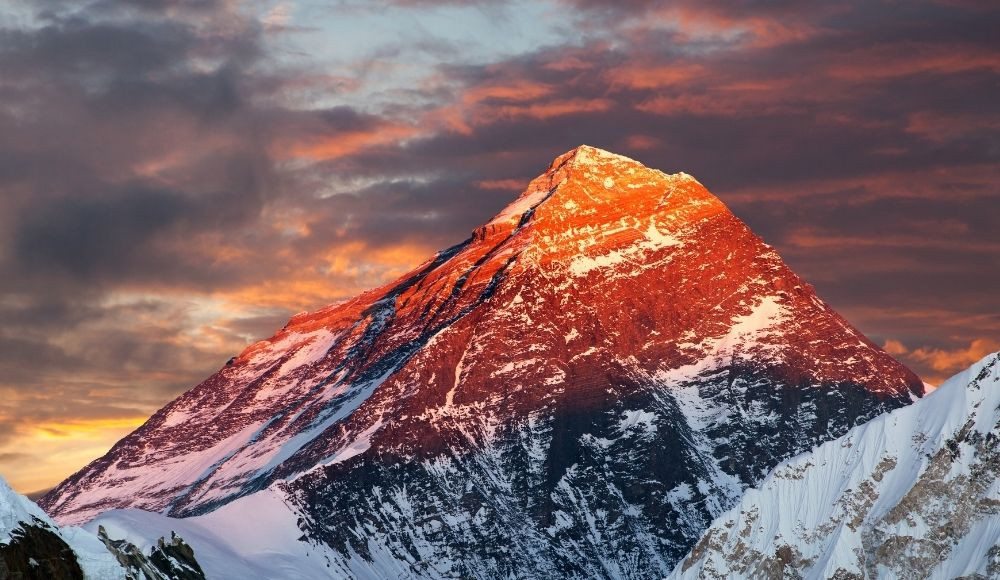
Share This:
Trip Highlights
- Scenic flight to Lukla, and the exploration of the Lukla market.
- Strolling around the Gateway of the Himalaya, Namche Bazaar.
- A subtle touch to the lifestyles of the Himalayan Heroes, Sherpa ethnic groups and their settlements.
- Passing through the various Suspension bridges; a nightmare to the acrophobic and trek alongside the great, roaring Imja and Dudh Koshi rivers.
- Multicoloured oscillating prayer flags, chortens, monasteries, mani walls and several others holding firm religious beliefs.
- Breathtaking views of the gigantic Everest, Amadablam, Pumori, Lhotse, Cho Oyu and many more peaks.
Trip Overview
Getting up to the pinnacle of the world’s roof might be the fantasy of many but not everyone can try it. So, to be closer to their wildest dreams, they go for the near vicinity of the mighty Everest. And this Everest base camp trek is all about it. It is a 14-day Everest tour in which you will roam around the charisma, glam, and glory of the Khumbu region . The Everest base camp trek is the most popular trek in the context of the naturally blessed and graced Nepal. When the word popular arrives, everyone gets that specific eagerness. Why so? It's because it is unique on its own. From the culture to the geography this trek has adequate diversity and this is what's responsible for its enormous appreciation and praise all over.
This trek to Everest base camp starts with the scenic flight to Lukla which is considered one of the scariest flights in the world. This arrival at the Lukla airport marks the beginning of your amazing journey in the Everest region which elevates up to the Kalapathar(5545 m), known as the highest point of this trek. There are various packages and trips designated for the Everest base camp trek. You can find plenty of them in various trekking companies but not everyone thinks of your comforts and physical endurance. So, concerning all the relatable circumstances with possible hindrances and your availability through convenience, we at Altitude Himalaya have arranged a 14-day itinerary for the infamous Everest base camp trek.
As you are trekking to the Everest base camp, you may have already inquired about the height of Everest , the best treks in the Everest region , and life, possibilities, and tourism in this region and likewise. So, I am not going up there as it is the very basics, but before joining any trek, you need to especially take care of the timing as timing determines the trek. Whether it will make it or break it. So, the most ideal time for the Everest base camp trek would be the Autumn and Spring seasons. In the Autumn season (September, October, November) the atmosphere will get clear providing outstanding visibility while in the spring (March, April, May) the weather will be good, neither too hot nor too cold making it the perfect time for the trekking. So, you can join this amazing Everest base camp trek during these periods. Additionally, before plunging on the Everest base camp trek, you need to look after your travel health insurance. Your present health insurance may not cover international travel and tour. As you are getting to an elevation above 5000m, there is a high risk of getting high altitude sickness during this trip. So, get nice health insurance prior, covering the helicopter services in case of an emergency too. This is something you must do before joining the trek.
In this 14 days Everest base camp trek, you will cover a total distance of 130 km from Lukla back to Lukla through varied topography and the plains. Here, You will pass through several rivers, streams, suspension bridges, woodlands, glacial valleys, high passes, and small mountainous settlements. Often asked by foreigners, where is Everest base camp? This Everest base camp trek has gotten the hype and needs not any advertisement amidst the mass. It is one exclusive feature of the Everest region scattered over the eastern territory of Nepal in the district of Solukhumbu. It is settled within the Sagarmatha national park which is also a national park inscribed in the world heritage site. So, not only the mountains but you can also peek into the flora and fauna abundant in this national park during this trek.
Talking about the flora and fauna, this national park is the habitat of the elusive Himalayan predator, the Snow leopard . Though it is very unlikely to encounter this wild beast, some lucky fellows may encounter this too. Apart from this, it also shelters many faunas such as Himalayan mouse Hare, Pikka, Himalayan Tahr, musk Deer, Snow cock, Bearded Vulture, and so on. The occasional appearance of the wild ones during the trek creates a diversion from the monotonous trek. Everest being the center of attraction steals all the thunder of the trek. But this does not mean it is the only attraction this trek has got, it is obviously the major one but not the only one. There are many others such as the Himalayan hub Namche Bazar , one of the world's most dangerous airports, Lukla airport, the culture and customs of the locals, outstanding views from Kalapathar, Everest base camp, and perfectly balanced mountainous biodiversity.
Namche Bazaar and the spiritually healing monasteries
Namche Bazar is the administrative center shaped like a horseshoe. It is the Sherpa capital from where you could get the first glance of Everest. It has got facilities such as pubs, cafes, ATMs, health posts, and plenty of shops with trekking gear and essentials. You can get into the hustle and bustle of this mountainous city, which is quite amusing. Coming to Lukla airport, the experience you will receive during the landing and taking off of the plane is a pure thrill, yet the excitement kicks in and the thrill gets replaced with amusement easily. The multiple monasteries on the trails to the base camp demonstrate the religious values of the locals. Note that the vistas of the monastery are not the actual gain, it is just a mere amusement to your eyes but the actual gain is in the positivity it radiates. You will get a piece of mind and relief on these religious grounds. Many trekkers spend time in these sacred lands during their trek as they seek mental peace. A perfect balance between the mind and the body is the key to sound health. And this trek can grant you this, hence admired by many.
Everest Base Camp, Kala Patthar, and diversion to Ramechhap
Though the trek is titled the Everest base camp, Kalapathar becomes the heart and takes the limelight. From here you could get a panoramic view of the tallest mountains above 8000m including the majesty of Everest. Especially the sunrise and sunset behind the grandeur of Everest look totally spectacular from Kala Patthar and this justifies your every ounce of struggle during the trek. Many trekkers think that as the name suggests Everest base camp, they could catch the wonderful sight of Everest from here. But you can't see Everest from the Everest base camp. So expecting a catch of Everest from the Everest base camp may highly disappoint you. What actually you can expect from this Everest base camp trip is the mighty appearance of Everest from Kalapathar, beautifully nestled mountainous hamlets, and the distinct flora and fauna of the highest elevated national park. Complementing it are several Himalayan giants such as Amadablam, Thamserku, Pumori, Changtse, Lhotse, Lobuche, and many other 7 and 6 thousanders.
Apart from the peaks and the Himalayan giants, You could explore the Himalayan settlements, their lifestyles, customs, practices, dialects, ornaments, and their warm hospitality during the trek. Also, in the lower elevation of the trek, you will pass through various woodlands and alpine meadows, which the visitors name enchanting forests. The trails through the colorful rhododendrons and the aromatic junipers, and the birches with the hanging lichens on the tree branches highlight the trek luring large no of visitors.
As we have discussed all the attractions, whereabouts, and expectations from the trek, this all information would be worthless until you know how to get here right? So, let's just dive into it. Don't make it a big hush, Getting to this wonderland is as easy as pie. You just have to take a flight to Lukla or just get a bus to Jiri. Then you have to trek onwards as there are no motor roads above here. Coming to the flight to Lukla, slight changes have been made regarding this flight since last year. Because of the heavy traffic congestion in the peak season, a diversion to the Ramechhap is made from Kathmandu to manage the air traffic in Lukla airport. So, don't worry too much in case your flight gets diverted to the Ramechhap airport.
Everest Trek Permits and Backpack Essentials
Landing your foot on the Lukla welcomes you to the long journey ahead to the base camp. But before you jump into it, you need to have all the Everest base camp trek permits . For this, you need to have two permits; Sagarmatha national park permit and the Khumbu Pasang Lhamu rural municipality permit. You can get the Sagarmatha national park permit from DNPWC, Kathmandu, Lukla, and Namche and for the Khumbu Pasang Lhamu rural municipality permit, you need to visit the Khumbu municipality itself. Thinking of trekking and planning the trekking are two different things. So, before you make up your mind about trekking in the Everest region, you need to pay good attention to the trekking backpack essentials and gear . Generally, for this trek, you need to pack some warm clothes, a map, a first aid kit, water bottles, and some medicines. Just keep a note of packing your backpack as lightly as possible as trekking through the complex trails with a heavy backpack might be a wild nightmare. Lastly, one question will arise in your head regarding this trek which is how difficult is the Everest base camp trek? It is not as easy as pie, but not that impossible either. So, don’t panic and plan the trek accordingly.
Related trip: Mount Everest flight from Kathmandu
Detailed Itinerary
Kathmandu arrival..
Your Arrival Time (?) : Our office representative will meet and greet you in typical Nepali style at Kathmandu airport and transfer you to the hotel as mentioned in your quotation.
At. 06:00 PM: In the evening we will meet for a coffee and will brief you on the details of your trek program. You will get every necessary information you need for trekking in the Everest region. All your paperwork and permits will be made available to you, to be kept with our guide.
*Optionally you can add one additional night stay in Kathmandu to cover cultural sightseeing in Kathmandu as well for your trek preparation shopping.
Kathmandu Half-Day Sightseeing : Visit Kathmandu Durbar Square and Swayambhunath temple for half-day sightseeing in Kathmandu.
Fly to Lukla, Trek to Phakding.
At. 06:00 AM: Today is the starting day of your trek which starts with a scenic flight to Lukla from the Tribhuvan International airport (TIA), Kathmandu. It may take you about 45 minutes to get to Lukla airport from Kathmandu. During the flight, you will glance at the wonders and glory of the mountain paradise, Khumbu region. Though the landing may give you good goosebumps, you will enjoy your flight because of the serene outlook.
After getting to Lukla, you will explore the Lukla market for some time and then start your trek to Phakding. This trek is a downhill trek which is quite easy. After a trek of about 4 to 5 hours through dusty muddy trails on the bank of Dudh Koshi river passing some suspension bridges, along with the company of Himalayan beasts, yaks and donkeys, you will reach Phakding. The only problem you may face during this trek is the dusty trail. Since the Himalayan transporter marches on the same path, it becomes more muddy and dusty. And if you happen to follow just after them then, you will definitely have your face powdered by the dust. So, be sure to wear a mask during this trek. Eventually, you will reach Phakding. Here you will have some nice, warm Himalayan food, and rest for today.
Trek to Namche Bazaar.
At. 08:00 AM: On this day, you will trek steep uphill with a net elevation gain of 830m leading to the Namche Bazaar (3440m) . Before going for breakfast in the teahouse, please pack your duffles and give them to the porters as they depart earlier than you. After handing it in, you will head for breakfast, rest for some time and then start your second-day trek. The initial trails on this day are easy, which is up to the Monjo. In Monjo, there is a visitor centre, where you will get your national park permit checked. If you haven't got your national park permit yet, you can get it from here also. Then you will have lunch in some teahouse and resume the trek.
From Monjo the uphill starts, which is quite hard to tackle. Now, you will be trekking on the river shore of Dudhkoshi through the dense pine forests. Between Monjo's trail to Namche Bazaar , more specifically Larche Dovan and Namche, you will get the first glimpse of Everest from top Danda. Here you will admire the beauty for some time and trek upwards. Now You will cross several waterfalls and suspension bridges, one of the remarkable ones is the Edmund Hillary suspension bridge which is at the confluence point of the Dudhkoshi and Imja rivers.
This is also the last Suspension bridge before reaching Namche. Just before you reach Namche there is a checkpoint called Jorsalle Checkpoint where you will have your permits checked. After the checking procedure, you will officially reach the territory of Everest as you will be welcomed by a huge gate saying “Welcome to the Sagarmatha national park” . Passing through this gate marks your arrival at Namche. If you reach Namche in broad daylight, you may spot Everest and other peaks too. Since you will be exhausted by the long hard trek, you will have dinner at some lodge in Namche and rest there.
Acclimatization in Namche Bazaar.
On this day you will not trek above as you have reached the elevation of 3870m. As it is quite common to get altitude sickness above this height, today you will join some nearby hikes for acclimatisation. The best practice would be the hike up to the Everest view hotel (3870m) , from where you could get the marvellous view of Everest, Amadablam, Pumori and many peaks. After spending some time in this hotel, you will head for the Sherpa kingdom, Thame, Khumjung and Khunde villages. These villages are the villages protected from the evil outcast of modern changes, so you could find authentic Sherpa lifestyles and culture here. After passing through the Khumjung village, you will halt in Khunde village and have lunch there.
After more exploration in these villages, you will hike down. On the way back you will pass through the Sagarmatha national park visitor centre where you can get the details on the interesting facts about Everest , climbing information, permit details, flora, and fauna in this national park. Some hikes after the visitor centre will take you to the Sherpa museum, which is a traditional Sherpa house demonstrating ancient design as there is the living room on the first floor, and beside is the prayer room, and beneath this, there is a cow stable and hay store. Not just this, you could also spot several Sherpa artefacts, and ornaments here. After this, comes the Buddhist symbolism, the Namche monastery. There is a large meadow in the front yard of this monastery, and sitting here for some time, dwelling on the mountainous lifestyle and geography is something everyone cherishes during the trek. You will also appreciate this little moment during this day hike. After this all, if you like you can go to the chorten of Tenzing Hillary which is on the edge of the Namche bazaar. From here you can get a 360-degree view of the mountain arrays including Everest. At last, you will stroll around the Namche bazaar for some time, enjoying the Sherpa delicacy and put an end to this day.
Additionally, if you are interested in the Gokyo lakes too, you can join the Gokyo lake helicopter tour from Namche. It will take you to the Gokyo Ri which is the vantage point offering jaw-dropping views of the peaks and the amber, turquoise blue glacier lakes.
Trek to Deboche.
At 08:00 AM This day trekking is a combination of steep ascends and pretty descents. Beginning your day with the delicious cinnamon rolls, and apple pies which is a famous Namche breakfast, you will start your day's trek to Debuche. At first, you will walk through some plains of Namche enjoying the mountain ridges and then the staircases start. After some staircases, you will reach a small mountain school, where you could observe children being naughty and the teachers running after them. Seeing this all refreshes your childhood memories. After a 2 hours hike from Namche through the Juniper forest which is considered Sacred in this region, you will reach the small village of Kyanjuma. Up to here, the trekking trails are the same for the Gokyo lake trek and Everest base camp trek. So, now two trails depart one leading to the Everest base camp trek and another to the Gokyo valley and lakes .
Following the trails to Everest base camp, you will hike above through Birch forest where you will see the parasitic lichens hanging around. Crossing the forest, you will hike in the plain dusty trail for some time where you will see mani stones crafted by the monks, monasteries, mani walls, prayer wheels and swinging prayer flags. At some distance, you will see the beautiful valley of Imja. This valley grants you an awe-inspiring view of the Imja Khola, mountain ridges, deciduous forests, and small mountain villages. From here the struggle for this day starts as You have to trek steep downhill to Phunki Tenga. In Phunki Thanga, there is a checkpoint where you will have to present your permits. After the checking is done, you will have lunch in some teahouses and then resume the trek. Until here you followed the steep downhill but now, you will follow a steep uphill.
After some woodland walk, you will start to climb up to the Tengboche. This trek will pull your leg really hard taking you to the oldest and most famous monastery in this Khumbu region, Tengboche Monastery . After you reach Tengboche, you will spend some time in this monastery appreciating little gestures of the locals. Some even wait here for the sunset view as the sunset seems phenomenal from the back of the monastery. After visiting the monastery, again the down hike starts, about 15 to 20 mins eventually leading to Debuche. Exhausted by today's trek, you will just go to your booked teahouse, have some energising meals and take a rest.
Trek to Dingboche.
At. 08:00 AM: Starting your day with a warm breakfast, today you will set off to Dingboche. Today's trek is easy, if we talk about the trails, ascend and descend. The only difficulty may be the altitude sickness as today you are aiming for an altitude gain of 665m in the elevation range of 4410m. So, this could be a possible hindrance. You will start your trek by crossing a suspension bridge. After this bridge, you will trek uphill through the woodlands decorated by coniferous and colourful rhododendrons. The early morning forest walk with the chirping of birds and the tranquil environment makes the trek really incredible, and also the trails painted by the dry leaves bestow a warm welcome to the trekkers. After a hike of about 1 hour through these mystical woodlands, you will reach the beautiful village of Pangboche.
It is a beautiful mountainous village engaged in farming, especially Potato and barley. So, this trek also grants you an amazing opportunity to discover and explore mountainous farming too, which is rare in other treks. Also, there is a monastery here, where you can see the locals and the monks offering prayer. Moreover, This village is considered the epitome of beauty, as this is also a vantage point offering an astounding view of the marvellous Amadablam followed by Lhotse, Nuptse and more ridges. A feeling of pure bliss washes you thoroughly after the encounter with such beauty. Delighted by the beauty in front of you, you will hike even more from here, almost for 40 to 50 minutes straight leading to Dingboche. From Dingboche two trails depart, one leading to Everest three passes and the other to base camp. Today you will stop here in Dingboche, have nutritious meals and go to bed.
Acclimatization in Dingboche.
This is the second day of acclimatisation in this Everest base camp trek. It is mandatory to practise acclimatising here, as the air gets thinner and thinner up above. For acclimatising, you will join the nearby hike to the Nangkartshang viewpoint. This is the vantage point offering the catch of many exotic peaks. Lobuche, Amadablam, and Lhotse look fabulous from here. Also, from the trails leading to this viewpoint, you can witness several Sherpa settlements which indeed include the sublime Pheriche village. After observing the Panorama, and resting here for some time, you will hike down to Dingboche. This hike is not just for the mountain’s view, as it plays a huge role in getting you accustomed to the new thin air of the mountain region. So, try to join this too. Rest of the day, you can simply play poker with your friends, enjoy and rest in the teahouse trying the available dishes here.
Trek to Lobuche.
At. 08:00 AM: Departing with a nice breakfast from Dingboche, today you will trek to Lobuche with an altitude gain of 520m. Remember to keep a water bottle with you every time as drinking plenty of water may help mitigate the risk of altitude sickness in some ranges. This trek of today will be new to you as you will be walking witnessing all the majestic peaks. So, today's trek is all about getting familiar with mountain beauty. You will march through the rocky sandy trail today. Also, you will come across several crystal clear streams, but don't make the mistake of drinking this stream water directly just because it seems clear. Consumption of this stream water may lead to serious conditions sometimes, so you should bring the water from the teahouse you stayed in last night. After following a slow ascend of 2 hours, you will reach a village called Thukla. Here you can rest for some time, fill the water bottles and enjoy the scenery. Mainly Cho Oyu, Cholatse, Lhotse and Thamserku spark implausibly from here. Resuming the trek after the interval you will walk for about an hour which will take you to the pass called Dughla pass.
In Dughla you will have your lunch and trek above. From the top of Dughla, you will see a memorial site nearby, this is the Lobuche memorial pass. This is a sombre place where the deceased during the mountaineering are honoured. A strong sentiment of grief and sorrow engulfs you here as you watch the chortens all over the walls. On the other hand, a feeling of greatness and respect towards the long gone embarks, as they try what everyone fears. Subsidising the emotions, you will walk forward through the moraines and lateral moraines of the Khumbu glacier. In the distance, you will see a U-shaped valley formed by the Khumbu glacier which is quite fascinating. Passing through this nature's outburst you will reach the Lobuche. Many start to experience altitude sickness here. So, ask for garlic noodle soup and ginger lemon water during your teahouse stay. This puts the end to your 8th day's trek.
Trek to Everest Base Camp, back to Gorek Shep.
At. 08:00 AM: With a warm breakfast in Lobuche, you will head for the Everest base camp today. This is the magnificent day of this trek as you will lay your foot on the base camp of Everest. Today you need to be extra careful as the elevation you will be in is an extreme region highly prone to altitude sickness. So, take good care of yourself. The trails to Gorak Shep are quite hard in comparison to other trails of the base camp. You will walk past the glacier, above and in between them. Also the sedimentary rocks, a result of the glacial havoc make the trek even more strenuous. Walking above them in such thin air really needs all the energy you have mustered. During this trek, you may panic as you will be thrown into harsh conditions today with the disorientation of mind and body, but think about how far you have got, and your destination that close, and trek above. The struggle is worth it as Amadablam, Lhotse, Pumori, Cholatse, Thamserku, and many other peaks stand botherlessly right in front of you maintaining a majestical impact of their presence, granting a vibe of pure ecstasy.
Also during this trek, within about 500m distance from the main trail, you will see a pyramid-shaped research centre. It is a research centre at the highest altitude mainly focused on the meteorological and geological transformation of the Everest region. If you are interested to learn more about this you could simply pay a visit there too. After about 2-3 hours of ascending and descending through such topography, you will reach Gorakshep, a small mountain village, more like a hamlet with very basic amenities. Here the charges exceed the maximum. One fascinating fact about Gorakshep is, it used to be the original base camp, but later it was shifted to the present one. Before entering this beautifully nestled mountain paradise, you will once again have your permits checked. After the checking is done, you will have lunch in the teahouse and rest for some time. Getting refreshed within some period, and keeping your bags in the same teahouse, you will head for the final destination, a relief to your relentless soul, the base camp of Everest.
After about a 2 hours trek from Gorak Shep through the Khumbu glacier, you will reach the region surrounded by prayer flags, chortens, and several international flags lining the boundary known as the Everest base camp. Not only you will be the only one crying your heart out here, but you could also see a large crowd cherishing their little moment as they got themselves in the lap of Everest despite various struggles. Also, you could see the climbers preparing for the Everest climb from the northern fringe of Everest in the distance. Seeing them, your heart will get filled with the utmost respect for the climbers as they are heading for the journey ahead unsure of the lead, life or death. After spending some time in this vibrant environment, you will return to Gorakshep, have a local dinner and rest for the night. This marks the end of your long journey up to the base camp of Everest.
Trek to Kala Patthar, descend to Pangboche.
At. 04:00 AM: With just a hot ginger lemon water in the early morning, you will hike for Kala Patthar (5545m) today. The name Kala Patthar is placed by some random Indians, as you can see multiple Sedimentary rocks here. This is the vantage point from which you will get an accessible close-up view of Everest including other peaks such as Nuptse, and Changtse. The initial track of the trail will take you through a small dip of a lake then the uphill starts. After a hike of about 2 hours, you will reach the zone safeguard with the prayer flags, this is the summit of the Kala Patthar . Here you will wait for the sunrise, as the sunrise just behind Everest looks spectacular. At this time, everything glows brightly making it extremely beautiful, more like a celestial one, taking you to the imagination of being on another planet. Gawking at the beauty in front of you, you will be hit with the realisation that such a phenomenal beauty is actually in this Khumbu region, and call this place an unveiled paradise of the planet Earth. After spending some time here, you will hike down to Gorak Shep. It may take 40 to 45 minutes to get to Gorak Shep from Kalapathar.
Here you will have lunch, and the turnaround trek starts. A downward hike of about 4 to 5 hours through the woodlands and the crystal clear streams will take you to Pheriche, a small mountain settlement. You will pause the trek here for some time and rest as you have walked a lot today. As you reach here, you will be more than happy as you can get sufficient oxygen here. Resuming the trek, you will walk for an additional 3 hours which will take you to the village of Pangboche. This is where you will stay overnight. In comparison to Gorakshep, here the amenities are more advanced at a reasonable cost. Also, electricity is available till here. After having a nice meal in Pangboche you will go to bed. With a large proud smile snickered on your face by the trek’s accomplishment you will sleep peacefully today.
At. 08:00 AM: With the warm morning breakfast in Pangboche , you will trek downwards to Namche. It may take around 6 to 8 hours to reach Namche from Pangboche. Today you will walk observing the incredible mountain vistas and Sherpa settlements through the villages of Debuche, and Tengboche eventually to Namche. In this day's trek, the environment opens up to a new domain as you enter into the grassland through the woodland. The Himalayan heroes, Sherpa people , porters, and other trekkers will accompany you today. Also, you can see Himalayan beasts marching up and down with heavy duffles during today’s descent.
The story of other trekker's base camp journeys is another fascinating part of today's trek, making you forget about the long forming distance ahead. It passes quickly as the interaction with them is quite incredible. Chatting and Enjoying, peeking at Everest’s grace and glory, you will finally get to the Sherpa Kingdom, Namche Bazaar . Until here, you will feel the mountain vibes, but from here you will get the hustle bustle of the city, as there are multiple pubs, cafes and many more amenities. Most of the trekkers take their arrival in Namche as a completion of their journey and enjoy a drink with their friends. Also, there are famous bakeries here, which lure the trekkers with their aroma and flavour, you can savour that divine taste too. After this all, you will bid bye to the day and rest.
Trek to Lukla
At. 08:00 AM: Starting with a warm breakfast in Namche, you will trek downwards to Lukla . Today's trek is gonna cost you a lot of patience as it may nearly take 10 hours to get to Lukla. The vegetation starts to grow rapidly on the way back as you will find the dense forest within your sight. Today you will trek past the woodlands, rivers, waterfalls and suspension bridges. All the scenarios are as it is as your base camp climb. So, cherish the mountains surround as this is your last day trek in the Khumbu region. After a monotonous walk through the uphill, downhill, staircases, Jorsalle, and Monjo you will get to Lukla. Here you could explore internet cafes, pubs, bars, and bakeries. Also, you could take some souvenirs from here, which will always be a pleasant memory of this beautiful trek.
Fly back to Kathmandu.
At. 07:00 AM: Today you will go to Lukla airport after having breakfast in Lukla. Since the weather here is very fluctuating all the flights to and from Lukla airport are scheduled for the early morning. If you are lucky enough and the weather favours you, you will fly back to Kathmandu on the same day your flight has been planned. In the worst-case scenario, you may have to wait 1 or 2 days for the weather to get cleared. So, always consider a 2 to 3 days gap before booking the return flight. It takes 45 minutes to get back to Kathmandu from Lukla airport . On this flight, you can peek at Everest one last time, and then bid goodbye to the sensational Khumbu region. Your arrival at TIA, Kathmandu marks the end of your 12 days Everest base camp trek. You will then check in to your hotel, rest your backpack, and head for sightseeing.
During sightseeing, you can explore the rustic art of the Thamel, bustling Basantapur and the religious Pashupatinath. Also, the nightlife in Kathmandu is something you must not miss whenever you get to Nepal. So, add it to your visit list too. Additionally, the most exceptional, mouthwatering, famous Nepali street food, Momos , is found in each and every alley of Kathmandu. You should try that too, trust me you will be delighted by its taste. Lastly, as a thank you gesture, we will be greeting you with a farewell Nepali dinner in the evening.
This will officially be the end of the Everest base camp trek . Looking after your departing time, we’ll escort you to the airport for your flight transfer. You will depart to your destination with a lot of fun and adventure-filled memories and photographs that speak. You will get to the airport 3 hours before your actual flight time for airport formality. Have a safe flight back home!!
For further queries regarding the itinerary, you can take a reference from Everest base camp trek detailed itinerary.
The given information about Everest Base Camp Trek is in-depth, feel free to contact us 24/7 for any kind of assistance. We will be available on WhatsApp to assist you instantly. You can write an email if this trip doesn't fit with your vacation schedule and requirements. Altitude Himalaya aims to offer the best possible travel experience to the customers. Depending on the needs of the visitors and the group size, we customize each vacation package. We will put together a bespoke itinerary just for your private group.
Frequently Asked Questions
Everest base camp trek is in the eastern region of Nepal, a territory of province no 1 in the district of Solukhumbu commonly called the Khumbu region. It lies within the Sagarmatha national park and boasts several flora and fauna.
The Everest base camp trek is listed as one strenuous trek overall. Since the highest point of this trek is the Kala Patthar (5545m) , there is a high chance of getting altitude sickness here. Besides this, the trails are not that easy either, making it difficult to trek.
It would be better not to join. You need to practise trekking at a higher altitude beforehand for the Everest base camp trek. Sometimes, this trek may be life-threatening too, so think once again if you are a complete beginner.
The major accumulator is the world's highest peak, Mount Everest. Complementing it are the dramatic landscapes, flora and fauna, and culture, traditions and practices of locals. So, it can be concluded that the blend of nature, history, culture and heritage is the reason behind the popularity of the Everest base camp trek.
The diverse landscapes, rivers, streams, waterfalls, flora, fauna, an array of peaks which indisputably includes Everest, and small mountainous settlements are the major attractions of this Everest base camp trek. Aiding it are the culture and traditions of the locals.
September, October, November, and March, April, and May are the perfect time for the Everest base camp trek. From September to November, the weather is nice with better visibility and from March to May, the temperature is good with bright sunny days making it an ideal period for the base camp trek.
No, there is no age limit for the Everest base camp trek. If you are willing to, you can join this trek but in order to accomplish this trek, you need to be physically fit with a past experience of trekking in some other regions.
Two permits are required for the Everest base camp trek. One of which is the Sagarmatha national park permit and the other is Khumbu Pasang Lhamu rural municipality entrance permit. You can get the national park permit from DNPWC, Kathmandu and many other regions, but for Khumbu Pasang Lhamu rural municipality entrance permit you need to visit the Khumbu municipality itself.
Kala Patthar being the highest point houses the maximum elevation of this trek which is 5545 m. From here you could get a 360-degree view of the peaks including Everest and also Everest seems much closer from here making it the ideal spot for the trekkers craving a closer approx to Everest.
There is a high chance of getting altitude sickness on this trek. Since it's pretty common to get altitude sickness above the elevation of 3000m and the highest point of this trek is 5645m, many trekkers face altitude sickness on this trek starting from Dingboche.
Services Includes
Kathmandu arrival airport picks up and drops off.
Flight transportation from Kathmandu/Lukla/-Lukla/Kathmandu or from Ramechhap to Lukla and Lukla to Ramechhap.
Land transportation from Kathmandu to Ramechhap and Ramechhap to Kathmandu if Lukla flight operated from Ramechhap.
Two nights hotel (3-star) accommodation in Kathmandu.
Daily breakfast throughout the trek.
Lodge or teahouse accommodation during the trek.
Lunch and Dinner from the trek start day to the trek end day. ( as mentioned)
All necessary paperwork. (required permits)
An experienced and licensed English-speaking trekking guide throughout your trek.
Guide and porter’s food, salary, accommodation and allowance.
All government and local taxes.
One local sim card during your stay.
Arrangement of an emergency helicopter service which will be covered by the traveller's insurance.
Traditional Nepali cultural dinner in Kathmandu on your farewell.
Sleeping bags, Duffle bags to carry goods and trekking maps - if necessary
A porter during the trek. (a porter can carry up to 20/22 KG of baggies)
Services Excludes
Personal expenses.
Lunch and Dinner in Kathmandu.
Kathmandu sightseeing entrance fees.
Nepal visa cost (you will require two passport-size photos and 30 USD)
Travel health insurance. (highly recommended)
Tips for the guide, porter and anyone.
International flights.
Sweet things like dessert/chocolates during the trek.
Any alcoholic and non-alcoholic drinks.
Hot showers/batteries charge/heater/ mineral water during the trek.
Any other expenses which are not mentioned in the including section.
Fixed Departure Dates
Photos gallery.

Why Travel With Altitude Himalaya?
We believe in the quality services to accommodate our guests 360 degrees need with tour personalization and customization. Our dedicated and experienced team believes not only in arranging trips, but making creating life long memories. Our travel experience within the region of Nepal, Bhutan and Tibet could make a memorable trip of yours.

TALK TO AN EXPERT
we can help you find your perfect holiday
Mr. Kiran has experience of 10+ years in tourism across Nepal, Bhutan and Tibet holiday arrangements to thousands of travellers from around the world. He will help you to figure out the best possible vacation plan according to your choice and preference.
KIRAN NEUPANE
Nepal, Bhutan & Tibet Expert

Cookies & Privacy Policy
This website uses cookies to improve your experience. Learn More
- Covid Connect
- Entertainment
- Science&Tech
- Environment
PM extends best wishes on Bijaya Dashami festival
Landslide disrupts bensisahar-chame road, tu's recklessness unnecessarily torturing students, tasting menu extravaganza.
- Sudur Pashchim
Indian toddler climbs Everest base camp as trekkers increase in Nepal
With the start of trekking and mountaineering season in Nepal, foreigners have started arriving here with an aim to enjoy the adventure activities in the Himalayan region.
Related Articles
7-point declaration for climate justice issued at everest base camp, women's day marked at everest base camp.
Navin Trital, former senior vice president at Trekking Agents Association of Nepal, said that the season will be witnessing a large number of trekkers and mountaineers from across the world. "Number of Indian trekkers visiting Nepal for hiking in Annapurna and Everest region has also increased," Trital, who is also the co-owner of Expedition Himalaya.com, an adventure outfit based in Kathmandu.
According to Trital, a group of Indians from his company have recently completed Everest base camp trekking. "The significant part of the EBC trek includes a two-and-a-half-year-old girl child along with her parents who completed the EBC Trek from Expedition Himalaya," he said.
Siddhi Mishra (DoB: 07.04.2021) along with her parents – Mahim Mishra and Bhawana Dehariya from Bhopal, Madhya Pradesh, successfully reached the base camp on March 22, Trital said. "The team started trekking in the Everest region on 12th March and returned to Kathmandu on 24th March," he informed.
Along with our daughter Ginni, we completed the Everest base camp trek appealing for more Indians to come to Nepal for hiking in the Everest region, Mahim shared. "EBC is accessible to all," he quipped.
Season's first Everest permit issued; Icefall doctors fixing route below Camp I
Next Article
- Privacy Policy
- Advertise With Us
© 2021 The Himalayan Times

3 great Himalayan summer getaways

- From a trek in Nepal to a staycation in Kangra and a cultural tour of Spiti, here are three excellent ways to cool off in the Himalaya this summer
As summer sets in with all its scorching fury across India, it’s time to plan a getaway. And what better way to escape than to take off to the Himalaya? Whether it is a trek or a staycation or an immersive road trip, there are many ways that you can experience the rugged beauty and cultural richness of the great range.
The Gokyo Lakes Trek, Khumbu Valley, Nepal : Compared to the hardships of trekking in most areas of the Himalaya, a trek in the Everest region can be an epicurean delight. As one of the most popular trekking destinations in the world (as well as one of the oldest in the Himalaya), the Khumbu Valley of the Sherpa people in Nepal attracts Himalaya fans from the world over.

As a result, trekking in the region means staying at lovely teahouses every night and eating the kind of food that would put most dal-chawal-Maggi trekking menus to shame (think pizza, or roast chicken, or Thai food, even beer!). And while this increases your costs, it’s a useful way to travel, where your focus can remain on the grand panorama of some of the highest peaks on earth, rather than worrying about where to pitch your tent.
And one of the best ways to enjoy the grand mountain vistas of the Khumbu is to steer clear of the Everest Base Camp (EBC) trek, and opt instead for the Gokyo Lakes trek. The EBC and the Gokyo treks share the same trail from the tiny airstrip of Lukla to the main town of the Sherpas, the fabled Namche Bazaar. From here, the trail ascends the steep Dudh Kosi Valley for a couple of days to reach Gokyo Ri, overlooking the magnificent Ngozumpa Glacier, the longest in the Himalaya.
The famed lakes of Gokyo, all five of them, are the main draw, along with views of the 8,188m high Cho Oyu. The trail then climbs up to the 5,350m high Renjo La, before descending to the village of Lungden on the Bhote Kosi Valley and then back to Lukla, via Namche.
It is a tough trek for sure, with 12 days of walking at high altitudes. But the relative comfort, and a chance to be near so many stunning Himalayan peaks are the rewards.
When to go: April-June; September-December. How to go: South Col Expedition has a fixed departure in end-May this year. Price: ₹ 99,000, plus 5% tax, per head; this includes the cost of guides, porters, stay, permits and Kathmandu-Lukla flight fare. Visit southcol.com
Darang Tea Estate, Kangra Valley, Himachal Pradesh : Call me biased, but last summer I had the most wonderful experience staying at this beautiful tea estate homestay near Palampur in the Kangra Valley. Run by Neeru Bhandari, the Darang estate is 150 years old, and one of the first Indian-run tea estates in the valley.
Set against a wooded ridge with the magnificent wall of the Dhauladhar further to the north, the estate’s two cottages overlook a gently sloping sward of tea estates, falling towards a nearby nullah. If your intent is to disappear for a few days and slow down, this is a fantastic option.

All meals can be availed of at the estate, including fresh seasonal produce. There is, of course, a surfeit of excellent tea. And if you want to explore the region, Dharamsala, Palampur and Baijnath, to name just three places of interest, are all within an hour’s drive from the estate.
When to go: All year. How to go: Volvo buses from New Delhi to Palampur, pass close to the estate, so you could just get off the bus at Darang. Alternately, you could take overnight trains from New Delhi to Amb and take a taxi to Darang. Price: On request. Visit darangteaestate.com.
Explore Spiti by bus, Spiti Valley, Himachal Pradesh : If you think that Ladakh is too overrun by tourism and hopelessly commercialised, then a great option to experience a slice of Tibet would be to explore the relatively untouched Spiti Valley. And what’s more, you can do it in a responsible manner, by signing up for a curated bus trip with the excellent Spiti Ecosphere, a long-standing eco-tourism initiative set up by the Spiti-based sustainable development nonprofit MUSE.

Ecosphere has a variety of programmes which help you get a closer understanding of Spiti’s people and culture, including volunteering programmes of various length. You could also go for treks curated by the Ecosphere team, or for long cultural immersion vacations.
For the mindful tourist, though, a great way to gain an introduction to the place are through bus tours. One such summer trail is the Kinnaur & Spiti Safari, that begins and ends in Shimla. You travel in a tempo traveller, and stay mostly at family-run guesthouses and homestays. The trip includes a side-trip to the gorgeous Chitkul Valley in Kinnaur, apart from the historic monasteries of Tabo, Key and the village of Mudh just outside the Pin Valley National Park.
When to go: There are two fixed departures from Shimla, on 6 April and 27 April. How to go: You will have to arrange for travel to and from Shimla. Price: ₹ 24,990 plus GST per person. Price includes all accommodation (on a sharing basis), breakfast and dinner, monastery entrance fees, guide at Tabo and all transfers. Visit spitiecosphere.com.
MINT SPECIALS
Wait for it….
Log in to our website to save your bookmarks. It'll just take a moment.
You are just one step away from creating your watchlist!
Oops! Looks like you have exceeded the limit to bookmark the image. Remove some to bookmark this image.
Your session has expired, please login again.
Congratulations!
You are now subscribed to our newsletters. In case you can’t find any email from our side, please check the spam folder.

Subscribe to continue
This is a subscriber only feature Subscribe Now to get daily updates on WhatsApp

IMAGES
COMMENTS
Along your trek, you will get to witness 4 of the 6 highest mountain peaks in the world — Cho Oyu (8,201 m), Mt. Makalu (8,470 m), Mt. Lhotse (8,516 m), and Mt. Everest (8,848 m). Everest Base Camp is a teahouse trek, which means you will stay at some of the highest villages in the world and get a close look at their cultures and traditions ...
12 Day Everest Base Camp Trek Itinerary. Day 1: Fly to Lukla, Hike to Phakding. Day 2: Phakding to Namche Bazaar. Day 3: Acclimatization Day. Day 4: Namche Bazaar to Tengboche. Day 5: Tengoche to Dingboche. Day 6: Acclimatization Day. Day 7: Dingboche to Lobuche. Day 8: Lobuche to Gorak Shep to EBC to Gorak Shep.
EBC trek is the most peaceful place to be trekking. The soothing sound of the river flowing down from the Himalayas glacier is very pleasing. As said earlier, many small mountains surround the great Mount Everest. 2. Sherpa Culture. The Nepal EBC trek has the legendary Sherpa Community of People. The lifestyle, culture, and tradition are unique.
For a complete cent-by-cent cost breakdown of our trek to Everest Base Camp in 2020. Cost of trekking to EBC in different ways in a nutshell: Package tour EBC trek with international agency $1700. Package tour EBC trek with local agency $1600. Independent EBC trek with a guide and porter $1370.
Day 9 - Lobuche to Gorakshep and Everest Base Camp, EBC to Gorakshep Altitude: 5180m/16,994ft (Gorakshep) & 5364m/17598 (EBC) ... You'll transfer to your hotel upon landing for some much-needed solo rest and reflection after your trek conquering the Himalayas. We'll reunite in the evening for a farewell dinner at one of the best Nepalese ...
Explore the Everest Base Camp Trek 14 Days Itinerary with Himalayan Trekkers. We offer an expert local guide and have 24/7 assistance. Book your EBC trek Now! For quick Inquiry: +977 98510 42334 +977 98510 42334 . ... Trek to EBC. The trek goes through some breathtaking vistas. And in November most of the days were sunny, but tends to be cold ...
For more information, check out our blog How Difficult is Everest Base Camp Trek? Nepal EBC trek cost. The cost of the Mount Everest trek varies based on one's preferences and the duration of the trek. A Google search will show the prices ranging from $800 to $4,500. Our standard itinerary at Ace the Himalaya offers the trek at $1,550.
The 15-day Everest Base Camp trek is an epic adventure that offers a range of highlights. Here are some of the best: Trekking to the Base Camp of the world's highest mountain, Mount Everest, and standing in the shadow of its towering peak. Exploring the vibrant Sherpa culture and traditions, visiting ancient monasteries, and experiencing the ...
Guide - Tipping - 10% - 15% of the total cost of the trip. We find this the easiest to figure out. If you paid $2000 for your trek, the lead guide should receive $200 - $300. Guide per day - Some suggest $10 - $15 per day per person for guides - For a 14 day trek that means you would tip your guide $140 - $210.
The EBC trek is worth it for the fun and accomplishment alone, but you also get views of the Himalayas that are out of this world. ... When To Do The EBC Trek. The Mt Everest region has 4 different trekking seasons: March - May: High season. Best weather, with stable temperatures and bright sunny days, but the trails can get crowded.
The itineraries are variants for the Everest Base Camp Trek. It takes 7 - 9 days to reach EBC and 4 - 5 days to descend to Lukla. Therefore, a 12-day Everest Base Camp Trek is an average to complete on a 130-kilometer round-trip. If you still have a tight holiday, you may choose the short Everest Base Camp Trek, which can be done in 10 days.
Everest Base Camp (EBC) Trek duration. The trek is often done over around 12-15 days and covers a distance of approximately 100km. The route takes you through some of the most stunning mountain scenery in the world, with spectacular views of the surrounding snow-capped peaks. The trek starts in Lukla, a small village in the Khumbu region.
Insurance for the Everest Base Camp trek. The Everest Base Camp trek is a high-altitude trek through remote areas of Nepal. If you have serious altitude sickness or other serious medical problems in difficult-to-access like EBC or the Annapurna Circuit trek, it's highly recommended to have travel insurance that will cover you for the whole period of your trek, evacuation by helicopter might ...
Everest Base Camp Trek - 13 Things to Know for Your Trip in 2024. Just a mention of the Everest Base Camp Trek (EBC) in Nepal is usually enough to stir the soul of hikers all over the world. Thousands of aspirational ramblers have gained valuable experience on this Himalayan route. Some see this hike as a rite of passage for all true trekkers.
The trip - all worthwhile, the trip of a lifetime, the trip to feel alive. Book with us at Himalayan Trekking and Tours to believe it! T: +977 9851032316. E: [email protected]. Book the EBC trek online in Nepal. Secure your journey to the world's highest peak with Himalayan Trekking & Tours.
The Everest Base Camp trek is a remarkable adventure that offers a rare opportunity to explore the heart of the Himalayas.. Likely due to its monumental reputation, a commonly posed inquiry among enthusiasts bidding to make it to EBC revolves around the distance and duration of the trek.
Everest Base Camp, aka EBC trek, offers some of its most breathtaking vistas and thrilling adventure in 14 days, including Kalapathar. +9779841023371. 09:00 - 18:00. Search for: Home; ... An adventurous journey to Everest base camp from Dingboche remains in Himalayan views in 360° along the trail to Lobuche. The trail seems easy to walk due to ...
Luxury Everest Base Camp Trek Overview. The Everest Base Camp Luxury Trek is indeed a remarkable journey for those seeking an exceptional adventure while enjoying the utmost comfort.. This EBC Luxury Trek shares similarities with the standard Everest Base Camp Trek - 14 days but distinguishes itself by offering lavish accommodations at iconic locations such as the cultural heritage tribute ...
Brief Overview of the Trek. Maximum Altitude of Everest Base Camp - 18,513 ft. Duration - 8 Days. Trekking Distance - 130 Kms. Trail type - Difficult. Airport - Tribhuvan Domestic Airport, Kathmandu. Snow Season - Winter, usually starting in the month of November. Service Available (in months) - throughout the year. Base Camp - Lukla.
Everest Base Camp (EBC) is situated at an altitude of approximately 17,600 feet (5,364 meters). It is the highest base camp in the world where the human body struggles to adapt. Altitude notations should be the prime essentials during this trek as such high altitude locations feature thin air and low oxygen.
In this 14 days Everest base camp trek, you will cover a total distance of 130 km from Lukla back to Lukla through varied topography and the plains. Here, You will pass through several rivers, streams, suspension bridges, woodlands, glacial valleys, high passes, and small mountainous settlements. Often asked by foreigners, where is Everest base ...
29 Dec 2023 Himalaya Trip . Everest Base Camp Trek Overview. Everest Base Camp Trek is the world popular trekking destionation. The eastern Nepalese Himalayan belt comprises a series of towering peaks including the world's highest Mt. Everest (8848.86m), and several peaks above 8,000 m.Some soaring peaks are Mt. Lhotse (8516m), Mt. Cho Oyu (8188m), Mt. Makalu (8481m), and Mt. Kanchenjunga ...
Everest base camp trek with helicopter return introduces you to the world's highest peak as well as the culture and traditions of Nepal. This 12 day trek to Everest Base Camp will take you to a height of roughly 5,364 meters. It provides panoramic views of many 8,000-meter-high summits.
"The significant part of the EBC trek includes a two-and-a-half-year-old girl child along with her parents who completed the EBC Trek from Expedition Himalaya," he said. Siddhi Mishra (DoB: 07.04. ...
From a trek to a staycation to a cultural tour, here are three excellent ways to cool off in the Himalaya this summer 2024-03-30 - Bibek Bhattacharya [email protected] As the heat sets in, here are three great Himalayan getaway ideas to consider—a trek to Nepal's gorgeous Gokyo Lakes, a picturesque tea estate in the Kangra Valley, and ...
The Gokyo Lakes Trek, Khumbu Valley, Nepal: Compared to the hardships of trekking in most areas of the Himalaya, a trek in the Everest region can be an epicurean delight.As one of the most popular ...
Mountains, Himalayas, Everest, Everest Base Camp, EBC trek, Tr..." Naresh Raju | Discovering the purpose of my life one mountain at a time 🤪🌞 . . . . Mountains, Himalayas, Everest, Everest Base Camp, EBC trek, Tr... | Instagram